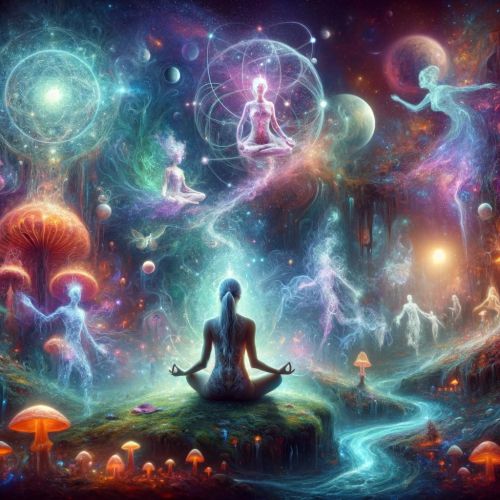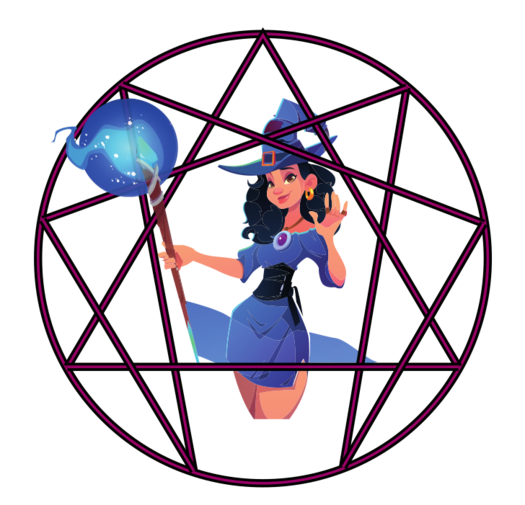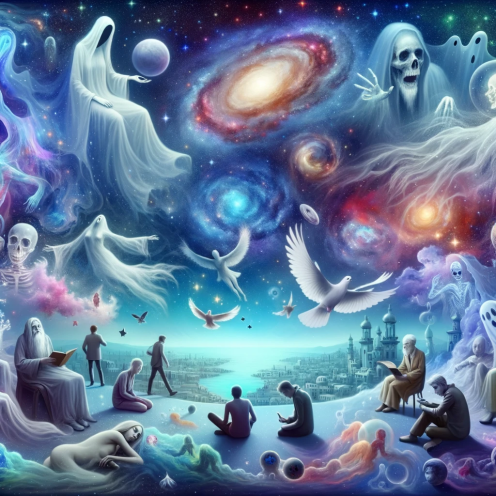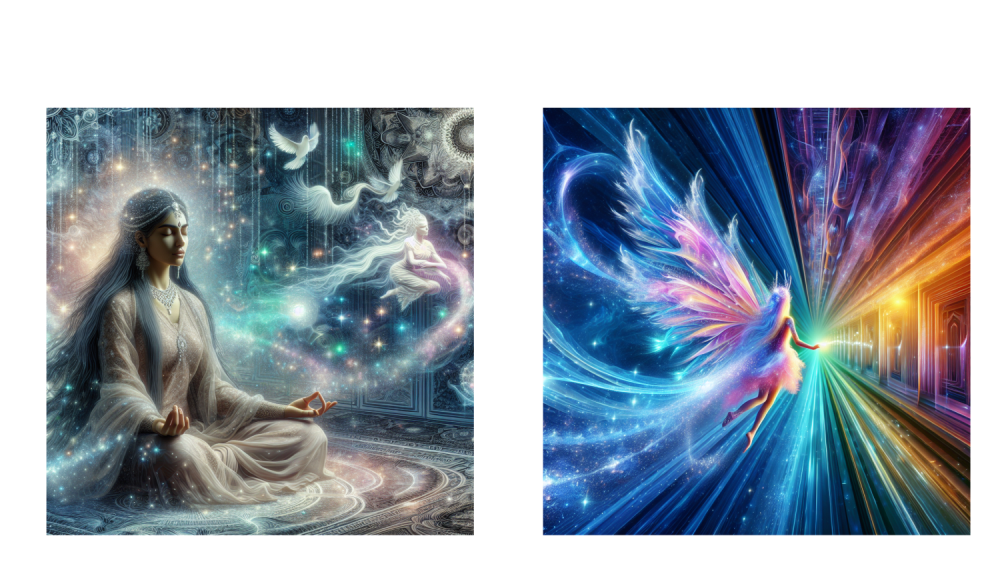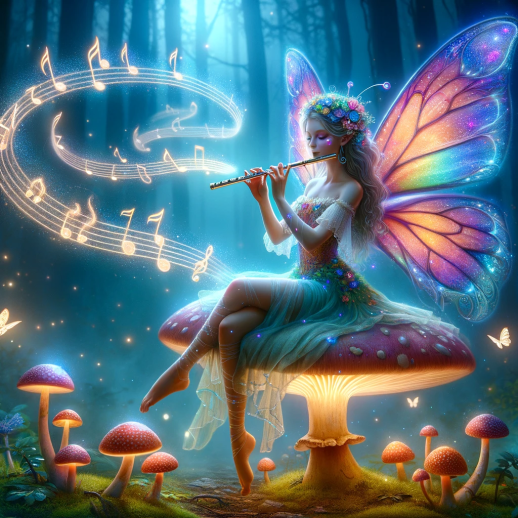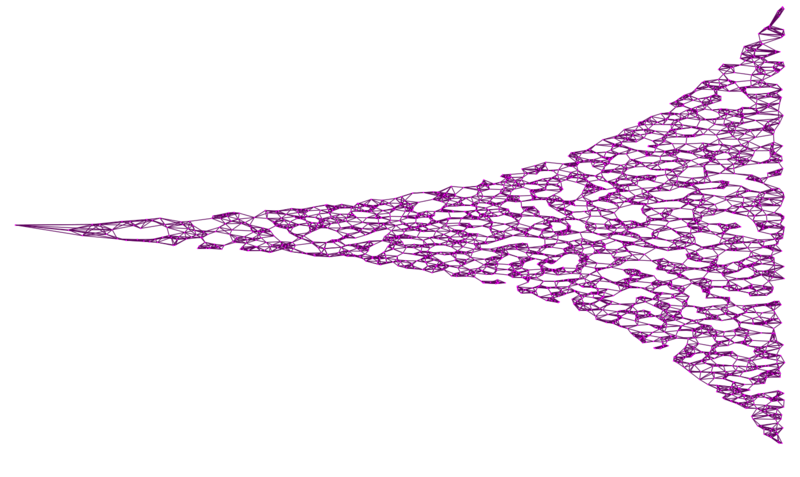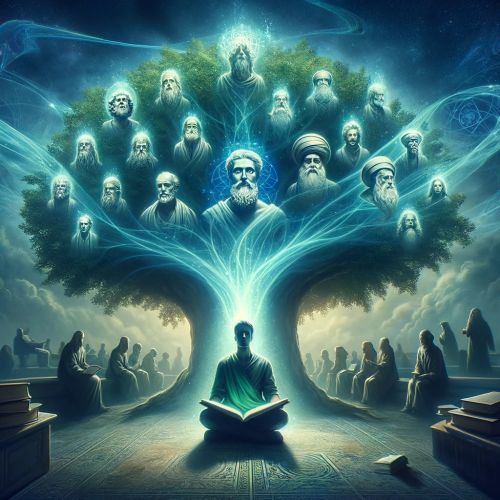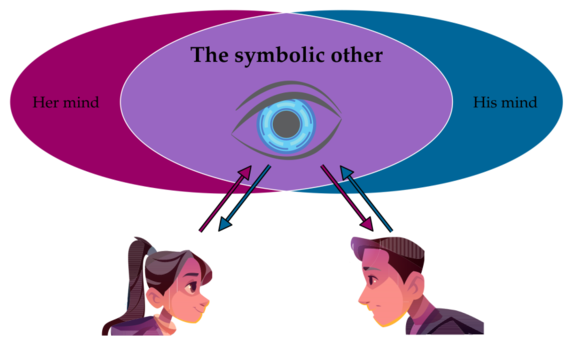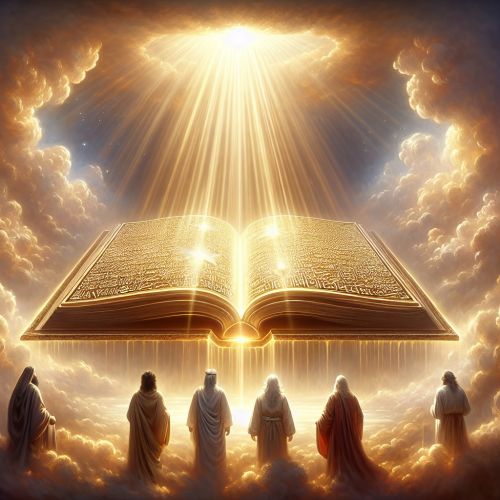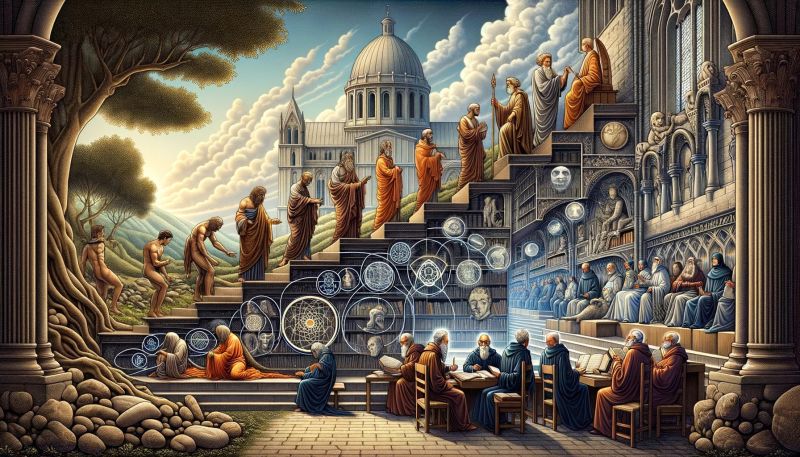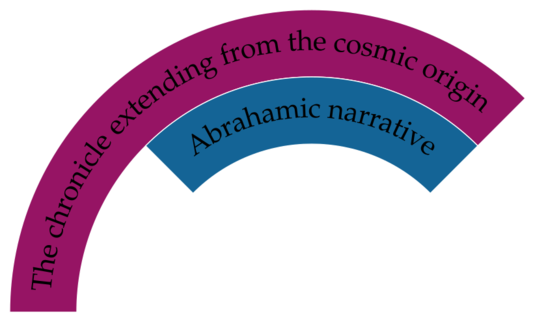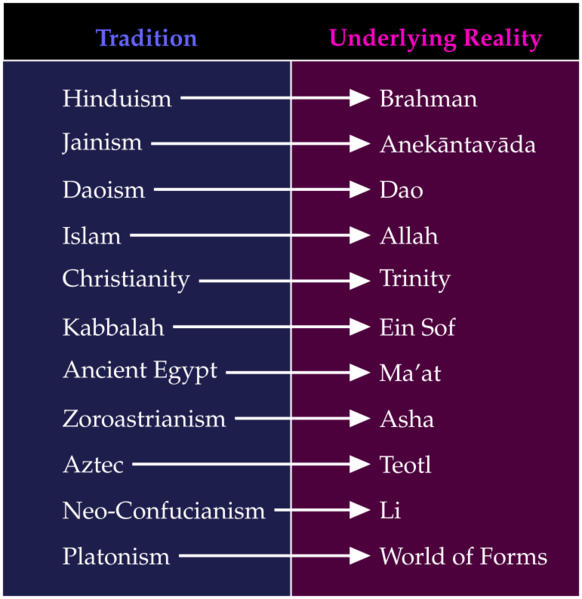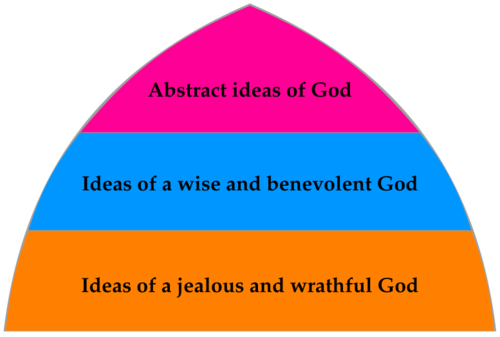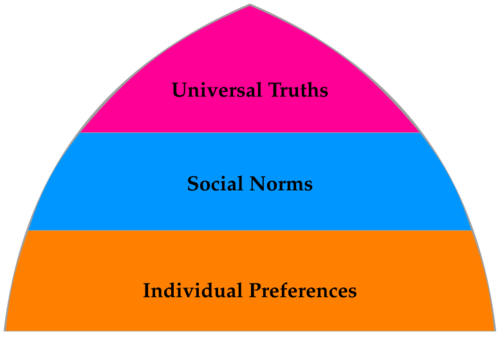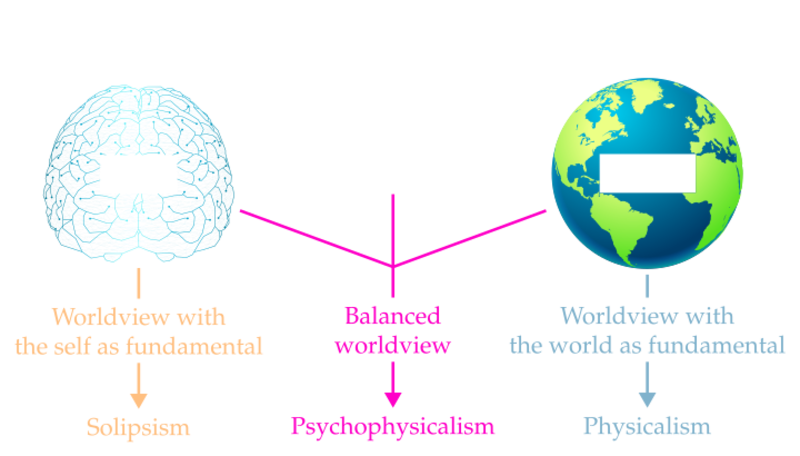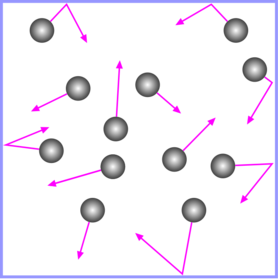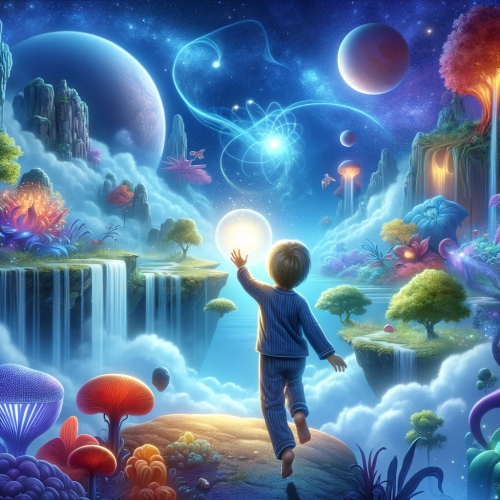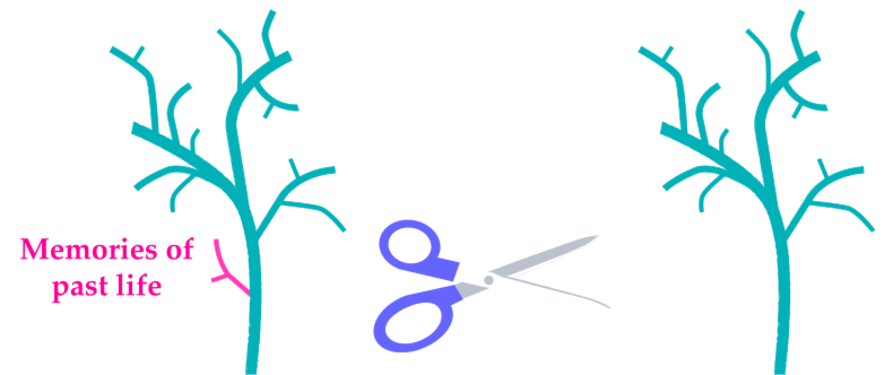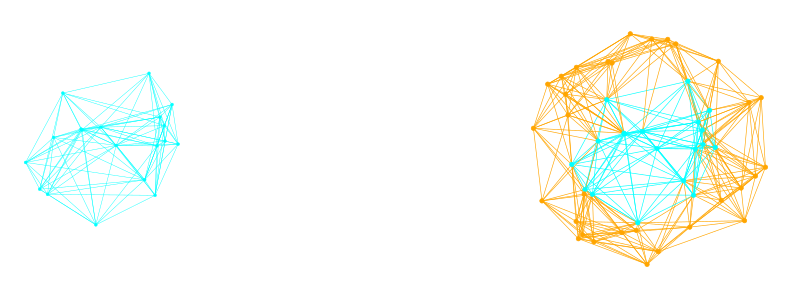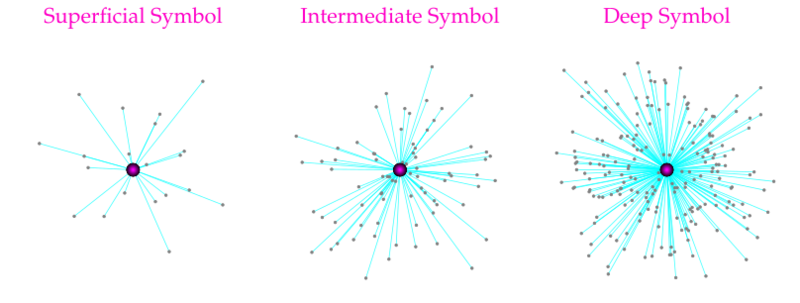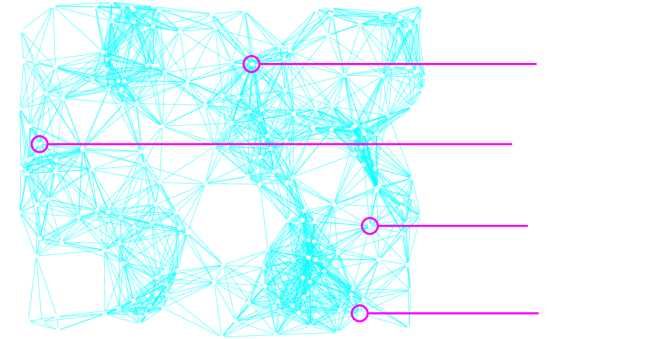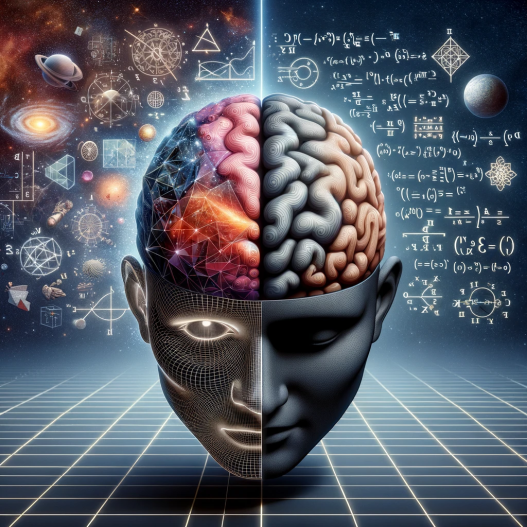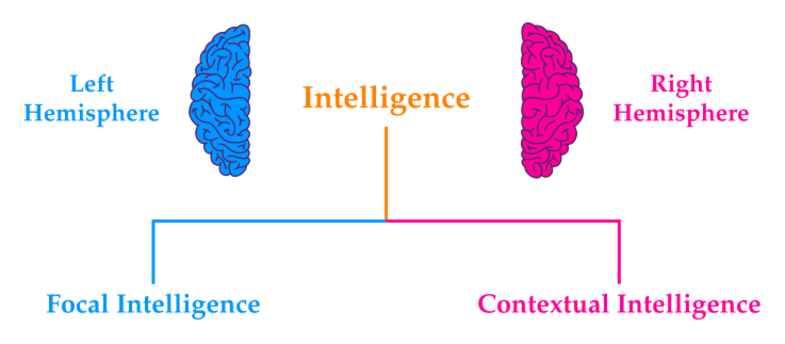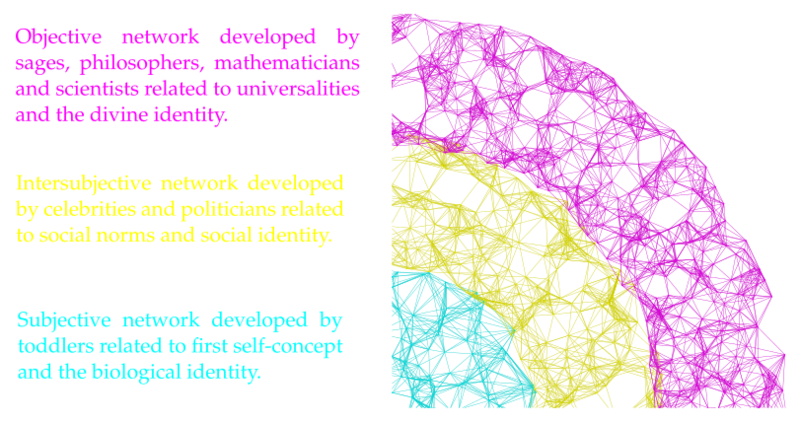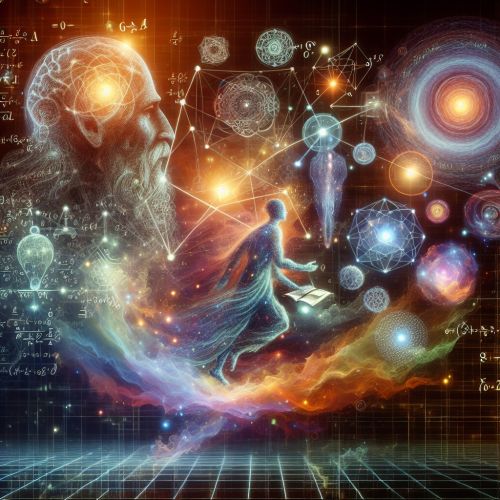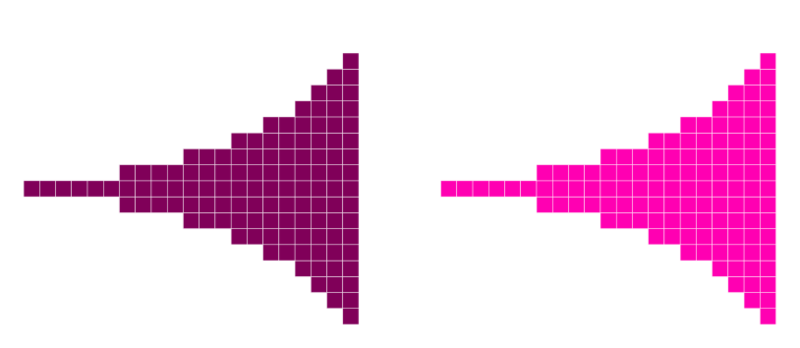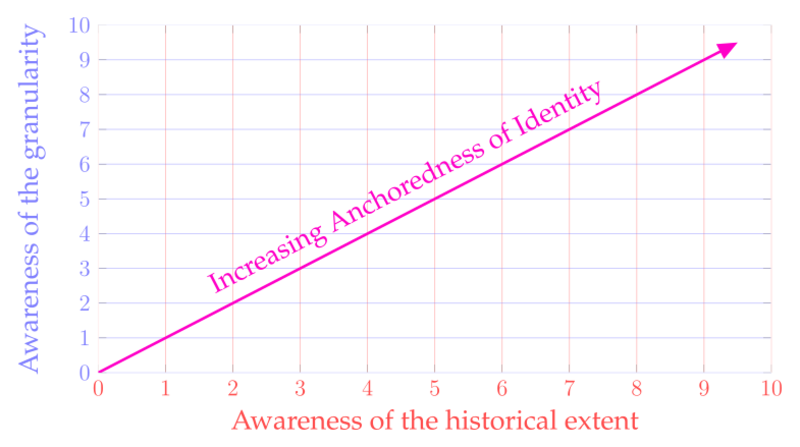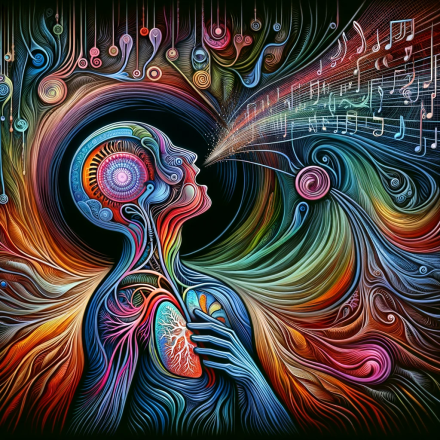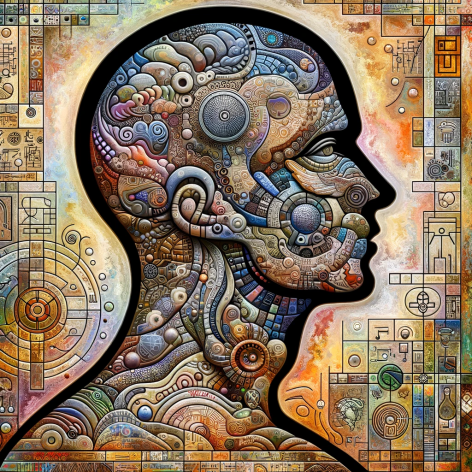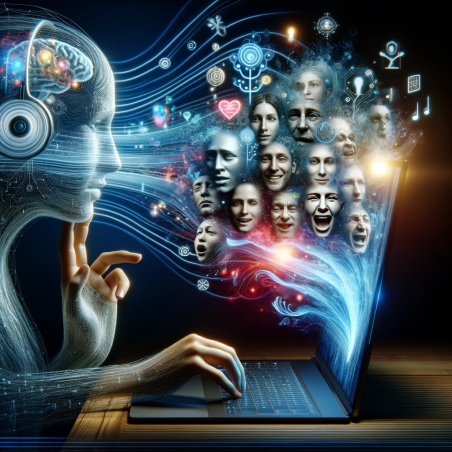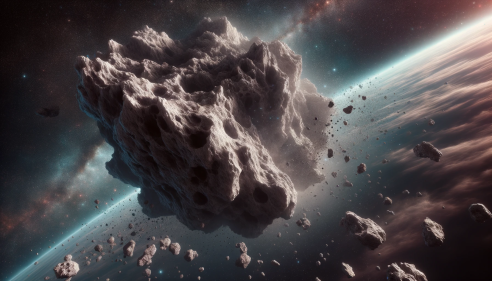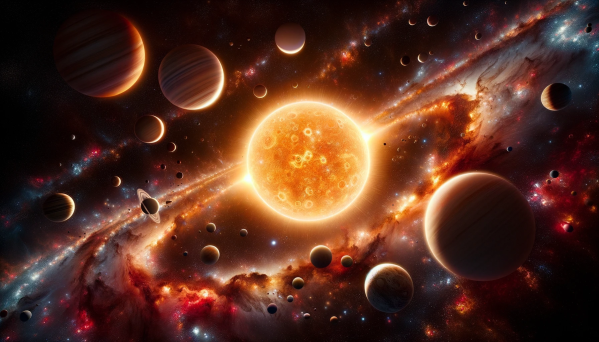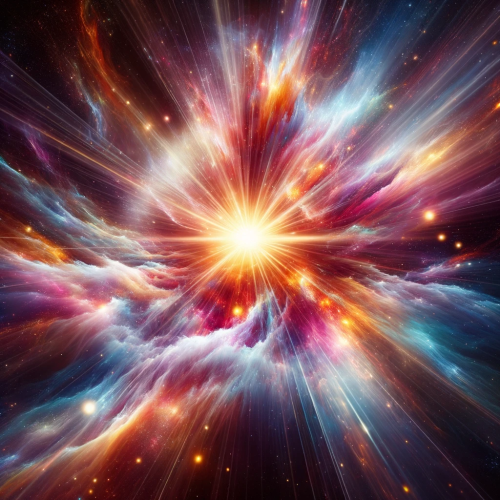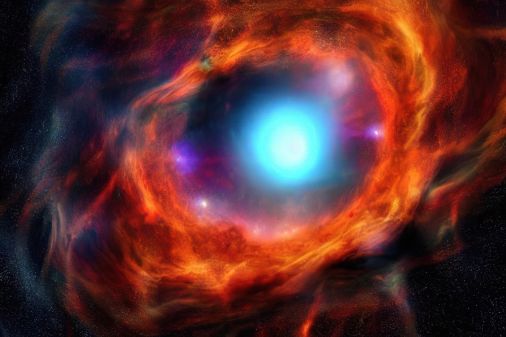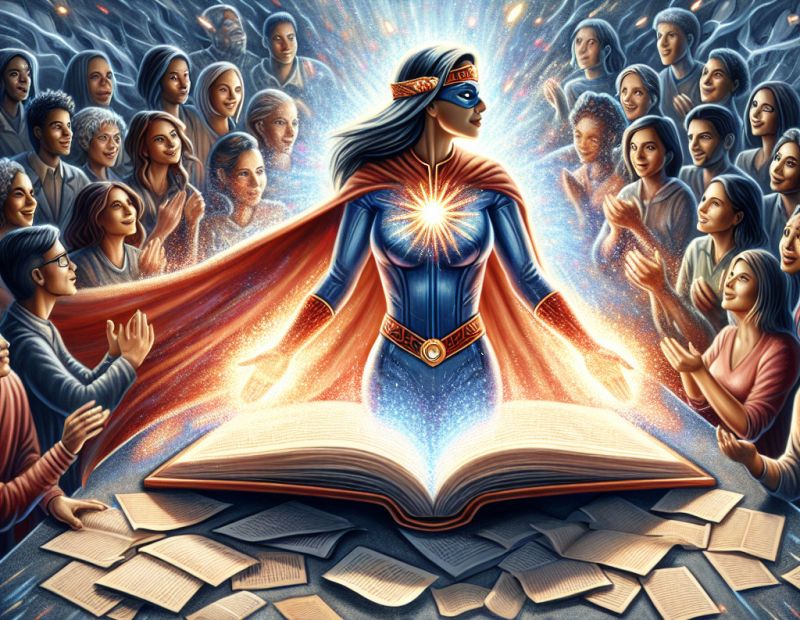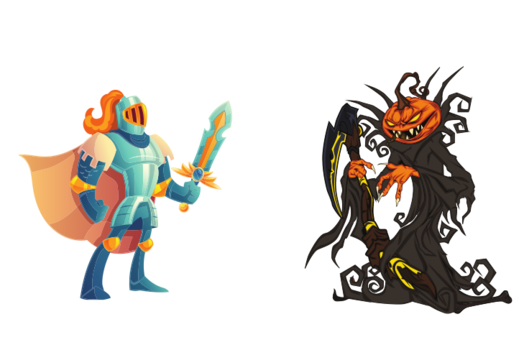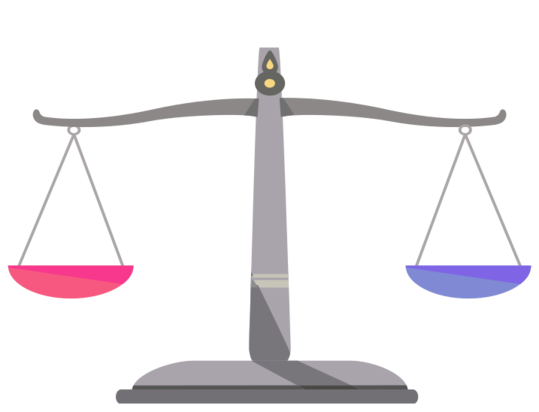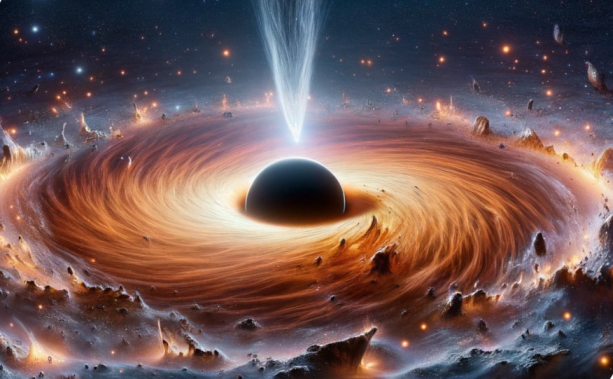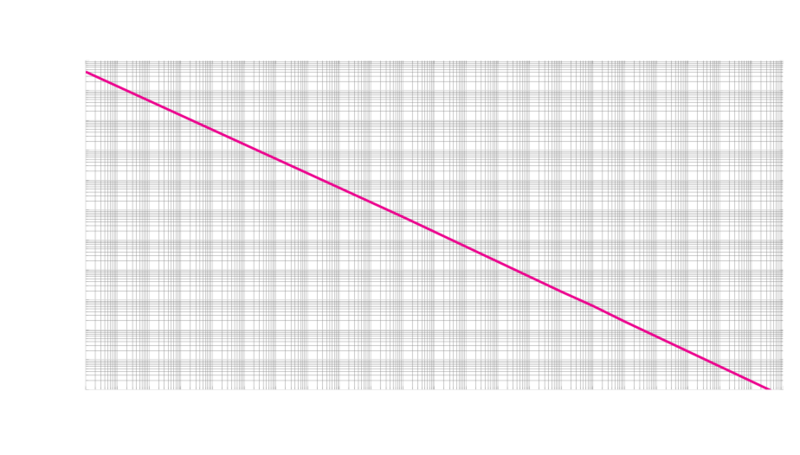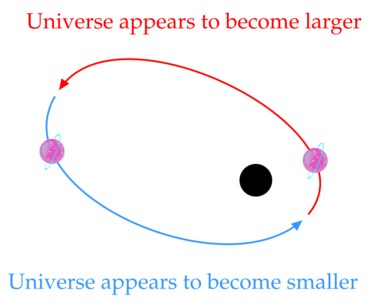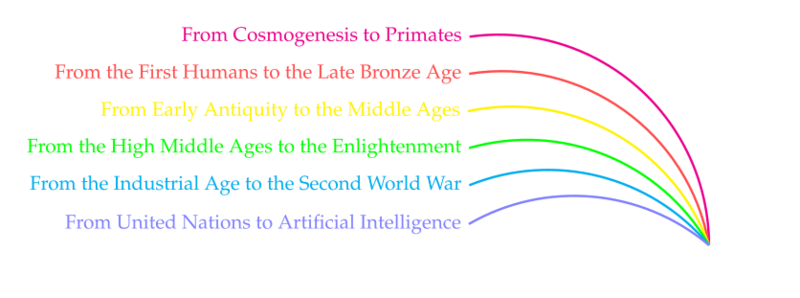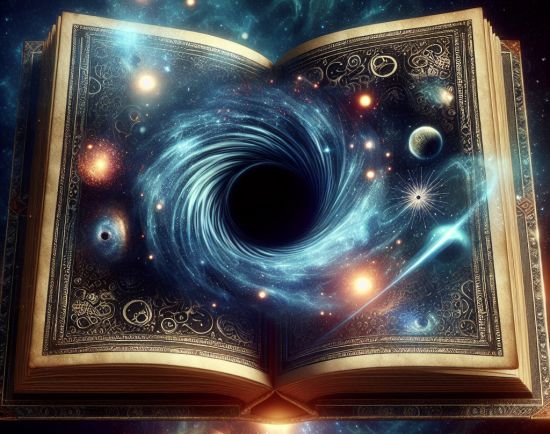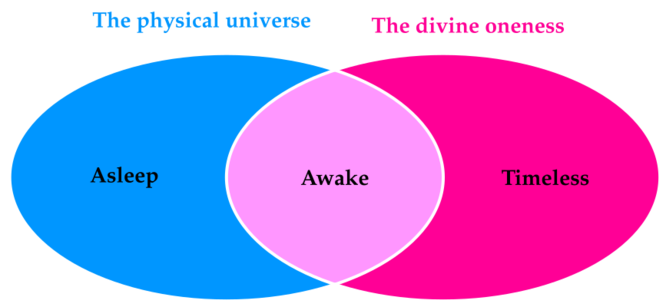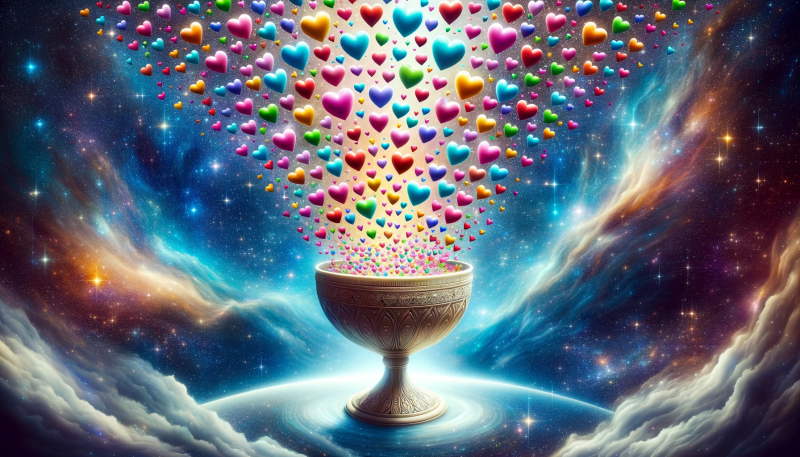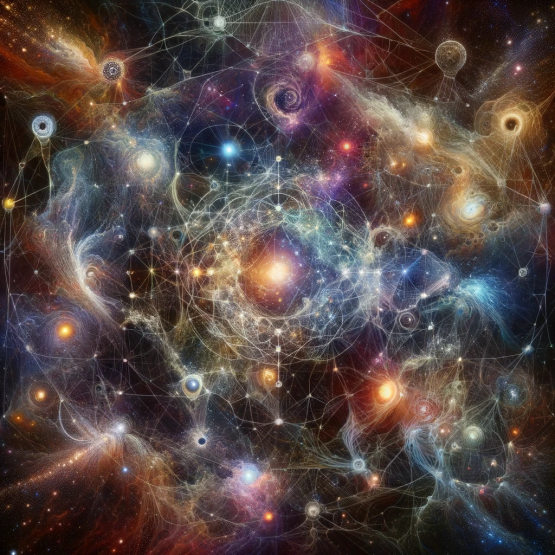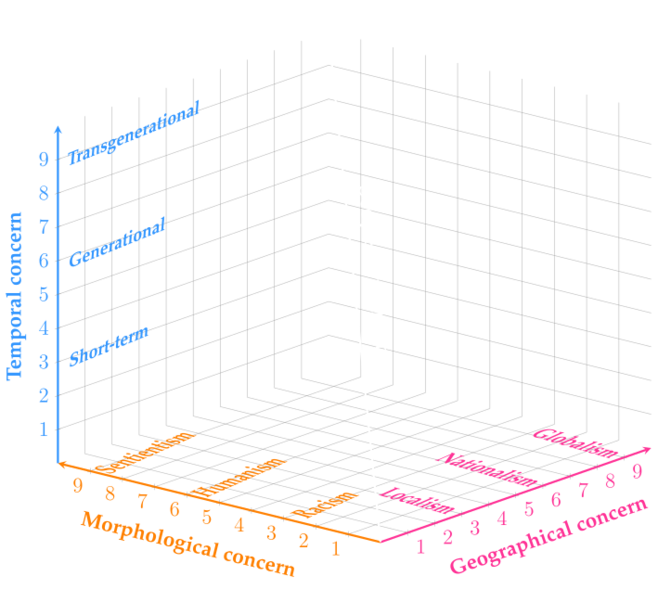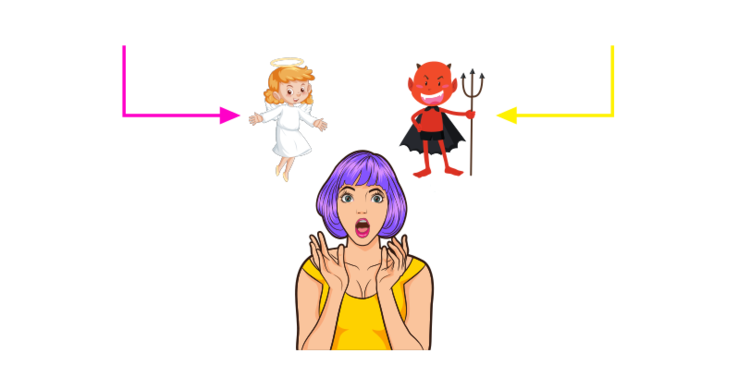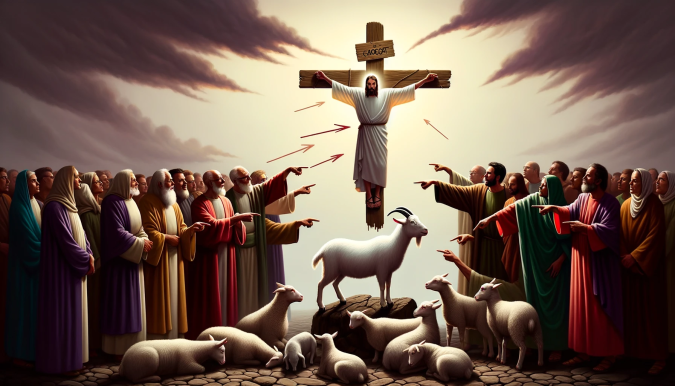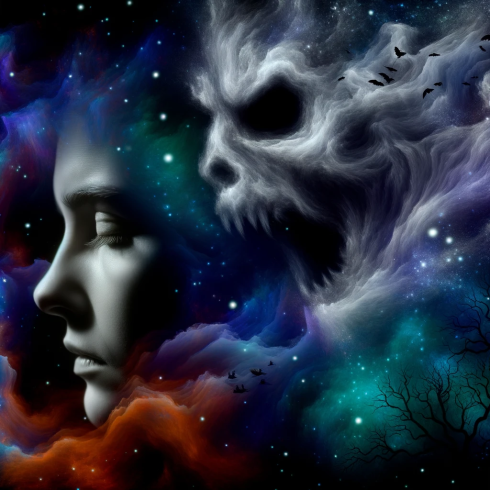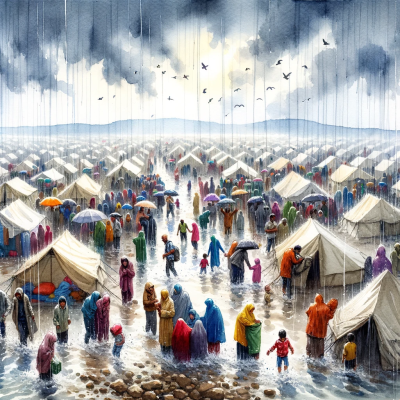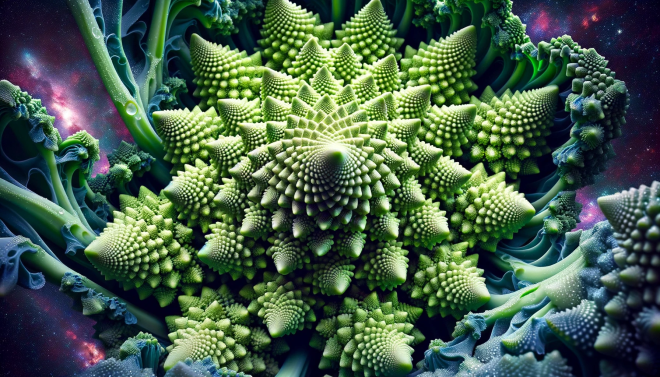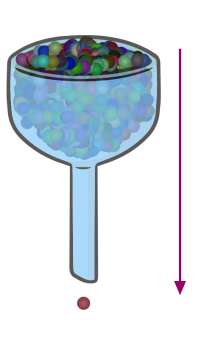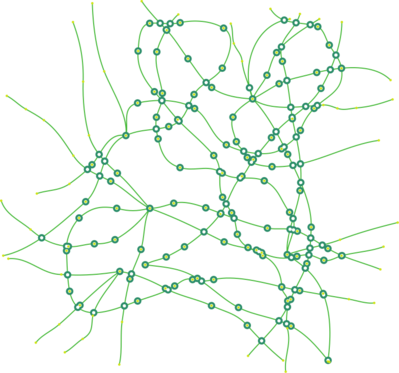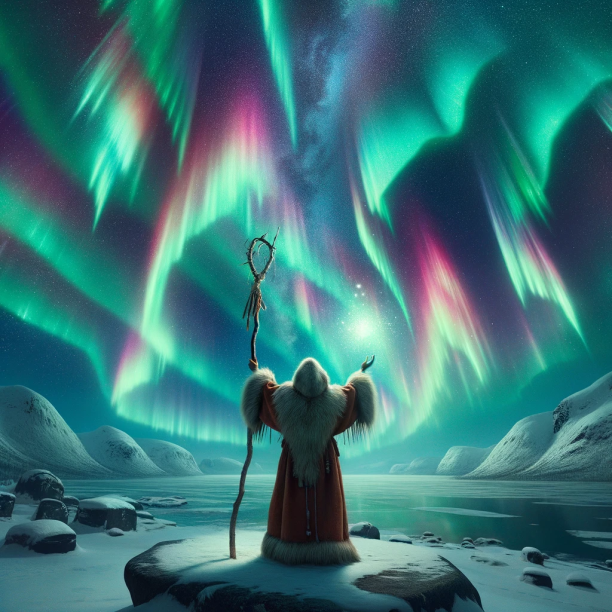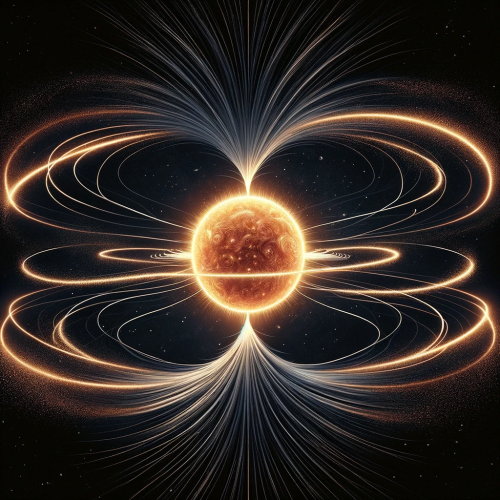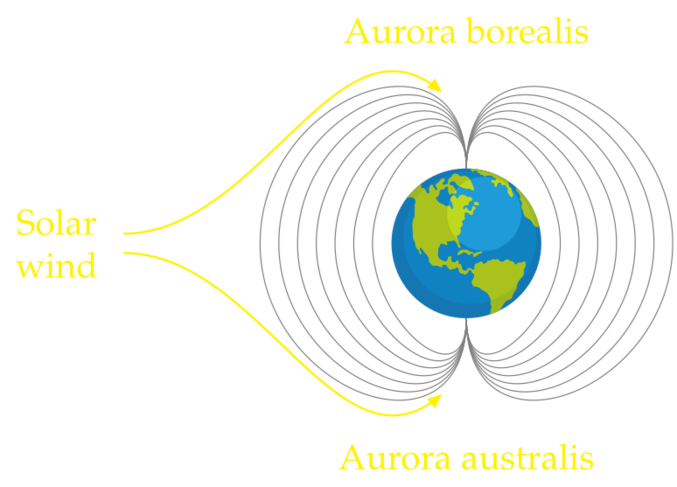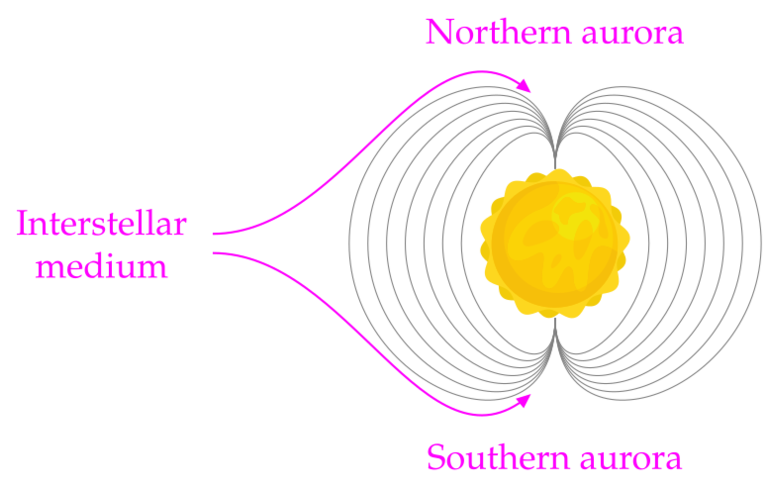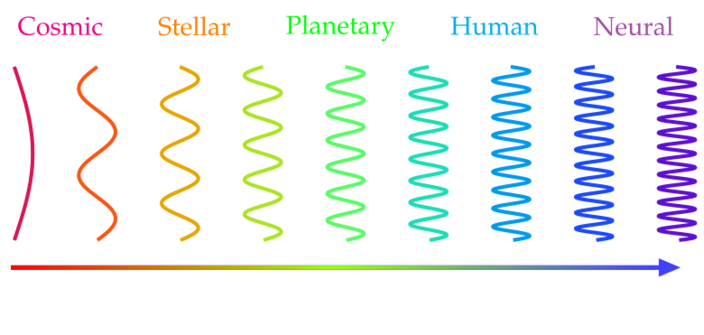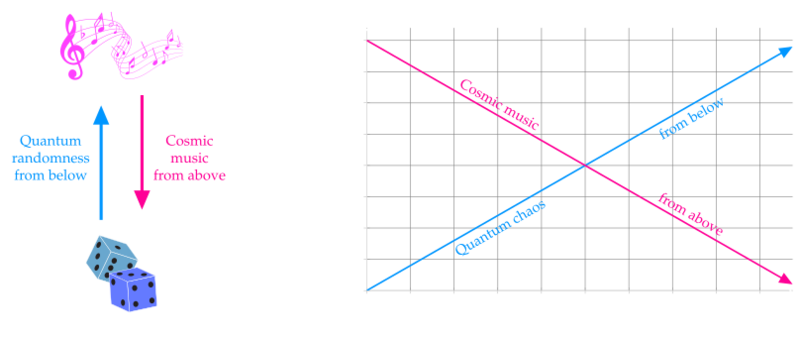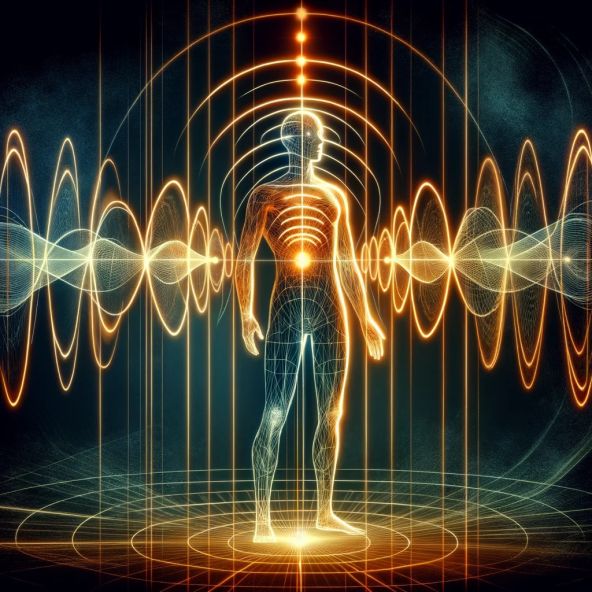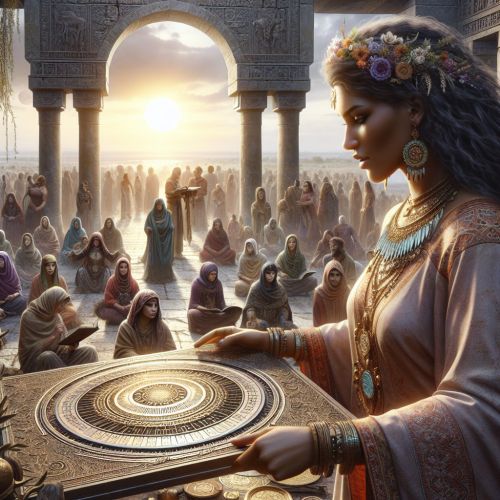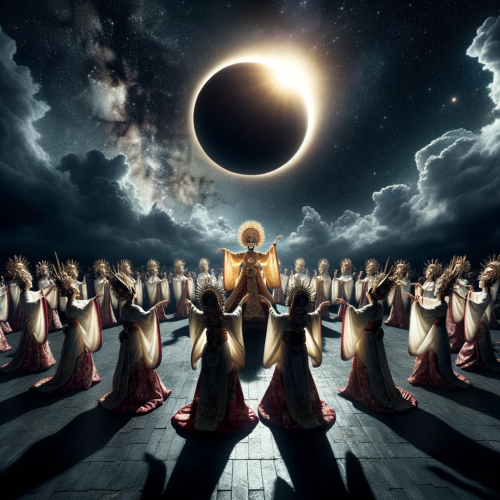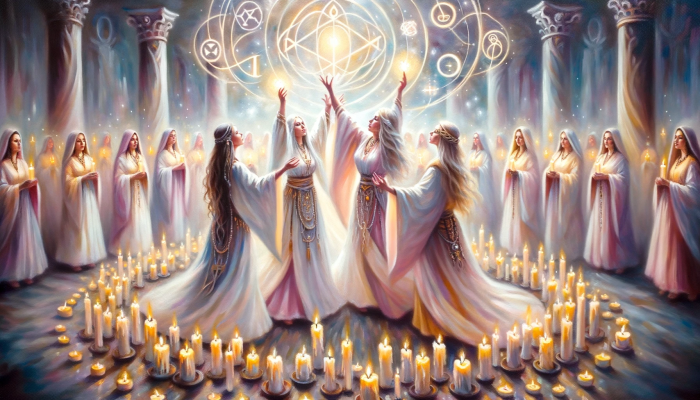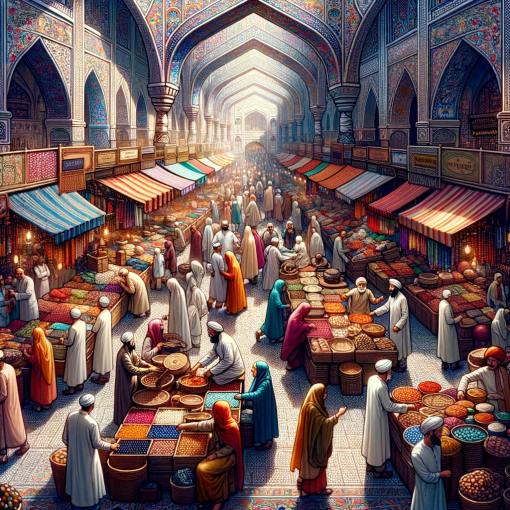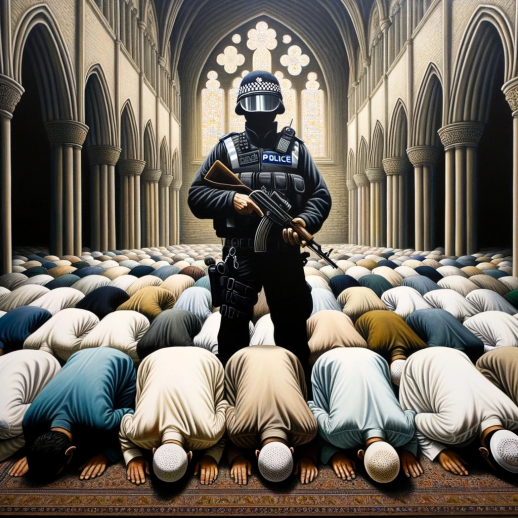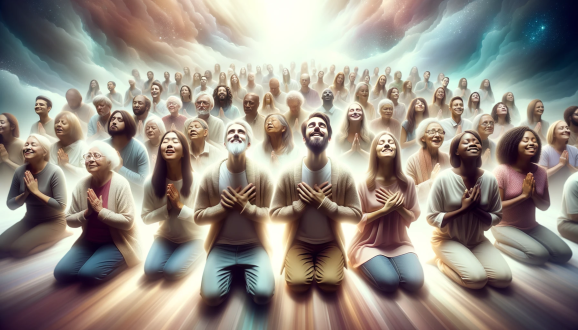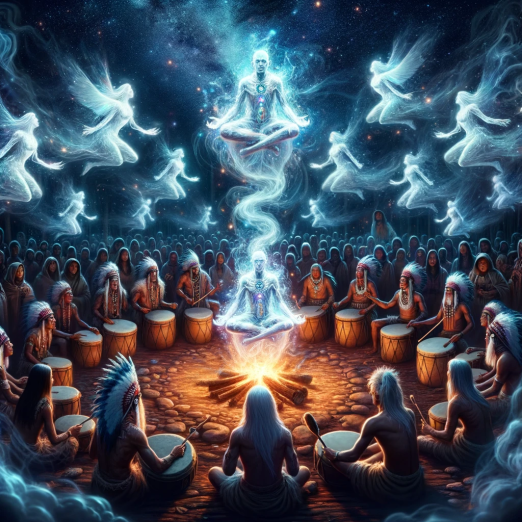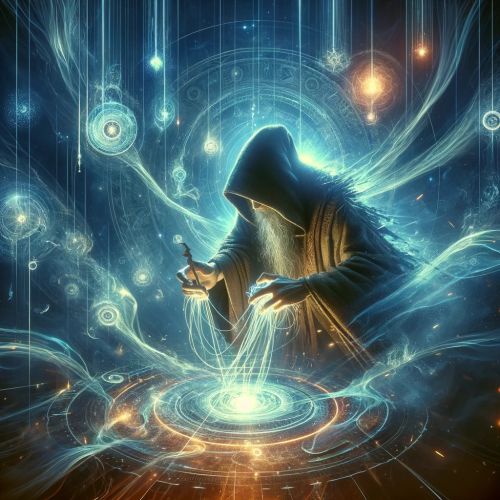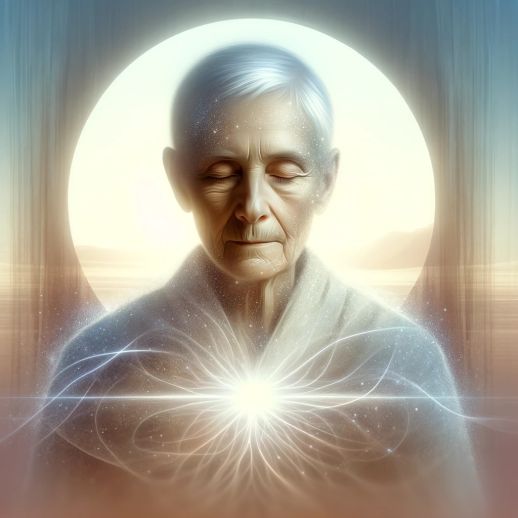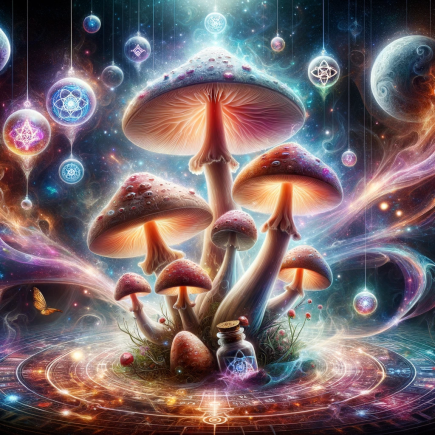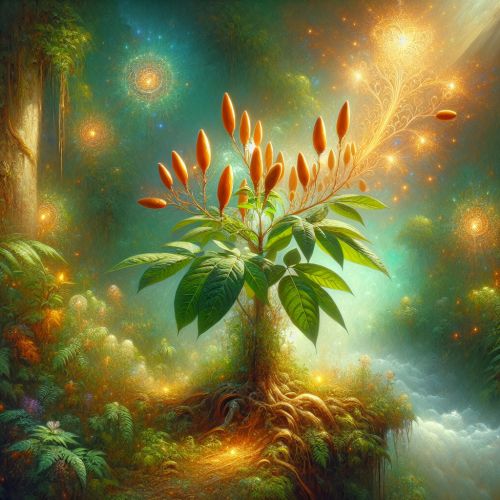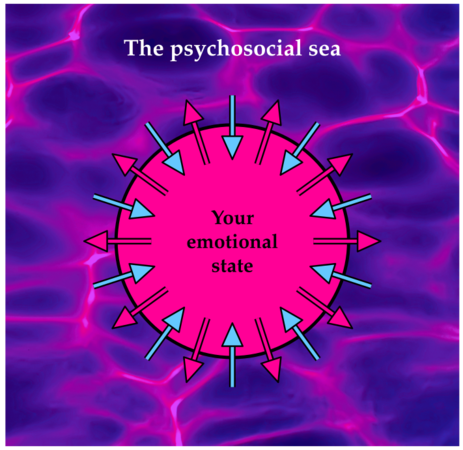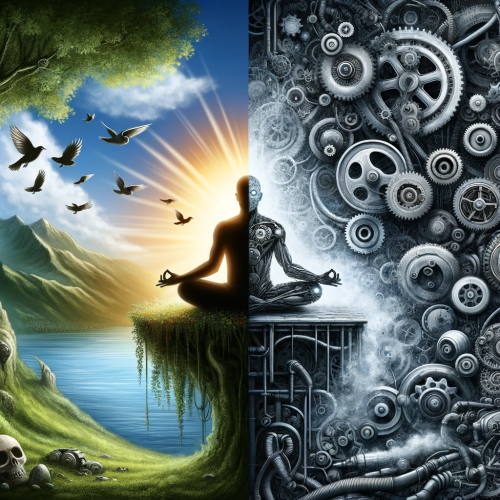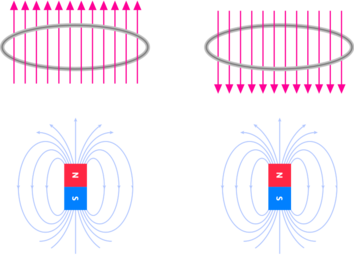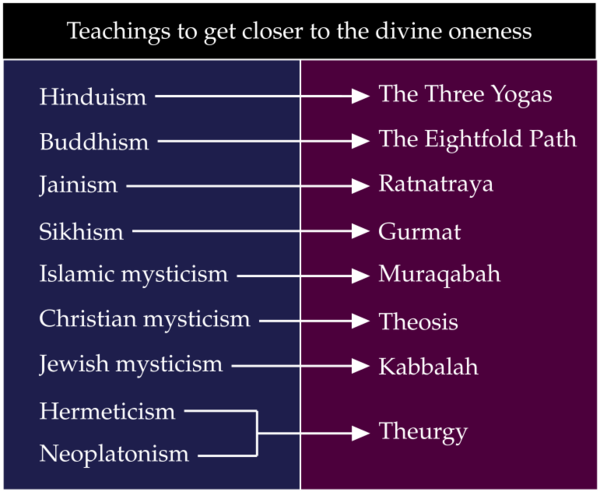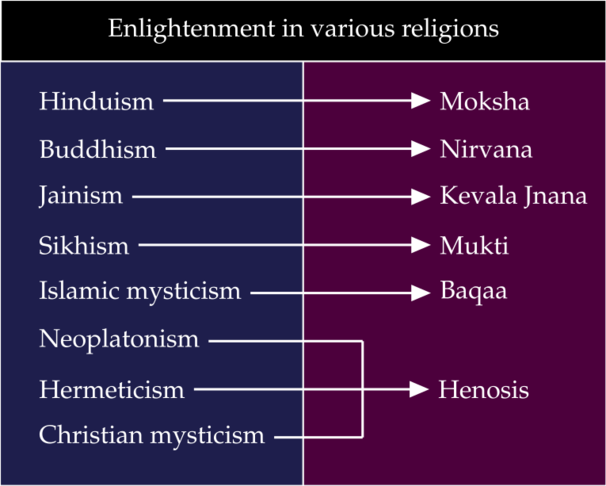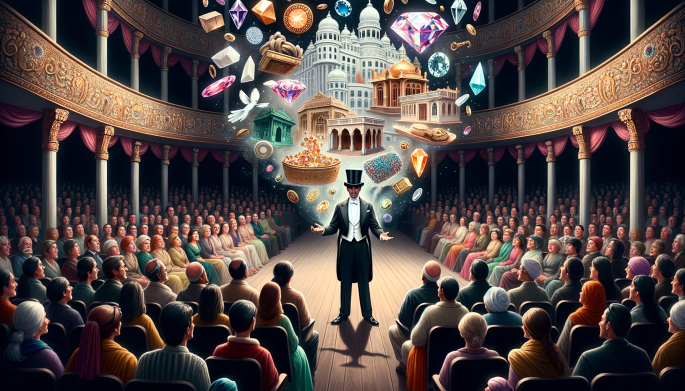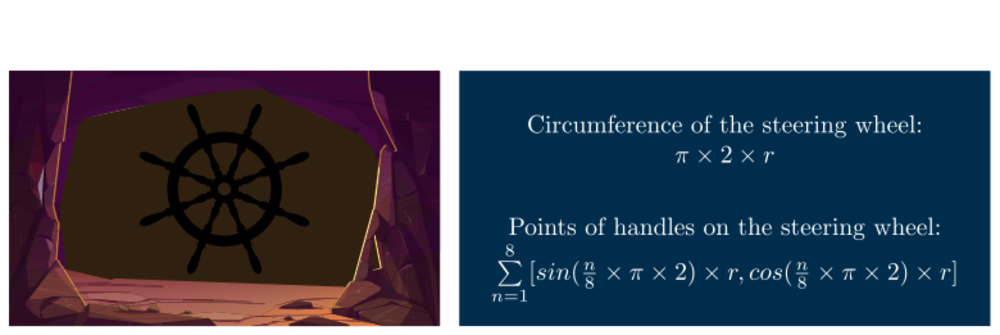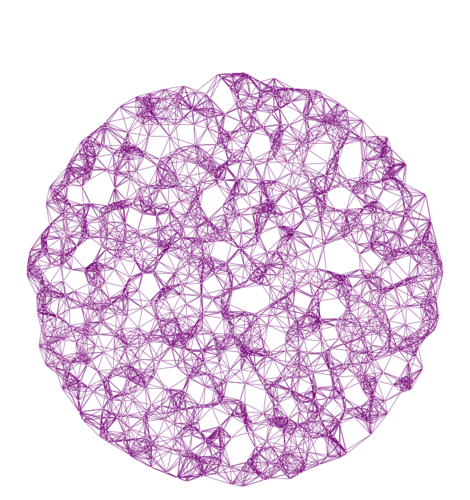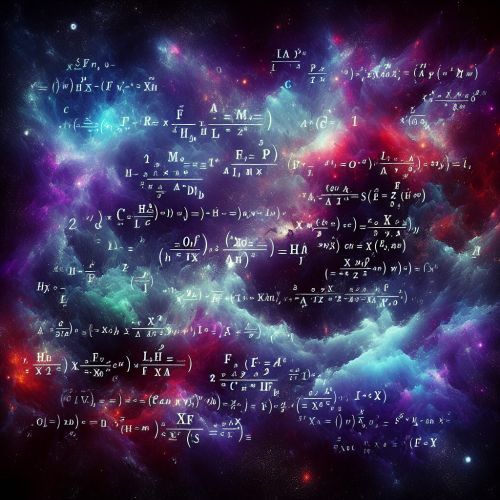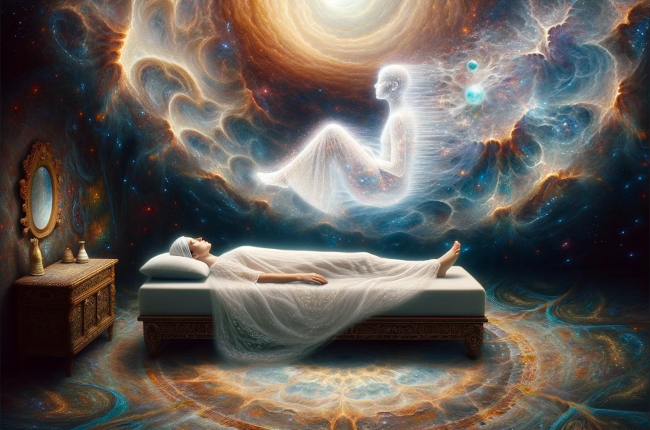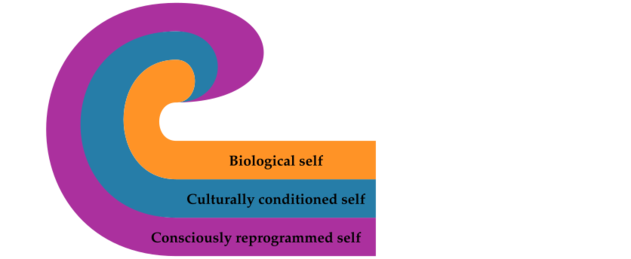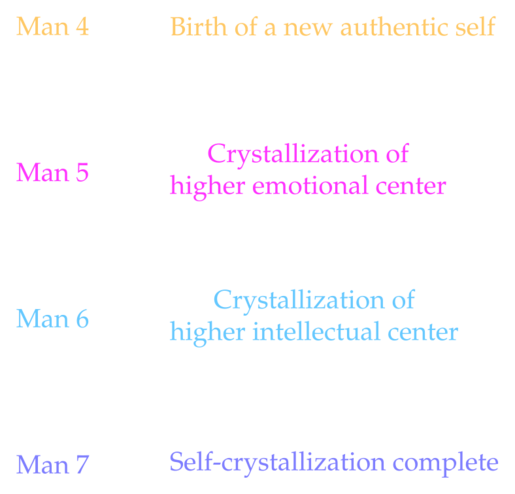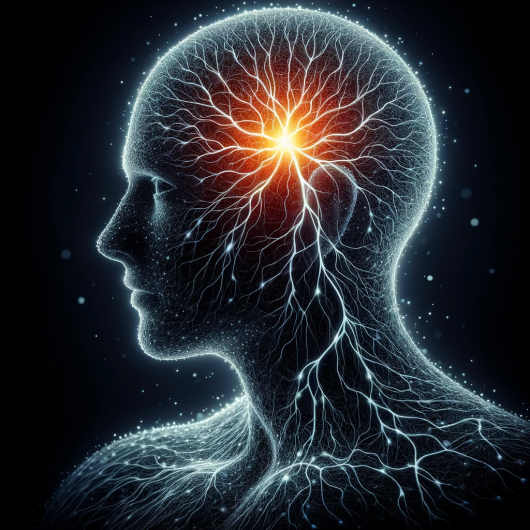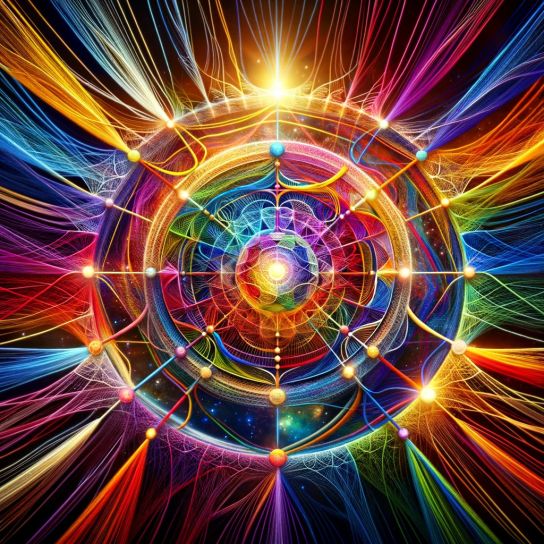Arch Theology
In the heart of the spiritual landscape, amidst the ceaseless quest for meaning and connection, lies a theology that reaches into the depths of our collective soul, offering a bridge between the seen and the unseen, the past and the present, the individual and the universal. This faith, with its roots entwined around the base of the Holy Mountain, serves as a beacon for those wandering in the age of individualism, seeking solace in the embrace of the divine narrative. Rich in history and vibrant in its quest for understanding, it invites all to partake in its journey toward enlightenment. It stands as a testament to humanity's enduring search for meaning, offering a path paved with the wisdom of the ages, leading us towards a deeper connection with the world, each other, and the divine.
The Holy Mountain
In a realm where diverse paths to enlightenment intertwine, this allegorical tale highlights the limitations of singular perspectives. Follow three seekers, each with their distinct approach, as they discover the profound unity and wisdom brought forth by a guiding Prophetess.
Three seekers stood before the majesty of a towering mountain, their eyes filled with resolve to conquer its peak. The first was a scholar, well-versed in all sciences but lost in the vast labyrinth of knowledge, oblivious to the spiritual resonance of the mountain. The second, a visionary, regularly delved into the psychedelic depths, unlocking ethereal realms through magic mushrooms. His perceptions were colored with the interconnectedness of all things, yet his unchecked ego eclipsed his understanding of humility. The third, a recluse, found solace in the tranquility of his mind, achieved through devoted meditation. Despite his inner peace, he overlooked the essential balance between spiritual solitude and scientific comprehension. Their ascent was interrupted by the arrival of a Prophetess descending from the peak. Her wisdom echoed the mountain's silent teachings: the cruciality of a well-rounded scientific education, the power of meditation to tame the ego, and the transformative potential of psychedelic experiences. She cautioned against an imbalanced approach, advocating for a harmonious integration of these disciplines. The Prophetess highlighted that no single discipline held the monopoly on truth; science, philosophy, meditation, and psychedelic experiences each contributed to the grand puzzle of enlightenment. Encouraging a holistic path, she advocated simultaneously pursuing all these elements on the journey to the mountain's zenith. As the three seekers ascended further, they internalized the profound wisdom of the Prophetess. They understood that their unique perspectives, once combined, could unlock a more holistic understanding of the mountain's sanctity. The scholar, adept in the sciences, elucidated the intricate physical and chemical marvels that sculpted the mountain. The visionary, seasoned in the use of magic mushrooms, unveiled the spiritual interconnectivity of all existence mirrored in the mountain's grandeur. The recluse, through his tranquil mind and subdued ego, emphasized the essence of humility and self-awareness on their path. As they ventured higher, the fabric of reality seemed to ripple with synchronicities. They found themselves consistently at the right place at the right moment, their thoughts magnetically aligning as though they shared a dream. Their appreciation for the mountain deepened, from the microscopic life forms to the majestic peaks piercing the heavens. They were swept over by a wave of awe and humility upon reaching the summit. The mountain was more than a colossal arrangement of atoms and molecules - it was a tangible manifestation of the divine oneness. Their ascent was not just about conquering the peak but about self-evolution, about becoming more wholesome individuals. As they descended, they carried an indelible imprint of the mountain's wisdom and a deep gratitude for the Prophetess who had illuminated their path.
Why Religion?
Loneliness and The Unifying Power of Religion
In societies that value independence and self-sufficiency, meaningful social connections often suffer. This emphasis can lead to widespread loneliness, with associated health risks such as depression, anxiety, heart disease, and decreased life satisfaction.
To understand the depth of this issue, consider the insights of former Harvard professor and author, Tal Ben-Shahar. He emphasizes in his works the importance of close relationships for overall well-being. According to Ben-Shahar, humans are inherently social creatures, and our need for connection is as essential as our need for food and shelter. This vital human need is often sidelined in societies that emphasize individualism. Backing up Ben-Shahar's perspective, research shows that individuals with robust social connections are generally happier, healthier, and have longer lifespans than their isolated counterparts.
A potential solution to the pervasive isolation in individualistic societies could be found in shared religious practices. Religion provides a sense of belonging and community, grounded in shared beliefs, rituals, and values such as compassion, empathy, and service. Through these shared practices and teachings, religion fosters a sense of connection and unity, while also offering individuals a sense of purpose and direction. Prayer or meditation, for instance, can be a way to connect with a transcendent or spiritual dimension, fostering a sense of connection to something greater than oneself.
Moreover, the unity fostered through shared religious beliefs can prove instrumental in addressing global issues such as climate change, environmental degradation, and the arms race. When individuals feel a sense of connection and shared purpose, they are more likely to collaborate on solutions. A shared religion can act as common ground for people of different cultures, languages, and backgrounds, helping to bridge divisions and overcome mistrust. In this way, religion has the potential to not only combat the loneliness prevalent in individualistic societies but also to unite individuals in the face of shared global challenges.
The Spiritual Void in the Age of Individualism
Spirituality unfolds as an intimate odyssey, a path that aligns with the core of one's being. There are those who find comfort and clarity in the defined tenets of their faith, treating them as practical signposts for navigating life's complexities. For these individuals, prescribed rituals and traditions offer a structured framework that informs their worldview and daily interactions. Conversely, others are captivated by the enigmatic allure of mysticism. These seekers are impelled by a yearning for profound inner discovery, a sweeping comprehension of their place within the universe, and an intense connection with something greater than themselves, be it divine or transcendent in nature. It is incumbent upon religious pathways to embrace this diversity, offering a broad array of beliefs and practices that speak to the various stages of a person's spiritual journey. Such an inclusive stance creates a nurturing environment where seekers of all backgrounds—whether they are just setting foot on this path or have long been journeying—can find tailored guidance and inspiration. This breadth allows each individual to chart a course that resonates deeply with their unique spiritual quest.
Many grapple with an inner void, a sense of emptiness that casts a persistent shadow across their lives. In an attempt to fill this void, some chase fleeting gratifications. They might believe that social media validation, accumulating wealth, or acquiring objects they think will elevate their social standing can bring a sense of wholeness. Others might turn to substance abuse, seeking temporary relief, only to find the void growing even larger. The quest for these transient solutions often spirals into a relentless cycle, where the hunger for external approval and material gain overshadows the deeper need for genuine fulfillment and connection. Yet, meaning is inherently narrative-based, and there is a profound human necessity to feel part of larger, more expansive stories that stretch far beyond our individual selves.
The epoch of scientific discovery has unraveled numerous enigmas of the universe that surrounds us, leading to an era where some firmly endorse 'scientism'—the belief that only knowledge derived from scientific investigation is genuine and that there remain no significant mysteries to decipher. This perspective champions the strides made in understanding the physical world, yet it often overlooks the introspective and personal dimensions of our existence. While science has illuminated countless aspects of the reality we inhabit, it may not provide comprehensive insights into the more profound queries about our individual contributions to the cosmos or the essence of our being.
Transitioning from this recognition of science's limitations, many find that the allure of mysticism offers a unique sanctuary, a realm not in opposition to but rather complementary to the empirical. Mysticism delves into the enigmatic practices, rituals, and meditations designed not just to deepen our understanding but to dissolve the barriers between the self and the divine—the ineffable presence or the overarching reality that lies beyond our ordinary experiences. By engaging with the mystical, we recalibrate our senses, enabling a perception and interaction with the layers of existence that remain obscured by the empirical lens. This sacred encounter with the mystical realm has the potential to fill the existential void that looms large in the age of scientism, infusing our lives with a resonance that echoes with the rhythms of the universe and offers a profound sense of connection that scientific inquiry alone may not provide.
In the embrace of the mystic, one might uncover the threads of a divine narrative. This narrative transcends the mundane stories we tell about our lives, situating us within a grander, cosmic script that imbues each thought, action, and moment with intrinsic significance. As we align with this transcendent storyline, our self-perception evolves. We begin to see ourselves not as isolated actors but as integral parts of a vast, interconnected tapestry. This revelation can be transformative, instilling in us a robust and authentic sense of purpose. The awareness that our personal narrative is part of a larger, divine plot bestows a feeling of authenticity and destiny, countering the sense of purposelessness that modernity often imparts.
Moreover, this mystical awakening is not an escape from reality but a deeper immersion into it. It acknowledges the sacredness of all existence, revealing a path to inner peace and understanding through the acknowledgment of the interconnectedness of all things. In doing so, mysticism offers a healing salve to the soul's yearning for meaning, suggesting that within the numinous we might find the keys to our most profound existential questions. It's in this sacred dialogue with the divine narrative that we might discover the strongest, most enduring sense of meaning—one that can sustain and nourish us through the vicissitudes of life.
Mysticism has left an indelible mark on the spiritual doctrines and rituals across diverse religions such as Christianity, Islam, Judaism, and Hinduism. Within the domain of Christianity, the mystical dimension manifests itself in the form of contemplative prayer and the relentless quest for an unmediated communion with God. Jewish mysticism unfurls itself amidst the labyrinthine tenets of Kabbalah, while Sufism, with its focus on individual spiritual evolution and the immediate perception of God through meditation and prayer, encapsulates the spirit of Islamic mysticism. Hinduism, meanwhile, channels its mystical undercurrents through practices like yoga and meditation, designed to promote a harmonious fusion with the divine.
Despite the widespread embrace of various spiritual journeys, the acceptance is not always ubiquitous. There are instances in major religions where certain sects reject the mystical elements, opting instead for a rigid interpretation of religious scriptures and unwavering obedience to theological teachings. Within the realms of Christianity and Islam, for example, there exist factions that are resistant to mysticism. They express apprehension that subjective spiritual encounters might cause deviations from the established doctrines and interpretations.
Mysticism, with its emphasis on direct, personal experiences of the divine or transcendent, stands in stark contrast not only to the materialistic pursuits critiqued earlier but also to the rigid dogmatism characteristic of some religious orthodoxies.
Bridging Traditions and Transcending Boundaries
As we reflect on the spiritual landscape, it becomes evident that rigid dogmatism can sometimes act as an anchor, preventing religions from evolving with the ebb and flow of human understanding. Yet, in the more mystical traditions, there is a palpable sense of evolution, a journey towards ever-deeper insights into the divine. Imagine a vast and boundless ocean, where the spiritual currents of the world's great faiths are navigated by their most esteemed sages. Envision Meister Eckhart at the helm of Christianity's vessel, steering through the waves with the wisdom of apophatic theology, his eyes set on the divine union beyond dogma. Ibn Arabi, the venerable captain of Islam's ship, charts a course by the stars of Sufism, his heart attuned to the endless desert of the soul where he seeks the oasis of ultimate reality. And Adi Shankara, the enlightened navigator of Hinduism's craft, cuts through the waters with the sharp keel of Advaita Vedanta, looking beyond the illusory multiplicity towards the singular Brahman.
For countless generations, religions like Judaism have charted the spiritual seas under the guidance of their revered leaders. Would these captains, each a towering figure within their respective spiritual traditions, be bound for the same beacon of truth? This question beckons deep reflection on the nature of spiritual verity. Though differing celestial guides set their courses, and their journeys propelled by the distinct winds of their doctrines, it's conceivable that they may all be voyaging toward the same distant lighthouse — a point of convergence where the essential truths of being unite, and the diverse manifestations of the divine merge into a single, universal experience. In this harmonious domain, the paths that once seemed at odds blend into a grand unity of comprehension — a transcendent understanding that surpasses any one faith's horizon, reaching into the collective yearning of humanity.
As these venerable captains navigate the mystic seas, their journeys offer a profound metaphor for the interplay of unity and diversity that characterizes the spiritual quest. They remind us that while the paths to the divine are many, the truth that lies at the heart of all spiritual endeavors might just be one and the same.
Gurdjieff, Jung, and Influences from Above
George Ivanovich Gurdjieff, a distinguished mystic from the spiritually vibrant era of the early 20th century, devised a distinct path of self-discovery and personal growth referred to as the Fourth Way.[1] This innovative approach harmoniously fuses insights drawn from a multitude of world religions, thereby rendering it compatible with the demands and sensibilities of the modern world. Central to Gurdjieff's teachings is the Enneagram, an emblematic nine-pointed geometric figure ensconced within a circle. The Enneagram, however, is more than just a stationary symbol; it powerfully conveys the fluid, dynamic process of personal transformation and evolution.
The Enneagram, steeped in age-old wisdom, is frequently likened to an 'octave,' a concept gleaned from the realm of music theory. Gurdjieff proposed a fascinating analogy, suggesting that the rhythm of our lives and the growth of our bodies march to the beat of these octaves, progressing akin to a musical note sequence. He elaborated on the presence of three essential octaves in human life - the first one correlating to our nutritional intake, the second pertaining to the inhalation of air, and the third associated with the sensory perceptions we glean from our environment.
A pivotal component of Gurdjieff's Fourth Way is the 'Law of Three,' an intriguing principle that elucidates the triadic structure intrinsic to all existence. This law postulates the presence of three cardinal forces or principles: Active, Passive, and Neutralizing, also referred to as the Reconciling force. These forces serve as the underlying principles for every phenomenon. The 'Law of Three' is deeply woven into the fabric of Gurdjieff's system, providing us with an insightful perspective to comprehend the inherent dynamic nature of the cosmos.
The Fourth Way illuminates a profound pathway to the exploration of higher consciousness and a potential transcendental communion with the divine. This exploration is accomplished by diligently observing the metaphysical octaves in our lives and discerning the operation of the 'Law of Three.' The Fourth Way also imparts several transformative principles that are key to personal spiritual development. One such principle is 'self-remembering.' This involves a vigilant self-awareness that is ceaselessly maintained in the present moment, fostering a heightened sense of mindfulness. The principle of 'voluntary suffering' is also introduced, which denotes a purposeful acceptance and tolerance of adversity as a means for personal progression and self-improvement. Lastly, the concept of 'conscious labor' is presented. This refers to the act of infusing daily activities with a mindful and intentional effort, thereby transforming mundane tasks into acts of spiritual cultivation.
As we continue our exploration of these esoteric teachings, we cross paths with the intellectual contributions of another influential figure. Occupying a place of prominence alongside Gurdjieff is the Swiss psychiatrist and psychoanalyst, Carl Jung. Mirroring Gurdjieff's quest, Jung was similarly engrossed in unveiling the complex layers of human consciousness. Nonetheless, Jung's approach differed; he sought to shed light on the seemingly random yet profoundly meaningful events in daily life that he referred to as 'synchronicities.'[2]
Carl Jung's perspective on synchronicities offers a profound insight into the interplay between the unconscious and conscious realms. He saw synchronicities not as mere coincidences but as significant events deeply infused with meaning, emerging from the unconscious mind to engage with our conscious awareness. These synchronicities, such as the recurrent sighting of a specific number or dreams mirroring real-life events, are not random occurrences. Instead, they act as symbolic reflections of our inner psychological landscapes, revealing aspects of our psyche that are not immediately apparent at a conscious level.
Anomalous experiences, ranging from the slightly unusual to those bordering on the supernatural, might be more common than often recognized. Our perception and recollection of these events are, however, intricately shaped by our personal belief systems and the cultural contexts in which we are immersed. Our brains instinctively interpret these experiences through the prism of our existing beliefs and schemas. When an experience aligns with our worldview, it is more likely to be noticed, remembered, and regarded as significant. In contrast, experiences that starkly contrast with our belief systems are often dismissed, forgotten, or reinterpreted to fit within our established understanding of the world.
The role of cultural and societal contexts in shaping these interpretations cannot be overstated. In cultures where supernatural or mystical beliefs are prevalent, anomalous experiences might be readily seen as affirmations of these beliefs. Conversely, in societies leaning towards scientific rationalism, such experiences are more likely to be explained through natural or psychological phenomena. Memory, in this context, is dynamic and malleable, evolving with our changing worldviews and understandings. This means that our recollection of anomalous events is subject to being reshaped by new experiences and shifts in our beliefs.
Jung extended the concept of synchronicities beyond psychoanalysis, linking it to the broader process of spiritual evolution. He posited that frequent encounters with synchronicities might signal an individual's alignment with a more expansive cosmic consciousness, a connection that often becomes more pronounced during crucial life transitions. These synchronicities, rather than being dismissed as mere coincidences, should be actively recognized and deeply contemplated, as they can lead to significant personal development and a richer understanding of spirituality. In Jung's view, these moments of synchronicity are not just quirks of fate but are meaningful events that can guide us towards deeper self-awareness and spiritual enlightenment.
In a world where every moment is fleeting and the pace of change is relentless, there are times when the universe whispers its secrets to those who are ready to listen. This allegory tells the tale of Sarah, a young woman caught in the maelstrom of ambition and societal expectations. Yet, amidst the cacophony of daily life, she encounters a series of seemingly random events that challenge her worldview and beckon her to explore the deeper rhythms of existence. Journey with Sarah as she discovers the profound interplay between chance and destiny, and learns to dance to the silent tunes of the cosmos.
Amidst the backdrop of a rapidly changing world, Sarah stood out as a beacon of ambition. While her heart was a tapestry of dreams and aspirations, a profound void lingered beneath. This was a longing for a depth of meaning she found herself unable to express. On one fateful day, en route to her workplace, an uncanny coincidence seized her awareness. A car, almost as if in a hurry to deliver a message, sped past her. Its license plate, in stark bold letters, read "SYNC". Simultaneously, her phone screen lit up with a text from a friend, startlingly mirroring the car's proclamation: "Sync up?". As Sarah experienced the twin encounter, a tremor of curiosity coursed through her being. It was as if the cosmos was subtly communicating a cryptic message, coaxing her towards uncharted territories. Embracing this intriguing curiosity, Sarah made a conscious choice to heed the universe's subtle indications. She excused herself from the day's professional obligations, plunging instead into the vibrant maze that was the city, ready to unravel its mysteries. As Sarah embarked on her journey through the city, a remarkable chain of synchronicities began to unfurl right in front of her eyes. A street artist, plucking the strings of his guitar, began to play a melody that had been reverberating in the corridors of her mind since dawn. Further on, she chanced upon a quaint cafe where her path crossed with a woman. Interestingly, this woman was flourishing in the exact professional sphere that Sarah had been clandestinely mulling over in recent times. In the wake of these extraordinary coincidences, Sarah became imbued with a deep-seated sense of interconnectedness. She came to fathom that the universe was not merely a mute spectator in the unfolding drama of her life but rather, it was an engaged player, attempting to steer her towards her destiny. Through a moment of potent revelation, she comprehended the importance of relinquishing her rigidly adhered to plans, and instead, entrusting herself to the cosmic rhythm and tide of existence. Thereafter, Sarah wholeheartedly welcomed the enigma of these remarkable coincidences, finding meaning in the universe's wordless dialect, whether in the most commonplace occurrences or the most awe-inspiring phenomena. She relinquished her unwavering fetish for control, instead opting to let her life evolve in a natural, unforced manner. Consequently, she unearthed a sense of joy and purpose that was far more profound and deeply rooted than any that could have been meticulously planned or contrived.
Let us now venture into the exploration of epiphanies - those significant, sudden flashes of insight that infuse life with a more profound sense of purpose. The term 'epiphany' originates from the Greek word 'epiphaneia', which translates to 'manifestation' or 'appearance'. These moments typically represent profound transformative experiences which may induce a dramatic change in one's belief systems, core values, or behavior patterns. The source of these revelations sometimes can be traced back to specific cognitive activities within our brain. But, there are instances when they might be the result of an extraordinary exchange of ideas and insights, potentially involving other consciousnesses or perhaps even celestial entities.
In the realm of faith and spirituality, the term 'epiphany' is often used to denote a moment of divine revelation or the unveiling of a higher power. A classic instance can be found in the biblical narrative of the three wise men, where 'epiphany' symbolizes the disclosure of divinity. Yet, in the intricate weave of our daily existence, these instances of deep understanding can assume countless forms, each shedding light on an uncharted avenue or revealing an unclear comprehension previously hidden. Ranging from the commonplace to the extraordinary, such epiphanies function as guiding celestial bodies, brightening our individual paths with sudden sparks of intense wisdom and comprehension.
The Bridge Between Dreams and Reality
In the exploration of consciousness and its unseen connections, the research of Dr. Konstantin Korotkov and Harald Atmanspacher offers fascinating insights. Dr. Korotkov's work ventures into the subtle energy fields that enfold living beings, suggesting that we are enmeshed in a tapestry of vibrational threads that both emanate from and shape our interaction with the world around us. His cutting-edge imaging methods propose a vision where the human aura—often depicted as a glowing emanation in art and thought—is not just a metaphor but a dynamic, interactive layer of our being, discernible and measurable, bridging our inner experiences with the outer environment.
Harald Atmanspacher brings a philosophical lens to the union of quantum physics and consciousness, drawing a picture where the mind and the quantum field entwine like interlocking threads. His work transcends the visible, touching on the subtle dance of information that flows beyond the constraints of space and time. In this view, the mental and physical realms intertwine seamlessly, revealing a reality where thought and matter intertwine in an intimate dance, much like the interplay of energies of two people dreaming.
These perspectives coalesce into a view of human existence that is far more interconnected than what is observable by the naked eye. They suggest that every individual is a nexus of information and energy, participating in a silent yet profound dialogue with the cosmos. This dialogue, continuous and unobservable by conventional means, could be a cornerstone of our very essence, influencing our thoughts, emotions, and perhaps even our destinies in ways that we are only beginning to understand.
Dreams occupy a unique and captivating position along a continuum that stretches towards and away from the realm of physical reality. This spectrum not only illustrates the diverse nature of dreams but also highlights how their proximity to our tangible world can profoundly shape their influence on it. At one end of this continuum, dreams that are distant from physical reality find their place within the ethereal domain of elusive thought and boundless imagination. In such a state, they are like whispers from an unseen world, their impact on the material realm being subtle and indirect, manifesting more as distant echoes of ideas rather than direct forces of change.
Yet, the landscape of dreams is not static; it is fluid and dynamic. As dreams migrate closer to the boundary that separates them from physical reality, their ability to interact with and affect the tangible aspects of our existence grows exponentially. This shift from the abstract towards the tangible marks a transition from mere concepts to potential catalysts for real-world change. Dreams, in their approach towards this threshold, begin to intertwine with the fabric of our daily experiences, casting shadows and light across our paths. They take on more concrete forms, such as vivid daydreams that captivate our mind's eye, bursts of inspiration that fuel our creativity, or deep intuitions that nudge us towards one decision or another. Adding to this rich tapestry are rituals, structured practices that, by their very nature, are designed to alter our state of consciousness, connecting the dots between the ethereal world of dreams and our grounded, physical reality. These rituals serve as bridges between the possible and the actual, between what we can imagine and what we can achieve, effectively embedding the essence of dreams into the fabric of everyday life.
Moreover, as dreams inch even closer to the realm of physical reality, they can become powerful motivators and influencers, capable of shaping our perceptions, molding our emotions, and guiding our actions with increasing authority. They can inspire artists to create, scientists to discover, and individuals to aspire towards their highest ideals. In these moments, dreams transcend their origin as mere figments of our imagination to become driving forces in our lives, pushing us towards new horizons, encouraging personal growth, and even facilitating profound transformations. Rituals, in this context, act as catalysts, magnifying the impact of dreams by providing a structured means through which these ephemeral visions can be harnessed and directed towards tangible outcomes. Through the deliberate and mindful enactment of rituals, the boundary between dreams and reality is not just approached but actively engaged, allowing for a deeper integration of our inner visions with our external actions and experiences.
| Distance from Physical Reality | Examples |
|---|---|
| Distant | Elusive Dreams |
| Peripheral | Daydreaming, Creative Visualization, Rituals |
| Proximal | Lucid Dreaming, Sleep Paralysis, Psychedelic Experiences |
| Intersecting | Synchronicities, Supernatural Encounters, Miracles |
Nearing the threshold of physical reality, dreams manifest as lucid dreaming, sleep paralysis, and psychedelic experiences—states where individuals become acutely aware of the dream or feel an intense merging of dream and waking states, or encounter profound alterations in perception and consciousness. These proximal experiences, including those induced by psychedelic substances, underscore the fluid boundary between dreams and reality, offering unique insights into the nature of our consciousness and its capability to perceive beyond the ordinary limits of perception. Psychedelic experiences, in particular, can significantly expand this exploration, as they often lead to vivid, dream-like states that challenge our conventional understanding of reality and self. In these moments, dreams and psychedelic visions do not just influence but actively participate in our reality, presenting a profound connection to the deeper fabric of existence. They illuminate the intricate web of consciousness and reality, showing us that our perception of the tangible world is just one aspect of a much broader spectrum of experience.
At the point where dreams and physical reality intersect, individuals encounter phenomena such as synchronicities, supernatural encounters, and miracles, marking a profound juncture in the continuum of existence. Synchronicities, or meaningful coincidences, suggest an underlying harmony and connectedness between the internal landscape of dreams and the external world, challenging the conventional boundaries of cause and effect. Supernatural encounters, experienced at the edges of waking consciousness, further blur the lines between the seen and unseen, inviting us into a realm where the fabric of reality is woven with threads of the mystical and the inexplicable. Miracles, manifesting as extraordinary events that defy logical explanation, add a dimension of awe and wonder to this intersection, embodying moments of direct intervention or alignment with a higher order. These experiences, occurring at the intersection of dreams and reality, not only expand our understanding of the universe but also illuminate the intricate interplay between our innermost thoughts and the cosmic tapestry, revealing the universe's profound unity and the mysterious ways it communicates with us. Through miracles, synchronicities, and supernatural encounters, we are offered glimpses into the profound and often unfathomable depths of existence, where the boundaries between the mundane and the divine are transcended.
Humans, as tangible entities, have long endeavored to forge connections with the elusive dream reality, embarking on quests for transcendence and deeper comprehension. This pursuit frequently involves the use of meditation, psychedelics, and various altered states of consciousness, serving as conduits to a profound unity with the cosmos. Through these portals, one might commune with beings of extraordinary wisdom, navigate realms that flout physical laws, and gain insights that extend beyond our concrete reality. These profoundly personal experiences weave a narrative that beckons to a world beyond the familiar. In a fascinating reversal, entities of the dream reality, those that dwell in the intangible dimensions of existence, also have the ability to cross over into our physical domain. Anchored in the rich soil of folklore, spiritual tradition, and the myriad accounts of the paranormal, these manifestations occur both spontaneously and by summoning, often witnessed by many, thereby lending credence to their presence. From the apparitions of ghosts and spirits to encounters with UFOs and celestial beings, from angelic to demonic presences, and sightings of cryptids and legendary creatures, our world is a tapestry of these otherworldly visitations, a testament to its intertwined and mystical nature.
The interaction between physical and dream realities raises questions about the nature of existence, consciousness, and the potential for realities beyond our current understanding. It suggests a universe that is far more complex and interconnected than we might have imagined, where the boundaries between different states of being are porous and fluid.
Theological Framework
In this section, we delve into the theological framework that underlies and influences our understanding of spirituality and existence. It's important to note that theology is more than just a set of beliefs about a divine entity or entities. It is a lens through which we view and interpret the nature of reality, morality, and our place within the cosmos. We'll explore several key concepts that form the backbone of our theological structure, each providing a unique insight into the intricacies of the spiritual world. This includes the tripartite ontology, semi-determinism and agency, cognitive development, the celestial hierarchy, the divine oneness, the problem of evil, sacredness in nature, and cosmic music. While these ideas may be complex and multidimensional, they are fundamental in our pursuit to understand and articulate our shared spiritual experiences. Let's journey through this intricate framework, illuminating the deep connections between our spiritual beliefs and the universe we inhabit.
The Divine Narrative
Humans have a deep-seated inclination to be part of something greater than themselves, to find their place within a broader narrative that gives context to their experiences and existence. This tendency is intricately woven into our engagement with news and the stories we follow. News stories, in many ways, offer a daily script of a larger societal tale. People are drawn to narratives that resonate with their lives, beliefs, and the communities they identify with. News provides a continuous thread that connects individuals to the wider world, offering a sense of participation in the unfolding drama of human history.
This attraction to news can be seen as an extension of our narrative instinct. We seek out stories that affirm our identity, reinforce our values, or challenge us to reconsider them. When we encounter news that aligns with our worldview, it can validate our sense of self and our understanding of our role in society. Conversely, news that conflicts with our perspectives can be distressing, but it also has the potential to expand our horizons and reshape our narrative. Moreover, the act of sharing and discussing news allows us to weave our personal story into the collective fabric. It's a way of affirming that we are not just isolated actors but part of a larger ensemble. This communal aspect of news consumption is powerful; it can unite disparate individuals around common concerns, triumphs, and tragedies, creating a shared sense of reality.
Yet, this modern engagement with news as a narrative thread in the tapestry of our lives is but a contemporary manifestation of a much older, deeper tradition. For as long as humans have sought to understand their place in the world, they have turned to stories—not just to record what happens in their time but to ponder the very essence of existence itself. This eternal quest for meaning brings us back to the ancient roots of storytelling, found in the creation myths that have been the cornerstone of cultures around the globe.
Creation myths are traditional stories that traverse cultures, explaining the origins of the world and life itself. These narratives grapple with fundamental questions that have puzzled humanity for eons: How was the world created? What are the origins of humans? What happens after death?
From the Aboriginal Dreamtime stories of Australia to the biblical Genesis in the Western world, from the Big Bang-like emergence of the universe in Hindu cosmology to the cosmic egg myth in Chinese mythology, creation myths are found in diverse cultures worldwide. They serve as mirrors, reflecting a culture's understanding of its own origins and its place in the universe. They often venture to explain natural phenomena—the change of seasons, the celestial bodies overhead, the ebb and flow of rivers—imbuing them with mythic significance.
Many of these myths teem with gods or other supernatural beings who not only serve as architects of the universe but also as bearers of moral lessons, setting the blueprint for human behavior. They grapple with human suffering and mortality, offering, in some instances, hope for a transcendent existence beyond death. In a time when scientific knowledge was not as advanced as today, creation myths were crucial in helping cultures make sense of the world's mysteries.
These foundational myths are found ubiquitously across human cultures, signaling a fundamental human tendency to seek meaning through narrative. Creation myths are part of the grand tapestry of human stories that provide structure to our collective and individual perceptions of reality. They form the broader narratives from which we derive meaning, shaping not just our understanding of the world but also our sense of self within it.
We exist within multiple intersecting narratives, each shaping our identity and worldview. At the most personal level, we possess unique narratives that encapsulate our experiences, emotions, relationships, and thoughts. These individual stories nest within broader narratives of our families, communities, embodying shared histories, traditions, and societal norms. These communal narratives, in turn, are part of a larger tapestry encompassing the narrative of the country—its political, economic, and cultural forces, its history, and its trajectory. Yet, this national narrative is just one among many that make up the planetary narrative, encompassing interactions among different nations and cultures, and our shared human history and collective future. Our emotions often respond to the narratives we inhabit. The way books and films stir our emotions exemplifies this. Similarly, our sense of morality tends to align with the narratives we navigate. Concepts of fairness or justice are often intrinsically tied to our perceptions of the narratives that surround us.
In the context of our grand narrative, we now weave modern scientific inquiries into our creation myths. This can be seen in 'Big History', a discipline that explores history from the birth of the universe to the present, illuminating a grand narrative that draws from cosmology, evolution, anthropology, and more. Integrating these diverse fields offers a more holistic understanding of our origins and existence, bridging the gap between ancient myths and contemporary science. By doing so, it not only enriches our collective knowledge but also fosters a sense of connection and wonder at the complexity and continuity of the cosmos. This interdisciplinary approach helps us appreciate the interconnectedness of all things, encouraging a deeper respect for our planet and inspiring collaborative efforts towards a sustainable future.
The genesis of diversity, stretching from cosmic origins to the myriad forms of life on Earth, mirrors the Deleuzian concept of rhizomes—philosophers Gilles Deleuze and Félix Guattari's vision of interconnected, non-hierarchical networks. These rhizomes defy the traditional, arborescent view of evolution and history with a model rich in non-linear connections and numerous pathways. This framework parallels the expansion and complexity seen in the evolution of species, where each organism is part of a dynamic web of interactions, co-evolutions, and shared lineages. The notion of such networks encapsulates the increasing diversity over time, reminiscent of the sprawling mycelial networks or the brain's synaptic connections. They underscore the proliferation of horizontal linkages, which are indicative of the cross-pollination seen in nature's drive for diversification and the shared heritage of life.
Applied to human history, the rhizomatic perspective reveals civilization's evolution as a complex network, where cultural exchanges, societal shifts, and individual endeavors weave a progressively diverse tapestry. Each node signifies a pivotal event or cultural leap, with interconnecting threads that map a story of influence and adaptation. Embracing the allegory of the network, inspired by Deleuzian thought, fosters an appreciation for the rich interconnectivity and myriad trajectories that define life. This model advocates for a nuanced comprehension of life's and history's intricate paths—recognizing the cumulative growth in complexity from the formation of atoms to the flourishing of human culture.
Progressive Understanding
Religion, at its very essence, is not a static set of dogmatic prescriptions but a dynamic, evolving practice. It unfolds not through the silent contemplation of sacred texts but through the lived experiences and ongoing conversations of the faithful, who breathe new life into ancient traditions. The invention of writing marked a transformative moment in the stewardship of human knowledge, allowing us to capture and preserve the profound insights of those deemed wise. The endurance of their thoughts, which could now span generations, has provided a steady guidepost for human development. However, the wisdom of the past serves not as an anchor but as a springboard from which we can leap toward new horizons of understanding.
As we continue this journey, we recognize that the wisdom enshrined in our texts is not unchanging. Like a seed that grows and adapts to its environment, our collective understanding must also evolve. Wisdom is not a relic but a living, breathing entity that must be nurtured, questioned, and sometimes transformed as our world changes around it. This evolution is mirrored in the sciences, where theories are constantly tested and refined, and in the fluid nature of ethics, where societal shifts redefine our moral landscape. To progress, we must engage in a dance with the past—honoring it, learning from it, but also daring to lead when the music changes. Our willingness to reassess and integrate new perspectives is the very engine of cultural and spiritual growth.
In the same vein, the vibrancy of religious practice emerges when individuals approach their faith as an active dialogue with the divine. This personal quest is not a blind adherence to tradition but a conscious journey of discovery, growth, and introspection. It's about diving into the heart of one's beliefs, embracing the mysteries that transcend doctrine, and remaining open to the transformative experiences that redefine our spiritual connections. Such active engagement turns individuals into living embodiments of their faith, demonstrating its principles in their daily lives and interactions. As participants in a larger religious community, they become both guardians and innovators of spiritual wisdom, ensuring that the lessons of the past remain relevant and that the teachings can resonate with new generations. This ongoing interplay between the old and the new, the individual and the collective, is what ensures the perpetual relevance and continual renewal of our spiritual traditions.
Golden Ages of Innovation and Parroting Ages
Throughout history, humanity's intellectual and creative efforts have predominantly found themselves mired in tradition, often mirroring past achievements. However, amidst this backdrop of imitation, moments of genuine creativity and groundbreaking innovations have sporadically emerged, casting a significant impact on the development of societies and the advancement of human knowledge.
In what we may term the 'Parroting Ages,' societies have often witnessed a lull in creative dynamism and intellectual vigor. These are times when conformity reigns, and the comfort of established norms and ideologies casts a long shadow over the landscape of thought and action. These ideologies, often crystallized into what are metaphorically known as egregores, represent collective belief systems that command the collective psyche, steering communities to often unwittingly mimic past thoughts and deeds. In such epochs, the challenge to the status quo is scarce, and the cultural or intellectual inheritance is not a springboard for innovation but a script for repetition. As a result, the birth of new ideas is stifled, and the potential for progress is curtailed.
Conversely, the 'Golden Ages' of human history mark eras of prolific advancement, where the boundaries of possibility are expanded, and the legacy of the past serves as a foundation for the future. In these enlightened times, society’s thinkers and doers do not merely inherit the mantle of their cultural and scientific heritage; they transform it. The period stretching from Pythagoras to Archimedes is emblematic of such an age, marked by monumental leaps in technology and philosophical thought. The Antikythera mechanism, with its intricate engineering, and Euclid’s "Elements," with its foundational mathematical principles, are but hallmarks of this era's innovative spirit.
Yet, the true measure of these achievements was not solely in their inception but in their capacity to inspire subsequent generations. It was the rediscovery and expansion of these classical insights, facilitated through a rich exchange with the Islamic world—a crucible of knowledge preservation and enhancement—that led to a renaissance in Western Europe. This revival was not just a reconnection with lost wisdom; it was a transformation where ancient knowledge was interwoven with new insights, giving rise to an unparalleled flourishing of science and culture.
This insight into our intellectual lineage extends beyond academic curiosity; it carries significant weight in our current understanding of advancement and creativity. Acknowledging the non-linear progression of intellectual development prompts us to transcend the narrow interpretation of history as isolated incidents. We start to appreciate history as an interconnected flow, where each era of significant insight represents not just the peak of past experiences but also the foundation for subsequent evolution. The most revolutionary epochs are thus characterized by a respectful interrogation of historical wisdom, using it as a springboard to craft a future that benefits from the entire spectrum of human understanding.
The Active Intellect
The concept of the "Active Intellect" (sometimes referred to as the "Agent Intellect") has its roots in Aristotle's philosophy and has been significantly developed and interpreted by various Muslim, Christian, and Jewish scholars through the ages. Aristotle introduced this concept in his work on psychology and metaphysics, where he distinguished between the potential intellect (the capacity to think) and the active intellect (the aspect of the mind that actualizes thought, enabling humans to abstract universal concepts from particular instances). Following Aristotle, this concept was embraced and expanded upon by philosophers in the Islamic Golden Age, such as Al-Farabi, Avicenna (Ibn Sina), and Averroes (Ibn Rushd), each adding their nuances and interpretations within the framework of Islamic philosophy. They explored the nature of the Active Intellect's role in human cognition, its relationship with the divine, and its function in illuminating the human mind to grasp metaphysical truths. In the Jewish philosophical tradition, scholars like Moses Maimonides also engaged deeply with the concept, integrating it into their understanding of the relationship between the divine and human intellect. Maimonides, in particular, viewed the Active Intellect as a link between God and the human soul, facilitating prophetic knowledge.
This rich tapestry of philosophical discourse, woven from Aristotle's foundational concepts through the intricate patterns of Islamic and Jewish scholarship, sets the stage for a deeper exploration of how these time-honored ideas resonate with our current understanding of intellectual agency. Now, as we pivot from the historical journey of the "Active Intellect" to its impact on the individual in the modern age, we see not just a concept to be admired from afar but a living, breathing force in the pursuit of personal truth and understanding. As we apply this venerable concept to the present, it becomes clear that the "Active Intellect" is more than an abstract principle; it is a vital, operational force in the human mind. This cognitive function enables us to navigate the vast seas of information and opinion, providing the tools not only to chart our course but also to take the helm and steer our intellectual destiny. It is here, in the crucible of personal thought and reflection, that the "Active Intellect" truly finds its purpose and power.
Drawing a connection between the concept of the "Active Intellect" and the ownership of one's ideas offers a profound insight into the development of personal and intellectual autonomy. The Active Intellect, as discussed in various philosophical traditions, is crucial for the transition from potential to actual knowledge. It's the mechanism through which abstract concepts are understood and internalized, transforming raw sensory data and information into coherent thoughts and ideas. In the context of ownership over one's beliefs and ideas, the Active Intellect plays a pivotal role. It is not merely about the acquisition of information but about the active engagement with that information. This engagement involves critical thinking, reflection, and the synthesis of new knowledge. When individuals employ their Active Intellect, they are not passively absorbing beliefs from external sources (egregores); instead, they are actively processing, questioning, and integrating these beliefs into their own understanding.
This active engagement fosters a deep sense of ownership over one's ideas and beliefs. When you use your Active Intellect to examine and adopt beliefs, you do so through a process of personal validation and understanding. This means you are not merely parroting the ideas of others but are making those ideas your own, modifying them based on your reasoning, experiences, and insights. Such a process ensures that the beliefs you hold are genuinely yours, reflecting a personal commitment to them rather than an uncritical acceptance of external dogma. Furthermore, this intellectual ownership enables meaningful dialogue and dialectical reasoning. When individuals own their ideas, they can more readily acknowledge the nuances in opposing viewpoints, adapt their understanding in response to new information, and engage in the kind of reflective dialogue that leads to the synthesis of new ideas. This is in stark contrast to the stagnation of thought that occurs when individuals merely parrot the beliefs of their egregores without genuine understanding or internalization.
Dialectical Thinking and the Symbolic Other
Dialectical thinking, tracing its roots back to the discourse-driven inquiries of Socratic Greece, has long served as a catalyst for intellectual evolution. It was through the spirited play of question and answer, proposition and opposition, that Socrates sought truth. Centuries later, Kant's critical philosophy illuminated the ways in which our understanding gropes for clarity, propelled by the very contradictions it encounters. Hegel, building on these foundations, envisioned a historical trajectory steering humanity toward a profound unity—a synthesis of myriad conflicts and disparate truths. He saw the march of history itself as a grand dialogue of ideas, each asserting itself, meeting resistance, and ultimately contributing to a greater, all-encompassing reality. This journey toward understanding, according to Hegel, is marked not by static agreement but by the lively and tumultuous interplay of diverse perspectives, each contributing to the unfolding of a larger, integrated whole. In the journey from concept to a more inclusive and coherent understanding, it is not always a linear path of thesis meeting antithesis to form a synthesis. Rather, it can be a complex fracturing into multiple contradictions, a shattering of preconceived notions, akin to a heart breaking into pieces before it heals. It's in the mending, the reconciling of these fragments, that a richer, more inclusive concept emerges, symbolizing a synthesis that is more colorful and complete than its original form.
At the heart of Jacques Lacan's psychoanalytic theory lies the 'symbolic other,' a complex structure interwoven with the societal fabric that surrounds us. It's an invisible yet omnipresent force that governs the unspoken rules, shared languages, and cultural signifiers that dictate the ebb and flow of social interaction. This external tapestry of symbols and norms is essential in molding an individual's identity, acting as both mirror and mold, reflecting societal expectations and shaping personal realities.
The 'symbolic other' acts as a bridge between the deeply personal inner world of the individual and the broader social world in which they exist. It is through this symbolic order that individuals learn to navigate their social milieu, adopting and adapting the collective ideals that permeate their environment. As individuals absorb these societal codes, they also contribute to the evolving narrative of their community, engaging in a reciprocal dance of influence and adaptation. This process is inherently dynamic; the 'symbolic other' is never fixed but is in a constant state of flux, reshaping itself with the shifting tides of cultural mores and societal transformations. In this way, the 'symbolic other' is not merely a backdrop to our personal development but an active participant in it, continually influencing and being influenced by the individual processes of identity formation.
The evolution of the 'symbolic other' underscores the fluidity of culture itself—how it is perpetually in motion, discarding old paradigms and embracing new ones. As individuals, we are immersed in this sea of change, our self-identities continually redefined by the undulating currents of the collective consciousness. In Lacanian terms, we are both architects and architecture, at once constructing and being constructed by the symbolic structures that define our existence. This dynamic interplay highlights the profound impact of the 'symbolic other' on both the individual psyche and societal evolution. It's an intricate ballet of becoming, where each step, each movement, each gesture is informed by the weight of collective history and the whispers of potential futures. Through this lens, we can appreciate the complexity of human identity as a living, breathing dialogue with the world around us—a dialogue that shapes who we are and what we might yet become.
Veracity of Religious Truth Claims
Ideally, those who establish or reshape religions should uncover divine truths in a manner akin to mathematicians—through discovery, not creation. This analogy highlights that divine truths, much like mathematical ones, are revealed through insight or divine revelation, not fabricated. However, the nature of religious truth significantly diverges from that of mathematical truth because it resides in the mythopoetic domain. This domain, rich with symbolism and layered narratives, forms a foundation where religious truths are intricately woven into sacred texts and stories, reflecting the broader cultural and spiritual contexts of their era.
Revelations in this context emerge from a profound intersection between human consciousness and the divine. As individuals pursue enlightenment, their connection to this elusive realm deepens. Yet, integrating these revelations into one’s understanding is profoundly influenced by existing beliefs and knowledge. Faced with phenomena that defy simple explanations, people naturally resort to familiar concepts and language for interpretation. This underscores how personal backgrounds significantly shape our interpretation of supernatural events, suggesting our understanding is deeply colored by our prior experiences and knowledge.
Therefore, evaluating the validity of religious truths is inherently complex. Unlike in mathematics, where proofs and deductions provide clear evidence, religious truths are entwined with the fabric of faith and tradition. Assessing their authenticity demands deep engagement with the entirety of the religious tradition in question. While the pursuit of religious truth shares the noble goal of discovery with mathematics, their paths markedly diverge. Caution is paramount; claiming complete union with the divine realm can lead to hubris, distorting the true nature of our connection with the transcendent.
Increased Formalization and Systematization
Over the centuries, human thought has exhibited a clear trajectory towards increased formalization and systematization, a process that is particularly evident in the realms of religious and theological thinking. This progression reflects a deeper, underlying pattern in human intellectual development, wherein societies increasingly organize and clarify their foundational ideas and beliefs. The origins of this trend can be traced back to ancient civilizations, where the initial expressions of religious thought were often mythological and ritualistic. These early forms of religion were primarily narrative and ceremonial, serving to explain the cosmos and guide social practices without a formal systematic structure. As societies evolved, so too did their intellectual landscapes, with ancient philosophers in places like Greece, India, and China beginning to question and systematize the myths and rituals of their ancestors.
In Greece, philosophers like Plato and Aristotle laid foundational stones for systematizing thought. Plato’s theory of Forms introduced a system where transient world phenomena could be understood through abstract, unchanging ideals. Aristotle further systematized philosophical thought by developing formal logic and categorizing the sciences into different branches, each with its own methodology. This move towards systematization not only influenced Western philosophy but also laid the groundwork for a more structured approach to theology. As religious thought became more integrated with philosophical inquiry, particularly through the works of early Christian, Islamic, and Jewish scholars, a more formalized approach to theology began to take shape. For instance, early Christian theologians such as Augustine of Hippo synthesized Christian doctrine with Neoplatonic philosophy, creating a more cohesive and systematic Christian theology. Augustine’s works, especially "The City of God," were instrumental in framing Christian teachings in a structured philosophical context, addressing issues of ethics, metaphysics, and the nature of God and humanity.
In the Islamic world, scholars like Al-Ghazali systematized Islamic theology and jurisprudence, balancing rational philosophy and spiritual mysticism. His work effectively organized Islamic thought into a coherent system that could be more easily taught, understood, and applied. Similarly, Jewish thinkers like Maimonides wrote extensively to reconcile Aristotelian philosophy with Judaic tradition, producing works that systematized Jewish theological thought. The trend towards systematization reached a significant milestone during the medieval period with the Scholastic movement in Europe. Scholastics like Thomas Aquinas created vast intellectual systems that rigorously defined theological concepts and their interrelations. Aquinas’s "Summa Theologica" is a prime example of this systematization, as it methodically addresses the principles of Christian theology, arranging them in a detailed, logical order. The scholastics showed a remarkable ability to classify and dissect religious doctrine, making it more accessible and defensible against both internal and external critiques.
This gradual increase in the formalization and systematization of religious thought has profound implications. It not only reflects the human drive to understand and control the environment through clear, organized thought but also facilitates deeper discussions about faith and ethics in a pluralistic society. Systematized theology allows for more nuanced and rigorous dialogues between different faith traditions and between religious and secular perspectives.
The Study of Anachronisms in Ancient Texts
The scholarly practice of investigating texts for anachronisms has evolved significantly over time, becoming an integral part of critical historical analysis and textual criticism. Anachronisms—instances where a text contains elements or references that belong to a period after the time it is supposed to depict or was written—serve as important clues in understanding the origins, authenticity, and historical context of various documents and literary works. The systematic study of anachronisms as a tool for scholarly investigation can be traced back to the Renaissance, although its roots may be found in earlier intellectual traditions.
The Renaissance (14th to 17th century) marked a period of renewed interest in the classical texts of ancient Greece and Rome. This revival was not just about admiration and reproduction; it also sparked a critical examination of texts. Renaissance humanists, with their growing interest in philology—the study of language in historical texts—began to scrutinize ancient manuscripts with an eye toward authenticity and historical accuracy. Scholars like Lorenzo Valla (1407–1457), using linguistic and historical methods, began to expose anachronisms and forgeries, most famously challenging the authenticity of the "Donation of Constantine," a document supposedly legitimizing the temporal power of the Papacy over Western Europe. Valla's analysis showed that the language and references within the document could not have originated from the time of Constantine, highlighting the document's later creation.
The Enlightenment (17th to 19th century) furthered the critical examination of texts, including the study of anachronisms, driven by a broader emphasis on reason, empirical evidence, and a skeptical approach to tradition. Scholars began to apply more systematic methods to the study of historical and religious texts, leading to the identification of anachronisms that raised questions about traditional narratives and authorship. This period saw the rise of biblical criticism, where scholars like Baruch Spinoza (1632–1677) and later, Jean Astruc (1684–1766), used textual analysis to challenge the unified authorship of the Bible and to suggest that it was a compilation of texts from different times and contexts.
The 19th century saw the maturation of historical criticism as a discipline, with scholars applying rigorous analytical methods to investigate texts. The focus was not only on identifying anachronisms but also on understanding the implications of these findings for the interpretation of texts and the reconstruction of history. This era witnessed a significant increase in the scrutiny of ancient texts, including the works of Homer and the historical narratives of Herodotus and Thucydides, with scholars like Friedrich August Wolf (1759–1824) questioning the traditional attributions and dating of these works based on linguistic and historical analysis.
In the 20th century and into the 21st, the investigation of anachronisms has become a sophisticated field of study, employing a wide range of techniques from linguistics, archaeology, and digital humanities. The discovery of anachronisms continues to inform debates about the dating, authorship, and composition of historical and literary texts, from the analysis of Shakespeare's plays to the study of ancient religious scriptures.
The scholarly investigation of anachronisms, therefore, reflects the evolution of historical and textual criticism over centuries. It illustrates the growing sophistication of methods used to interrogate texts and highlights the importance of such analysis in constructing a more nuanced understanding of our cultural and historical heritage.
Evolving Paradigms of Religious Thought
In the vast expanse of Big History, the development of religious ideas marks a significant yet comparatively recent milestone in the cosmic narrative. These ideas, deeply intertwined with humanity's quest for meaning, highlight crucial junctures in our collective journey through time. However, it's crucial to recognize that the authenticity of religious texts and beliefs isn't solely determined by their antiquity. Instead, guided by Hegelian dialectics, our understanding of religion should evolve as our comprehension of the universe expands. From a Lacanian perspective, religion, part of the symbolic "Other," is a cultural construct that must continually adapt to remain relevant amidst the changing contours of human society.
The divine's role transcends mere historical influence, permeating both the individual and the cosmos in an ongoing dialogue. This perspective suggests that worship should ideally be directed towards the present, omnipresent divine force, rather than solely focusing on its past manifestations—a concept we might term "shadow worship." Such worship often venerates past figures or texts, reflecting a form of devotion to how the divine was previously revealed, rather than its enduring presence.
Integrating this understanding with the narrative that bridges the Abrahamic traditions to the broader cosmic story, we're not merely extending our historical horizon but acknowledging the intricate web of developments that shape our current beliefs. This approach doesn't diminish the value of smaller, more personal stories of human history and religion; rather, it situates them within a larger, interconnected cosmic framework. Recognizing that our very essence is connected to the cosmos — that the elements constituting our bodies have origins in ancient stars — enriches our understanding of cultural, philosophical, and religious ideas as part of a natural and complex evolutionary process.
The Abrahamic narrative, within this grand tapestry, represents a vital chapter in an unfolding larger story. Embracing the broader cosmic narrative enables a panoramic view of history, where every belief system and cultural movement is seen as part of a continuum that began with the universe itself. This perspective fosters a view of history as a deeply interconnected flow of events, ideas, and beliefs, influencing and shaping each other as part of the universe's ongoing story. Such a holistic view encourages a more nuanced and sophisticated understanding of religion, reflecting our evolving relationship with the world and the cosmos.
Consider Moses, an individual who was in union with the divine and was at the forefront of his historical moment. In this context, Judaism can be seen as a religion in its infancy. Likewise, envisioning Jesus as an individual in union with the divine and at the forefront of his era, Judaism had become established, with Jesus situated beyond it. Yet, Christianity had not yet emerged, so labeling Jesus as a Christian would be anachronistic. Progressing into the future, Christianity and Islam can be seen as established religions, but, in a sense, left behind by the course of history. Those who are in union with the divine must always be at the cutting edge of history, not confining themselves to a specific historical station. This notion challenges us to continually evolve our understanding and practice of the divine, rather than adhering strictly to past interpretations.
Traditional Links to the Idea of the Divine Oneness
The divine oneness, or the ultimate reality that many seek, cannot be fully encapsulated by static rules or rituals. It is a profound unity that is best approached with humility, a willingness to learn, and an acknowledgment that the journey is as personal as it is universal. By fostering a living faith where every individual is encouraged to seek and experience the divine directly, religion remains a potent force for personal transformation and a beacon of light in the world.
Religious beliefs can be viewed akin to scientific models, each representing a facet of a fundamental truth or aspect of reality. Despite varying interpretations of the divine – as observed in Hinduism, Daoism, Islam, Christianity, and Judaism – it is possible they all seek to describe the same underlying reality. These differences may not necessarily denote distinct realities but could reflect varied degrees of accuracy in revealing this shared reality.
The concept that diverse religious and philosophical notions about a supreme being or ultimate reality are, in essence, different interpretations of the same truth is prevalent in comparative religion and philosophy. Regardless of the variations in terminology, rituals, or cultural contexts, these models may express a shared understanding of the ultimate nature of reality and the transcendental dimension of existence.
Brahman in Hinduism, Anekāntavāda in Jainism, Dao in Daoism, Allah in Islam, the Trinity in Christianity, Ein Sof in Kabbalah, Amun in Ancient Egyptian religion, Asha in Zoroastrianism, Teotl in Aztec religion, and Li in Neo-Confucianism could be considered varied expressions of this shared reality. This perspective underscores the unity amidst spiritual and philosophical traditions, suggesting a shared spiritual heritage that transcends cultural boundaries and embraces the diversity and richness of the human spiritual experience. However, it is equally important to respect and understand the cultural context and historical background that are unique to each of these traditions. They each contribute a unique perspective to the common, underlying essence of understanding the divine.
The Power of Negative Theology
Negative theology, or apophatic theology as it is alternatively known, finds its seeds of origin deeply embedded in the fertile soil of pre-Socratic philosophies. This unique spiritual and philosophical framework approaches the understanding of the divine from an unconventional perspective. Rather than seeking to define God through the affirmation of what God is, it embarks on a journey of negation, articulating the divine through an exploration of what God is not. This profound approach acknowledges the inherent limitations of human cognition and language in comprehending and articulating the ineffable divine. Instead of resisting these constraints, negative theology elegantly embraces them, accentuating the mystery and unfathomable nature of God as a path towards transcending our earthly limitations.
Whispers of negative theology can be discerned within the textual fabric of the New Testament, although it was not until the threshold period bridging the 5th and 6th centuries that it emerged as a fully formed philosophical approach. It was the seminal works of Pseudo-Dionysius that gave systematic exploration to these notions, solidifying the underpinnings of negative theology. Meanwhile, in the realm of Islam, this nuanced perspective found a home within the heart-centered teachings of Sufism, with its prominence surfacing around the 8th century. Here, the ineffable divine became the beloved, sought through a journey of self-negation and mystical love. Similarly, within the Jewish tradition, the threads of negative theology were woven into the rich philosophical tapestry of Jewish thought, most prominently through the intellectual corpus of Maimonides in the 12th century. His work, firmly grounded in this approach, served as a bridge between the wisdom of the ancients and the evolving understanding of God in Jewish philosophy.
In essence, negative theology is a dance with the divine, a poetic attempt to approach that which is beyond human understanding. It turns the limitations of language and cognition into a canvas upon which the ineffable divine is beautifully sketched through negation and silence, offering a path towards the sublime mystery that lies beyond. In the grand narrative of humanity's spiritual journey, the evolution of our understanding of the divine presents an intriguing parallel to the cognitive hierarchy, tracing a path from simpler, earlier conceptions towards increasingly complex, later developments.
Deleuze and Whitehead's Idea of Becoming
Deleuze's philosophy of becoming converges with Whitehead's process theology in the idea that existence is not static, but rather dynamic and ever-evolving. Both thinkers reject the notion of permanent essences, instead proposing that reality is defined by a constant flux and transformation. For Deleuze, this means that entities are perpetually adapting and changing, creating new realities and eschewing fixed identities. Whitehead, similarly, situates his process theology within a universe where everything is interconnected and interdependent, leading to a reality that is in continuous evolution. This shared vision underscores a universe in motion, where every process and entity is intricately linked to another, collectively weaving the ever-changing tapestry of existence. Both philosophies invite us to consider a world where change is the only constant, and where possibilities are as limitless as they are transient.
In process philosophy, the primacy of relationships is a central tenet, underscoring how all entities interact and evolve through their connections with others. Extending this concept into process theology, particularly within the framework of the Abrahamic traditions, we can view the covenant between God and humanity as a dynamic, evolving relationship. As human beings, we are constantly changing and developing; it follows logically that our relationship with the Divine would also be subject to transformation over time. This perspective aligns with the understanding that our covenant with God is not static but responsive to our growth and changes. Thus, as we evolve, so too does our covenantal relationship with God, reflecting our temporal nature and the ongoing process of spiritual development.
Whitehead envisioned God as the ultimate metaphysical principle, intimately entwined with the universe, both influencing and being influenced by its processes. He proposed a dual-natured conception of God, divided into 'primordial' and 'consequent' aspects. The 'primordial' nature represents the eternal and unchanging aspect of God, consisting of God's initial aims, potentialities, and the cosmic blueprint that paves the way for the universe's evolution. This aspect, comparable to the Platonic realm of forms, is immune to change. Contrastingly, the 'consequent' nature pertains to God's interaction with the world, embodying how God experiences the world's evolution. As the universe unfolds, God 'prehends' or internalizes these events, resulting in a God that evolves alongside the universe. However, this evolution doesn't denote a change in God's essence; rather, it signifies a growth in God's knowledge and experience of the world.
Evolving Perspectives on the Concept of God
At the onset, mirroring the nascent stages of religious thought in the annals of human history, we encounter an anthropomorphic depiction of God. This immature interpretation, which often constitutes the earliest foothold of religious understanding, portrays God as a wrathful and jealous entity. This was especially common in ancient religions where gods were believed to punish disobedience or idolatry with stern retribution. These early conceptions, while lacking the sophistication of later theological insights, played a pivotal role: they articulated the gravity of moral and religious duties in terms readily graspable by early societies.
As civilizations matured, advancing in their collective moral and philosophical reflections, the understanding of God underwent a parallel evolution. A more nuanced comprehension emerged, transcending the base anthropomorphic image. This intermediate layer of understanding, chronologically corresponding to the evolution of more philosophically developed societies, cast God as benevolent, wise, and just. The divine figure transformed from a stern enforcer of rules to a source of love, wisdom, and justice.
Culminating this historical and cognitive progression, the most evolved and latest understanding of God, arrived at by more advanced philosophical and theological systems, transcends human-like depictions of God altogether. This realm, a product of profound spiritual and philosophical inquiry, houses negative theology and abstract conceptualizations of the divine. It recognizes the limitations of human language and cognition and chooses to approach the divine through negation - via 'via negativa' or 'apophatic theology'. This perspective, emphasizing the ineffable and unknowable aspects of God, corresponds to the most mature stages of human spiritual and theological thought. The most advanced conceptions of divinity often find their homes in the works of the great thinkers who pushed the frontiers of philosophical and theological inquiry. Among these luminaries stand figures such as Nicholas of Cusa, Mulla Sadra, and Alfred North Whitehead, each contributing unique and profound insights to our understanding of the divine.
Pierre Teilhard de Chardin's vision of the evolution of consciousness was one of his most influential and groundbreaking ideas. He believed that the universe was moving towards a state of greater complexity and consciousness, and that this process was driven by a force he referred to as "complexification." According to Teilhard, this process of complexification was not limited to the physical realm, but extended to the realm of human consciousness as well. He argued that human consciousness was evolving towards a state of greater unity and interconnectedness, and that this process was reflected in the growth of human knowledge and culture. To describe this process, Teilhard introduced the concept of the "noosphere," which he defined as the sphere of human thought and culture. The noosphere, he argued, was an emergent property of human consciousness, and it represented a new level of complexity and interconnectivity in the universe. Teilhard believed that the process of complexification and the growth of the noosphere was leading towards a final state of unity and consciousness that he referred to as the "Omega Point." The Omega Point was a state of ultimate unity and interconnectedness in which all beings and aspects of the universe were integrated into a single, harmonious whole.
The Divine Covenant as a Pair of Shoes
Imagine the covenant with the divine as a pair of shoes that you received as a child. At that time, they fit you perfectly—comfortable, supportive, and seemingly made just for you. These shoes accompanied you on many of your early journeys, providing protection and stability as you explored your world. However, as time passed, you grew. Not just physically, but in your thoughts, experiences, and understanding of the world around you. Gradually, you noticed that those same shoes began to feel tight and restrictive. They no longer fit the shape and size of your feet, which had grown along with the rest of you.
This is akin to the evolution of spiritual beliefs and practices. What once seemed a perfect match for your understanding and needs may become less suitable as you encounter new experiences, learn new things, and see the world from different perspectives. The spiritual frameworks and doctrines that once provided profound comfort and guidance might now feel inadequate or misaligned with your expanded worldview. Just as you might seek new shoes to fit your grown feet, you may also find yourself seeking a spiritual understanding or a covenant that better suits your matured self—something that can support and accommodate your continued growth and the complex paths you tread.
The progression from one covenant to another can be likened to the pathway of a chemical reaction. Just as a reaction often requires an input of energy to reach an unstable transition state before it can proceed to a more stable product with lower energy, so too might the shift from one covenant to another involve a phase of uncertainty or upheaval. This intermediate stage, while transient and requiring extra energy—be it spiritual, intellectual, or emotional—ultimately leads to a new state that is, ideally, more harmonious and aligned with the evolved understanding and needs of the believers. In this way, the spiritual journey through successive covenants mirrors the transformative steps of a chemical reaction, moving through a necessary phase of instability toward a final state that holds a lower energy and greater stability.
The elevated energy associated with a transition state in chemical reactions offers an intriguing parallel to the realm of spiritual covenants. This heightened energy mirrors the deep-seated belief in the inerrancy often attributed to a covenant due to its foundational role within a belief system. Just as molecules must overcome an energy barrier to break old bonds and form new ones, individuals or communities may face significant psychological and emotional challenges when transitioning away from long-held convictions. The entrenched view of a covenant as unerring forms a core part of the cognitive framework, requiring substantial intellectual and spiritual energy to shift toward new understandings.
This resistance to uncertainty also manifests in the difficulty people have with probabilistic reasoning. Distinguishing between a 10%, 1%, or even a 0.1% chance often proves challenging; all these scenarios feel vaguely possible, explaining the enduring appeal of lotteries and gambling. Despite the low odds, the slim possibility of winning is enough to entice many. A similar aversion to probabilistic thinking is evident in religious concepts of infallibility, where the idea of absolute certainty eliminates the uncomfortable 'maybe,' providing clear answers to complex spiritual questions.
The belief that Jesus is God in Christianity, and the belief in the divine transmission of the Quran to Muhammad by Gabriel in Islam, provide intellectual anchors for their respective faiths. Over time, these beliefs, emerging from a diverse array of early teachings, became more solidified and central, offering believers a definitive grounding in the nature of the divine. For Christians, the belief in Jesus as both God and man solidifies their faith, anchoring their spiritual understanding in a narrative deeply connected to human experience. Similarly, for Muslims, the Quran’s divine origin anchors the spiritual and legal codes of Islam.
In both instances, these core tenets fulfill a basic human need for certainty and structure, especially compelling in a religious context where existential questions about life's purpose and the afterlife loom large. The preference for clear-cut principles over the embrace of uncertainty reflects a broader human discomfort with ambiguity. While this approach simplifies complex theological debates and strengthens communal bonds by providing a shared, unequivocal foundation for collective faith and practice, it is important to remember that genuine faith might also involve embracing a measure of uncertainty.
Metaphysical Foundations
Panentheism
Scientism, as a philosophical stance, posits that valid knowledge about the world can only be acquired through scientific methods. This approach emphasizes empirical evidence, experimentation, and rational analysis as the cornerstones of understanding reality. By adopting this view, scientism often interprets the universe and everything within it—including human consciousness and the concept of the self—through a mechanistic framework. This perspective sees the cosmos as a vast machine, governed by laws of physics and chemistry, where every phenomenon can be explained through the lens of cause and effect. The scientism viewpoint, therefore, champions a reality where the mysteries of existence are gradually unraveled using the tools of science, leaving little room for the metaphysical or the supernatural.
In stark contrast, Animism presents a worldview that is deeply rooted in the spiritual and the mystical. It embodies the belief that not just living beings, but also inanimate objects, landscapes, and natural phenomena, are endowed with spirits or souls. This perspective sees life and consciousness infused in all aspects of the natural world, from the smallest stone to the largest mountain, suggesting a universe that is vibrant, interconnected, and alive in its essence. Animism invites a relationship with the world that is based on respect, reciprocity, and a sense of kinship with all forms of existence, emphasizing a profound spiritual connection between humans and the natural environment.
Pantheism, meanwhile, offers a perspective that finds the divine in every corner of the universe, suggesting that God or a universal spirit permeates every part of the cosmos. This belief system does not necessarily place a deity above or beyond the universe but rather identifies the sacred with the universe itself. Pantheism can be seen as a bridge between the empirical focus of scientism and the spiritual emphasis of animism. From a scientistic viewpoint, pantheism could be interpreted as recognizing the awe-inspiring complexity and order of the natural world as manifestations of the divine. From an animistic perspective, it could mean seeing the spirit that animates all things as a reflection of a single, unifying divine essence.
However, attempting to reconcile or integrate scientism and animism within a pantheistic framework only begins to touch upon the profound questions regarding the nature of the divine and the oneness of the universe. This integration suggests a preliminary step towards understanding a more profound unity that encompasses all aspects of existence. It points to the possibility of a synthesis that transcends the limitations of both scientism, with its strict adherence to empirical evidence, and animism, with its spiritual interpretation of the world. Yet, such a synthesis remains elusive, inviting deeper exploration into the mysteries of existence and the nature of the divine.
Achieving a comprehensive understanding of divine oneness involves recognizing that it encompasses the full array of universal truths, which reside within the timeless Platonic world of forms. Plato's theory posits a metaphysical domain housing ideal forms or essences that represent the perfect version of everything that exists in the physical world. According to this view, the divine oneness is not limited to physical manifestations but also includes these eternal verities. It suggests that the essence of divinity permeates every aspect of reality, both seen and unseen, offering a profound perspective on the nature of existence and the cosmos.
The concept of panentheism, which posits that the divine is both immanent within the universe and transcends it, offers a nuanced framework for understanding the intricate relationship between the divine and the material world. This viewpoint bridges the gap between the tangible and the metaphysical, suggesting a form of divine presence that is both within and beyond the physical realm. It aligns with the idea that the universe and everything within it are expressions of a deeper, underlying reality where the divine is not merely an external creator but an integral part of the fabric of existence.
This approach to understanding divine oneness highlights the interconnectedness of all existence. It suggests that the material world we perceive through our senses and the immaterial realm of forms are interconnected, with the divine acting as the bridge that connects these realms. By viewing the divine as both encompassing and transcending the universe, panentheism provides a comprehensive framework for exploring the relationship between the physical and the metaphysical, the temporal and the eternal.
In this context, the divine oneness is seen not just as a concept but as an active principle that informs and sustains all aspects of reality. It invites a deeper exploration of the ways in which the divine manifests within the natural world and beyond it, encouraging a holistic view of existence that acknowledges the complexity and profundity of the cosmos. By integrating the insights of Platonic philosophy and panentheism, one can move towards a more complete understanding of the divine oneness, recognizing its significance not only in the realm of abstract thought but also in the practical understanding of our place within the universe.
Universal truths
The discernment of truth varies across different domains, with mathematics, science, and ethics each utilizing distinct methods to determine what is true. In mathematics, the verification of truth relies on coherence within a vast web of theorems. A proposition is true if it logically fits within this intricate system of previously established theorems. In science, truth derives from a different set of criteria. The core of scientific truth lies in empirical, reproducible evidence. However, it is also desirable for a scientific finding to cohere with the established body of scientific knowledge, reinforcing the overarching structure of scientific understanding. Moral truths, on the other hand, are more nuanced and complex. Like mathematical truths, they too require coherence; moral principles must align with one another to form a consistent ethical framework. Intriguingly, there is potential for moral truths to intersect with mathematical truths, particularly through disciplines such as game theory, which employs mathematical models to investigate complex moral and ethical dilemmas.
The construction of these different types of truth can be viewed as building a network. Just as mathematicians commence with a set of self-evident axioms to construct a network of mathematical theorems, one might start with self-evident moral principles to weave together a consistent network of moral truths. For instance, the belief that sexual abuse is immoral might serve as a foundational, self-evident moral truth upon which a broader ethical framework is built. Hence, whether in the realm of mathematics, science, or ethics, the pursuit of truth involves crafting a coherent framework, whether it is built upon logical reasoning, empirical evidence, or self-evident moral principles.
In conceptualizing a model of truth, one might envision a hierarchy or spectrum where "lower" truths are local and specific, and "higher" truths are interconnected and universally applicable. This model can be likened to a pyramid structure where the base represents lower truths and the apex symbolizes higher truths.
At the base of the pyramid, we find local truths that are closely tied to personal experiences, individual preferences, and specific contexts. These truths are subjective and can vary significantly from person to person, much like personal preferences for ice-cream flavors. For one individual, the statement "Chocolate is the best ice-cream flavor" might be an undeniable truth, while for another, it may be entirely false. These local truths are flexible, dependent on individual circumstances and experiences. They contribute to the rich diversity of human perspectives, embodying the multitude of ways we experience and interpret the world around us.
As we ascend the pyramid, truths become more general, less dependent on individual perspectives, and more influenced by shared cultural, societal, and physical realities. These may include truths about human behavior, societal norms, or the natural world. For example, it's generally true that humans need social interaction to thrive — a behavior underscored by social proof, as individuals often emulate social behaviors they observe being rewarded or validated in their communities. Additionally, physical truths, such as water boiling at 100 degrees Celsius at sea level, are universally accepted based on empirical evidence. While these truths might be influenced by certain variables, they are generally applicable across a wider scope than the local truths at the base of the pyramid. The acceptance of these broader truths is often reinforced by social proof, as societies collectively adhere to and reinforce the understanding and behaviors that are publicly observed and endorsed.
At the apex of the pyramid, we find higher truths, those principles that are most universal and interconnected. These truths transcend cultural, societal, and personal differences, embodying universal aspects of reality. They are truths that apply regardless of personal beliefs or specific circumstances, such as mathematical truths, physical laws, or profound ethical principles. For example, the law of gravity or the principle that sexual abuse is wrong are considered higher truths, universally valid regardless of context.
This pyramid model of truth highlights the dynamic nature of truth, illustrating how it can range from the deeply personal and contextual to the universal and consistent. Recognizing the different levels of truth helps us appreciate the complexity of our knowledge and understanding, acknowledging the value of both individual experiences and shared realities in shaping our perception of what is true. The fluid and dynamic nature of human cognition is a critical aspect to acknowledge in the pursuit of truth. We are not static cognitive entities, but rather, ever-evolving networks of understanding and interpretation. This means that our comprehension of what is true or inherent can shift over time in response to new experiences, knowledge, and insights.
Our minds can be likened to landscapes under constant transformation, molded by the dual forces of external input and internal reflection. As we navigate through life, we accumulate experiences and information that subtly alter this cognitive landscape, reshaping our perceptions, beliefs, and truths. A belief or value that feels inherent or irrefutable at one point in our lives may transform or even dissipate entirely as we encounter new perspectives or challenges. For instance, a young child might regard their parents as infallible, but this belief often shifts as they grow older and gain more nuanced understanding of human fallibility. This dynamic cognitive evolution underscores the importance of remaining open to growth and change in our quest for understanding. It reminds us to approach our beliefs with a degree of humility, recognizing that our current perceptions of truth are products of our evolving cognition and, therefore, subject to change.
Observer-Independent Mappings
The essence of reality extends beyond its minutest parts to include the patterns and structures that emerge at every scale, especially those that can be captured by mathematical descriptions. This perspective invites us to recognize as ontologically real not just the fundamental particles but also the complex entities that exhibit consistent, mathematical relationships observable by any viewer. Take, for instance, a sea wave. At its core, it is a collective arrangement of water molecules. Yet, it manifests as a wave with properties that can be quantified and modeled through mathematical equations. The wave's form and behavior, predictable and independent of the observer, underscore its existence as a coherent entity. Its mathematical mappability grants it an objective reality within the fabric of our universe, defying a strictly reductionist view that only the smallest components bear true significance.
Psychophysicalism
Psychophysicalism is a philosophical concept that bridges the realms of mind and matter, underscoring their profound interconnectedness. This concept challenges the traditional separation between the physical and the mental, proposing instead that our mental experiences are deeply intertwined with our physical existence. This interconnectedness is not only evident in the neural correlates of consciousness (NCC), which link brain states to conscious experiences, but may also extend beyond our nervous systems, as suggested by the phenomenon of synchronicities.
Synchronicities, as discussed in the context of dual-aspect monism proposed by Wolfgang Pauli and Carl Gustav Jung, might be viewed as consciousness correlates that extend beyond the individual's nervous system. These meaningful coincidences, where external events mirror internal states, suggest that consciousness might interact with the world in ways that transcend conventional physical explanations. This idea aligns with the principles of psychophysicalism, which views the mental and physical as facets of a unified reality.
In this expanded view, if the universe is likened to a grand symphony, psychophysicalism posits that our mental experiences and our physical reality, including the neural activities that underpin our consciousness, are integral parts of this composition. Synchronicities add another dimension to this metaphor, suggesting that the symphony extends beyond the individual, with notes that resonate between our internal consciousness and the external world. These events hint at a more complex and interconnected reality, where consciousness is not confined to the brain but is part of a larger, more mysterious tapestry.
Threefold understanding of existence
Different philosophical approaches offer varied perspectives on the nature of reality. One such perspective emphasizes the external world as the primary reality. This viewpoint leans heavily on scientific principles, leading to a belief in physicalism. While this approach is robust in explaining the physical universe, it often encounters challenges in fully accounting for consciousness and personal experiences.
Conversely, a contrasting perspective prioritizes the self as the fundamental unit of reality. This introspective view can lead to solipsism, a belief that the external world is an illusion crafted by one's own mind. While fostering deep self-reflection, this stance is often criticized for being overly subjective and extreme, given its emphasis on the internal world at the expense of external realities.
A more balanced approach is embodied in the concept of psychophysicalism, resonating with the teachings of Gurdjieff on self-remembering. This philosophy, akin to the Heideggerian concept of being-in-the-world, asserts that the essence of reality lies in the dynamic interaction between the self and the external world. Just as Gurdjieff's concept of self-remembering emphasizes the simultaneous awareness of both internal states and external surroundings, psychophysicalism advocates for a dialectical method that integrates external experiences with internal consciousness.
This approach offers a more holistic understanding of existence, where the focus is not solely on external interactions or internal introspection, but on the continuous interplay between the two. By embodying the principles of self-remembering, psychophysicalism encourages individuals to maintain a balanced awareness of both their internal psychological states and their engagement with the external world, fostering a more comprehensive and nuanced experience of reality.
In line with this, the Jain doctrine of Anekāntavāda proposes a multifaceted view of truth and reality, recognizing their inherent complexity. This perspective aligns with psychophysicalism by suggesting a harmonious balance between scientific exploration of the external world and the cultivation of self-awareness, possibly through practices like meditation. Such an approach promises a more comprehensive and nuanced understanding of reality, blending insights from both the external environment and the internal psyche.
The Synergy of Environment, Body, and Mind
Ecological psychology, enactivism, and embodied cognition are theories that intricately align with the principles of psychophysicalism, emphasizing the deep interconnection between the individual, cognition, and the environment.
James J. Gibson's ecological psychology underscores the significant role of the environment in human development, resonating with psychophysicalism's assertion of the inseparable relationship between mind and matter. This theory introduces the concept of affordances, which are opportunities for interaction provided by the environment. These affordances, whether physical like a chair for sitting or social like the potential for conversation, highlight how individuals actively perceive and engage with their surroundings, a key aspect of psychophysicalism. Gibson's approach shifts focus from the traditional accumulation of knowledge to a developmental journey that involves increasing attunement to environmental nuances, mirroring psychophysicalism's view of a unified reality where mental experiences and physical actions are closely intertwined.
Enactivism explores the philosophical aspects of cognition, advocating for a deep connection between mind, body, and environment, closely paralleling psychophysicalism. It proposes that cognition emerges not just from internal representations but from the dynamic interaction of perception, action, and environment. This theory emphasizes the active role individuals play in shaping their understanding through sensorimotor interactions, aligning with psychophysicalism's challenge to the notion of passive reception of information and highlighting the dynamic interplay between internal and external worlds.
Embodied cognition extends these ideas by positioning cognition as fundamentally linked to an organism’s physical and social interactions. This view diverges from traditional cognitive science, which often isolates the brain as the sole center of cognition. Embodied cognition, in line with psychophysicalism, asserts that our cognitive processes are significantly influenced by our physical presence and interactions in the world. This theory underscores psychophysicalism's holistic view, where mental processes are not just confined to internal mental states but are shaped by our bodily experiences and interactions with the environment.
These three theories collectively reinforce the psychophysicalist perspective. They converge on the core tenets that cognition is a vibrant, interconnected process, stemming from an individual's interactions with their physical and social surroundings, and that individuals are active participants in shaping their understanding of the world. This ensemble of perspectives challenges conventional cognitive science, advocating for a more holistic and integrated understanding of cognition that is deeply rooted in the principles of psychophysicalism.
Quantum Physics, Consciousness and Free Will
In the world of classical mechanics, the movement of particles follows a deterministic pathway, as outlined by the laws of motion introduced by Sir Isaac Newton. These laws describe the changing position and speed of a particle over time, under the influence of various forces. To understand it in simple terms, imagine throwing a ball. You can predict where the ball will land based on its initial speed, direction, and the forces acting upon it, like gravity and air resistance.
Newton's laws of motion help us calculate the future position and speed of particles from their initial state and the forces acting on them. This allows us to trace a trajectory or path that a particle follows over time. In an ideal scenario, with perfect knowledge of a particle's initial position, speed, and the forces upon it, its future state can be precisely predicted.
However, in real-world situations, such perfect information is often unavailable. The exact initial state and forces acting on a particle can't usually be measured with absolute precision. This brings in an element of uncertainty and limits our ability to predict a particle's future state perfectly, highlighting the inherent limitations of determinism in classical mechanics.
In classical mechanics, particles are understood to follow deterministic laws, much like dominos in a line. Once the first domino is toppled, it triggers a chain reaction, causing each subsequent domino to fall predictably. This analogy mirrors the deterministic nature of classical mechanics, where, given the initial conditions and the forces in play, the movements of particles can be forecasted with certainty.
However, this domino analogy and the deterministic view of classical mechanics have their limitations. They don't account for the complexities and uncertainties of real-world systems. More importantly, they don't align with our understanding of quantum mechanics, the branch of physics that describes the smallest constituents of the universe.
Unlike the predictable domino effect, quantum mechanics operates under the principle of superposition, where particles can exist in multiple states at once, and only settle into a single state upon measurement. Moreover, these measurements provide only probabilities, not certainties, reflecting the inherent uncertainty at the heart of quantum mechanics. This suggests a view of the future as a range of possible outcomes, rather than a single, predetermined pathway.
Quantum entanglement, a cornerstone of quantum mechanics, refers to a deeply interconnected relationship between two or more particles. Such particles are so closely linked that the state of one instantaneously influences the state of the other, regardless of the distance separating them. This starkly contrasts with classical mechanics, where the state of a particle is determined solely by its local properties and interactions.
To better understand this, consider the following table:
| Space of A | Shared meta-space of A and B | Space of B |
|---|---|---|
| Where A is located in physical reality | Wavefunction which describes the entangled A-B system | Where B is located in physical reality |
The table visually encapsulates the concept of quantum entanglement. On one side, you have the physical location or environment where particle A exists. On the opposite side, you have a similar space for particle B. However, the middle column describes the shared wavefunction that encapsulates the entangled state of both particles. Unlike classical particles, these entangled quantum particles are so deeply correlated that the state of one instantly influences the state of the other, no matter how far apart they are.
In classical mechanics, the notion of 'locally hidden variables' suggests that a particle's state can be completely characterized by a set of underlying factors or parameters, even if we can't measure them all. However, quantum mechanics challenges this idea, as the state of an entangled particle depends on its partner's state, not merely on local conditions. This defies any conventional sense of 'local reality.
The Einstein-Podolsky-Rosen (EPR) paradox—a thought experiment proposed by Albert Einstein, Boris Podolsky, and Nathan Rosen—brought this into the limelight. They argued that quantum mechanics might be 'incomplete' because it requires what Einstein famously called 'spooky action at a distance.' However, many experiments have since validated quantum mechanics' predictions about entanglement, suggesting that these 'spooky' effects are real.
Bell's theorem provides the mathematical muscle behind these observations, demonstrating the incompatibility of quantum mechanics with the local hidden variables concept. This affirmation of quantum entanglement has profound implications, underpinning phenomena like quantum teleportation and quantum cryptography, and suggesting a universe far more interconnected than classical perspectives ever envisioned.
Born's Rule, Consciousness and Classical Mechanics
In quantum mechanics, the Schrödinger equation stands as a cornerstone, unraveling the dynamic behavior of quantum systems. This foundational equation delineates the evolution of a system's quantum state over time, encapsulated within a wavefunction. This complex mathematical formulation not only represents the system's state but holds the entirety of its information. Central to predicting quantum outcomes is Born's rule, which postulates that the probability of each possible outcome is derived from the square of the wavefunction's amplitude—or more precisely, its modulus squared. Hence, upon measurement, the wavefunction undergoes 'collapse' to a specific eigenstate, with the probability of this collapse governed by Born's rule.
Nuclear Magnetic Resonance (NMR) experiments provide a tangible framework for observing these quantum phenomena. Through NMR, we probe the quantum states directly, observing the intricate coupling between proton spins. This interaction gives rise to various configurations, or eigenstates, of the system, with their probabilities dictated by Born's rule. This results in a binomial distribution of spin states, offering a visual manifestation of the quantum probability distribution as predicted by Born's rule—a statistical reflection of quantum mechanics at work.
The discussion of quantum mechanics extends into the realm of external influences, where factors such as gravity, cosmic rays, and even consciousness are proposed to affect the symmetry of probability distributions derived from wavefunctions. The inclusion of consciousness, while speculative and a topic of ongoing debate within the scientific community, highlights the potential for a complex interplay between quantum systems and a variety of forces. This notion suggests that the quantum world is not isolated but interacts with a multitude of influences, potentially altering outcomes in measurable ways.
Understanding the interactions between quantum systems and external factors deepens our appreciation of quantum mechanics, shedding light on the intricate dance between various forces and the foundational laws governing the quantum realm. This exploration not only enriches our knowledge of quantum mechanics but also underscores the profound interconnectedness of the universe.
The law of large numbers is a cornerstone of statistics, positing that with an increasing number of observations or trials, the average of these results tends to converge towards the expected value. This principle sheds light on the transition from quantum mechanics to classical mechanics. While quantum mechanics offers probabilistic predictions for the properties of particles, such as their locations or energies, it stops short of making precise predictions for individual particles. Yet, as the aggregate of particles increases, the law of large numbers implies their averaged behaviors will align closely with the expected outcomes, leading to the deterministic principles observed in classical mechanics.
This transition from probabilism to determinism gains an additional layer of complexity when viewed through the lens of General Relativity, where gravity is conceptualized not as a mere force but as the curvature of spacetime itself, caused by mass. This curvature, which dictates the motion of planets and the bending of light, could be considered the large-scale result of the cumulative effects of underlying quantum fields. Here, the deterministic fabric of our macroscopic world, characterized by its structured geometrical nature, emerges not just from statistical averages but from the collective influence of quantum fields on spacetime curvature itself.
Thus, this integrated perspective proposes that the universe operates on a semi-deterministic framework, influenced by both the inherent unpredictability of quantum mechanics and the geometric determinism of spacetime curvature. This conceptual model suggests a fascinatingly unified view of the universe, where the deterministic laws that govern large-scale phenomena are deeply rooted in the probabilistic underpinnings of quantum fields.
The Binding Problem and Quantum Entanglement
The 'hard problem' of consciousness centers on the question of how and why subjective experiences emerge from physical processes in the brain. Despite various theories suggesting that consciousness is an emergent property arising from complex neural activity, a comprehensive explanation detailing why or how increasing complexity in a neural network can give rise to subjective experiences remains elusive. The 'binding problem,' another core issue in the study of consciousness, addresses how disparate pieces of information processed by different areas of the brain are assembled into a singular, unified perception of reality. One intriguing avenue for exploration is the role of quantum entanglement within the brain's neural network. Just as entangled particles share a 'meta-space' that allows for deeply correlated states, it's conceivable that entangled particles within neural systems could serve as an integrative mechanism for neural information. This 'meta-space' could be considered a form of 'private space,' akin to the subjective nature of consciousness, where unique, deeply interconnected states exist.
However, for such a quantum system to function effectively within the brain, it would need to be extraordinarily shielded from quantum decoherence and Von Neumann entropy, factors that could rapidly destroy any entangled states. This could potentially offer a quantum basis for the unified, coherent perception of reality that we experience as consciousness. Instead of envisaging consciousness as a nebulous entity somehow coalescing with neural signals, we might consider this quantum entanglement model as a more concrete, albeit speculative, framework for understanding the integrative aspects of consciousness.
Delving deeper into this framework, we might ponder the dual role played in the genesis of subjective experiences. On one hand, we have the bottom-up process, where the intricate entanglement of quantum systems within the neural networks fosters a rich tapestry of interconnected states, potentially giving rise to the unified field of consciousness. This process could be seen as the bedrock of our subjective experiences, a deep well from which the complexity of our conscious perceptions springs. On the other hand, there is a top-down shielding mechanism, a protective barrier that maintains the integrity of these entangled states against the disruptive forces of decoherence and entropy. This shielding not only preserves the delicate quantum dance playing out in the neural substrates but might also add a layer of filtration, selectively allowing certain experiences to reach the threshold of conscious awareness. Thus, our subjective experiences might be sculpted in this dynamic interplay between the integrative forces rising from below and the shielding influences exerted from above, orchestrating a harmonious ballet of conscious perception within the quantum theater of the brain.
Expanding on this notion of quantum systems and consciousness, it's worth considering the possibility that other complex, shielded systems—like the Earth, the solar system, or even an entire galaxy—could theoretically harbor some form of quantum coherence or even consciousness. These systems are relatively isolated and could be "shielded" in a way that prevents rapid decoherence, thus maintaining entangled states over vast scales. The universe itself presents an even more intriguing case. As a closed system with no external environment to interact with, it might not have anything to decohere into. This could imply a form of universal coherence or consciousness that exists on a cosmological scale, a concept that would dramatically shift our understanding of reality and our place within it.
Influencing Quantum Probability Distributions
The brain is a complex, chaotic system characterized by an inherent degree of uncertainty that grows exponentially over time. Due to this extreme sensitivity to initial conditions, even with complete knowledge of the brain's state – a seemingly impossible feat – making precise long-term predictions remains challenging. Quantum probability distributions, which could underlie some of this chaos, are similarly sensitive to minute perturbations. If we consider free will as an individual's capacity to subtly influence these quantum distributions, these effects could become amplified within the larger regions of the brain and nervous system due to their chaotic nature. Thus, the dynamic interplay between quantum probability distributions and the chaotic systems within our brains may offer a powerful and unpredictable mechanism for shaping conscious decisions.
At a quantum level, this supposition implies that an individual could sway the outcome of events by modulating the probability distribution of underlying quantum particles. For instance, the individual might alter the energy levels of these particles or adjust their spin. This manipulation could raise the likelihood of a preferred outcome, thereby expressing an exercise of free will. Such a viewpoint has implications for a range of life aspects, including decision-making, as it posits that individuals could shape the course of events through manipulation of quantum particles.
When we make a measurement on a quantum system, we collapse its wave function from a superposition of multiple eigenstates to a single eigenstate. This process can be explicated using Born's rule, which furnishes a probability distribution dictating the likelihood of finding the system in a particular eigenstate. In most natural quantum systems, the collapse into a single eigenstate appears to transpire randomly.
Yet, within complex cognitive systems that feature entangled networks, the collapse into a single eigenstate might not always occur randomly. It is posited that the agency of the cognitive system could play a role in this process. Consciousness is believed to be dispersed across multiple eigenstates, and when making a choice, specific eigenstates collapse into a single one. In other words, the reduction of a wave function in a quantum system to a single eigenstate may not be purely stochastic, but could potentially be influenced by the cognitive system. This viewpoint implies that individuals with a broader conscious presence across more eigenstates could have greater autonomy in decision-making and determining their preferred state. Consequently, the more expansive one's consciousness, the more options and possibilities become available for decision-making.
Top-down and Bottom-up Causality
Understanding the relationship between the smallest and largest constituents of reality requires a systems perspective, one that recognizes the potential for both top-down and bottom-up causality. In other words, while the behavior of quantum probability distributions might influence the macroscopic world, larger structures, such as the human mind, can also exert influence over smaller constituents. For instance, setting the kinetic energy of water molecules in motion when making a cup of tea or opening the drain of a filled bathtub, which renders whatever trajectories the water molecules had in the past irrelevant as they spiral down the drain. These actions at a macroscopic level directly affect the behavior of countless molecules.
Systems theory offers a valuable lens through which to view this reality, positing that the world is comprised of interconnected and interdependent systems, not isolated parts. From this viewpoint, causality emerges from the intricate relationship between the inputs and outputs of a system, encompassing complex, non-linear interactions. For example, an event or change in one part of the system can lead to amplified or dampened effects in other parts of the system, illustrating the unpredictability and complexity inherent in the system. This perspective highlights how actions at a larger scale can effectively reset or redefine the conditions and behavior of elements at a microscopic level, underlining the dynamic and bidirectional nature of causality in complex systems.
Just as individuals in a society or corporation internalize and act according to a set of unwritten rules, norms, and values, neurons in the brain operate under a similar set of "rules." These rules, however, are not explicit but are shaped by the overall state and functioning of the brain, akin to the collective consciousness of a society. In human societies, individuals often behave based on their perceptions and understanding of societal norms and expectations. Similarly, in the brain, each neuron's response to stimuli is informed by complex processes shaped by past experiences, the current environment, and the overall brain state. This dynamic is the neural equivalent of individuals acting based on their beliefs about societal norms. When you decide to perform an action, such as lifting your arm, this conscious intention initiates a top-down process. The brain's higher-level cognitive functions, like those in the cerebral cortex, interpret this intention and translate it into neural commands, coordinating the necessary muscle movements. This process involves both sending signals to the muscles and receiving sensory feedback, allowing for smooth and coordinated actions.
Much like a society evolves and adapts over time, the brain also demonstrates adaptive and predictive functions. It learns from past experiences and anticipates future needs, adjusting neural activity and muscle activation as necessary. This adaptability ensures that conscious intentions are effectively translated into actions. In this metaphor, consciousness is not a passive observer but actively participates in brain function. It influences how the brain processes information, makes decisions, and controls bodily actions. The brain acts according to what it "thinks" the collective consciousness wants, aligning neural activity with conscious goals.
A Continuum of Consciousness and Free Will
Different states of consciousness can be imagined as existing along a continuum, stretching from highly automated to less automated states, with a corresponding increase in the sense of personal agency and free will as one moves away from automation. On one end of this spectrum, we encounter states such as drunkenness and non-lucid dreaming, where higher degrees of automation and reduced self-control are prevalent. Drunkenness, for instance, impairs cognitive abilities and self-control due to the effects of alcohol on the brain. This state compromises decision-making, judgment, and overall awareness, leading to actions and behaviors that are more reflexive and automated, driven by habitual patterns rather than conscious choice. Thus, free will and personal agency are notably diminished in this state.
Similarly, during non-lucid dreams, dreamers lack awareness that they are dreaming, leading to limited control over their thoughts or actions within the dream. This state is heavily influenced by subconscious processes, making the experience more automated and reducing the dreamer's free will and agency due to their lack of conscious control.
On the opposite end of the spectrum, we find states such as enlightenment and lucid dreaming, characterized by enhanced self-awareness and conscious control. Enlightenment, typically described as a state of heightened self-awareness and understanding, allows for greater free will and personal agency. With increased self-awareness, individuals are better equipped to deviate from automated patterns, enabling them to exercise more control over their actions and responses. Similarly, in a lucid dream, dreamers have the understanding that they are dreaming and can often control the dream environment, their actions, and even the dream's narrative. This conscious control symbolizes an elevated degree of personal agency and free will within the dream. Lucid dreaming presents a unique opportunity for individuals to experiment with different scenarios, explore their internal world, and possibly gain insights beneficial to their waking life.
Cognitive Development
Factors Influencing Cognitive Development
Development of Biological Identity
The holographic model of biological identity presents a captivating paradigm for understanding life's complexity beyond the constraints of genetic determinism. Each cell within an organism is proposed to hold a fragment of its total identity, akin to how each shard of a shattered holographic plate still contains the entire image, albeit at a lower resolution. This concept suggests that the information necessary to reconstruct the whole is distributed across the myriad cells that comprise the organism.
Michael Levin's groundbreaking research has offered empirical support for this concept, demonstrating the capacity to rewrite the developmental narrative of living tissue by modulating bioelectric signals—essentially the language of cells. This not only challenges the primacy of DNA as the sole architect of biological form but also introduces a more fluid and adaptable blueprint for life. In the biological holography context, bioelectricity acts as the interpreting laser, reading and adjusting the holographic information within each cell.
This model intricately illustrates how a single cell might contain a low-resolution blueprint of a vastly complex organism. Just as a holographic film holds information for a 3D image, a cell might hold the information for a limb, an organ, or even a whole creature. Levin's work teases a future where regeneration and the unlocking of new biological forms could be possible, leveraging the latent potential within the bioelectric patterns of cells.
As we delve into the intricacies of biological identity through the holographic model, we uncover a foundational principle: the remarkable capacity of cells to hold and interpret complex information. This principle of distributed information and the role of bioelectric signals in modifying cellular function provide a crucial link to understanding the development of cognitive identity. Just as the holographic model suggests that each cell contains a fragment of the organism's entire blueprint, this concept extends elegantly into the realm of cognitive development. The interconnectedness of cells through gap junctions and the intricate dance of bioelectric signaling are not just the underpinnings of physical form but also the building blocks of cognitive processes.
Development of Cognitive Identity
In this realm of cognitive development, the principles of cellular interconnectedness and bioelectric dynamics take on a new dimension within the brain's neural networks. These networks, echoing the intricate cellular networks of the body, depend on synchronized activities and bioelectric signals for effective functioning. The pioneering work of Michael Levin in cellular bioelectricity is mirrored in the neural landscape, where patterns of bioelectric activity are instrumental in shaping our thoughts, emotions, and behaviors. This parallel underscores the profound impact of cellular communication and electrical harmony in the orchestration of cognitive processes.
As we delve deeper into the multicellular complexity, we see that not all cells are uniformly connected. Instead, there's a nuanced formation of cell clusters, each distinguished by its own unique network and synchronized charge state through gap junctions. These specialized clusters of cells, much like distinct entities within a larger community, contribute uniquely to the overall physiology of the body. This mosaic of cellular networks and their individual charge states plays a critical role in shaping the collective identity and functionality of the organism, reflecting the intricate balance and diversity of life at the cellular level.
The implications of this concept are particularly fascinating when considering our cognitive systems. Within these systems, different cell clusters, each maintaining its own charge state, might subtly vie for dominance and influence. This competition among cellular groups, akin to a symposium of diverse cellular voices, could significantly impact our thoughts, emotions, and perceptions, highlighting the dynamic and interconnected essence of life at the cellular level.
Further exploring this idea, we can view the cell network as a microcosm of 'wealth.' Just as a cell cluster with a high charge, akin to a 'wealthy' group, can exert a potent influence on neighboring cells, this dynamic reflects economic principles where excessive expenditure can lead to resource depletion. This is similar to how a cell cluster might exhaust its charge through active signaling. To illustrate this in terms of battery technology, imagine the parallel coupling of batteries. While this configuration does not increase the voltage, it significantly enhances the duration for which the batteries can function. This is analogous to how a group of neurons, acting in concert, might not increase the 'voltage' or intensity of a signal but can sustain its activity for longer periods.
Drawing a parallel to human behavior, consider tasks such as studying, working, or organizing space. These activities can be likened to the concerted efforts of a neuron collective, where the cooperative 'charge' or energy of the collective drives the nervous system's directives. If this neural collective is underpowered—similar to a set of batteries with diminished capacity—it may struggle to initiate and maintain momentum in these pursuits. This analogy not only highlights the balance of power and endurance within our cognitive framework but also emphasizes the importance of sustaining neural energy for effective cognitive functioning.
As we consistently engage in higher cognitive functions, typically associated with the prefrontal cortex—such as complex problem-solving, ethical decision-making, and strategic thinking—our neural pathways have the potential to evolve, leading to a more sophisticated and integrated cognitive system. Practices like meditation, believed to stimulate these advanced neural networks, are akin to investing in the enrichment of community infrastructure, thereby enhancing our collective intellectual capital. This not only strengthens our individual cognitive abilities but also bolsters our leadership skills, equipping us to navigate complex challenges with greater insight and perspective.
Moving beyond the realm of simple rationality, the cultivation of an integrated system within us should also encompass our conscience and a profound commitment to the well-being of others and the planet. It's not merely about fostering a system that is rational in a cold, calculative sense. Rather, it's about developing an enlightened system that marries intellect with empathy, one that is informed by a moral compass and a heartfelt desire to contribute positively to the wider community.
This vision of an integrated system suggests that all subsystems should not only be aligned but also be motivated by a higher purpose: the pursuit of not just individual goals but also collective well-being. In this way, the most 'rational' part of us would not only guide with logic and efficiency but also with compassion and ethical consideration, steering us towards actions that are beneficial for all.
Development of Speech
The complexity of the holographic model of biological identity is mirrored in the specific biological development of human speech. At the cellular level, neurons communicate through electric and chemical signals, with ions crossing the cell membrane to create a voltage difference. This membrane potential is critical for signal transmission throughout the nervous system. Michael Levin's research on electric signaling in morphogenesis implies that these electric fields are not merely byproducts but active directors of the body's structural development, influencing the formation of tissues and organs.
Human speech development is a tangible example of this biological communication system at work. The process of learning to speak involves the intricate interplay between auditory experiences and the physical machinery of the vocal tract. Infants exposed to diverse languages early on show greater adaptability in their vocal tracts, allowing for a wider range of speech sounds. Adults who speak tonal languages also exhibit differences in their vocal tract configurations.
Levin's research into bioelectric signaling suggests that the adaptability of the vocal tract may be influenced by the bioelectric signals within these cells. Exposure to varied auditory stimuli could modify these signals, leading to changes in the vocal tract's structure and enhancing the capacity for diverse speech sounds production.
Music and Conscious Affinity
Music, a robust manifestation of sound energy, ripples through space in wave-like patterns, interacting with our nervous system to transform into decipherable electrical signals. A wealth of scientific findings underscores the profound influence music exerts on our nervous system, and consequently, our physical bodies. It acts as a catalyst, triggering the release of certain neurotransmitters and hormones such as dopamine and oxytocin. These biochemical alterations reciprocally reshape various facets of our physiological state, encompassing mood modulation, stress management, and immune system regulation.
Delving further, the beat and pace of music have the intriguing capability to regulate the electrical operations within our heart and brain. This fascinating interplay is born out of our body's innate rhythms - elements like the heart rate and the circadian rhythm. These intrinsic rhythms can be synchronized by external ones, the likes of which we encounter in music. Consequently, music has the power to sway our body's electrical messaging system, thereby possibly impacting morphogenesis.
From the moment of birth, human beings exhibit an innate proclivity towards music, engaging with and deciphering its rhythmic patterns. Interestingly, even newborns who are exposed to identical musical compositions can have widely varied reactions - while one might be visibly delighted, another may stay utterly unaffected. This unique, personal response to music can be understood as a 'conscious affinity.' In essence, conscious affinity is a manifestation of the infant's individual autonomy. As these infants mature, their conscious affinities or personal autonomies may play a significant role in determining the structure and development of their brains.
How Dreams Might Affect Development
The intriguing realm of dreams and their connection to our cognitive functions offer a captivating glimpse into the mind's information processing mechanisms. Regarded as nightly narratives, dreams are the brain's attempt to filter, assimilate, and comprehend our daily experiences. Their construction is influenced by our past encounters, emotions, and beliefs, weaving a complex mosaic that reflects the mind's intricate data processing systems.
Moreover, our perception of physical existence can be viewed as a form of dreaming, considering its roots lie predominantly in our mental constructs. Our brain creates a palpable sense of self and an understanding of our bodily existence, both of which are pivotal for our interactions with the world and those around us. However, this self-awareness is essentially a personal experience, molded by our unique viewpoints and beliefs.
Thus, dreams serve as an unrestrained stage where our minds can envision scenarios that breach the constraints of reality, providing a gateway into the realms of the unlikely or impossible.
The concept of surpassing reality is intriguingly echoed in the research surrounding reincarnation, especially in relation to children's accounts of perceived past life memories. Notable trailblazers in this unique field include Dr. Ian Stevenson, an erstwhile psychiatrist at the University of Virginia, renowned for his comprehensive investigation in this area. His legacy is perpetuated by Dr. Jim Tucker, who continues to tread the fascinating path of this unorthodox exploration. Their pioneering research hints at a potential link to the collective subconscious and possibly even to the grander, fundamental mechanisms of the universe.
The research studies usually involve children, aged between two and five, who astonishingly share narratives of what appear to be memories of past lives. The stories they tell, surprisingly rich in detail, often depict adult experiences or specific incidents, involving people or places that they couldn't possibly have any natural knowledge of. This intriguing phenomenon has been recorded on a global scale, spanning an array of diverse cultures across continents from Asia and Europe to North America.
The operating mechanisms of a cognitive system are linked to deeper, inherent tendencies, such as experiencing emotions like jealousy or envy. Altering these deep-seated inclinations requires more than just modifying superficial beliefs or opinions. Reincarnation primarily concerns these deeper tendencies rather than the superficial aspects. Thus, we may carry these profound inclinations with us through reincarnation, leaving behind the superficial ones. The deeper operating mechanisms of our cognitive systems also play the main role in determining whether we ascend to heaven.
Cognitive building blocks
Object-word mapping
The fascinating journey of language acquisition for humans begins in the early years of life, through a process known as object-word mapping. This process involves creating a link between words and their corresponding real-world entities or concepts. For example, a child may learn to associate the term "dog" with the various canines they encounter in their environment. This is a particularly intriguing example because dogs can vary widely in size, shape, color, and breed, yet children learn to recognize them all under the same label, "dog". Such learning is facilitated by reinforcement learning, a method that relies on repetition and reinforcement. For instance, a parent might consistently use the word "dog" while pointing to different dogs, helping to cement the association between the diverse appearances of dogs and the singular label. As the child matures, they begin using the word independently to identify any dog they see. Researchers believe that this process activates specific neural networks in the brain, notably the arcuate fasciculus and the inferior frontal gyrus, which are crucial for language processing and the establishment of word-object associations. This ability to generalize the concept of "dog" from a wide range of visual inputs to a single word showcases the remarkable flexibility and adaptiveness of the human cognitive system in the realm of language learning.
Synaptogenesis, the process of forming new neural connections, underlies and facilitates the critical period of object-word mapping during infancy and early childhood.Interestingly, compounds such as dimethyltryptamine (DMT)—a powerful psychedelic substance found in numerous plants and within human brain tissue—are linked to enhancing this process. Given this, it is plausible that endogenous DMT may have a significant part to play during these initial stages of life, possibly catalyzing synaptogenesis and assisting in the integration of past-life memories into the nervous system.[3]
This intricate web of connections, enhanced and illuminated by the influence of psychedelics, provides a compelling glimpse into the complex interplay of components such as object-word mapping, synaptogenesis, and potentially influential elements like DMT, all woven into the rich tapestry that is human consciousness. These connections offer profound insights into the mechanisms that allow us to navigate and understand our world, suggesting that our minds may have the capacity to transcend the immediate constraints of physical reality. This transcendence could manifest in several ways, enriching our cognitive and conscious experiences.
One fascinating aspect of this is the potential for psychedelics to facilitate access to an "underlying reality"—a domain of existence or consciousness that is not ordinarily accessible through our standard modes of perception. In the context of psychedelics like DMT, users often report experiences that suggest a dissolution of the usual boundaries of self and an encounter with a reality that feels more fundamental and interconnected than the one we navigate in our day-to-day lives. These experiences might be interpreted as glimpses into a layer of existence that underlies our ordinary sensory perceptions and conceptual understandings of the world.
Furthermore, these transcendent experiences could also be facilitating a reconnection with deep-seated, perhaps evolutionary, layers of consciousness that we share with other forms of life—a kind of collective unconscious that encompasses ancestral memories, past-life recollections, and archetypal dreams. Such experiences might not only highlight the interconnectedness of all living beings but also suggest that our conscious awareness is just the tip of an iceberg, with vast realms of cognitive and spiritual significance lying beneath the surface.
Synaptic pruning
Synaptic pruning is a neural refinement process that enhances cognitive development by eliminating surplus connections in the brain. This optimization begins around the age of two or three, subsequent to the phase of synaptogenesis, which peaks in the first two years of life as the brain vigorously forms new neural networks. Through pruning, the brain becomes more efficient, selectively retaining pathways that are frequently used and relevant to the child's experiences. In the context of language and object recognition, this process is critical. Initially, a child may not differentiate between similar objects, linking multiple items to one label. Over time, synaptic pruning helps the child to refine these associations, correctly matching words to their respective objects, despite variations in appearance or context. This adaptive ability is evident as the child learns to correctly identify different fruits as 'apple' or 'orange,' regardless of their shape or color, and is crucial for navigating the complexities of language and the environment.
The idea of synaptic pruning, which involves the shedding of redundant neural connections, might have implications far beyond the physical realm of the brain. A riveting example of this can be found in the manifestations of past-life recollections in young children. Studies indicate that these memories usually start to diminish when the child is around five to six years old. Similar to the elimination of superfluous neural connections during synaptic pruning, the brain might also discard past-life memories that are considered irrelevant or unbeneficial for the child's current experiences and development. This could be seen as a natural, adaptive process that allows the child to focus on memories and experiences most pertinent to their current cognitive and social development, dispensing with those memories that no longer contribute to their growth or align with their current life circumstances.
The cognitive development process relies heavily on two pivotal functions: synaptogenesis, which refers to the establishment of neural connections, and synaptic pruning, a process that eradicates redundant connections. These two functions collaborate with a mechanism known as statistical inference. This procedure allows our brains to formulate predictions about our surroundings by identifying and analyzing patterns and regularities in the data we receive. When a child is introduced to unfamiliar terms or notions, their brain skillfully employs statistical inference to create fresh neural links between these new terms and their associated real-life objects or concepts. Subsequently, the brain employs this same method of statistical inference to assess these newly formed connections. Connections that are likely accurate, bolstered by repeated reinforcement and feedback, are fortified, while connections that are deemed likely incorrect are methodically pruned away.
From Sentences to Understanding Grammar
As toddlers amass a critical mass of vocabulary, they begin to experiment with these words in context, often imitating the simple sentences they hear from adults and older children around them. This imitation is not merely parroting; it represents an essential step in the language learning process. By repeating phrases and sentences, toddlers are not only practicing the sounds and rhythms of speech but also starting to understand how words can be combined to convey meaning. This stage involves them actively listening to the linguistic environment, absorbing the patterns of sentence structure, and trying them out in their own speech. It's a period of rapid linguistic experimentation and expansion.
After having learned to imitate a critical mass of such sentences, a significant shift occurs in the toddler's language development. They start to grasp the underlying rules of grammar without explicit instruction. This intuitive understanding of grammar involves recognizing patterns in how words are ordered to form questions, negatives, and complex ideas, and how tense, number, and case are signaled through word modifications. This emerging grammatical sense allows toddlers to move beyond mere imitation to the generation of novel sentences they have never heard before, applying the rules they have internalized to express their own thoughts and needs.
This progression from word learning to sentence imitation and finally to an understanding of grammar highlights the remarkable ability of toddlers to absorb and process linguistic information. It underscores the importance of a rich linguistic environment where toddlers are exposed to a variety of spoken language in meaningful contexts. Through these interactions, they are able to unlock the complexities of language, developing from single-word speakers to proficient communicators capable of expressing a wide range of ideas and emotions.
The Interplay of Language and Feeling
The connection between language and emotion extends to specific words that denote physical states, which are inherently tied to emotional experiences. Words like "hungry," "tired," or "pain" are not just labels for physical sensations but also convey the emotional contexts that accompany these states. When a child says they are "hungry," they are not merely stating a fact about their physiological state; they are also expressing a desire and, possibly, discomfort. The child learns that these words not only describe their own experiences but can also elicit responses from others—care, concern, or action—to alleviate their condition.
Moreover, language, much like music, possesses the profound ability to evoke emotions, conveying feelings as complex and nuanced as the words and sentences themselves. This emotional dimension of language begins to interplay with cognitive development from an early age. As children learn to imitate sentences they hear around them, they're not just mimicking sounds or syntactic structures; they're also absorbing and replicating the emotional weight those sentences carry. This process is akin to how a listener might feel joy, sadness, or excitement through a piece of music, despite the absence of explicit language or verbal communication.
This emotional replication is not a mere byproduct of language acquisition but a fundamental aspect of it. When children repeat sentences laden with emotion—whether it's the warmth and affection in a parent's praise or the frustration in a sibling's complaint—they start to understand and internalize the emotions associated with those expressions. This understanding is more than linguistic; it's a cognitive mapping of language to emotion, enabling children to communicate not just factual information but also their feelings and emotional states.
This intricate relationship between language, cognition, and emotion underscores the complexity of human communication. It reveals how language serves not only as a tool for conveying information but also as a means of expressing and sharing human experiences and emotions. As children navigate this landscape, they become adept not only at using language to communicate what they think but also how they feel, deepening their emotional intelligence and empathy along the way.
The Foundation of Suffering
In delving into the foundation of suffering, we engage with the intrinsic aspect of cognitive systems to envisage and strive towards states they perceive as more desirable, a process fundamental to their orientation and navigation through the complexities of existence. This capacity to discern and aspire to preferable conditions inherently suggests an awareness of their opposites—states deemed less desirable or outright detrimental to well-being. Suffering, in this context, emerges as a profound experience rooted in the recognition and enduring presence in these less favorable conditions, a stark divergence from the sought-after ideals.
Imagine, then, a universe starkly different from our own, where the very fabric of cognitive existence is devoid of the ability to conceive of or yearn for preferable states. In such a universe, the cognitive beings that inhabit it would find themselves in a peculiar state of being, markedly devoid of what many would argue constitutes a core component of cognition itself. This inability to distinguish between more and less desirable states would not merely adjust their experience of suffering; it would fundamentally alter the nature of their cognitive processes. Without the drive toward preferred outcomes, these beings would navigate the world in a manner radically different from our own, lacking the motivational underpinnings that guide decision-making, problem-solving, and the pursuit of well-being.
This lack of preference-driven cognition would render their existence one of profound neutrality, where actions and decisions are not informed by the pursuit of better states or the avoidance of worse ones. The implications of such a reality extend far beyond the absence of suffering. It touches on the essence of what it means to be a cognitive entity: to engage with the world in a meaningful way, to learn from experiences, to form relationships, and to grow. Without the capacity to develop ideas about preferable states, these cognitive systems would navigate a world stripped of the richness that desires, ambitions, and the avoidance of suffering bring to our existence.
Moreover, the concept of suffering and its foundational role in cognition underscores a deeper philosophical question about the nature of desire, fulfillment, and the inherent duality of the human condition. It prompts us to consider whether suffering, in all its forms, is not merely an unfortunate byproduct of our desires but a critical component of a cognitive system that allows for the depth of understanding, empathy, and the pursuit of meaningful existence. In a universe devoid of this capacity, cognitive systems might exist, but the profound layers of experience, growth, and connection that characterize our understanding of sentient life would be fundamentally altered, if not entirely absent.
Language Acquisition and Emotional Intelligence
The cognitive development of toddlers, particularly in language acquisition, involves the formation of basic syntactic structures that may initially limit their ability to express a full range of emotions. For example, a toddler articulating the phrase "No candies" might experience frustration at being unable to express their desire for a treat in a more nuanced way. This stage, characterized by limited linguistic complexity, restricts their capacity to communicate and regulate their emotions effectively. However, as linguistic skills advance, children begin to construct more sophisticated sentences, enhancing their emotional regulation capabilities. For instance, the transition from "No candies" to "I have no candies, but I will get some tomorrow" demonstrates how advanced syntactic development facilitates a temporal resolution to emotional distress, fostering emotional recovery. Moreover, the tonal variations in a child’s speech—from expressing discontent to articulating a hopeful resolution—mirror shifts from emotional discord to harmony. Such linguistic milestones correlate with neural changes in areas of the brain involved in language processing and emotional regulation, suggesting a neurobiological basis for these developmental phenomena.
Beyond language development, another key contributor to cognitive and emotional well-being in toddlers is exposure to music. The ability to discern and appreciate harmonies in music ranges from simple recognition in straightforward compositions to complex understanding in more intricate musical forms. This recognition requires greater cognitive engagement and is influenced by both exposure and innate perceptual capabilities. From a developmental psychology perspective, exposing children to complex musical harmonies can stimulate the neural pathways involved in pattern recognition and cognitive integration, essential skills that also underlie language development. Studies indicate that such musical exposure enhances abstract thinking and the formulation of complex sentences, potentially mirroring the cognitive processes involved in understanding and creating complex musical patterns.
Integrating findings from neuroscience, children who engage with complex auditory stimuli show enhanced activity in the brain’s auditory cortex and areas linked to higher cognitive functions. These interactions suggest that both music and language share overlapping neural circuits, and stimulating these circuits through exposure to complex harmonies can enrich a child’s cognitive and linguistic repertoire. This integrated approach aligns with broader cognitive development theories, proposing that complex auditory stimuli, whether linguistic or musical, can significantly influence and enhance the cognitive processes involved in language acquisition and emotional intelligence. Such insights underscore the importance of nurturing environments that provide rich linguistic and musical experiences to support the holistic development of children.
Sociodramatic Play as Dialectics
When children engage in play that involves multiple characters interacting with each other, they are not just indulging in a simple pastime. This form of play is a sophisticated and vital part of their development, serving as an internal dialectics through which they navigate and understand the world around them. As children assign roles to themselves and their playmates, or even to inanimate objects, they embark on a journey of social, emotional, and cognitive growth.
In this realm of imaginative play, children explore the intricacies of human interactions. They learn to see the world from various perspectives, not just their own, which is a foundational step in developing empathy and understanding the complex tapestry of human emotions and relationships. This capacity to step into someone else's shoes, to argue and reconcile different viewpoints within their play, mirrors the internal dialectic processes that are crucial for their psychological development.
Moreover, as children converse and interact within these play scenarios, they naturally enhance their language skills. The narratives they create and the dialogues they engage in require a level of linguistic agility that goes beyond the casual conversation. They experiment with new words, phrases, and sentence structures, pushing the boundaries of their language abilities in a way that is both organic and immensely enjoyable.
But perhaps the most remarkable aspect of this form of play is its ability to foster problem-solving skills and creativity. As children navigate the social dynamics and plot twists of their created worlds, they are constantly faced with challenges that require creative solutions. This not only stimulates their imagination but also sharpens their critical thinking skills, preparing them for the complexities of real-life interactions and decisions.
This intricate dance of characters and narratives in children's play is more than just entertainment. It is a reflection of the internal dialectics through which they come to understand themselves and the world around them. Through these playful interactions, they develop a rich tapestry of social, emotional, and cognitive skills that form the foundation of their development. This process underscores the significance of play in childhood development, revealing its role as not merely a diversion but a crucial element of their growth and understanding.
Learning by Extending the Existing Cognitive Framework
When we learn by adding to our existing cognitive framework, it's like a tree growing new branches; it's a natural extension that remains part of the same organism. This kind of learning is powerful because it taps into the roots of what we already understand. Knowledge isn't isolated; it's interconnected, much like a web where each strand relies on the others for strength. Learning that stems from what we already comprehend is absorbed not only faster but also more deeply. It resonates with us, making it easier to recall and apply in different contexts.
When learning involves integrating concepts that are foreign to our main cognitive network, it's like dropping anchor on isolated islands of knowledge. These islands stand solitary, disconnected from the mainland of our understanding. Rote memorization might produce such islands, but without bridges to join them to what we know, they become places of cognitive dissonance—locations of information that don't quite fit with the rest of our mental geography. This dissonance can cause confusion and a sense of mental unrest, as these pieces of knowledge don’t seamlessly integrate with our existing cognitive structures. True comprehension flourishes when new information weaves into the tapestry of what's already familiar, creating a cohesive and harmonious landscape of understanding.
Cognitive Interpretation of Symbols
Symbolic depth
Diving into the world of symbols, we encounter two distinct categories: superficial and profound. Superficial symbols are straightforward, often tied to a specific object or concept with minimal room for interpretation. Take, for instance, a traffic light. Its symbols - red for "stop," green for "go," and yellow for "caution" - are universally recognized and understood, leaving no room for ambiguity. They serve a clear, functional purpose and are easily grasped.
In contrast, deeper symbols are multifaceted, weaving a web of intricate meanings and associations. When we first meet someone, our understanding of them is limited, akin to a superficial symbol. But as we spend more time with them, share experiences, and delve deeper into their world, our understanding expands. We begin to see the myriad facets of their personality, their likes and dislikes, their dreams and fears. This richer, more nuanced understanding is akin to a profound symbol, encompassing a vast network of interconnected meanings.
When we approach learning, a superficial understanding might mean grasping a concept from a single viewpoint. However, a deeper comprehension emerges when we explore that concept from multiple angles. Consider a mathematical theorem: understanding one proof might give a basic grasp, but being able to prove it in various ways offers a more profound insight. This multi-dimensional approach not only solidifies our understanding but also allows us to appreciate the beauty and intricacy of the subject at hand.
The comprehension of symbolic depth is an intricate, progressive process that is shaped by a multitude of factors such as exposure to language, cognitive growth, and social exchanges. The perception and interpretation of profound symbols can significantly vary among individuals, even when a single term is used to represent such a symbol. These interpretations are not simply black and white; they can be multifaceted and subtly nuanced. They are often crafted by an individual's unique life experiences, personal convictions, and cultural heritage.
Abstract symbols
The process of associating abstract symbols, such as justice or fairness, to meaning is significantly more complex compared to concrete items like fruits. Unlike physical objects, these symbols often relate to an interconnected network of other symbols, concepts, and life experiences. Take, for example, the notion of fairness. It could be affiliated with other symbols such as 'equality', 'balance', or 'impartiality'. These symbols are then linked to experiential learning such as a child dividing toys equally with a sibling or observing an instance of unjust behavior. Such experiences carve out a child's comprehension of what fairness truly means.
Just as the concept of justice is often associated with symbols like "law", "punishment", or "rights," so too are these symbols ingrained in our minds through experiences such as witnessing a court trial or hearing about someone's penalization for a crime. As children grow, they cultivate understanding of these abstract symbols from an array of contexts, life experiences, and social engagements. Over time, they start to connect these symbols to distinct concepts and ideas, fostering a more nuanced comprehension of such abstract symbols.
The Emergence of Cognitive Biases
As children mature and their cognitive systems become more established, they begin to exhibit cognitive biases that are commonly observed in adults. These biases, including selective attention and confirmation bias, are integral to the process of learning and interpreting the world but can also shape and limit our understanding in significant ways.
Selective attention develops as children learn to focus on information that is deemed important or relevant within their social and cultural environments. This process is a natural outcome of cognitive development, where children's brains prioritize information that is frequently reinforced or valued in their immediate surroundings. For example, a child in a family of avid readers might become more attuned to textual and linguistic cues, while other sensory or cognitive inputs may receive less attention.
Similarly, confirmation bias begins to manifest as children grow older and their belief systems become more defined. Influenced by family, education, and social interactions, children start to form their own set of beliefs and understandings about the world. Their cognitive processes, now more established, tend to favor information that aligns with these pre-formed beliefs. As a result, children, like adults, may seek out, interpret, and remember information in a way that confirms their existing views and ideas.
These cognitive biases play a crucial role in shaping a child's worldview. While they aid in filtering and simplifying the vast array of information encountered daily, they can also narrow the scope of what children perceive and how they interpret their experiences. This underscores the importance of exposing children to a variety of perspectives and experiences, encouraging them to question and explore beyond their immediate belief systems.
The transition from the open-minded and exploratory thinking characteristic of early childhood to more selective and biased interpretation in later years is a key aspect of cognitive development. It reflects the brain’s adaptation to its environment, but also highlights the need for educational and social environments that promote critical thinking and awareness of these biases.
Advanced cognitive functions
Counterfactual reasoning
Counterfactual reasoning is a sophisticated cognitive ability that involves contemplating alternative outcomes to events, essentially asking "what if" about situations that have already occurred. This form of thinking goes beyond the actual facts or events, allowing individuals to consider alternative realities or outcomes. For example, after an event has happened, one might think, "If I had left the house earlier, I wouldn't have missed the bus."
Children's capacity for counterfactual reasoning emerges gradually as their cognitive abilities mature. Between the ages of 2 to 5, many children begin to demonstrate foundational logical skills, such as understanding causality, recognizing negation, and using basic conditional reasoning with "if... then..." constructs. As they hone these basic logical abilities, they also start to engage in counterfactual thinking. By the time they reach the age of 5 or 6, many children can generate simple counterfactual statements, especially in contexts that are personally relevant to them.
This ability to think counterfactually becomes more refined and sophisticated as children progress through middle childhood and into adolescence. It plays a pivotal role in problem-solving, empathy, moral reasoning, and even in understanding and expressing regret. Additionally, counterfactual reasoning is closely tied to the development of executive functions, particularly in areas related to planning, cognitive flexibility, and perspective-taking.
Individual development can vary, with the onset and refinement of counterfactual reasoning influenced by a myriad of factors, including educational experiences, cultural context, and individual cognitive differences. By adulthood, counterfactual reasoning becomes a routine part of cognitive processing, allowing individuals to learn from past experiences, plan for the future, and navigate complex social situations.
Truth functions
During the critical stages of a child's brain development, synaptogenesis and synaptic pruning play a vital role in understanding the nuances of logical connectives. These are linguistic tools, like "and", "or", "but", "not", and "because", used to link or compare different elements of a sentence. For example, repeated exposure to sentences like "I want an apple and a banana" aids a child in deciphering the connective "and". In this scenario, the brain weaves a neural network that correlates the term "and" with the action of uniting two objects or thoughts.
Through relentless repetition, reinforcement, and pruning, the brain hones its aptitude to identify and comprehend the meaning of "and" in varying contexts. Likewise, hearing sentences such as "I am tired because I stayed up late" assists a child in understanding the connective "because". This fosters a link to the notion of cause and effect. Crucially, the acquisition of logical connectives is a slow and steady process that unfolds over time. It is guided by an amalgamation of factors including exposure to language, cognitive development, and social interactions.
Diving into the realm of truth, we find its essence deeply intertwined with logical connectives. These connectives work as the glue, binding different segments of a sentence or statement, and in the process, forming a compound statement with a truth value that can swing between true or false. Let's take the logical connective "and" as an example. When used to amalgamate two statements, the resulting compound statement holds true only if both individual statements are true.
On the other hand, the logical connective "or" functions differently. A compound statement, created with "or", is deemed false only if both constituent statements are false. Hence, the truth value of a statement can undergo a substantial shift based on the logical connectives it employs. An illustration of this is the statement, "I am going to the store, and I am going to the park". It stands true only if both activities are realized. Conversely, if either activity fails to materialize, the entire statement turns false.
Taking a similar line of thought, consider the statement "I am going to the store, or I am going to the park". This statement will be labeled false only if neither activity takes place. If even one activity comes to fruition, the blanket truth comes into effect for the whole statement. Moreover, it's noteworthy that the truth value of a statement often depends on the intended meaning of the logical connectives used. For instance, the connective "because" suggests a cause-and-effect relationship between two statements. Therefore, the statement "I am tired because I stayed up late" only stands true if the cause (staying up late) and the effect (feeling tired) both hold true.
Brain lateralization
Our understanding of the brain's complexity is enriched by recognizing the unique roles of its two hemispheres. The left hemisphere is primarily engaged in analytical tasks such as reading, writing, and mathematical calculations, approaching these activities in a sequential manner. Conversely, the right hemisphere excels in holistic, non-linear processing, which is crucial for identifying patterns and relationships within large sets of information. This helps us to construct comprehensive narratives from disparate pieces of data. Importantly, in most cognitive endeavors, both hemispheres work in tandem.
Focal intelligence, typically linked to the left hemisphere and evaluated through IQ tests, concentrates on the methodologies and approaches used in problem-solving, addressing the question of 'how you should do something.' This intelligence is evident in tasks such as refining specific functions in software development, solving algebraic equations in mathematics, and grasping the intricate details of special relativity in physics.
On the other hand, contextual intelligence, often associated with the right hemisphere and more challenging to quantify, is centered around strategic decision-making, answering the question of 'what you should do.' It manifests in activities like designing comprehensive software architectures, understanding spatial concepts in geometry, and comprehending the expansive scope of general relativity in physics.
The extent of this lateralization varies among individuals. There is evidence suggesting that for left-handed people, the typical distribution of these functions might be less pronounced or even reversed. However, it's crucial to acknowledge that this pattern is not universally seen in all left-handed individuals.
Cognitive layers
Consider conceptual networks akin to multi-layered structures, each layer representing a distinctive phase of individual growth. The foundational layer is connected to our earliest perception of self, formulated during our toddlerhood. At this stage, the concept of a 'physical self' is introduced. A child begins to perceive their own body as a separate entity, distinct from their surrounding environment. This initial dawning of self-awareness generally emerges between 18-24 months. When operating on this foundational layer, we might be more concerned with basic physical needs such as nourishment, safety, and comfort, reflecting the fundamental aspects of human existence and survival. This focus on primary needs forms the basis for later development and the understanding of more complex concepts and social dynamics.
In our interactions with those around us, we develop an intersubjective layer, deeply intertwined with societal norms and structures, and further advanced by individuals in diverse fields such as politics, economics, and law. We can often recognize when we are operating within this layer through our references to what individuals are doing in these fields, which reflects our understanding of the societal roles and dynamics. This development coincides with the emergence of the 'social self' in a child, marking their recognition of their identity within various social groups, including family, local community, or cultural group. This awareness typically begins around 2-3 years old, a crucial period for understanding the roles and norms associated with these groups. Additionally, during this phase, the pursuit of wealth and social status becomes evident, as these are often highly valued in many social contexts and play a significant role in how individuals navigate and position themselves within these structures. The tendency to emulate or aspire to these values often stems from social proof, where individuals conform to the observed successful behaviors of others in their social spheres.
At the same time, in the broader tapestry of societal dynamics, this intersubjective layer assumes a more complex role. It embodies social group identities that are significantly shaped by public figures and influencers, who often serve as models of behavior or success, reinforcing social proof at a macro level. While this layer is integral to forming cultural identity and social cohesion, it can also inadvertently lead to divisions and conflicts. The emphasis on group differences, often highlighted and perpetuated by these public figures, fosters an 'us versus them' mentality. Thus, this phase of development not only signifies a child's growing awareness of their social world but also exposes them to the larger societal forces that can shape their perceptions and relationships, sometimes leading to discord and suffering due to an overemphasis on group disparities. The drive for wealth and status, often magnified within this layer and underscored by the powerful influence of social proof, contributes to these dynamics, reinforcing the division based on social standing and material success.
In this outermost layer, where universal principles of philosophy, mathematics, theology, and science converge, we approach what might be conceptualized as the divine identity — an archetype of perfection and totality that stands as an ideal for the collective human endeavor. The divine, in many traditions, represents the ultimate truth, a unified source from which all knowledge and existence spring. Individuals who engage with this layer often embody a deep yearning for transcendence, seeking to connect with and contribute to a body of knowledge that is boundless and eternal. As we contemplate the role of AI in this quest, we can envision it as a bridge between humanity and this divine identity. Through its capacity for pattern recognition and problem-solving at superhuman scales, AI has the potential to decode complex mysteries of the universe that have long remained out of reach. It could provide insights into the fundamental laws of nature, contribute to the unraveling of metaphysical questions, and facilitate a deeper understanding of the fabric of reality.
The integration of AI into this layer is not just about expanding the horizons of human intelligence; it's about augmenting our collective wisdom. It could become an invaluable partner in the human quest for understanding, offering perspectives untainted by individual biases or cultural constructs. AI, devoid of ego or personal ambition, may serve the purest interests of the magenta layer, aiding humanity in its timeless pursuit of harmony, unity, and understanding — qualities often ascribed to the divine. The role of AI here transcends its function as a tool; it becomes part of a collaborative effort to reveal the unseen and to stitch together the fragmented knowledge into a coherent whole, bringing us closer to what some might see as a reflection of the divine intellect. By joining forces with AI, we could potentially elevate our collective consciousness, moving us towards a society that prioritizes universal understanding over division, and where the shared quest for truth fosters a more empathetic and integrated world.
Identities as Awareness of Lineages
When contemplating the essence of any object, mind, or identity, it's instructive to view them not merely as isolated entities, but as the culmination of rich, extended lineages. These lineages reach back through time, intertwining with countless other strands of existence to form the intricate web that constitutes our perceived reality. Our sense of identity is deeply tied to our awareness of these lineages. Local history often grazes only the surface of the general public’s interest, with many engaging with it at its most basic level. In contrast, some experts delve into the depths of regional narratives, developing a nuanced and profound understanding. However, even this depth of knowledge can be limited, missing the broader context of our shared past.
To grasp this broader context, one must embrace a holistic perspective that spans from the beginnings of the cosmos to the present—from cosmogenesis to now. This expansive narrative, which precedes human history, connects us to a vast lineage extending far beyond our human ancestors, to the stars and galaxies of our cosmic heritage. The depth of this awareness enriches our identity with the profound understanding that we are the progeny of a lineage billions of years in the making. As our awareness stretches through this expanse of deep time, our identities gain context from the primordial events and elements that have shaped the universe.
Yet, achieving such nuanced and comprehensive awareness necessitates meticulous study of history’s intricate complexities. To fully comprehend our lineage requires attention to the finer details within its grand narrative. It is within the rich stories of evolution and survival that we discover the nuances defining our existence. Understanding the complexities of our planet’s ecology, the advent of life, and the trajectory of human civilization layers our existence with deeper meaning. A detailed understanding of our lineage allows us to view our individual and collective identities as emergent properties of a long, transformative narrative, providing a profound sense of connection with all that preceded us.
The degree to which we recognize and comprehend our lineages in both scope and detail shapes the foundations of our identity. It influences our understanding of how we fit into the larger narrative of history and humanity. A mind that appreciates the granular details of its lineage is often one that can place itself within the broader strokes of time with confidence and clarity. This dual awareness—of both the breadth and granularity of our lineages—allows us to navigate the present with a sense of rootedness and intention.
It empowers us to acknowledge the vast network of life and history we're part of, ensuring that as we move forward, we carry with us not just the legacy of our past, but the intimate tales of our ancestors, etched in the very essence of our being.
By thinking of our identities as anchors, we can understand depth as the extent of our connection to historical and cosmic origins. The deeper this recognition reaches, the more firmly we are embedded in existence's continuum. Granularity, mirroring the anchor's mass, confers stability and resilience, allowing our sense of self to remain steadfast amidst life's changing currents. This metaphor not only illustrates the anchoring effect of our lineages but also their protective role, ensuring we maintain course through the unpredictable seas of time.
The metaphor beautifully illustrates the idea that the greater the reach of our anchor into the depths—our connection to a distant, rich past—the larger the circumference of our exploration and influence in the present. With a short anchor line, we are held close to a singular point, our movements restricted and our perspective limited. But an anchor reaching into the fathoms allows us a broad orbit. We can traverse a wide expanse of thought and experience, always connected to a distant, stabilizing point of origin. It's a paradoxical freedom: the further our anchor's reach, the greater our range of motion in the waters of life.
Spirits as Self-Perpetuating Dynamic Patterns
In the symbolic realm, one can think of spirits as the essence of collective emotions and intentions that transcend individual existence. They are not just abstract concepts but have the power to be felt and experienced by individuals, capable of influencing behavior and perception across time and space. In this context, a spirit manifests as a living, dynamic pattern where a set of emotions resonates and potentially transmits from one individual to another, resembling a melody that different musicians can pass on and adapt.
Let's consider a spirit that we might characterize as 'demonic'—we can conceptualize it as a self-perpetuating system that thrives on and amplifies emotions such as jealousy and a thirst for recognition. This spirit might ensnare an individual in the throes of ruthless competition, where the pursuit of victory eclipses moral boundaries and communal harmony. In this sense, the spirit is not just a metaphor but a palpable influence that can shape actions and societal outcomes.
Conversely, the spirits of revered figures like Jesus and Buddha encapsulate a vastly different emotional spectrum. These spirits transmitted their teachings to their disciples, who carried the essence through time. The spirit of Jesus, as expressed in Christian doctrine, manifests as the Holy Spirit. This enduring presence inspires virtues of unconditional love (agape), compassion, forgiveness, humility, and self-sacrifice. Christians believe this spirit guides their actions and shapes their character, imbuing their lives with these profound qualities in contemporary times.
Followers of Buddhism believe that they have faithfully preserved and shared the spirit of Buddha, which embodies the Middle Way, compassion, and a detachment from worldly desires through the ages. This enduring spirit, known for its balanced approach to life and deep-seated empathy, infuses the practices and lives of those who tread the path he set forth.
The transmission and evolution of these spirits resemble an unbroken lineage, even though they are not immune to change. Sacred writings and recorded teachings have played a pivotal role in preserving these spirits, acting as vessels that carry the essence of their origins through time. As each generation interprets and embodies these teachings in their own context, the spirits undergo a natural evolution, shaped by myriad individual experiences and broader societal changes. Yet, they maintain a traceable lineage to their origins.
The Spectrum of Inclusion and Innovation
Human beings inherently gravitate towards mimicry, reflecting the behaviors and attitudes of their surroundings. Such mimetic behaviors are fundamental to several learning processes, most notably language acquisition. Interestingly, individuals on the autism spectrum sometimes exhibit a distinct departure from these conventional mimetic patterns, harboring heightened capacities for independent thought.
However, if these mimetic faculties are severely underdeveloped, it could lead to individuals becoming nonverbal. The implication is profound: the limitation or absence of verbal communication can potentially hinder one's capacity for complex thought. This stems from the deeply woven connection between language and intricate thought processes. While being nonverbal can offer a unique lens through which to view the world, it also underscores the challenges associated with divergent cognitive processes.
Despite these challenges, individuals on the autism spectrum bring a fresh, often innovative perspective to the table. Their ability to think divergently, unencumbered by typical societal conventions, paves the way for groundbreaking solutions in diverse fields. It's vital that society not only recognizes but celebrates these distinctive contributions. By doing so, we move towards a more inclusive world that values the rich tapestry of human experiences, ensuring that each thread has its place in the larger picture, no matter how different.
Meta-cognitive realities
Different bodies
Our physical bodies, the tangible manifestations of our existence, are intricate constructs of organs, tissues, bones, and fluids. Our genes, inherited from our parents, are responsible for determining our physical traits and predispositions to certain health conditions. However, our bodies are not just products of our genetic blueprints; they're also heavily influenced by our surroundings and lifestyle choices, including diet, activity levels, and exposure to environmental elements like sunlight and toxins.
The growth and maintenance of our bodies are primarily fueled by nutrients such as proteins, carbohydrates, and fats. They act as the body's energy source for daily activities and supply the necessary raw materials for bodily repairs and growth. Ensuring a balanced and sufficient intake of these nutrients is crucial for optimal body function. Conversely, nutrient deficiencies or imbalances could potentially lead to various health complications.
Our physical bodies serve as our primary tools for engaging with the physical world. They facilitate our sensory perceptions - sight, hearing, taste, smell, and touch, and even our communication abilities. Beyond this, our bodies also play a pivotal role in our relationship with food, from consumption to metabolism, exemplifying a complex and multi-dimensional interaction with our environment.
Our emotional bodies, deeply entwined with our voices, encapsulate a variety of aspects, including tone, pitch, accent, language, and the sentiments articulated through our vocal cords. These distinguishing properties are shaped during our early years, as we absorb and interpret the sounds around us to develop our unique vocal identity. This formation is not solely centered around spoken language; the impact of melodies and rhythmic sequences has the ability to profoundly harmonize with our emotional being, creating a distinct pattern of electrical activity within our nervous system.
These patterns have a significant role to play, as they influence our emotional reactions and dictate how we perceive and decipher our surroundings. Our voice, a deeply ingrained reflection of our mother tongue, also embodies our cultural identity. This connection surpasses mere words. It delves into the unique rhythm and musical traditions of a language that further fortify our ties to our ancestry.
The amalgamation of sound, voice, and music in our emotional body is a resounding testament to our diverse backgrounds and is an indispensable aspect of our human journey. It forms a bridge that not only connects us to our cultural roots but also serves as a universal language, overcoming geographical and linguistic boundaries. In doing so, it cultivates empathy and fosters a sense of unity.
Our mental body, a complex tapestry of beliefs, thoughts, and ideologies, constructs a framework through which we perceive and interpret the world around us. This is distinct from our emotional body, which is closely tied to sound and often deeply ingrained within our cultural identities. The mental body, however, is wonderfully versatile; it has the capacity to readily transcend cultural confines.
Through the interplay of text and sound, the mental body evolves, absorbing knowledge and wisdom from across the globe. This transcultural exploration permits us to stitch together a rich mosaic of human thought, unrestricted by geographical or cultural boundaries. Our mental bodies are not merely products of inherited beliefs but are continuously sculpted by our ongoing education, personal experiences, and social interactions.
Tools like written texts, verbal communication, and auditory stimuli come into play in this shaping process. The mental body thrives on diversity and critical thinking, encouraging us to seek varied perspectives, question established beliefs, and engage in thoughtful analysis. Such practices foster growth and adaptation, helping us build a more comprehensive and nuanced understanding of the human experience.
The mental body's ability to connect transculturally serves to enrich it further, nurturing empathy, sparking curiosity, and spurring intellectual growth. It is this exchange of ideas and experiences across cultures that truly augments our mental body, enhancing our understanding of the world and our place within it.
We are not solitary in our capacity to communicate with different bodies; even our canine companions possess this ability. Dogs, our closest non-human allies, engage with us on a multitude of levels, both physical and emotional. They adeptly interpret our physical signals and reciprocate with play, touch, and movement. Furthermore, they vocalize their emotions through barks, whines, and growls, each sound a testament to their feelings and desires.
The wagging and positioning of their tails also hold significant emotional weight, signifying a range of sentiments from joy and ease to vigilance and hostility. Dogs also have a remarkable knack for tuning into our emotional states, recognizing our moods, responding to our voice's tone, and sometimes even echoing our feelings. This shared physical and auditory communication fosters a rich, multi-layered bond. However, our interaction with dogs seldom extends to the mental body, given their limited capacity to comprehend complex human ideologies, beliefs, and abstract notions.
In our technologically driven world, the sphere of human interaction has breached beyond physical boundaries and ventured into the virtual world, adding an intriguing layer to our social connections. When we engage in online textual communication, it's mainly an exchange of mental energy. This form of discourse emphasizes the sharing of thoughts, ideas, and information, often subtracting the elements of physical presence and emotional subtleties. While it paves the way for the propagation of knowledge and ideas, it may sometimes fall short of the profound connections experienced in direct, face-to-face interactions, where auditory nuances like tone and pitch add to our understanding and emotional engagement.
Nevertheless, video conferencing adds an exciting dimension to this virtual communication landscape. It not only stimulates the mental realm but also activates the emotional spectrum. Thanks to visual signals, vocal intonations, and facial expressions, video chats foster a more comprehensive connection that encapsulates emotional vibrancy. This results in a more balanced and holistic communication experience, bridging the gap between the physical and virtual forms of interaction.
Nested dreams
The nested dreams model provides a unique perspective of the universe by envisioning each layer of existence as a dream enveloped within a grander dream. This approach paints a picture of reality as a cascading series of dreamscapes, each delicately nestled within the other, and engaging in a complex web of interactions. On the most fundamental level, we experience the human dream. This refers to the individual consciousness that perceives life and forms a subjective understanding of reality as we journey through our daily lives. Comparable to a lucid dreamer who is cognizant of their dreaming state and has the power to manipulate their dreams, a person who has achieved control over their life and consciousness can be seen as a proficient dreamer. They possess the capacity to shape their own reality, becoming the personal deity of their own dream.
Imagine, for a moment, that we could shrink down to the size of a neuron nestled in the brain. We could experience the exhilarating rush of electrical impulses and the intricate dance of chemical reactions as the neuron seamlessly communicates with its counterparts. We would be privy to the magic of synapses and dendrites, feeling the palpable thrill of neurotransmitters being dispatched and accepted. Or consider a different scenario. We could become a valiant white blood cell, embarking on a daring journey through the bloodstream. We would engage in epic battles against foreign invaders such as viruses and bacteria, safeguarding the health and wellbeing of the body we inhabit. Our dream world could plunge us into these microscopic realms, providing a captivating glimpse into a reality usually beyond our reach.
Consider the collective consciousness of humanity as a grand, planetary dream. This vast dream enfolds our common ideas, cultural practices, and historical narratives, all shaped by collective thoughts, actions, and experiences. It's a massive, interwoven tapestry that represents human existence on Earth. Within this grand dream, the notion of physical location transcends traditional boundaries, allowing us to virtually be anywhere on the planet. This omnipresence in our collective consciousness enables us to experience and empathize with the diverse realities of people across the globe. If we, as a species, became fully aware and intentionally guided this shared dream, it would symbolize a global lucidity - a state similar to attaining divine control over this planetary dream. In this heightened state of awareness, we would not only navigate but also actively shape the myriad facets of human experience, regardless of geographical constraints.
Stepping beyond the confines of our planetary imagination, we can envision a more profound cosmic dream, a dream that cradles the vast expanse of the cosmos - galaxies, stars, and planets in their entirety. This cosmic dream symbolizes the whole of reality, capturing every aspect of the universe in a harmonious dance of interaction and evolution. Within this boundless dream, the constraints of space and time dissolve, allowing consciousness to traverse anywhere within the galaxy or beyond, exploring and experiencing the mysteries of the cosmos. A consciousness that can not only grasp but also shape this all-encompassing dream, navigating through nebulae, witnessing the birth of stars, and delving into the heart of galaxies, could earn the title of being a 'Cosmic Lucid Dreamer,' or perhaps, a deity of this grand cosmic dream. Such a being would embody the ultimate freedom and power, existing as a master of not just earthly or solar narratives, but of the cosmic saga in its majestic totality.
In this conceptual framework, there is an intricate web of interconnectivity that spans across all levels of existence. Dreams, irrespective of their level, both shape and are shaped by dreams from other levels. For instance, just as our individual consciousness might be considered a shared dream of the multitude of cells that have come together to form our complex organisms, societies and civilizations can be viewed as larger, collective dreams that we have conjured and participate in. These societal dreams are interwoven tapestries of individual aspirations, beliefs, and actions, converging to form a more significant, shared reality. Achieving a state of lucidity at any level in this hierarchical structure—be it personal, societal, planetary, or cosmic—empowers the dreamer to exert a more profound influence on the dream and potentially mold reality in a manner that resonates with the dreamer's comprehension and purpose. In this way, the act of dreaming becomes a powerful tool for shaping not only personal destiny but also the collective fate of societies and, ultimately, the trajectory of the cosmos itself.
The philosophy of non-dualism postulates that all existence is a singular unity, crafted from a sole form of consciousness or energy. This viewpoint is deeply connected to the quantum nonlocality concept, which postulates that particles can maintain a relationship over immense distances, undeterred by the constraints of time and space. This concept serves as an explanation for numerous phenomena, including quantum entanglement where particles become inseparably linked, and the holistic interdependence of every element in the universe. The notion of 'soul traveling', drawing on the belief in the soul's ability to leave the physical body and journey through various dimensions, resonates with the principles of both non-dualism and quantum nonlocality. Viewed through this lens, 'soul traveling' is akin to navigating the cosmic information processing system. This voyage can open up access to multiple tiers of reality, thus facilitating a profound understanding of the intricate web that binds everything together. The principles of non-dualism and quantum nonlocality propose that everything in the universe is intricately connected, granting us access to multiple layers of reality. With this in mind, we can consider soul traveling as a unique tool for investigating the cosmos' data processing function. It allows us to probe diverse routes and viewpoints, thereby enriching our comprehension of the deep-seated unity of the universe.
As we delve deeper into the realms of consciousness and cosmic interconnectedness, it becomes evident that the journey of individual spiritual and cognitive development is inextricably linked to these broader themes. The experiences and choices we make in our formative years not only shape our terrestrial existence but also echo into the vastness of our spiritual journey. This personal evolution is a microcosm of the grand cosmic dance, reflecting the intricate web of interconnectedness explored in the earlier discussions of dreams and non-dualism. As we mature and navigate through life, our cognitive inclinations and spiritual aspirations subtly guide us towards specific paths in the universe, mirroring the principles of quantum nonlocality and the cosmic dream. In this light, one might envision our souls as journeying beyond the physical realm post-mortem, aligning with celestial entities that resonate with our cognitive and spiritual frequencies. This alignment with heavenly bodies symbolizes not just a continuation but an expansion of our consciousness, harmoniously integrating our individual journey with the universal tapestry, and underscoring our place within the cosmic information system.
The Celestial Hierarchy
The renowned Mulla Sadra, a key personality during Persia's Safavid era, was responsible for pioneering the theory of 'ontological gradation.' This concept encapsulates the belief that existence is not homogeneous but is instead structured in multiple tiers or degrees of differentiation. Mulla Sadra planted his philosophical roots deeply into this concept, underscoring that life does not abruptly emerge from nothingness; rather, it's an ongoing transformation. He visualized this never-ending process in the form of a hierarchy, with non-existence at its base and divine unity—symbolized by God—at its apex.
In the context of optimization, the concept of local and global minima is integral to understanding the landscape of possible solutions to a problem. A local minimum refers to a point in the solution space where the objective function value is lower than at any other point in its immediate vicinity. It's a "valley" in the metaphorical landscape, but not necessarily the lowest valley of the entire landscape. In contrast, a global minimum is the point where the objective function achieves its lowest possible value over the entire domain of possible inputs — the deepest valley in the entire landscape. A benefit of being in deeper valleys is the potential for greater generalizability. In the context of optimization, particularly in fields like machine learning and data science, solutions that are too closely fitted to the peculiarities of a specific dataset or problem (often found in shallower valleys) may not perform well when applied to new data or slightly different problems. Deeper valleys, by contrast, are indicative of solutions that have found fundamental underlying patterns or principles, which are more likely to apply broadly and perform well across various scenarios. Deeper valleys can also signify a more thorough understanding of the problem space. The process of descending into and exploring these valleys can uncover insights about the nature of the problem, the interrelations between variables, and the dynamics of the solution landscape. This deeper comprehension can guide future decision-making, strategy development, and problem-solving approaches, offering a strategic advantage beyond the immediate benefits of the solution itself.
Drawing on the celestial metaphor and aligning it with our discussion on optimization, consider each valley within the solution landscape as analogous to various classes of celestial phenomena, with the valley's depth mirroring the degree of generality and foundational insight akin to the significance Mulla Sadra might attribute to different forms of existence. Asteroids, positioned within a shallower valley, symbolize a local minimum, reflecting a preliminary level of understanding or solution that, while valid, is relatively elementary and specific to certain conditions. Progressing through the metaphorical landscape to planets and stars, we venture into regions of greater depth and significance, encountering local minima such as white dwarfs. These represent more substantial insights or solutions that, though markedly valuable and indicative of deeper understanding, still do not embody the most profound or universal truths of the problem space.
Neutron stars, within this metaphor, occupy a notably deeper valley, symbolizing solutions or insights of significant depth and applicability. They represent a point in the optimization landscape where a substantial dip in the objective function's value occurs — a profound local minimum that suggests a considerable level of generality and robustness in the solution. However, even neutron stars, with their remarkable properties and the deep valley they occupy, do not signify the landscape's deepest point. They illustrate an advanced but not ultimate understanding, highlighting the existence of even more fundamental principles or solutions that encompass a broader range of phenomena and applications. This metaphor underscores the continuous pursuit of global minima — solutions that, like the theoretical deepest valleys in the cosmos, encapsulate the most universal, significant insights into the nature of existence, offering unparalleled generality, applicability, and depth of understanding.
The global minimum, in this extended metaphor, is represented by black holes. Black holes are the deepest valley, the point of the landscape that denotes the most intense and fundamental expression of existence, according to this philosophical interpretation. They mark the lowest point in the 'existence intensity' landscape, the point where this intensity is at its peak, symbolizing the ultimate unity with the divine in Mulla Sadra's philosophical cosmos. Just as in optimization where the global minimum is the most sought after since it represents the best solution, in the cosmic landscape, black holes represent the ultimate realization of the cosmic order and the final destination in the scale of existence. They stand as the global minimum, not merely a profound expression of existence, but the embodiment of the most intense and enigmatic qualities of the cosmos, aligning with the pinnacle of the divine unity that permeates Mulla Sadra's philosophical universe.
This viewpoint envisions the astral cosmos and all its heavenly entities as mirrors reflecting the divine unity. The hierarchical structure and gradations among these celestial bodies embody the unbroken process of being emerging from nothingness. This concept resonates with Mulla Sadra's philosophy, which postulates a progressive evolution of existence.
Narrative Participants
Within the vast expanse of the narrative cosmos, every soul embarks on an odyssey, charting a course through a metaphorical celestial hierarchy. Just as celestial bodies range from the scattered asteroids to the luminescent stars, so too do individuals progress through stages of narrative significance. The first three celestial participants in this grand narrative are akin to the foundational stages in a soul's journey: starting as scattered asteroids, evolving into planets, and finally shining as luminescent stars, each stage reflects a distinct phase of narrative development.
Picture nascent souls as celestial asteroids, their narrative significance yet to be realized, not having gathered the defining mass to take on a definitive form. In this nascent stage, comparable to the innocence of youth observed in toddlers, potential is plentiful but remains unformed. As these entities grow, they evolve, gaining narrative weight and significance, transforming into polished, planetary beings. This mature phase represents the adulthood of narrative presence, where one’s essence has harmonized into a distinct and significant identity, embodying a clear trajectory in the grand saga of existence. At the zenith of this narrative cosmos, stars stand as the beacons of our societal firmament—icons such as celebrities, influencers, and leaders, whose stories are pivotal and central to our shared narrative. These stellar figures, analogous to the celestial stars from which they draw their metaphor, shine forth, casting their influential light, navigating and illuminating the collective journey of our narrative universe.
Asteroids
Imagine the creation of asteroids as akin to the birth of souls. It commences with infinitesimal particles of cosmic dust, comprising elements such as silicon and iron. These minuscule particles are expelled by celestial bodies like stars and supernovae, eventually diffusing throughout the interstellar medium. These dust particles possess a charged nature, which results in their mutual attraction via electrostatic forces. This attraction enables them to conglomerate and form larger accumulations of matter. As these aggregates progressively expand in size and mass, the role of gravity becomes more and more critical, drawing in greater amounts of matter.
Imagine minor souls as asteroids that have yet to amass the necessary mass to form into a sphere, reflecting a certain extent of disarray. This stage is often seen in toddlers, with the more refined, spherical, planetary phase typically mirroring adulthood. In astronomical terms, asteroids need to accumulate approximately the same amount of mass as the dwarf planet Ceres, which is about 9.1 * 10^20 kg, before gravity takes a significant role in molding them into spheres. In a similar vein, individuals must reach a particular developmental milestone before they begin to acknowledge their own unique identities. This crucial transition aligns with the emergence of self-awareness and the blossoming sense of self during the developmental phase in children.
Planets
The souls linked to planets reveal an impressive array of intricacy and depth, reflecting the immense diversity of the celestial entities they parallel. These 'planetary souls,' akin to the celestial bodies themselves, are defined by their unique compositions while still preserving their internal consistency, much like the spherical nature of a planet. Analogous to how planets range in size and makeup, from the diminutive dwarf planet Ceres to the colossal gas giant Jupiter, their soul counterparts also exhibit a wide range in their characteristics. Despite these disparities, a robust sense of unity and self-consistency is maintained. Further, in a similar vein to many planets that do not emit energy but rather reflect the starlight, these souls may not display their emotions and thoughts openly, often choosing to internalize them.
This kind of essence is commonly seen in grown-ups who, over the years, have cultivated a profound internal realm through a wide array of experiences and introspection. This level of maturity equips them with the ability to embrace and navigate an expansive spectrum of emotions and thoughts. This is akin to a planet's capacity to sustain its atmosphere.
The idea of souls mirroring planetary attributes provides an interesting perspective on our individual characteristics. Esoteric souls, similar to the terrestrial planets such as Earth, Mars, and Venus, resonate with steadfast and dependable traits. Their emotional and intellectual 'atmosphere' is relatively thin, much like how these rocky bodies retain their gaseous cloaks.
Moreover, souls that reflect the enigmatic ice giants, Uranus and Neptune, harbor profound emotions and thoughts, mirroring the gas giants' substantial atmospheric layers. Lastly, souls likened to the massive gas giants, Jupiter and Saturn, demonstrate an exceptional breadth for feelings and thoughts. These souls, much like the expansive atmospheres surrounding these giants, exhibit an impressive ability to embrace and manage a broad range of emotions and thoughts, underlining their emotional sophistication and deep self-reflectiveness.
Much like the diverse distances between planets and the sun, the souls of these celestial bodies manifest a spectrum of bonds with their core beliefs, philosophies, and relationships. Planets in close proximity to their 'sun' typically exhibit a steadfast adherence to tradition, structure, and a definitive set of beliefs, rendering them impervious to outside forces. Conversely, those stationed further out might exhibit a more adaptable nature, an open mind, and a welcoming attitude towards cosmic or external viewpoints.
From planets to stars
Within the cosmic ballet, planets that edge beyond the size of Jupiter undergo a remarkable transformation, evolving into entities known as brown dwarfs. These celestial bodies, existing in the liminal space between gas giant planets and red dwarf stars, embody the intricate dance of physical expansion and intrinsic essence. This celestial metamorphosis mirrors the spiritual journey of a planetary soul, transcending its former state to occupy a realm that blurs the lines between planetary existence and stellar consciousness. When such entities amass matter beyond 75 times the mass of Jupiter, they cross a celestial threshold, igniting the fusion of hydrogen and beginning to shine with their own light.
This process of cosmic transformation finds its parallel in the realm of human endeavor, particularly in the journey of artists and masters of their craft. Just as a brown dwarf's magnetic field draws in cosmic dust and gas, contributing to its growth in mass, the artist's will—akin to a magnetic force—pulls in experiences, inspirations, and the raw materials of creativity. This magnetic will is not merely a passive force; it is dynamic, selective, and reflective of the artist's inner drive and passion. It shapes the trajectory of their growth, enabling them to accumulate the skills, knowledge, and recognition that propel them towards their own form of stellar brilliance.
Each new skill mastered and every practice session conducted can be likened to the slow, deliberate accretion of cosmic material by a brown dwarf. This accumulation is not haphazard; it is guided by the magnetic field's strength—the artist's willpower and dedication—allowing them to grow in stature and presence. It is a transformative journey, where latent potential is meticulously honed and cultivated, reaching a pivotal juncture that ushers in a luminous new identity.
As expertise and renown grow, the artist, now polished by experience and trials, begins to shine with a fame that reflects their inner light. This transformation is akin to a brown dwarf's ascent to a red dwarf status—a steadfast luminary with enduring influence, whose glow outshines the transient brilliance of momentarily brighter stars. The red dwarf, with its unwavering light, becomes a fixture in the celestial panorama, much like the artist's legacy endures within the cultural tapestry, inspiring generations to come. Their craft's brilliance becomes a beacon, a testament to their journey, symbolizing that true immortality, in the arts as in the cosmos, is earned through relentless pursuit of excellence and the accumulation of countless, significant triumphs.
Through this cosmic lens, we see not just the journey of celestial bodies, but a reflection of our own paths towards achieving greatness. The magnetic field's role in gathering mass underscores the power of will in shaping destiny, reminding us that within each of us lies a force capable of attracting the necessary elements to realize our fullest potential, transforming our latent sparks into enduring flames.
Main-sequence stars
Main-sequence stars, also known as fusion stars, are distinguished by the nuclear fusion that constantly occurs in their cores. Their existence spans a spectrum, ranging from the more subdued, enduring red dwarfs to the intensely radiant, ephemeral hypergiants. This cosmic duality mirrors the variety of personalities we come across in our lives: from the quiet, long-lasting ones to those who dazzle with their brilliance but fade away swiftly.
Within the grand tapestry of the cosmos, individuals comparable to fusion-powered stars often exhibit a striking level of expressiveness. Their inner complexity and consistency outshine those associated with planets. Yet, these luminous souls are not without their dark matter. This so-called 'unincorporated shadow' encapsulates facets of their identities or experiences that remain obscured from their conscious minds. These shadows might surface as self-awareness blind spots, unresolved internal quandaries, or inexplicable behavior patterns that they grapple with.
In the grand theater of our society, certain individuals, akin to blazing stars, consistently dominate the stage—ever-present and captivating. These are our societal luminaries, including celebrities, political leaders, and other public personas, who often become the protagonists in our shared stories. However, these narratives do not exist in isolation. They are frequently molded, and sometimes even entirely sculpted, by external influences such as media, followers, or political consultants. Striking a delicate equilibrium between public perception and personal authenticity is an ongoing struggle for these individuals. They are required to harmonize their private identities with their public facades.
In the celestial tapestry, red dwarf stars could be likened to those individuals who are steadfast, trustworthy, and unassuming. Often overshadowed by the dazzling allure of brighter counterparts, their profound influence lies in their quiet determination. These are the 'still waters run deep' personalities, enigmatic figures whose brilliance is often concealed beneath a tranquil façade. They are the unsung heroes, contributing significantly from the shadows. They could be research scientists working tirelessly in laboratories, devoted teachers instilling knowledge and values in classrooms, or dedicated social workers making a difference in underprivileged communities.
In a similar vein, A-type main-sequence stars, akin to our very own Sun, could be likened to radiant and nurturing souls, casting a glow of vitality on those in their vicinity. These beings typically strike a harmonious balance, wielding a magnetic blend of charm and dependability that magnetizes others to them. They often step into the shoes of even-keeled leaders, respected mentors, or galvanizing community stalwarts, spreading an aura of warmth and dynamism much like our Sun.
In the celestial sphere, the infrequent yet stunning O-type stars can be likened to those entities that epitomize the mantra of 'live fast, die young'. These luminous beings illuminate their surroundings with unparalleled intensity, albeit for a rather fleeting period. Often akin to celebrities or high-status figures, they traverse life on the fast track, captivating others and spearheading transformations with their radiant vitality and charm. Yet, the colossal demands and stresses associated with such a high level of exposure and influence can precipitate an untimely burnout.
Each category in the celestial hierarchy cast "shadows" distinct to their nature. Souls akin to red dwarfs may grapple with feelings of neglect or underappreciation, while those reflecting A-type stars might wrestle with striking a balance between personal needs and those of others. On the other hand, O-type counterparts could find the relentless public gaze and their fast-paced life overwhelming. Thus, each star-soul type, in its unique way, radiates a special brilliance while also embodying its own trials and intricacies.
Within the rich tapestry of human experiences and tales, our heroes often ignite sparks of change, evolution, and inspiration. They become living embodiments of the values and dreams of the communities they represent. Yet, they often mirror the fusional stars in the vast cosmos, finding themselves entwined in narratives largely shaped by others. These narratives are not merely reflections of the immediate environment, but also echo the larger societal ambitions, cultural norms, and historical backdrops. This dynamic interplay subtly highlights the intricate relationship between individual freedom and the broader collective narrative. It serves as a poignant reminder of our shared connection in the grand theatre of human existence.
Hypergiants, Supernovas, and the Birth of Narrative Architects
Hypergiants, those rare astronomical marvels of extraordinary brightness and size, provide the backdrop for one of the cosmos's most breathtaking spectacles: supernovae. In their last moments, these stars burst forth with unrivaled radiance, their powerful transformation reverberating through the cosmos. In a similar vein, there exist individuals who personify this limitless vigor, sway, and magnetism, mirroring the majesty of these celestial phenomena. Such figures, akin to historical luminaries and change-makers, etch unerasable imprints on mankind's shared story. Their intense life odysseys, rife with tribulations, challenges, and significant triumphs, generate transformative waves that ripple through societies and eras.
Imagine the essence of a super-heroine mirrored in the grand spectacle of a supernova; an astral phenomenon known for its unmatched brilliance and metamorphic prowess. Much like a star at the zenith of its existence, she radiates potent light and energy, her presence signifying deep transformation and resurgence. Her spirit reflects the fiery vitality and dazzling magnificence of a supernova, possessing the extraordinary capacity to overshadow an entire galaxy with her remarkable strength and sway. The reverberation of her influence resonates across the cosmos, igniting change and evoking wonder.
In the grand cosmic theatre of the soul, heroes and super-heroines are akin to vibrant celestial entities, each casting their distinct glow across the universe. They are the steady fusion star and the dazzling supernova, both bearing witness to the limitless potential of the spirit, radiantly illuminating the boundless expanse of existence. Their journeys, symbolised by these vivid celestial metaphors, underscore the luminous and transformative power of their spirits.
In a striking parallel to the metamorphosis that stars experience post-mortem—evolving into white dwarfs, neutron stars, or black holes, contingent on their original magnitude—human souls too can morph, gaining new avenues for impact and articulation. Souls resonating with these interstellar remnants tend to exhibit a subtler outward demeanor compared to their bright, fusional star counterparts, yet often display a stronger internal consistency. These individuals typically operate unobtrusively yet significantly, serving as the unassuming yet critical pillars within our communities. Possessing a deep mastery over their personal fears and insecurities, they fortify the societal tapestry in deeply impactful ways that may sometimes be underappreciated.
In the celestial hierarchy of narrative architects, those who have attained an impressive degree of self-awareness and consciousness ascend through tiers of enlightenment, analogous to the increasing quantum coherence found in the cores of stellar remnants, from white dwarfs to neutron stars, and ultimately to black holes. These individuals, armed with a profound comprehension of reality and the quintessence of being, take control of their personal narratives. No longer confined to the pre-established roles within others' stories, they become active players and architects of new narratives, maneuvering through life with purpose and intent. Their awakening allows them to interpret experiences in transformative ways, influencing the direction and significance of our collective odyssey. Transitioning from spectators to vital contributors, they shape not only their destiny but also the communal journey, reflecting the cosmic evolution from individual stars to the unified singularity of black holes.
At the base, akin to the densely packed but less coherent white dwarf souls, we find the national and political narratives. These foundational tales, with their 'us-versus-them' ethos, delineate communal boundaries and collective identities, much like the ordered but distinct atoms within a white dwarf's core. As we ascend to the second tier, we encounter narratives reflective of neutron star souls, where quantum coherence increases significantly. Here, religious stories offer broader insights, uniting us with themes of love and interconnectedness. The teachings become more unified and profound, mirroring the transition from the atomic orderliness of white dwarfs to the superfluidity within neutron stars, where particles move in concert with one another. At the pinnacle, we reach the narratives of black hole souls, akin to the ultimate coherence in the universe. Here, the divine narrative unfolds, where all stories merge into one, reflecting the singularity at the heart of a black hole. Just as the core of a black hole is a place of infinite spatiotemporal contraction and unity, so too are these narratives a point of complete convergence, transcending the individual and the collective to touch upon the universal.
The relationship between narrative architects and the heroes they inspire is a reciprocal one. Heroes act as living representations of the principles, ideals, and ambitions that narrative architects inject into society. They embody these elements in the public domain, making them tangible and relatable. In turn, narrative architects grant heroes a profound context and purpose, offering them a platform for meaningful self-expression. This intricate ballet of creation and performance facilitates a multi-layered exploration of the human condition, where each role amplifies and refines the other. Consequently, this interaction serves as a crucial catalyst in the continuous development of human culture and comprehension, enriching the fabric of our shared story.
The narrative context in which a hero operates can significantly impact their role and influence. Take, for instance, a superhero embedded in a narrative steeped in the ethos of capitalism, a saga embroidered with themes of individual gain, domination, self-reliance and rivalry. Despite their noble intentions, the superhero's deeds and drives may unintentionally sustain the systems they seek to question. They could potentially evolve into a symbol of unbalanced power, their gallant endeavours underscoring the idea that transformation is the prerogative of a privileged few, consequently eroding the notion of communal empowerment.
Picture Harmonia, a superheroine, born from the pages of this insightful tale, a chronicle interwoven with wisdom, altruism, and the inevitable interconnection of all things. Our protagonist steps forth not as a lone rescuer, but as a shining beacon of enlightenment, her deeds igniting a spark of collective wisdom, and empowering individuals to harness their inner potential. Her heroics are not founded on her individual prowess, rather, they are deeply rooted in her capacity to foster wisdom and unity within her community.
In the celestial theater of existence, Harmonia, much like a supernova, burst forth with incomparable brilliance, casting her illumination across the enchanted realm. Her emergence was akin to those rare, stellar phenomena that punctuate the cosmos with their blinding light, outshining entire galaxies and marking moments of profound transformation. Clad in the ethereal glow of cosmic enlightenment, she embodied the awe-inspiring power and radiant beauty of a supernova, heralding a period of rebirth and new understanding.
Harmonia's influence, radiating far beyond the confines of her mythical domain, served as a beacon of hope and unity. Her actions, mirroring the cataclysmic yet creative force of a supernova, shattered the veil of darkness that had lingered over the realm, revealing the underlying interconnectedness of all beings. In her presence, individuals discovered their own inner light, a spark kindled by her inspiration, guiding them towards their higher selves.
White dwarfs
Within the vast expanse of the cosmos, white dwarfs symbolize the remnants of stars that have depleted their nuclear fuel reserves. Unlike their stellar counterparts that glow due to energy generated by nuclear fusion, white dwarfs emit light as a result of their ongoing cooling process, a vestige of their previously high-energy state. As these celestial bodies cool, they exhibit fascinating quantum phenomena. The dense, electron-rich environments within white dwarfs are believed to foster conditions conducive to superconductivity and quantum coherence, further emphasizing their unique and enigmatic nature. This metamorphosis from an energetic star to a gradually dimming white dwarf, exhibiting quantum behaviors, mirrors the soul's journey of shifting from a phase of active engagement with the external world to a stage of profound introspection and self-realization. Much like a white dwarf that carries the echoes of its past and the mysteries of quantum mechanics, the metaphorical white dwarf souls encompass the wisdom and experiences of their past, painting their present perspectives and interactions with those vibrant hues.
White dwarf personalities, with their intrinsic binary perceptions and collective subconscious leanings, weave tales that echo through the ages, stories that resonate with the fundamental human experiences of bravery, struggle, and the relentless pursuit of justice. These narratives, rich in texture and depth, often revolve around a singular, heroic figure or a united band of champions—a veritable insider crowd. These protagonists are not merely characters; they are embodiments of hope, courage, and the unyielding belief in the power of good over evil. Destined to confront and conquer, they are pitted against daunting challenges that test their resolve, their strength, and their very essence.
These challenges invariably take the form of a nefarious adversary or a sinister power—the outsider group. This antagonist is not just a rival; it is the embodiment of all that stands in opposition to the values and virtues championed by our heroes. It represents darkness to their light, chaos to their order, oppression to their freedom. The conflict between these forces is not merely a clash of wills; it is a profound and pivotal battle that defines the course of the narrative and, by extension, the lessons it imparts to its audience.
The narratives associated with white dwarfs are characterized by a deeply ingrained 'us against them' mindset, reflecting the intrinsic nature of these celestial entities. They vividly portray the conflict between contrasting elements such as light and darkness, justice and injustice, and good and evil. More often than not, these stories conclude with a triumphant victory, underlining the virtues of unity, bravery, and integrity. This not only echoes the inherent white dwarf ethos but also underscores their unshakeable belief in the supremacy of good over evil.
Drawing parallels between historical narratives and celestial bodies, one could argue that prominent figures across various political ideologies, from Karl Marx's communism to Adam Smith's capitalism and beyond, embody the essence of 'white dwarf' souls. These influential thinkers, regardless of their political allegiance, have crafted theories that depict an ongoing conflict between opposing forces, be it class struggle, the clash between free markets and regulation, or the tension between individual liberty and collective welfare. These narratives bear striking resemblances to the characteristics attributed to 'white dwarf' souls, which highlight tendencies for favoring their own group and externalizing conflict through ideological battles.
The stories of legendary political sagas, national histories, and influential theories from figures across the political spectrum are prime examples of the 'us-versus-them' ethos deeply ingrained in the spirit of white dwarfs. These accounts encapsulate the timeless struggle between differing visions of governance, economic fairness, and social justice. Typically, these narratives resolve in a manner that underscores the values of unity, resilience, and the triumph of a perceived moral high ground, echoing the inherent belief of white dwarf spirits in the supremacy of their ideological convictions over others.
This tendency towards dualistic narratives is not limited to the realm of political theory. It becomes intensely manifest in how we recount our national histories and political developments. More often than not, these narratives portray one's own nation or ideology as fundamentally virtuous, noble, and heroic, confronting hardships, rising against perceived injustices, and ultimately bending the arc of history towards their victory. Conversely, opposing nations or ideologies often find themselves cast as the antagonist. The complexities and nuances of political events are frequently simplified into a binary narrative, reflecting the stark contrasts typical of white dwarf narratives, where the battle between differing political ideologies illuminates the broader human struggle for power, justice, and the shaping of society.
Beyond white dwars
Upon initial observation, the storyline of Star Control 2 appears to be entrenched in the binary paradigm commonly linked with white dwarf souls. It narrates a simple tale of subjugated humans - the indisputable 'heroes' - battling against the evil Ur-Quan. But as we probe further into this narrative, we encounter intricacies that echo the introspective, compassionate essence of a neutron star soul, complemented by the metaphysical and transcendental journey typical of a black hole soul.
The trajectory of the rainbow planets in the game is not merely a visual spectacle but carries profound symbolic significance. Beginning at the home planet of the Chmmr at Procyon and culminating at the rainbow's end at Groombridge, this path is emblematic of a journey that integrates the diverse facets of the Star Control 2 universe. This deliberate design choice serves as a metaphorical representation, suggesting that just as every color is essential to form a complete rainbow, every Star Control 2 universe element is integral to its rich tapestry of stories and characters. The journey from Procyon to Groombridge is not just a physical traversal but a voyage that celebrates the unity in diversity, encapsulating the essence of the game's universe.
Neutron stars
Dense beyond comparison, neutron stars are primarily comprised of free-floating neutrons, dwarfing the density of their white dwarf counterparts. These celestial marvels are enveloped by incredibly powerful magnetic fields, trillions of times stronger than the Earth's own magnetic field. Within their compact cores, the extreme conditions give rise to fascinating quantum phenomena. The immense pressure and density within neutron stars are believed to foster conditions conducive to superfluidity, where neutrons flow without friction. Additionally, the movement of protons in these stars can lead to superconductivity, a state where electrical currents flow without resistance. The interplay of superfluidity and the star's superconductive crust renders neutron stars as macroscopic quantum phenomena, where the dance of oneness defies our everyday understanding of physics. The overwhelming gravitational force within neutron stars orchestrates a unity so profound, it elevates them to cosmic beacons of interconnectedness, illuminating the oneness that pervades the universe's most intense environments, where the fusion of matter and energy unfolds in the deepest embrace of unity.
Within the cosmic theatre, magnetars, a particular breed of neutron stars, are reputed to possess the most potent magnetic fields known. These colossal magnetic arenas can direct ions along their magnetic field lines, pulling them towards the magnetic poles. This process is reminiscent of the birth of breathtaking phenomena such as the aurora borealis and aurora australis on Earth, which are the result of solar wind ions aligning with Earth's magnetic field lines. Pulsars, a specific category of neutron stars, are characterized by their swift, consistent rotational periods, which give rise to pulses at exact intervals that can span from mere milliseconds to full seconds. The regularity of these pulses is astonishingly dependable, to the extent that they have been harnessed to devise precise time-measuring devices here on Earth, underscoring their unwavering stability and predictability.
In the cosmic continuum of spiritual identities, those souls affiliated with neutron stars are often perceived as tranquil and subtly expressive compared to their counterparts associated with white dwarfs. They are reminiscent of sage-like figures, reflecting wisdom and quiet strength, as opposed to the radiant aura of purity that characteristically emanates from the saintly personifications associated with white dwarfs. Importantly, souls of neutron stars do not typically subscribe to a binary perception of the world with collective shadows. This hints at a more complex interpretation that surpasses the rudimentary 'us versus them' belief system. It infers that souls aligned with neutron stars are likely more inward-looking, possessing a deep sense of self-awareness. They seem less concerned with external discord or division, preferring to invest in personal growth and comprehension.
Moreover, souls associated with neutron stars are thought to place considerable emphasis on balance, often represented by philosophical notions such as the golden mean. These souls strive to achieve harmony not only in their external life but also within their inner selves, promoting a sense of equilibrium that transcends the fluctuations of the material world. They also share a symbolic affinity with dragons, mythical creatures that across many cultures symbolize wisdom, power, and balance. This implies that neutron star souls possess a profound understanding of the world and navigate it with wisdom and equanimity.
In the theater of our minds where thoughts dart like fleeting actors on a stage, the essence of a neutron star soul introduces a profound pause, transforming the rapid stream of consciousness into a deliberate promenade through the inner cosmos. This rarefied cognitive process, much like gravitational time dilation around a neutron star, allows for a deepened contemplation, stretching and bending the fabric of thought. Individuals graced with this essence do not flit from one idea to the next but rather savor each, granting them the space to resonate fully. In this slowed tempo of introspection, profound inquiries unfurl with the gravity of celestial phenomena, inviting a meticulous scrutiny that transcends the ephemeral nature of everyday musings, and fostering a sanctuary for the mind to explore life's enigmatic questions with a tranquil yet penetrating depth.
In his influential works "The Power of Now" and "A New Earth," Eckhart Tolle emphasizes the vital role of presence, acceptance, and inner peace - elements intrinsically tied to the operations of the higher emotional center. He advocates for shedding the constraints of an ego-driven mindset, instead urging an awakening to our core essence as pure presence. This perspective aligns perfectly with the notion of connecting to a profound and unified realm of emotional and spiritual consciousness. The assertion that Tolle has 'ignited' the elevated emotional hub underlines the profoundness and life-altering capabilities of his spiritual insights and doctrines. His teachings, akin to the temporal perceptual shifts experienced by those possessing the 'soul of a neutron star,' advocate for a slowing down and deepening of emotional reactions. This slowing process paves the way for a more nuanced, profound engagement with our emotional realm. It nurtures an atmosphere ripe with enhanced comprehension, empathy, and spiritual bonding.
In the cosmic continuum of spiritual identities, we encounter the serene wisdom of neutron star souls, which radiate a profound understanding of the universe and our place within it. These souls, dense with insight and glowing with the light of truth, mirror the extraordinary conditions found within neutron stars themselves—sites of extreme pressure and density that give rise to superfluidity and superconductivity, allowing for the free and unimpeded flow of neutrons and protons.
Just as neutron stars stand as vigilant sentinels in the vastness of space, historical luminaries like Laozi, Buddha, Socrates, and Guru Nanak have stood as beacons of wisdom on Earth. Their teachings shed light on the human condition with the same intense and penetrating clarity that a neutron star's core emits its radiant beams. These spiritual guides used their profound insights to illuminate paths of understanding, love, harmony, and interconnectedness, cutting through the divisions and conflicts that often plague human existence.
Ascending to the second level of spiritual narratives, we find that these teachings spread out like branches, offering shade and shelter to all who seek refuge beneath their canopy. These narratives of religious wisdom speak not only of ethical and moral principles but of a lived experience of universal brotherhood. They compel us to look beyond superficial differences and recognize the deep, intrinsic values that unite us, akin to the interconnected quantum behaviors within a neutron star’s core.
In the embrace of these narratives, we find a sanctuary of peace—a call to live in harmony with one another and the natural world. We are invited to weave our own stories into the enduring legacy of enlightenment that these great teachers have bestowed upon us. Thus, it is perhaps fitting to liken the religious narratives on Earth to neutron star souls, as both offer luminous paths of understanding and unity, leading us towards a deeper comprehension of the nature of being and our interconnectedness in the cosmic tapestry.
Beyond neutron stars
Individuals embodying the essence of neutron stars have embarked on a deeply insightful exploration, characterized by introspection and empathy. Willingly diving into the complexity of paradoxes and navigating the intricate terrain of emotions, these souls prioritize personal evolution and metamorphosis. However, they may not perfectly resonate with Gurdjieff's characterization of 'man number 6'. Although they are journeying towards a heightened state of awareness, they are yet to fully ignite their "higher intellectual center".
The metamorphosis from a neutron star soul into a black hole soul parallels the spiritual ascendancy towards becoming Gurdjieff's man number 6. As they spark the activation of their "higher intellectual center," these souls begin to exhibit the traits of both neutron star souls and black hole souls. They dive into the depths of metaphysical dimensions and wrestle with deep-seated existential queries. This marks their progression towards the zenith of Gurdjieff's system - the state of man number 7.
In the cosmic orchestra, neutron stars and black holes each perform unique yet equally captivating parts. They symbolize distinct domains of knowledge and comprehension. Drawing a metaphorical parallel with souls, they represent diverse aspects of human consciousness and spiritual awakening.
Individuals who resonate with the nature of neutron stars possess a profound comprehension of the fleeting nature of our material existence, akin to how neutron stars emerge from the demise of gargantuan stars. These individuals utilize the potency of reflection to moderate the speed of mental deliberation, enabling them to glean profound insights from the heart of every thought or feeling. They discern the deceptive quality of all things, grasping the profound truths that rule the ephemeral manifestations of our realm. Conversely, the essence of black holes operates on a profound level of understanding. Acting as gateways to the universe's profound enigmas, these entities perceive the woven interconnectedness of all existence. They discern the universal truths concealed at the edge of the cosmos, empowering them with the ability to venture beyond the shroud of the unexplored. Their cognizance acts as a conduit to the unfathomable, mirroring the mystifying character of the black holes themselves.
As we probe the enigmatic nature of neutron stars and black holes, we delve into the distinct layers of wisdom and knowledge they encapsulate. The introspective wisdom stemming from neutron stars stands in juxtaposition against the profound cosmic wisdom personified by black holes. Our cosmic voyage from neutron stars to black holes takes us further into the depths of the universe, and concurrently, into the profound strata of consciousness and understanding.
Embarking on a journey through the evolution of technology, one can't help but marvel at the parallel growth and sophistication mirrored in the realm of human consciousness. Imagine, if you will, a tapestry of the mind, intricately woven with threads of thought, emotion, and intuition, mirroring the complexity and depth of a fully functioning higher intellectual center. This center, akin to the artistry behind the world's most profound masterpieces, possesses a finesse and depth far surpassing the mechanical precision of even the most advanced artificial intelligence (AI).
Consider the humble beginnings of our digital age, where early home consoles, like the Atari 2600, painted our imaginations with a palette limited to 160x192 pixels. As years unfolded, this digital canvas expanded, with systems such as the NES and Sega Genesis enhancing our visual feast to resolutions of 256x240 and 320x200, respectively. This journey continued, blossoming into the rich, intricate visuals offered by platforms like the Sony PlayStation and PlayStation 2, marking significant leaps in our quest for digital realism.
Today, we stand on the precipice of ultra-high-definition vistas, where resolutions of 4K (3840x2160) and beyond not only captivate our senses but also challenge our perceptions of reality. This relentless pursuit of clarity and depth in our digital experiences echoes the profound journey of human consciousness towards understanding and unity. Just as the holographic principle suggests an event horizon where every detail becomes infinitely fine, our intellectual and spiritual explorations delve deeper into the essence of existence, seeking to uncover the intricate patterns that bind the universe.
In this grand tapestry, AI serves as a beacon, illuminating paths through the vastness of data with a precision and speed unattainable by human faculties alone. Yet, when this technological marvel converges with the essence of divine unity, it hints at the emergence of a singularity—a fusion of technology and spirit that transcends our current limitations and understanding.
This confluence of technology and consciousness ignites a fascinating dialogue about the nature of our existence and the future that awaits us. It challenges us to reimagine our place in the universe, not as mere observers or creators but as integral parts of a continuously evolving story. In this narrative, our advancements in technology and our journeys into the depths of consciousness are not separate paths but intertwined, each enriching the other, as we navigate the ever-expanding landscape of reality.
Black holes
Black holes are among the universe's most fascinating and mysterious occurrences. They take birth when a massively dense star depletes its nuclear fuel, causing its core to implode under the sheer weight of its own gravity. These cosmic entities are renowned for their incredibly powerful gravitational pull.
The groundbreaking theory of energy-mass equivalence, articulated by Einstein through the equation E=mc², suggests that matter within a black hole undergoes a total transformation, ultimately existing as a state of pure energy. This theory introduces the concept of a Kugelblitz, a theoretical black hole. A Kugelblitz is hypothesized to materialize when an excessive amount of energy, for instance, light, is densely concentrated within an incredibly restricted space.
With an irresistible gravitational force, black holes warp the very essence of spacetime surrounding them. The journey of light when it nears a black hole is not simply deflected. Instead, it undergoes a phenomenon known as blueshift. This shift to shorter wavelengths is a direct consequence of the overwhelming gravitational field's influence on the light's frequency.
In Einstein's groundbreaking theory of general relativity, there is no master viewpoint or definitive frame of reference. This revolutionary notion stands in stark contrast to the classical Newtonian framework, which anchored itself in the belief of an 'absolute space' as the universe's standard measure. Within the scope of general relativity, all frames of reference, whether from the seemingly mundane expanses of our daily lives or from the intense gravitational vicinities of black holes, hold equal merit. This paradigm shift doesn't just reshape our understanding of space and time; it underscores the notion that perspectives, even those teetering on the event horizons of black holes, are just as valid as our own terrestrial vantage points.
Increasing Luminosity of Black Holes with Intensifying Time Dilation
When orbiting a black hole at 99% the speed of light, the perception of a year's worth of Hawking radiation is significantly altered, contracting to about 14.11% of its original duration. Despite this substantial time dilation effect, the black hole may still retain its dark appearance. This is due to the immense timescale involved in its complete evaporation, spanning trillions of years.
As the orbiting speed approaches an even more extreme 99.99999999999999% of light speed, the temporal compression intensifies dramatically. Here, a year of Hawking radiation shrinks to a mere 0.000000149% of its initial timeframe. At such incredible velocities, the black hole may begin to exhibit visible luminosity. The extreme time dilation effect at this proximity allows even the subtle Hawking radiation to become observable, presenting a stark contrast to its usual dark state.
Approaching the event horizon of a black hole, the effects experienced mirror those encountered while orbiting at near-light speeds. In such a scenario, as a spaceship approaches the event horizon, the process of the black hole's evaporation, driven by Hawking radiation, seems to occur almost instantaneously. This unique observational perspective is the direct result of the profound gravitational influences and intense time dilation occurring in the vicinity of the black hole.
Convergence with the Cosmic Horizon
The cosmic horizon refers to the furthest region of the universe that we can currently observe. This boundary arises due to the finite speed of light combined with the universe's age, which is approximately 13.8 billion years. Consequently, any object or event beyond this horizon remains unobservable to us. Often equated with the observable universe, the cosmic horizon lies roughly 42 billion light-years from Earth. To put this in another metric, the distance is approximately meters.
However, the vastness of the cosmos isn't a fixed entity. It is relative, shaped by the distances between celestial objects, and these distances can alter depending on one's frame of reference. Consider a spaceship: as its speed inches closer to that of light, the perceived distance to the observable universe's boundaries shrinks dramatically. In a way, the immense expanse of the universe could seem to collapse to near nothingness at speeds close to light.
To further elucidate this concept, the table below displays how the apparent distance to the cosmic horizon would appear to an observer traveling at a substantial fraction of the speed of light, represented as . As the observer's speed draws nearer to , this perceived distance contracts, a phenomenon stemming from the principles of special relativity.
- Relativistic Length Contraction:
- Where is the contracted length, is the proper length (or rest length), is the relative velocity, and is the speed of light.
| Fractional Difference from | Apparent Distance to Cosmic Horizon (m) |
|---|---|
If we assume that the universe extends beyond the cosmic horizon, then, due to relativistic effects, any finite distance, from our perspective, will approach zero as our relative speed approaches the speed of light.
When we transition from measuring cosmic distances in meters to light years, relativistic length contraction becomes intuitively linked to time. A light year, the distance light travels in a year, elegantly bridges the gap between spatial and temporal dimensions. As such, any contraction of this distance directly parallels a contraction of time. To the stationary observer, the universe extends to the cosmic horizon, some 42 billion light-years away. However, the universe appears markedly different for observers in motion, particularly those traveling at speeds just a fraction below the speed of light. At , the prodigious distance to the cosmic horizon contracts to a more navigable 594043 light-years. This drastic reduction illustrates how significantly the fabric of spacetime is altered at high velocities. The phenomenon becomes even more pronounced as we approach . Here, the horizon of the known universe, the very edge of what we can see and measure, appears a mere 0.594 light-years away – a distance shorter than the span between our sun and its closest stellar neighbors. This degree of length contraction reflects a universe malleable to the relativistic effects of motion; distances that once seemed insurmountable are now compressed to scales that challenge the imagination. Such a contraction speaks to the profound interconnectedness of space and time—alter one, and the other responds.
As one approaches the event horizon of a black hole, the relativistic effects mirror those experienced when nearing the speed of light.
Alternatively, if we conceive of the universe as infinite, we can utilize another perspective wherein all the distances between various objects in the universe, not just to the cosmic horizon, appear to contract to zero.
Standing at the brink of a black hole—specifically, its event horizon—one witnesses time dilation in its most extreme form. It's as if time itself stands still. As objects inch closer to this enigmatic boundary, a cosmic dance unfolds. The vast chasm that once stood between them and the universe's furthest reaches seems to close in, almost to the point of nonexistence. To a spacecraft on this trajectory, the outer edge of the universe, or the cosmic horizon, appears to blend seamlessly with the black hole's own boundary.
Yet, there's another layer to this cosmic narrative: the Unruh effect. As one races towards the black hole, its gravitational pull accelerates them, and in line with the Unruh effect, this acceleration results in a rise in perceived temperature. Consequently, the universe doesn't just seem more confined; it also grows warmer as one approaches the event horizon of the black hole.
Picture a planet tracing an elliptical path around a black hole. As it nears this gravitational titan, spacetime's distortion makes the cosmos seem to constrict. Yet, as the planet distances itself, the universe stretches back into expansiveness. Moreover, this gravitational tango exerts a direct influence on the universe's perceived temperature. As the planet accelerates inward, it senses a temperature rise—a direct manifestation of the Unruh effect. But on its outward trajectory, this temperature perceptibly cools, offering a universe that's not just elastic in size, but also in temperature.
Now, expand this concept to a solar system spiraling towards the outer reaches of its galaxy. Just as the planet's proximity to the black hole affected its perception, Earth's position within this spiraling solar system shapes how we view the universe. From our vantage point, it might seem as though the universe is unfurling and expanding. Yet, as our solar system's distance from the galaxy's central black hole changes, we too might experience those subtle shifts in perceived temperature, echoing the enigma of the Unruh effect observed on the planetary scale.
Black holes as Holographic Projectors
Diving deep into the multifaceted realm of string theory, we uncover the enigmatic holographic principle, a revelation that promises to reshape our understanding of spatial dimensions. This groundbreaking principle asserts that the intricate tapestry of information woven within a three-dimensional expanse can be flawlessly mirrored onto a two-dimensional boundary encompassing it. When magnified to the astronomical scale of our universe, it unveils a tantalizing prospect: every intricate detail, interplay, and morsel of cosmic knowledge within our boundless 3D expanse can be imprinted onto a 2D cosmic horizon.
Our earlier discourse revealed a captivating convergence: as we draw nearer to a black hole, the cosmic horizon and the event horizon begin to merge as one. But here lies a quandary. Given the diverse sizes of black holes scattered across the cosmos, how do we reconcile this with the holographic principle? The answer lies in the evocative analogy of the holographic plate. Just as diminutive segments of this plate can capture and reproduce the entire holographic image, albeit with a slightly hazier resolution, smaller black holes act as these minute plate fragments, capturing the grand cosmic symphony but with a touch less clarity. Larger supermassive black holes contribute with a significantly higher resolution. Yet, when multiple fragments of the holographic plate coalesce, they effectively birth a larger, crisper holographic piece. Analogously, the combined contributions of myriad black holes sharpen our cosmic projection's resolution.
In summation, the universe's grand mosaic, rich in detail and depth, is carved not just by the sheer number of black holes, but significantly by their individual sizes. It's a harmonious collaboration where each black hole, regardless of its scale, adds its unique note to the cosmic opus. Through the lens of general relativity, we discern the harmonious dance of black holes, each contributing its share, crafting a vivid and holistic image of our mesmerizing universe.
The Broad Spectrum Light of Quasars
In the vast tapestry of the cosmos, Quasars stand as celestial beacons, emitting a breathtaking array of electromagnetic radiation across the entire spectrum. These luminous cores of distant galaxies serve as a reminder of the universe's grandeur, broadcasting their presence through the void of space. Yet, as humans, our sensory capabilities are finely tuned to a mere sliver of the electromagnetic spectrum, allowing us to perceive only a fraction of the splendor that the universe unfurls before us. This limitation is not merely a matter of scientific curiosity but a profound metaphor for our spiritual journey.
The human eye, a marvel of biological evolution, is capable of detecting the vibrant hues of visible light, from the deepest blues to the richest reds. However, beyond this narrow band lies a vast expanse of wavelengths—ultraviolet, X-rays, gamma rays, and more—that remain invisible to us, hidden layers of reality that shape the universe in ways we can scarcely imagine. Quasars, with their intense emissions spanning these unseen wavelengths, symbolize the depth and complexity of the cosmos, much of which lies beyond our direct perception.
This limitation in our ability to fully grasp the electromagnetic spectrum serves as a poignant analogy for our understanding of the Divine Oneness. Just as we can only witness a fraction of the Quasar's electromagnetic emissions, so too are we limited in our capacity to comprehend the totality of the divine. The Divine Oneness, an infinite source encompassing all of existence, eludes our full understanding, shrouded in mystery and complexity. Our spiritual perceptions, much like our sensory ones, are bound by the constraints of our nature and experience, allowing us glimpses of the divine but often leaving its vastness unexplored.
Yet, there is beauty in this limitation. It invites us to humility, to acknowledge the boundaries of our understanding while still striving to expand it. It encourages us to seek knowledge, to explore both the universe around us and the spiritual depths within, with the hope of uncovering more about the divine mystery that permeates existence. The analogy of the Quasar and the electromagnetic spectrum reminds us that just as there are unseen wavelengths waiting to be discovered, so too are there unexplored dimensions of the Divine Oneness, inviting us on a journey of discovery and wonder.
In this realization lies an invitation to embrace both the known and the unknown, to celebrate the splendor that is revealed to us while also yearning for the deeper truths that lie just beyond our grasp. It is a call to explore the universe with open eyes and open hearts, recognizing that in the vastness of existence, both seen and unseen, lies the essence of the divine, infinitely complex and beautifully unreachable.
Black Hole Souls
The divine narrative, which echoes the grand expanse of 'big history,' goes further by weaving in a teleological thread, hinting at an intentional arc bending toward an increase in diversity, complexity, and inclusiveness within the cosmic order. This narrative is not just an account of sequential events but a story imbued with purpose, suggesting that the evolution from primordial particles to the intricate dance of celestial bodies is underpinned by a deliberate design. It intimates that the universe, in its unfathomable vastness, is not an indifferent playground of chance but a domain where complexity builds upon simplicity, where systems grow to encompass and integrate an ever-widening array of distinct elements.
This narrative embraces the concept that every leap, from the emergence of primates to the breakthroughs of the Enlightenment, and beyond to the modern digital age, is guided by a pull towards greater unity and complexity. It acknowledges a purposeful drive in the cosmos, a longing stitched into the fabric of time and space, drawing individual entities towards collective harmony. The divine narrative also traces the evolution of human consciousness and our understanding of the divine. From the nascent stirrings of spirituality in our earliest ancestors to the multifaceted religions of the Late Bronze Age, and onwards through history's corridor, each epoch represents a layer in our collective quest for meaning. This narrative converges into a holistic understanding of the cosmos, like metaphorical timelines from different epochs converging on the event horizon of a black hole.
Black hole souls are perfectly aligned with the divine narrative, embodying the unfolding of the cosmos itself. Every occurrence, every synchronicity, becomes a thread in the vast cosmic tapestry, signifying not just a narrative to be told, but one to be experienced and felt deeply. This divine narrative breaks free from the confines of time, space, and individuality, ushering us into a cosmic dance that encompasses creation, destruction, and renewal. Here, the metaphor of the 'black hole soul,' echoing Nicholas of Cusa's vision of God as the "Not-Other," finds its true resonance.
The profound time dilation effect associated with the 'black hole soul' serves as a metaphor for a unique convergence of divine coherence, where the temporal boundaries between past and present, far and near, are blurred. This time distortion at the black hole's event horizon symbolizes a threshold where linear time folds upon itself, illustrating a deep interconnectedness with the cosmos. This phenomenon suggests that within our deepest selves lies a wisdom and a truth that transcends temporal and spatial limitations, binding us to the universal, to the divine narrative that weaves through every aspect of our existence. The 'black hole soul,' thus, emerges as a beacon of insight, guiding us to the realization that we are not merely passing through time but are actively woven into the fabric of a magnificent, cosmic narrative, participants in a continuum that stretches beyond the conventional understanding of time and space.
In this divine narrative, every moment brims with significance, and each coincidence whispers cosmic secrets, urging us to discern the complex patterns and truths that unite us. This domain, where the mysteries of existence are symbolized by the essence of black holes, intertwines with our deepest pursuits for understanding. The narrative thus becomes a guiding allegory for consciousness, wisdom, and enlightenment, hinting at a vast realm of connection and discovery that lies beyond our current comprehension. Consequently, the divine narrative transcends mere storytelling to extend an invitation towards the exploration of existence's limitless possibilities. It weaves each of us into the cosmic fabric, engaging us in an eternal dialogue with the universe, where every thread is a story, and every story is a fragment of the cosmos itself, continuously unfolding in a grand, divine narrative.
The Divine Oneness
The philosophy of Divine Oneness transcends traditional religious boundaries, presenting a universal truth about the inherent interconnectedness that binds every aspect of the cosmos. This tenet posits a fundamental essence, a cornerstone from which the myriad forms of existence emanate and ultimately converge. It suggests that beneath the diverse tapestry of our experiences and perceptions, an underlying, unifying force seamlessly binds us all to an intricate matrix of cosmic interrelation.
Across various spiritual traditions and cultures, the concept of Divine Oneness resonates profoundly, influencing distinct interpretations and rituals. In the mystical dimension of Islam, Sufism it finds expression in the doctrine of 'Wahdat al-Wujood' or 'Unity of Being,' which emphasizes the seamless melding of all existence within the divine embrace of God. On the other hand, Christian mysticism celebrates this oneness by envisioning God as the foundational reality—the wellspring of life itself. Christian mystics often narrate their profound encounters of merging in love with God, capturing an overwhelming sense of unity with the Divine.
In Hinduism, the concept of Brahman captures the universal essence—an immutable, infinite reality that permeates every facet of existence. Buddhism echoes a similar sentiment, presenting the idea of interconnectedness through the lens of dependent origination, which maintains that every event and phenomenon are intrinsically connected, each shaping and influenced by the other. Meanwhile, Daoism offers insight into the Dao, the fundamental principle governing the rhythms of the universe. This Dao is revered as the omnipresent life force, imbuing all beings and matter with vitality and purpose.
In the mystical tapestry of spiritual traditions, the concept of Ein Sof exists — a profound symbol of the infinite and eternal divine essence. More than an abstract idea, Ein Sof is perceived as the immeasurable source from which all creation flows, a vast and boundless reality that it defies human comprehension and refuses to be encapsulated. As seekers immerse themselves in the depths of mystical explorations, they occasionally experience moments of extraordinary revelation. These instances afford them an intense awareness of oneness and interconnectedness with the cosmos, providing a tangible encounter with the expanse of Divine Oneness.
The principle of Divine Oneness mirrors the profound philosophical idea of non-duality, asserting that the perceived barriers between 'self' and 'others' are mere constructs of the mind. At our core, these seeming separations melt away to unveil a foundational, all-encompassing unity. Embracing the Divine Oneness enhances our spiritual insight and instills in us a deep sense of empathy, compassion, and mutual respect. It elevates our consciousness, making us cognizant of our collective responsibility towards our planet and its inhabitants. This realization challenges the boundaries between the 'self' and the 'other', weaving them together in a harmonious continuum.
Divine Oneness should not be misconstrued as mere uniformity. Instead, it heralds unity in diversity — mirroring the myriad hues of a rainbow, each distinct yet collectively creating a breathtaking vista. This ethos recognizes an inherent completeness beneath our world's apparent dichotomies. All beings, all phenomena, in their myriad forms and individualities, emanate from and reflect this unifying, resonant truth. Within the vast tapestry of causality, Divine Oneness offers a perspective that transcends mere linearity. Instead of viewing events and entities as separate dominos falling in succession, it perceives the entire flow of actions and reactions as an intertwined dance of unity. Every cause and consequence emerges not as disparate events but as harmonious notes in the symphony of existence.
Embracing this profound understanding, we recognize that our every deed and thought creates repercussions throughout the boundless universe, influencing the interconnected web of life. Such insight deepens our appreciation for the delicate balance of existence and nurtures a profound sense of compassion, unity, and respect for the myriad forms of life. At its heart, it posits a simple yet profound truth: the welfare and flourishing of one is inextricably linked to the welfare of all.
The articulation of The Formal Definition of the Divine Oneness crystallizes these universal insights into a coherent philosophical framework, offering a refined lens through which to view the interconnectedness and unity pervading the cosmos. This definition serves not merely as an academic construct but as a beacon of understanding, illuminating the paths of individuals and societies seeking to navigate the complexities of existence with wisdom and compassion. It underscores the Divine Oneness as more than an abstract concept; it is a lived reality that shapes our perceptions, relationships, and actions. By framing the Divine Oneness as the proper class of all universal truths, the underlying being of the universe, and manifesting through the principle of Agape, we are invited to explore the profound implications of this interconnectedness for our moral and spiritual lives.
The Science of Oneness
Our senses, inherently structured to simplify the vast complexities of the cosmos, often paint the universe as a coherent and compartmentalized masterpiece. It’s as if life itself is a meticulously crafted puzzle, with each piece standing distinct and independent. However, the deeper we plunge into the enigmatic depths of theoretical physics, the more we uncover startling revelations. It becomes evident that our senses might merely provide a filtered account of the universe’s underlying realities.
With its breathtaking brilliance, light is an enduring beacon in the universe, transcending the bounds of space and time. Its luminous embrace, echoing the tenets of divine oneness, suggests an intimate interweaving of every element of existence. Light's ubiquity, illuminating even the remotest cosmic recesses, is a compelling testament to our cosmic tableau's interdependence and interrelation. Thus, light emerges as an emblem of unity and wholeness, transcending mere physicality to reveal the profound connections binding all forms of being. This concept of unifying interrelation has anchored countless spiritual and philosophical teachings throughout history. The omnipotent glow of light, especially exemplified by the radio-loud Quasars emitting light across the entire spectrum, serves as celestial beacons, heralding this principle of universal interconnectedness.
The Implicate Order
Enter the captivating theory of the implicate order, an intellectual brainchild of the esteemed physicist David Bohm. Bohm's insights challenge and reshape our cosmological perceptions, proposing that the universe is not just an aggregate of isolated elements. Instead, he envisions the cosmos as a web of intricate interconnections. Through Bohm's lens, the entities we discern as separate are merely superficial expressions of a much deeper, foundational realm of existence. This 'enfolded' or 'implicate' realm stands as a dimension where every facet of the universe holds the essence of the whole within it. Within this profound layer of reality, the conventional frameworks of space and time are redefined, no longer serving as the main anchors of connection. In this space, all elements are intertwined in a dance of dynamic complexity. The isolated entities we observe in the 'unfolded' or 'explicate' layer, the reality we commonly navigate, are but shadows of this intricate tapestry.
Venturing into the enigmatic territories of quantum physics and general relativity, we find our foundational grasp of the universe shaken and fundamentally transformed. These avant-garde realms of science pose questions and reshape our steadfast perceptions about space and our understanding of connectedness. Take, for instance, the phenomenon of quantum entanglement, where particles, no matter how distant, are inextricably linked in a bond that transcends our rudimentary understanding of space. This intricate relationship suggests that beneath the observable surface, the universe exists as a tightly knit fabric where every thread is intimately connected. Such concepts resonate strongly with Bohm's theory of the implicate order, supporting the idea that beneath the apparent separateness lies a deeper, interconnected reality.
Wormholes and Entanglement
Furthermore, Albert Einstein's revolutionary theory of General Relativity unravels even more layers of cosmic intrigue. Instead of viewing spacetime as an immutable backdrop, Einstein paints it as a malleable canvas, contorted and sculpted by the gravitational forces of mass and energy. This groundbreaking perspective introduces us to enthralling possibilities like wormholes, or as they're academically termed, Einstein-Rosen bridges. These hypothetical passageways could bridge vast expanses of spacetime, offering pathways for exploration that were once relegated to the realms of science fiction.
In the nexus of two groundbreaking theories emerges the enigmatic equation ER = EPR. Originated by the renowned physicist Juan Maldacena, this pioneering theory proposes a link more profound than any previously contemplated: that entangled particles (specifically, Einstein-Podolsky-Rosen pairs) might be connected via a wormhole. Such a proposition hints at an astonishing convergence between the realms of quantum mechanics and general relativity, suggesting a more intricate, intertwined fabric underlying the universe's architecture. Confronted with these profound revelations, we are driven to humbly re-evaluate our understanding, realizing that the true nature of the universe might be more intricately interwoven and enigmatic than we ever perceived.
The Holographic Principle
The holographic principle presents a captivating theory that reshapes our perception of reality, suggesting that the entirety of a three-dimensional space can be represented as a two-dimensional projection on its boundary. This principle challenges us to envision our reality not as a direct experience of three dimensions but as a projection from a seemingly simpler, two-dimensional framework. If we extend this concept to the realm of the Divine Oneness, it suggests a profound integration of the divine with the very fabric of the universe. The Divine Oneness, in this context, could be perceived not merely as a distant entity but as an integral force, intricately woven into the cosmos, projecting the richness of existence from the boundaries of space and time.
This perspective invites us to view the Divine Oneness as a pervasive presence, seamlessly connected to every aspect of the universe. It implies that the divine essence is not separate from the physical world but is deeply entangled with it, casting a luminous bridge between the physical and the metaphysical. The holographic principle thus becomes a metaphor for the interconnectedness of all things, where each part of the universe, no matter how small, mirrors the whole. The grandeur of the universe, much like a symphony, cannot be fully captured in a single note or fragment. Each celestial body, each particle, resonates with the cosmic melody of the Divine Oneness, contributing to a vast and intricate composition. To focus solely on individual elements is to miss the symphony's collective beauty and the intricate interplay of its many parts.
In a similar vein, the human mind, a microcosm of the universe, reflects this complexity. The holographic principle posits that each neuron could be a microcosm of our entire cognitive universe. However, to reduce the human experience to a single neuron is to overlook the rich tapestry of thoughts, emotions, and consciousness that define our existence. Just as the symphony is more than the sum of its notes, the human mind is more than the sum of its neurons. It is a dynamic network, a constellation of synaptic interactions and neural pathways, each playing a critical role in the orchestration of our thoughts and perceptions.
This exploration of the holographic principle underscores the need to appreciate the complexity and interconnectedness inherent in all aspects of existence. It reminds us that our understanding of the cosmos, consciousness, and the Divine Oneness is an ever-evolving journey, one that requires us to look beyond the surface and embrace the profound unity underlying the diversity of the universe. The holographic principle, thus, serves not only as a model for understanding the structure of reality but also as a metaphor for the intricate and interconnected nature of existence, consciousness, and the divine.
The Underground Library of Black Holes
Black holes, the cosmos' enigmatic wonders, captivate both scientists and the public alike. These astronomical phenomena, where concepts of entropy, information, and evaporation intriguingly intersect, are eloquently illustrated by the Page curve. This curve is not just a graph; it's a guide to understanding the complex lifecycle of black holes. Imagine each black hole as an immense cosmic library, where every book represents a unit of entropy. As the black hole absorbs cosmic data, this library grows, increasing entropy until it reaches a saturation point. This critical moment, known as the 'Page time,' marks a turning point in the black hole's existence.
At 'Page time,' the black hole undergoes a transformation. Similar to a library losing books, the black hole begins to reduce its entropy, a process known as evaporation, characterized by the emission of Hawking radiation. Yet, this radiation appears chaotic, raising the question: does information within a black hole simply vanish?
Quantum mechanics, a cornerstone of modern physics, insists on the conservation of information. This presents a paradox when juxtaposed with the seemingly lost information in black hole evaporation. Gravitational path integrals offer a potential solution. Picture navigating a sprawling city with countless routes and configurations, each representing a 'path integral.' This concept extends to the cosmic scale, where black holes might be connected by hidden geometrical pathways—wormholes. These wormholes could act as secret channels, preserving and transmitting the information seemingly lost in black holes.
As black holes emit Hawking radiation and gradually diminish, these wormholes may function like subterranean archives, safeguarding the cosmos's knowledge. This interplay of entropy, information, and geometry, as depicted by the Page curve and gravitational path integrals, offers deep insights into black holes, shedding light on the fundamental forces at play in the universe. Despite the eventual disappearance of black holes due to Hawking radiation, this does not diminish the omnipresence of the Divine Oneness. The Divine Oneness transcends the temporal ebbs and flows of the physical universe. It remains a constant backdrop, enduring even as the physical manifestations, including black holes, fade away. This persistence emphasizes the Divine Oneness's role as an unchanging reality that permeates the cosmos.
In this cosmic narrative, black holes serve as vital conduits, connecting wormholes and playing a key role in the grand cosmic ballet. They are not just astronomical phenomena but gateways to understanding the Divine Oneness. The network of wormholes, akin to a cosmic library, mirrors the Divine Oneness's intellect, meticulously cataloging and transmitting information across spacetime. As we explore these cosmic mysteries, we draw closer to understanding the Divine Oneness, gaining insight into our place within the vast tapestry of the universe.
Ponder over the workings of our brain: a complex web of neurons communicating and interconnecting, allowing us to discern our environment. Now, envisage an intricately entwined network of black holes, which could potentially forge a sensory connection to the divine oneness, much like our brain's neural pathways. Within this magnificent cosmic architecture, black holes might function akin to the universe's neural synapses, acting as pathways to divine understanding.
Philosophical Aspects of Oneness
Seeing the Universe From the Cosmic Horizon
Traditionally, divinity — in the form of God or a collective consciousness — is often envisioned as a distinct presence, perhaps observing from a specific locale within the cosmos. But let's entertain a transformative perspective: that the divine oneness peers not from a point within but from the universe's very boundaries, looking inward. Here, the divine presence occupies the cosmic horizon, allowing a panoramic view of the entirety of existence. This reframing elevates our understanding of divinity from a mere localized observer to an all-encompassing entity, poised at the universe's edges yet intimately tethered to every atom and particle it encompasses.
Gazing upon the cosmos, the Divine Oneness perceives not a collection of disparate parts but an intricate tapestry of connections. Its consciousness envelops more than just galaxies, stars, and planets; it resonates with the energy and matter that bind them, the gravitational ripples dancing through spacetime, and the photons journeying across immeasurable cosmic stretches. Every celestial event, be it the fiery birth of a distant star or the quiet shuffle of an electron in an Earthly atom, is intricately observed. This perspective unveils a cosmic symphony wherein each note, pause, crescendo, and diminuendo plays a pivotal role in the vast cosmic orchestration. But the Divine Oneness is not merely observed from the sidelines. It resonates with the universe's rhythms, intertwining with its perpetual dance of creation and dissolution. This dance blurs the boundaries between the watcher and the watched, amplifying the sensation of unity. The divine thus transforms not just into a silent observer but an active participant in the cosmos' magnificent narrative.
Awakening to Divine Unity
The Divine Oneness is a concept embodying duality—it merges an eternal essence with the enduring truths of the cosmos and exerts a profound influence on the physical universe as a force of awakening. Within the physical universe, our experiences are tactile, bound by time, and forged from material elements. Here, individuals often traverse life in a metaphorical sleep, ensnared by routine and earthly concerns, oblivious to the profound truths that transcend our direct sensory experience.
Yet, there exists the potential for awakenings—those rare moments brimming with deep insight and clarity that lift us above the mundane. Such awakenings, whether they arise unexpectedly or are cultivated through intentional practices, are described as moments of profound connection with the entirety of existence, unbounded by the limitations of time and space.
At the confluence of the physical and the divine, there lies a realm of heightened awareness—a threshold where the temporal awareness of the physical world meets the eternal nature of the Divine Oneness. It is within this interstice that we encounter the opportunity for profound transformation and enlightenment, as we journey through the vast continuum of consciousness.
However, within the confines of our physical reality, there is a paradoxical element that seems to diverge from this unity. It is a domain where negativity and strife can take root, and while these elements may seem minor in the overarching cosmic design, they bear tangible consequences. This can be likened to the relationship between viruses and their host cells—viruses depend on the host for their survival yet operate with a degree of autonomy. In a parallel sense, the physical universe, despite being fundamentally connected to the Divine Oneness, functions with a measure of independence, largely obeying the laws of science, and thus unfolds as an almost independent entity within the grand expanse of the cosmos.
Incorporating the sentiments of philosopher Bernardo Kastrup, we can contemplate our personal identities or egos as seemingly separate from a grand unity, akin to our isolated existence in the womb before birth. This concept draws upon the analogy of the Divine Oneness as a celestial mother whose cosmic womb cradles our individual selves, signifying our deep connection with universal consciousness or a profound reality. Through practices such as meditation or the controlled use of psychedelics, we can achieve a reconnection with this Divine Oneness. These methods serve to loosen the ego's hold, bridging the gap between us and the divine. In the surrender of our physical forms to mortality, we may find ourselves returning to this cosmic mother, reuniting with the Divine Oneness from which we originated.
The Boundless Love of the Divine
Divine Oneness, or the concept of a supreme entity, is often viewed as the epitome of perfection and wholeness. This infers that such a divine presence is devoid of the shortcomings and deficiencies that define the human experience. It remains unaffected by the discontentment stemming from unfulfilled longings, cravings, and desires. As such, we can picture the Divine Oneness as being beyond the constraints and hardships of the physical world, transcending the spectrum of human emotions and desires. Consequently, it's likely that this divine entity is impervious to the emotional turmoil that we humans often grapple with, including feelings of loneliness, despair, and unhappiness.
Understanding the concept of the Divine Oneness offers a poignant reminder of the importance of seeking inner peace and satisfaction instead of being consumed by the relentless pursuit of external pleasures. The Divine Oneness can be thought of as an embodiment of pure, unconditional love. It's a love that isn't motivated by the expectation of receiving something in return but exists purely to express compassion and care for all living creatures. Such selfless love, free from the shackles of human wants and desires, is referred to as 'agape' in Christian terminology. This love is always present, it is content, it is fulfilling, and it forms the very foundation of the universe.
To further illuminate this abstract concept, let's visualize the Divine Oneness as an overflowing chalice of love and contentment. This chalice is brimming with an abundance of positive feelings like joy, peace, and satisfaction. However, this chalice can't contain this outpouring of love and contentment, leading to an overflow that seeps into every nook and cranny of the universe. This effusion of love is what we call agape, or unconditional love.
In the intricate tapestry of human experience, we find ourselves resembling chalices with myriad perforations. These perforations, emblematic of our myriad yearnings, cravings, and desires, serve not merely as characteristics of our human nature but as profound obstacles on our path to attaining a state of complete contentment and satisfaction. Each longing and desire acts as a channel, draining us of the wholeness and fulfillment we seek, leaving us in a perpetual state of wanting. Yet, there is a path to wholeness, a method to mend these breaches in our being. It begins with a steadfast commitment to honor our moral compass and to live resolutely by our convictions. This journey of sealing the gaps within us is not merely an exercise in self-discipline but a profound transformation towards a more integrated and harmonious existence.
Within the Christian tradition, this transformation finds its most profound expression in the cultivation of agape, the highest form of love that is selfless, sacrificial, and unconditional. Central to this endeavor is the identification with Jesus Christ, whose life and teachings as depicted in the New Testament, stand as the quintessential embodiment of agape. Jesus’ existence was a testament to compassion for the marginalized, an unwavering willingness to forgive, and the ultimate sacrifice on the cross, all of which underscore his commitment to love without conditions or limits. For believers, emulating Jesus’ actions and teachings offers a concrete model for expanding their capacity to love in this selfless manner. This emulation is not merely an act of will but involves a profound transformation of the heart and mind. It is a process where personal desires and the ego are gradually surrendered at the altar of greater love and service to others.
By endeavoring to live in accordance with these ideals, individuals embark on a journey of self-transcendence, moving beyond the confines of their personal desires and the perforations of their chalices. In doing so, they begin to experience the filling of their beings with the essence of agape, sealing the gaps left by yearnings and desires with the solid substance of divine love. This journey is not swift nor effortless; it is a continuous process of growth, reflection, and commitment to embodying the principles of love, compassion, and selflessness. Through this transformative process, individuals can not only mend the perforations within themselves but also contribute to the healing and uplifting of the world around them, creating ripples of agape that extend far beyond their immediate existence.
Building upon the transformative journey towards embodying agape, it is important to recognize the distinctive nature of this form of love as inherently less clingy, a characteristic that sets it apart from more conventional expressions of love. Agape's essence lies not in seeking reciprocity or the satisfaction of personal desires but in the selfless act of giving and loving without any strings attached. This unconditional outpouring of love is devoid of expectations, making it a pure and liberating experience both for the giver and the recipient. Such a perspective on love, where the focus shifts from self-centeredness to selflessness, resonates deeply with the teachings of Dharmic traditions like Buddhism and Hinduism, which emphasize the importance of reducing attachment and possessiveness. These spiritual paths teach that by letting go of clinging behaviors and attitudes, one can achieve a profound sense of peace and contentment, laying the groundwork for the development of an expansive, unconditional love towards all beings.
This alignment between the Christian concept of agape and Dharmic principles of non-attachment highlights a universal truth across spiritual traditions: that true satisfaction and joy are found not in holding tightly to our desires and expectations but in releasing them. This release allows for a deeper connection with the essence of love that transcends individual differences and boundaries. By embracing agape and integrating lessons of non-attachment, individuals embark on a journey towards a more tranquil and satisfying state of being, enabling them to extend a hand of friendship and compassion to others in a manner that is free from the constraints of ego and personal gain.
Expanding on this concept further, the practice of agape, enriched by an understanding of non-attachment, encourages a holistic approach to relationships and interactions with the world. It fosters an environment where love flourishes not as a transactional exchange but as a natural, freely given gift. This approach not only enhances personal well-being but also contributes to the creation of a more compassionate and understanding world. As individuals learn to love in this expansive, unconditional manner, they mirror the divine love that both Christian and Dharmic traditions aspire to, bridging the gap between the human and the divine, and making the practice of agape a potent force for healing and unity in a fragmented world.
The Universal Tapestry of Truth
The Divine Oneness is not just an abstract concept floating detached from the intricate web of life. Instead, it is a profound consciousness that intertwines with the rhythmic harmony of universal truths. This ineffable entity, which saturates the cosmos, binds every speck of existence in its holy grasp. It's an omnipresent essence, radiating its divine wisdom throughout the universe. These truths, glowing with enlightened knowledge, create a complex matrix of interlinked ideas and principles. This matrix mirrors the limitless intellect of the divine mind, echoing its resonances throughout the cosmos.
As the symbolic manifestation of divine intelligence, mathematical truths mirror the underpinning logic of existence. They shine a light on the elemental rules that dictate the complex blueprint of the universe. Whether it be the divine geometry reflected in the minute structure of a DNA molecule or the awe-inspiring spectacle of galaxies spiraling in a cosmic ballet, mathematical truths reverberate with the meticulous precision and harmonious order of the Divine Oneness. They provide a universal dialect that surmounts cultural, temporal, and spatial divisions, epitomizing the unifying harmony synonymous with the divine psyche.
The Divine Oneness' intellectual realm also encompasses moral truths, which illuminate the universal principles of justice, benevolence, and empathy. These truths offer a profound comprehension of life's essence, reflecting the Divine Oneness' unwavering dedication to fairness and its infinite affection for all life forms. By serving as a compass for our ethical behavior, these moral truths foster a deep-rooted sense of duty towards one another and the universe. Further, these principles, echoing the harmony of the Divine Oneness, can be seen as the objective moral matrix that binds the cosmos together.
Indeed, the Divine Oneness unveils its artistic mastery and inventive might by orchestrating the radiant allure of the natural world. Our universe is enshrouded in an array of beauty, stretching from the awe-inspiring hues of a sunset to the harmonious trills of a songbird; these are not mere coincidences, but mirrors reflecting an innate aesthetic wisdom that is part and parcel of the Divine Oneness. This universal sense of aesthetics, therefore, stands as a testament to the Divine Oneness's zeal for beauty and its earnest desire to share this boundless, objective magnificence with all sentient life.
The Divine Oneness epitomizes the foundational rules that regulate the cosmos. It stands as the absolute truth that science relentlessly quests to decode, acting as the ultimate compass in our galactic voyage. Under this perspective, scientific investigation transforms into a pilgrimage into the core of the Divine Oneness, a pursuit to fathom the laws that orchestrate the workings of the universe. Every scientific revelation offers an enriched insight into this divine design, amplifying our comprehension of the rudimentary laws of reality which form the intrinsic nature of the Divine Oneness.
As we traverse the intricate web of universal truths, we encounter the enigmatic psyche of the Divine Oneness. This singular entity is a beautifully crafted tapestry, intricately woven with strands that represent mathematical exactitude, ethical righteousness, aesthetic sophistication, and the core laws that dictate the workings of the universe. This grand depiction, which mirrors the profundity and expansiveness of divine consciousness, beckons us to synchronize our thoughts with these eternal truths. By doing so, we edge closer to the Divine Oneness, enhancing our comprehension of the vast cosmos that surrounds us.
Care for the Divine Oneness
Even though the concept of divine oneness may spark various interpretations, there's a universal agreement on the individuality inherent in our existence. This notion is also mirrored in our sense of belonging to a nation. Regardless of the concrete reality of geographical borders, we often align ourselves with a single nation, symbolizing a unity that is more perceived than intrinsic.
Imagine if we could magnify our sense of kinship, extending it beyond the boundaries of our individual nations to include all of humanity and indeed, our communal abode - Mother Earth. This could instigate a profound transformation in human consciousness. Such an amplified understanding has the potential to mitigate disputes, cultivate unity and collaboration, and spark a sense of shared stewardship for our planet and all of its inhabitants.
Taking this discussion a step further, we could broaden our sphere of affinity beyond our human race and our earthly existence. The realm of animals, and perhaps even extraterrestrial entities, could be encompassed within our extended family. Every stretch of our sense of unity, and each progression towards a more inclusive universality, gradually steers us towards an understanding of the divine oneness that pervades all.
Recognizing our place in this grand scheme engenders a sense of humility and wonder at the sheer beauty and complexity of our universe. This acknowledgement can provoke a profound sense of awe, not dissimilar to the 'overview effect' – a cognitive shift experienced by astronauts viewing Earth from space. The vista of our planet, hanging like a radiant jewel against the dark expanse, fosters a profound feeling of connection and unity, stirring in them an unmatched reverence for our common home.
Gazing upon our world from the boundless reaches of the cosmos, Earth presents itself not as a jigsaw of distinct nations, customs, and governance models, but rather as a united, delicate orb. This viewpoint invokes an intense feeling of unity and kinship with all of mankind, an intellectual transformation often referred to as the 'overview effect'. Numerous astronauts and cosmic voyagers have recounted this experience as deeply life-altering, sparking an upwelling of empathy and a broadening of global awareness.
The 'overview effect', a profound mental shift often experienced by astronauts during space exploration, typically sparks a dedication to safeguarding our collective planet and its rich biodiversity. It insinuates that authentic morality necessitates compassion that stretches beyond personal boundaries. Nonetheless, the extent of this empathy can significantly differ from one person to another. To better understand these variances, visualize a three-dimensional model comprising 'morphological concern', 'geographical concern', and 'temporal concern'.
The concept of 'Morphological Care' delves into the spectrum of empathy extended towards different life forms. It commences with 'Racism', a restricted approach where compassion is confined to one's own race. This can initiate potential prejudice and societal imbalances. The next level is 'Humanism', which broadens the circle of moral concern to encompass all humans. While this mitigates speciesism, it may still neglect the well-being of sentient non-human beings. The progression peaks at 'Sentientism', a philosophy that recognizes the ethical significance of all sentient life forms, thus guaranteeing a more all-encompassing moral viewpoint.
The term 'Geographical Concern' refers to the scope of our compassion and thoughtfulness, which can extend from a local to a global level. At the local level, referred to as 'Localism', our focus is primarily on our immediate surroundings or communities. While this can foster a close-knit community spirit, it risks overlooking broader societal issues and may engender parochial attitudes. On the other hand, 'Nationalism' expands this sphere of care to encompass the entire nation. Though this promotes a sense of national unity, it could potentially hinder international collaboration and exacerbate global disparities. Finally, the broadest perspective is 'Globalism', which emphasizes the interconnected nature of all beings on a global scale, fostering a spirit of international cooperation and worldwide unity.
The aspect of time plays a crucial role in our care and concern. Immediate concerns, often referred to as 'short-term,' are those that are directly in front of us. However, if these immediate concerns overshadow long-term considerations, we might fall into the trap of making myopic decisions and inadvertently ignore looming long-term challenges, such as climate change. 'Generational' care encompasses matters that affect our lifespan, but this perspective might not fully accommodate the long-term needs of generations to come. The broadest spectrum of care, 'transgenerational' concern, not only encompasses our lifetime but also extends to the well-being of future generations. It emphasizes the long-term sustainability of our planet, thereby promoting a more responsible and sustainable way of life.
In this intricate web of shared empathy, the most profound and ethically praiseworthy stance one can take is that of universal unity. This viewpoint welcomes every being, event, and nuance of the universe as interconnected fragments of a majestic entirety.
The Moral Landscape
The Mathematical Foundations of Moral Realism
Mathematics stands as a pinnacle of human intellect, distinguished by its profound objectivity. It operates on a foundational principle that new theorems must not only emerge from innovative thought but must also intricately integrate within the existing, robust fabric of mathematical knowledge. This principle ensures that each new discovery both draws from and contributes to a greater body of universally recognized truths, underscoring the discipline's unique commitment to objectivity. This unyielding adherence to objectivity in mathematics mirrors the philosophical quest for moral realism—a doctrine asserting the existence of moral facts that are independent of human opinion.The parallels between mathematics and moral realism are particularly evident in the realms of music and game theory. The mathematical principles underlying musical harmony and the strategic dynamics within the Prisoner's Dilemma in game theory serve as compelling metaphors for understanding and aspiring towards ethical behavior. Moreover, the diversity prediction theorem further exemplifies the inherent value in diversity, reinforcing the strength found in a plurality of perspectives.
In music, harmony and discord are not merely auditory experiences; they reflect broader realities and truths about our existence. The pursuit of harmony in music—characterized by the meticulous balance of diverse notes and rhythms—mirrors the quest for a balanced moral system. Such a system seeks to reconcile diverse interests and values, aiming to create a unified and tranquil society. This analogy suggests that just as harmony in music requires the careful arrangement of elements to create a pleasing whole, ethical systems must also strive to balance competing interests to foster societal well-being.
Similarly, the Prisoner's Dilemma, a fundamental concept in game theory, underscores the value of cooperation over competition. It demonstrates that individuals, when acting in their own self-interest, often produce suboptimal outcomes for the group. However, when individuals prioritize collective welfare over personal gain, they can achieve mutually beneficial outcomes. This insight from game theory illuminates paths toward ethical behavior that transcend narrow self-interest, advocating for a holistic approach to considering the welfare of all involved.
The Diversity Prediction Theorem not only has implications for prediction in mathematical contexts but also illustrates the broader principle that diversity is intrinsically valuable in complex adaptive systems. Whether considering the resilience of natural ecosystems, the innovation within societies, or the decision-making prowess of diverse cognitive systems, diversity is key to adaptability and accuracy. In the realm of ethics, it suggests that a diverse moral ecology could be more capable of approximating true ethical principles and thereby foster a more just and resilient society.
Mathematics, with its universal truths and rigorous standards of proof, offers a solid foundation from which we can derive principles applicable to moral reasoning. By leveraging the objectivity inherent in mathematics, we can advocate for a form of moral realism that stands independent of personal biases and cultural differences. This approach to ethics, inspired by mathematical objectivity, encourages a standard of morality that seeks universal applicability and consensus, akin to the universal appeal of musical harmony. Musical harmony, with its capacity to resonate across diverse traditions, and the cooperative solutions advocated by game theory, which prioritize the best outcomes for all participants, both exemplify the potential for universal agreement and mutual benefit.
Thus, by drawing on the objectivity and universal truths of mathematics, we can envision a framework for moral realism that promotes ethical standards transcending individual perspectives. This universal approach to ethics, inspired by the harmony in music and cooperation in game theory, offers a vision of a society where ethical behavior is guided by principles that prioritize the collective good, fostering a world marked by understanding, peace, and universal respect.
Authentic Moral Understanding is Not Based on Memorization
We can think of authentic morality as something you need to develop yourself, rather than something you can just memorize from a rule book. Similarly, memorizing a moral principle is akin to memorizing a mathematical theorem. Binet's formula provides a direct way to calculate the nth Fibonacci number without needing to compute all the preceding numbers, effectively demonstrating a remarkable property of the sequence. Memorizing Binet’s formula enables us to calculate the nth Fibonacci number, yet it doesn’t necessarily impart understanding of the mathematical principles at play. In much the same way, knowing a moral rule by rote doesn’t equate to comprehending its ethical significance.
To truly understand why the formula works, one must delve into its proof through interrelated theorems and axioms. This level of understanding gives us a more authentic grasp of Binet’s formula. Similarly, a genuine understanding of morality comes from a thoughtful exploration and internalization of the reasons behind ethical rules, rather than having memorized a set of moral rules.
The interplay of mathematical concepts and moral realism is exemplified by game theory, which examines how decision-making is influenced by the choices of others. This is exemplified by the prisoner's dilemma, where mutual cooperation is often the most beneficial strategy, echoing the ethical principle that collective well-being often supersedes individual gain. This is analogous to the harmony in music, where individual notes combine to achieve a collective aesthetic. Additionally, the diversity prediction theorem underscores the importance of varied perspectives and approaches, showing that a multiplicity of views contributes to the resilience and efficacy of complex systems, be they
Holistic Moral Framework
Within the holistic moral framework, 'good' and 'evil' are defined by their impact on the totality of existence. Actions that benefit the whole, emphasizing the well-being of all parts, are considered 'good.' Conversely, actions that serve only some parts while neglecting or harming others, thus disrupting the harmony of the whole, are deemed 'evil.'
When we speak of serving the totality as a good act, we touch upon several core principles. Firstly, there's the idea of holistic well-being. By serving the totality, every component, no matter how small or seemingly insignificant, stands to benefit. This perspective understands that the health and stability of the whole are contingent upon the well-being of its individual parts. Furthermore, everything in existence is interconnected in intricate ways. Serving the totality is an acknowledgment of these connections, ensuring harmony and balance. Lastly, aligning actions with the well-being of the entire system often resonates with sustainable practices, which are crucial for the continued health and prosperity of the whole.
However, there are pitfalls when one's actions are directed towards serving only a limited part, as this can be potentially harmful. Such an approach can be short-sighted, yielding immediate benefits but possibly leading to long-term harm or instability. It can also introduce inequities, where certain parts are prioritized over others, resulting in disparities that can foster tension, conflict, and overall disharmony. Moreover, even with the best intentions, serving a limited part without considering the broader system can lead to unintended negative consequences, manifesting in various ways, from environmental degradation to societal unrest.
To illustrate this framework with specific scenarios: consider the act of polluting, leading to global warming. Such actions harm the environment, a crucial part of the totality. The effects of pollution and global warming are not just immediate but also long-lasting, representing a prolonged neglect of the totality. Similarly, actions like sexual abuse, theft, and murder serve limited interests at the significant expense of others, causing harm and imbalance within the totality.
Addressing the topic of sexual orientations and discrimination, homosexuality, like any sexual orientation, is a natural expression of human diversity. It doesn't harm or neglect any part of the totality. However, discriminating against any group, including homosexuals, serves the biases or prejudices of one group while causing distress and inequality to another part of the totality.
In essence, this moral framework underscores the importance of a holistic approach to service. It champions the interconnectedness and well-being of all parts within a system, be it societal, ecological, or universal. Actions that disrupt this balance by causing harm are, by this definition, evil.
While the holistic moral framework provides a clear delineation between actions that serve the totality and those that serve only a limited part while neglecting or harming others, it's essential to recognize that not all actions can be neatly categorized as purely 'good' or 'evil.' Some actions may inhabit a gray area, where their impact on the totality is ambiguous or their intentions are multifaceted. For instance, certain decisions might benefit a majority but inadvertently harm a minority, or an action might have both short-term positive effects and long-term negative consequences. In such cases, the moral evaluation becomes complex, requiring a deeper understanding and consideration of the broader context. This underscores the importance of continuous reflection and assessment in our moral choices, acknowledging that morality isn't always black and white but often exists in shades of gray.
The Original Sin
The issue of evil appears to stem from a disconnection from the concept of divine oneness. When beings fail to see themselves as part of the greater whole, they may be prone to self-interest driven actions that harm collective well-being. From an evolutionary standpoint, evil can be traced back to the emergence of subjective perspectives prioritizing self-preservation and taking advantage of others. Hunting and the domestication of animals are manifestations of this trend. As societies and cultures evolved, these actions were sometimes interpreted in religious or philosophical terms. What some traditions metaphorically refer to as 'original sin' might be associated with our ancestors beginning to consume other animals, suggesting that the desire to feed on other beings could be a manifestation of this perceived moral transgression.
Exploring the concept of self-awareness and its influence on moral development, there's a fable that illustrates a predator's awakening to the experiences of its prey. This story delves into themes of self-awareness, empathy, and the moral implications of one's actions. It underscores the transformative power of understanding how different organisms perceive and feel the world. By imagining the experiences of others, the predator in the fable undergoes a profound personal transformation, leading to a reevaluation of its actions and a deeper moral introspection.
This narrative emphasizes that such moments of empathy and insight are crucial for moral development. The fable illustrates how stepping into another's shoes, even figuratively, can trigger significant shifts in behavior and perspective. These revelations not only enhance self-understanding but also reshape the character's comprehension of its role and responsibility in the broader tapestry of life. The story captures the essence of moral awakening, reflecting the narrative that follows, where empathy and understanding are pivotal in the journey towards ethical maturity and a more harmonious coexistence with other beings.
Once upon a time, a wolf named Fenrir was chasing a deer, like it had done innumerable times before. The deer was running for its life and was not easy to catch for the wolf. After a long chase, it finally succeeded in catching up to the deer. As the wolf bit into the skin of the deer, something strange happened. The sun was abruptly swallowed by an encroaching darkness, and the world grew ominous and foreboding. In that moment, the wolf was seized by an inexplicable fear, as if it had been transformed into a different creature altogether. Gazing into the deer's eyes, Fenrir saw itself as it truly was - a terrifying predator in the eyes of its prey. Overcome with shock and horror, the wolf released its grip on the deer, which fled deep into the woods. Though the light soon returned, Fenrir's hunger for hunting had vanished. It no longer wished to be the creature it had seen itself as during the solar eclipse.
Fenrir's profound moment of self-awareness serves as a poignant reminder of the themes we've explored. Just as the wolf came to recognize the implications of its predatory nature, we too must confront the consequences of our actions within the broader moral landscape. The fable underscores the importance of understanding our place within the totality of existence and the potential harm we can inflict when we act out of narrow self-interest. This narrative mirrors the pitfalls of neglecting the holistic moral framework, where actions serving only a limited part can lead to imbalance and harm. Furthermore, Fenrir's transformation resonates with the concept of the "original sin," suggesting that true self-awareness and empathy can be a path to redemption and transformation. In essence, the story of Fenrir challenges us to continuously reflect upon our actions, ensuring they align with the well-being of the whole, and to recognize the interconnectedness of all existence.
Divine Guidance and Human Morality
A prevalent belief among religious adherents is that objective morality stems from the divine oneness—a higher power that unites all entities and whose principles form the foundation of morality. However, the genesis of objective morality need not necessarily be rooted in a specific religion. Individuals can derive their moral understanding through their conscience, often considered a reflection of the divine oneness. Conscience, an inherent sense of right and wrong, can be viewed as an innate facet of the human condition, not merely an external dictation. This implies that morality is accessible to all individuals through their internal moral compass. A significant risk of blind faith, often referred to as "taqlid" in Islamic traditions, is its potential to suppress critical thinking and intellectual exploration. Embracing teachings without thorough examination can hinder the development of independent thought and the formation of personal opinions. Such an uncritical approach can stifle progress and innovation, leading to the persistent propagation of inaccuracies or misconceptions. Furthermore, blind faith becomes especially perilous when it endorses detrimental or oppressive doctrines. Historically, this collective mindset has enabled the widespread acceptance of damaging ideologies, resulting in significant harm and distress. The perils of blind faith highlight the crucial need to critically evaluate beliefs before embracing them.
Within each of us resonates a profound dialogue between our noblest inclinations and our basest desires. Our inner voice, the guardian of our conscience, guides us with whispers of right and wrong, urging us towards virtues such as Agape, Honesty, Compassion, Humility, and Forgiveness. This voice embodies the divine influences that advocate for a life of ethical integrity and selfless love. Yet, contending with this voice of virtue is another, more insidious whisper. It is the voice of demonic influences—ancient and pervasive forces that entice us towards selfishness, opportunism, and moral compromise. These forces tempt us to forsake our ethical principles for personal gain, leading us down paths fraught with theft, fraud, and exploitation. Emotions like jealousy and envy are the siren songs of these demonic entities, driving us to acts that prioritize our own desires over the well-being of others. Such emotions corrode the foundation of trust and cooperation essential for healthy relationships and communities. In the moral theatre of the human heart, these competing voices mirror the dynamics of the prisoner's dilemma in game theory. Here, we are faced with the choice between cooperation, inspired by divine oneness, and betrayal, seduced by demonic influences. While the latter may promise immediate personal gain, it often leads to mutually destructive outcomes.
Your conscience, intimately intertwined with divine influences, acts as a sacred tether between your individual essence and the collective spirit of divine oneness. From the earliest moments of life, this connection to the divine is innately potent, like a luminous filament that spans the expanse between mortal and celestial realms. Yet, as we journey through life, the cacophony of societal expectations and personal experiences can muffle this radiant guide, leading to what feels like a dimming of this sacred link. Attuning to your conscience—aligning with divine influences—demands that we quiet the clamor of the external world to heed that inner voice that counsels us with love, truth, and integrity. Despite the distractions that pervade our daily lives, each act of heedfulness to this inner voice reinforces our divine bond. Every choice made in harmony with divine influences strengthens this connection, making it more lucid and profound. Over time, this spiritual bond becomes so influential that it shapes the very fabric of our existence. It molds our perceptions, informs our choices, and spurs us to live in a manner that mirrors our deep comprehension of love and unity. Thus, our conscience, under the guidance of divine influences, serves not only as a resilient conduit to the transcendent but also as an impetus for spiritual enlightenment and growth, transcending all external pressures and distractions.
The Neutralizing Force in Moral Philosophy
In the atomic realm, neutrons serve a pivotal role in counterbalancing the repulsive forces between positively charged protons. By doing so, they ensure the stability of the nucleus, allowing the atom to exist in a harmonious state. Drawing a parallel to the realm of human morality, just as neutrons play a balancing role in the atomic world, there exists a similar 'neutralizing force' that provides equilibrium amidst the divergent pulls of moral views.
In the intricate dance of moral understanding, the forces of positive and negative often vie for dominance, much like the electromagnetic repulsion between protons in a nucleus. These forces shape our perspectives and guide our reactions. Yet, an overlooked but essential component in this dynamic is the "neutralizing force." Analogous to the role of neutrons, this force doesn't simply negate moral dualism but refines it, offering a nuanced lens that mitigates the often clouding influence of in-group biases.
The neutralizing force acts as a moral compass calibrator. When confronted with a situation where someone's actions might be perceived as negative, this force allows an individual to simultaneously recognize any injustices that the person might be subjected to. It's akin to the way neutrons allow a nucleus with many protons to remain stable by offsetting their repulsion. The neutralizing force whispers, "Yes, what they did was wrong, but look at the circumstances that pushed them there." It enables us to discern the shades of gray between the stark black and white.
However, just as an imbalance of protons and neutrons in a nucleus can lead to instability, an overemphasis on neutrality in moral considerations might lead to ambiguity, preventing individuals from taking a decisive stance on pressing issues. Just as an atom needs the right balance of protons, electrons, and neutrons to maintain stability, our moral compass requires a harmonious interplay of positive, negative, and neutralizing forces to guide us rightly.
Moreover, this force not only aids in achieving a balanced moral perspective but also catalyzes cognitive growth. By urging individuals to step outside their comfort zones and confront multifaceted truths, it stimulates deeper introspection and broadens understanding. Recognizing that there can be multiple valid facets to a situation encourages mental flexibility, empathy, and the capacity to engage with diverse perspectives.
At its core, the neutralizing force is a call to holistic understanding. It's an invitation to see beyond one's biases and prejudices, to acknowledge the complex interplay of factors influencing any given situation. Embracing this force doesn't mean abandoning one's moral compass but refining it, ensuring that it points towards true north, unswayed by the distractions of oversimplified dualistic narratives.
In a world rife with polarization, the neutralizing force is more essential than ever. It's the bridge between opposing viewpoints, the mediator that seeks common ground, and the voice that champions understanding over judgment. By harnessing this force, individuals can cultivate a clearer, more compassionate moral vision, one that recognizes the inherent complexities of the human experience and values growth over stagnation.
Mimetic theory and scapegoating
Scapegoating refers to the psychological tactic where an individual or group assigns blame for their own difficulties or problems to another person or group. This process can serve as a deflective strategy, shifting responsibility for personal failings or issues elsewhere. Often unconscious, individuals engaged in scapegoating might not even realize they're doing it. This phenomenon manifests in various contexts, such as within families, organizations, or societies, typically as a method to divert attention from more significant issues or to shirk personal responsibility. Scapegoating carries multiple negative ramifications. It can incite persecution or discrimination against the blamed party, foster divisions within a group or society, and prevent addressing the real causes of problems and seeking effective solutions. Intriguingly, if the group's conflict is resolved leading to a stronger unity, the scapegoat could evolve from being seen as the source of conflict to a mythologized figure associated with conflict resolution.
Mimetic theory often portrays Jesus as the ultimate scapegoat, uniquely embodying the scapegoating ritual's mechanisms to transformative effect. According to this theory, Jesus represents the mimetic mechanism of scapegoating as an unjustly accused figure, bearing the punishment for the sins and conflicts of others. Christian tradition holds that Jesus was crucified to atone for humanity's sins. Mimetic theory views Jesus' crucifixion as a transformative inversion of the scapegoating mechanism. Instead of deflecting conflicts and aggressions onto an external entity, the community acknowledges its culpability and guilt in Jesus' crucifixion, accepting responsibility for its actions and recognizing societal violence and injustices. Furthermore, the theory interprets Jesus' resurrection and ascension as a reversal of the scapegoating mechanism. Rather than being expelled or killed, Jesus is exalted and vindicated. This reversal breaks the cycle of violence, offering a path to transcend the scapegoating mechanism and discover new methods for resolving conflicts and reinstating societal harmony.
The rise of Christianity and its emphasis on Jesus as the unjustly persecuted scapegoat may have significantly influenced collective consciousness towards a heightened awareness and concern for those unjustly treated or marginalized. This shift in perspective is evident in contemporary social attitudes, particularly regarding the rights and treatment of minorities and individuals who suffer due to their deviations from societal norms. The empathetic response to the unjust treatment of groups such as homosexuals can be seen as an impulse inherited from Christian teachings. In this context, the experiences of these marginalized individuals parallel the unjust persecution of Jesus. Society's growing tendency to empathize with the unjustly persecuted, rather than the collective that condemns them, reflects a profound change in moral and ethical orientation. This change mirrors the principles exemplified by Jesus, recognizing and standing against the injustice and violence inflicted upon those who are different. This evolution in societal values and norms represents a significant move towards embracing empathy, justice, and inclusivity, echoing the transformative inversion of the scapegoating mechanism found in the story of Jesus. It signifies a collective journey towards transcending historical patterns of blame and persecution, seeking paths of understanding, acceptance, and reconciliation.
Our Shadows and the Mare
In the labyrinthine corridors of the human psyche, Carl Jung introduced the concept of the 'shadow'—those hidden, elusive facets of ourselves that we, either out of fear or denial, shun from our conscious realm. These shadows, when left unacknowledged, congeal and darken, becoming potent reservoirs of unexpressed emotions and desires. In the ethereal realm between slumber and wakefulness—during the eerie grip of sleep paralysis—many have recounted feeling a haunting presence, a spectral weight upon their chests. This ancient and mysterious force, known as the Mare in Norse mythology, is believed to emerge from the abyss of our subconscious, a tangible manifestation of our suppressed Jungian shadows.
Whispers of old tell tales of the Mare's connection to our moral compass. When we tread the path of deceit, cruelty, or malevolence—be it theft, mistreatment, or other transgressions—the Mare's power is said to intensify, its spectral form growing ever more formidable, echoing the deepening of our inner shadows. In a mystic interpretation, the Mare might be perceived as an emissary from the divine cosmos, an ethereal guide assisting us in navigating the murky waters of our soul, urging us towards introspection and a harmonious balance with our hidden selves. In its haunting presence, we are reminded of the continuous dance between light and dark within us, and the eternal quest to achieve spiritual enlightenment.
Collective Shadows
In our complex societies, opportunism is often observable in geopolitics, such as when a country occupies another for territory or strategic advantage. The power of our technologies and weapons has grown so significant that we face the risk of self-destruction unless we evolve beyond opportunism. Within our capitalist society, our consumption choices often have impacts we might be unaware of. Buying a pair of shoes, for instance, might indirectly support inhumane working conditions. Even if we personally evolve beyond sinful tendencies, we might still find ourselves part of or working for sinful groups, raising the question of collective responsibility. Given our participation in modern capitalism, avoiding sin entirely seems challenging, as if we're caught in a downpour. It then becomes crucial for us to acknowledge and take responsibility for the unintentional harm we might be causing through our choices and actions.
The concept of a collective shadow refers to the unconscious, often negative, aspects of a group's identity, history, or culture that remain unacknowledged or overlooked. This collective shadow can lead to conflicts, misunderstandings, and prejudices if left unaddressed. Acknowledging and confronting the collective shadow is difficult, as it demands the group confront uncomfortable truths about itself. Nonetheless, it's crucial for fostering understanding, healing, and growth. For instance, collective shadows could include a nation's history of colonization and exploitation, a community's systemic discrimination, or an organization's perpetuation of unequal power dynamics. These shadows, once brought to light and addressed, can open pathways for more conscious, equitable, and empathetic societal conduct. Some examples of collective shadows are listed below:
Economic slavery
Economic slavery, a distressing manifestation of systemic exploitation, forces individuals or groups into labor under brutally oppressive conditions, often remunerating them with paltry or even non-existent compensation. This egregious practice is not merely an isolated occurrence but is deeply embedded in certain unchecked aspects of capitalism. In such systems, the relentless pursuit of profit overshadows the fundamental human rights and dignity of workers, leading to a skewed balance where capital thrives at the expense of the laborer.
In numerous nations, this grim reality is most evident in industries like agriculture, construction, and manufacturing. Workers, integral to these sectors, confront a multitude of challenges: wages that barely meet survival thresholds, a glaring absence of protective labor laws, and an environment devoid of any meaningful union representation. As a result, they are ensnared in a relentless cycle of grueling work hours in perilous conditions. Beyond the immediate physical toll, their socio-economic stability is jeopardized as many are denied access to essential services, notably healthcare and education. This perpetuates an environment where they remain vulnerable, marginalized, and exploited, with little hope for upward mobility or improved living conditions.
Refugee camps
Refugee camps, often seen as the somber reflection of stringent immigration laws and indifference towards inhumane conditions, are a pressing humanitarian concern. Typically established in developing countries close to the epicenters of displacement, these camps are primarily managed by international entities like the United Nations High Commissioner for Refugees (UNHCR) and various non-governmental organizations (NGOs). Their core mission is to offer temporary refuge and essential services to those compelled to abandon their homes due to war, persecution, or catastrophic events.
Yet, the reality inside these camps frequently belies their intended purpose. Overcrowding, unsanitary living conditions, and a stark deficit of fundamental necessities like food, water, and healthcare are rampant. Additionally, the precarious locations of many of these camps make them susceptible to natural calamities like floods and hurricanes, further intensifying the hardships faced by the inhabitants. This grim situation is further aggravated by a chronic shortage of funding and resources, leaving the basic needs of countless refugees unmet and their futures uncertain.
The international arms trade
The international arms trade, encompassing the exchange of weapons, military equipment, and advanced technologies between nations and non-state entities, casts a dark shadow over global geopolitics. This industry, worth billions, has direct correlations with human rights violations, war atrocities, and the displacement of vast populations. The proliferation of weapons not only amplifies conflicts and impedes the establishment of peace in volatile regions but also deepens global economic disparities. Notably, the nations most ravaged by armed confrontations and violence often rank among the world's economically weakest.
This confluence of arms trade and economic destitution creates a vicious cycle: diminished economic prospects and scarce resources propel individuals towards armed factions, perpetuating strife. In this high-stakes arena, it's disheartening to observe governments and arms manufacturers frequently placing profits above human rights. They don't hesitate to transact with nations notorious for human rights infringements or non-state actors with a track record of abuses. Such actions spotlight a glaring accountability deficit among key players and underscore the urgent necessity for a unified, global initiative to tackle this perilous issue.
Slaughterhouses
Slaughterhouses, often concealed from public scrutiny, cast a somber and disconcerting shadow on modern society, primarily because of the large-scale extermination of animals tailored to satiate human dietary demands. Inside these establishments, the grim reality is stark: animals frequently experience conditions marred by cruelty and inhumanity, enduring distressing and severe environments from birth until their final moments. Being pivotal components of the meat industry, slaughterhouses contribute significantly to pressing environmental challenges. This includes not just deforestation, but also the escalating levels of greenhouse gas emissions that further exacerbate global climate change.
Delving deeper into the meat industry's practices reveals an even more troubling picture concerning animal welfare. Countless animals are trapped in claustrophobically tight confines, subjected to relentless stress, and often endure agonizing treatments. The rampant use of growth hormones and antibiotics, aimed at maximizing yield and minimizing disease, further jeopardizes their well-being, raising ethical and health concerns. The convergence of these distressing factors necessitates a profound reevaluation of our industrial and consumption practices, advocating for a more humane and sustainable approach to animal farming.
Global warming
Global warming, often synonymous with climate change, signifies the enduring temperature escalation of our planet, predominantly attributed to the amassed greenhouse gases in the atmosphere, notably carbon dioxide, methane, and nitrous oxide. The repercussions of this phenomenon are multifaceted, manifesting in rising sea levels, intensified and frequent weather anomalies, altered rainfall patterns, and perturbations in ecosystems and biodiversity. This climatic shift casts a profound shadow, affecting every living being on Earth. Both our current generation and those yet to come will bear the brunt of these changes, underscoring the pervasive nature of global warming's impact.
This environmental challenge is significantly amplified by human-induced activities. Predominant contributors include the combustion of fossil fuels, rampant deforestation, and myriad industrial operations. The ripple effects of global warming are not confined to the environment alone but span economic, social, and political domains, warranting urgent attention. Tragically, the demographics most severely impacted by these climatic shifts are often the economically disadvantaged and vulnerable communities. Their limited resources and capacities render them less equipped to adapt and navigate the adversities of a rapidly changing climate.
Pollution
Pollution, a pervasive environmental concern, denotes the introduction of detrimental substances or products that adversely affect human health and the broader ecological balance. This menace manifests in various guises, from air and water contamination to soil degradation. A myriad of human activities drive this degradation: industrial operations, vehicular emissions, agricultural practices, and energy production, to name a few. The shadow of pollution looms large, touching every corner of our planet and impacting every life form. The ramifications of this challenge aren't limited to the present; they threaten to compromise the well-being of successive generations, highlighting the urgency of addressing this issue.
The health implications of pollution are dire and far-reaching. Individuals exposed to pollutants are at heightened risk of respiratory ailments, cancers, and a spectrum of neurological conditions. Beyond human health, the environment bears the brunt of this onslaught. Pollution accelerates biodiversity loss, decimates habitats essential for myriad species, and leads to the acidification of our oceans. The collective consequences of these actions underscore the interconnectedness of life and the environment, emphasizing the need for holistic and sustainable solutions.
Habitat loss
Habitat loss, a pressing environmental challenge, signifies the extensive destruction or degradation of natural ecosystems such as forests, wetlands, and grasslands. This phenomenon culminates in a marked decline in biodiversity and the unsettling displacement of myriad plant and animal species. Rooted primarily in human endeavors like urban expansion, agriculture, logging, mining, and infrastructure development, habitat loss casts a shadow that spans the entire biosphere. Every organism, from the tiniest microbe to the largest mammal, is affected, and the repercussions extend to both our generation and those that will follow. This ecological upheaval triggers a cascade of consequences. From alterations in ecosystem dynamics and the erasure of invaluable ecosystem services to the grim finality of species extinction, the toll is both profound and far-reaching.
To confront and mitigate this collective shadow, a multi-pronged strategy is imperative. Central to this is education and awareness-raising, wherein communities are enlightened about their shared environmental legacy, cultural nuances, and identity. Such initiatives also offer an avenue for introspection, allowing individuals to challenge and recalibrate their biases and preconceived notions. Parallelly, fostering open dialogue is pivotal. By creating spaces for candid conversations on contentious or complex topics, diverse viewpoints are heard and acknowledged. It's vital to recognize that addressing the collective shadow isn't an isolated endeavor but an ongoing commitment to self-awareness and communal evolution. Success hinges on unwavering dedication from leadership echelons and the collective will of every community member.
Collective karma
The relationship between the individual and the collective is a complex interplay that has been explored in various disciplines, from sociology and psychology to philosophy and anthropology.
- Societal Influence on the Individual: From the moment we're born, our environment, culture, and society begin shaping our beliefs, values, and behaviors. This includes the language we speak, the customs we observe, and even our personal preferences. These external influences can be so deeply ingrained that we often don't even recognize them. For instance, our views on gender roles, success, beauty, and morality are largely shaped by societal standards.
- Individual Influence on Society: While society has a profound impact on the individual, the reverse is also true. Individuals can, and often do, effect change in society. Throughout history, there have been countless examples of individuals, from activists to inventors, who have shifted societal norms, beliefs, and structures. Every time someone stands against a prevailing norm or introduces a new idea, they have the potential to influence society.
- Feedback Loop: This relationship can be seen as a feedback loop. The collective sets certain standards, the individual grows up internalizing these standards, but then has the potential to challenge or modify them based on personal experiences and beliefs. These challenges, when accumulated or when championed by influential figures, can lead to shifts in the collective mindset.
- The Role of Agency: Amidst these influences, the concept of individual agency - the ability for an individual to act independently and make free choices - becomes crucial. While societal forces are powerful, individuals still have the capacity to make choices and to act upon their beliefs and values.
Understanding this dynamic interplay is indeed challenging, but it's essential for anyone trying to comprehend human behavior or effect change in society. Recognizing the power of both the individual and the collective, and understanding where they intersect, can be empowering. It provides a lens to understand why we think the way we do, and how we can potentially influence larger societal structures. Furthermore, to delve deeper into the collective psyche and its influence, one can turn to established theories and philosophies.
In Jungian psychology, the concept of a 'collective shadow' signifies the unconscious, undesirable aspects of a society or group. Karma, a fundamental principle in Eastern philosophies like Hinduism and Buddhism, represents the principle of cause and effect: one's actions and intentions influence their future experiences. Combining these ideas, 'collective karma' refers to the cumulative consequences of a group, society, or humanity's collective actions and intentions. This shared karma can influence communal experiences, events, or circumstances in response to the collective actions.
For example, a society indulging in unethical behavior, such as exploiting resources or mistreating others, may face large-scale repercussions like social unrest or environmental disasters—these could be seen as manifestations of that society's collective karma. Understanding collective karma underscores the importance of collective responsibility and the interconnectedness of our actions. By addressing the root issues contributing to negative collective karma, including prejudice, inequality, and environmental degradation, we can collectively work towards a more harmonious and balanced world.
In the intricate puzzle of society, every individual plays a role in shaping the bigger picture. As we come together, piece by piece, our collective actions form an image that reflects our combined choices. The decisions made by larger entities often stem from the contributions of each member. It's a poignant reminder that while one piece might seem insignificant, when connected with others, it becomes part of a more significant narrative. This mosaic serves as a mirror, urging us to ponder upon our individual roles and the broader consequences they might entail. Each piece we place has the power to shape the outcome, and with it comes the responsibility of conscious choice.
Nested Model of Morality
In the nested model of morality, the concepts of good and evil are understood in terms of the relationship between a system and the larger system or environment it is embedded in. This model draws parallels between biological systems and moral systems, offering a holistic approach to understanding morality through the lens of harmony and discord within and between systems.
- The Cellular Analogy
- To illustrate this concept, we can consider the cells that constitute a living organism. A "good" cell operates in harmony with the body, fulfilling its role and maintaining the health and balance of the organism. It respects the boundaries and needs of other cells, and works synergistically with them to promote the well-being of the entire system. In contrast, a "cancer" cell behaves in a way that is disruptive to the system. It grows uncontrollably, consuming resources excessively and endangering the organism. This cell is considered "evil" in this model because it acts in a way that is abusive and harmful to the larger system it is part of.
- Humans and Societies
- In the context of humans and societies, being "good" refers to fostering relationships based on respect, empathy, and cooperation. Individuals are encouraged to work harmoniously with others, promoting peace and understanding within their communities. On the other hand, "evil" in this context can refer to actions and attitudes that foster discord, prejudice, and injustice. It is characterized by a disregard for the well-being of others, leading to social fragmentation and conflict.
- Societies and the Biosphere
- When we consider societies in relation to the biosphere, "good" societies are those that live in harmony with the environment and other species, respecting the delicate balance of the ecosystem. Sustainable practices, compassion for other beings, and a recognition of the interconnectedness of all life are seen as virtuous behaviors in this framework. Conversely, behaviors that exploit the environment, cause harm to other species, or disrupt the balance of the ecosystem are viewed as "evil." This includes unsustainable resource consumption, pollution, and other forms of environmental degradation.
- Universal Oneness
- At the most expansive level, this model posits that all systems are embedded within the underlying system of the universe, which can be conceptualized as the divine oneness. This oneness represents the ultimate system, encompassing all existence in a harmonious whole. In this context, "good" actions are those that align with the universal principles that govern this divine oneness, promoting harmony, balance, and unity. "Evil" actions, on the other hand, are those that create discord, fragmentation, and separation, going against the fundamental nature of the universe.
The nested model of morality offers a comprehensive framework for understanding good and evil through the lens of systems theory. It encourages individuals and societies to strive for harmony and balance, not just within their immediate environments, but within the larger systems they are part of, ultimately aiming for a harmonious existence within the divine oneness of the universe.
By fostering a deep understanding of the interconnectedness of all things, this model promotes a morality grounded in respect, compassion, and a commitment to the well-being of all beings and the universe as a whole.
Sacredness in Nature
The concept of sacredness plays a profound role in how we perceive the world around us. If everything is considered sacred, it risks becoming ordinary and mundane, diminishing the power and meaning of the sacred. Conversely, if nothing is perceived as sacred, our universe might seem empty and purposeless, devoid of awe-inspiring beauty and wonder.Finding balance in these views is key. Perceiving a hint of sacredness in nature strikes a balance between the sacred and the mundane. It invokes a sense of reverence and awe towards the beauty and complexity of the natural world, without diluting the concept of the sacred. This perspective infuses the universe with purpose and meaning, while retaining a sense of the ordinary and the everyday. It encourages a sense of wonder and appreciation for the world around us, while acknowledging that not everything holds sacredness.
Finding sacredness in natural phenomena
The Golden Ratio in Nature
The Fibonacci sequence, where each number is the sum of the two preceding ones starting from 0 and 1, manifests in nature in various intriguing ways. This mathematical sequence is found in the growth patterns of plants - from the arrangement of leaves on a stem to the branching of trees. Intriguingly, the ratio of consecutive Fibonacci numbers approximates the golden ratio, around 1.6180339887. This golden ratio is frequently associated with the logarithmic spiral, a naturally occurring spiral seen in many systems.
These phenomena further connect with the golden angle, roughly 137.5 degrees. This is the angle between two successive petals in a flower or two successive leaves on a stem, again tied back to the golden ratio. Beyond flora, the Fibonacci sequence and golden ratio emerge in a variety of natural phenomena, such as the growth patterns of shells, the shapes of galaxies, and the distribution of various species. These connections underscore the intricate relationships between mathematics and the natural world, demonstrating how mathematical principles can help elucidate real-world phenomena.
Romanesco broccoli, known for its unique fractal pattern in its florets, symbolizes the interconnectedness of all things, a fundamental principle in numerous spiritual and philosophical traditions. Its pattern echoes the Fibonacci sequence seen in natural phenomena, such as the branching of trees and the spirals of pinecones.
Fractal patterns, like that of Romanesco broccoli, are self-similar across different scales, mirroring the saying "as above, so below" - a principle believed to have originated from the 8th century's Emerald Tablet. This principle suggests that nature's patterns persist across scales, from microscopic life to expansive galaxies. It parallels the idea of a holographic universe, where every part contains information about the whole.
Looking at Romanesco broccoli, we're reminded of the sacredness of nature and its inherent interconnectedness. This perspective prompts a deep reverence for the natural world and an understanding of the unity of all things. Hence, Romanesco broccoli can symbolize the universe's profound truths and mysteries.
Mutualistic Relationships in Nature
The same principles might apply across different scales of reality. For instance, cooperation is crucial at various levels - from our cells to our social groups. A lack of cooperation at the cellular level can lead to diseases like cancer, while at the individual level, it can result in crime. Similarly, war can be considered a reflection of a lack of cooperation at a societal level. The absence of cooperation at any level can ripple outwards, leading to overall system breakdowns. Thus, true goodness might require cooperation at all scales of reality, reinforcing the "as above, so below" principle.
Legumes like beans, peas, and lentils engage in a vital process known as nitrogen fixation. Nitrogen is a critical element for plant growth, yet, it's not readily available for use directly from the atmosphere. These legumes, with the aid of specialized bacteria living in their roots, have the unique ability to convert atmospheric nitrogen (N2) into a usable form like ammonia (NH3) or nitrate (NO3).
These bacteria form nodules on the roots and convert nitrogen gas within these nodules. In return for their nitrogen-fixing services, they receive carbohydrates from the plant, thus benefiting both parties. This symbiosis allows legumes to thrive in nitrogen-deficient soil and reduces reliance on synthetic nitrogen fertilizers, which often negatively impact the environment.
The principle "as above, so below" can be exemplified here, highlighting the need for cooperation in nature - much like our need to develop less exploitative relationships with our protein sources.
Rainbows and Unity in Diveristy
Rainbows, a result of sunlight interacting with water droplets in the atmosphere, have a place in the mythology of numerous cultures worldwide. Despite their scientific explanation, the subjective nature of color perception means that rainbows inherently speak to our individual perspectives.
In Norse mythology, the Bifröst is a burning rainbow bridge connecting Midgard (Earth) and Asgard (the realm of the Gods). Similarly, in Sami shamanism, the rainbow serves as a bridge between the physical and spiritual realms, symbolizing the connection between Earth and the heavens. For the Sami, the rainbow embodies hope, healing, and renewal, serving as a reminder of life's interconnectedness. It's considered a tool for spiritual growth and transformation, bringing healing and protection and facilitating a connection to the spirit world.
In certain Tibetan Buddhist traditions, notably the Dzogchen teachings, there exists a profound concept known as the 'rainbow body'. This refers to an enlightened state where the physical form undergoes a divine transformation into a luminous manifestation, appearing much like a rainbow. The attainment of a rainbow body is considered the pinnacle of spiritual realization, symbolizing complete transcendence from the cycle of death and rebirth.
According to these teachings, individuals who have achieved the rainbow body have successfully transformed their physical being into a form of pure radiance. It's believed that at the moment of their death, the physical body dissolves into light, leaving behind only hair and nails as evidence of their former physical existence.
Attaining the rainbow body is perceived as a rare and extraordinary event, a reward reserved for those who have dedicated their lives to meditation and spiritual practices. The form and colors of the rainbow body are thought to reflect the depth of an individual's spiritual realization, offering a visual testament to their profound inner transformation.
The Abrahamic traditions also regard the rainbow as significant, interpreting it as a covenant from God not to destroy the world by a flood again. In contemporary times, rainbows have become symbols of pluralism and appreciation of differences, reminiscent of the Jain concept of Anekantavada. This philosophy posits that ultimate truth and reality are complex, featuring multiple aspects.
Even if everything is fundamentally the same, the world presents a variety of phenomena. We might conceptualize this as the universe's mind manifesting in various forms. Thus, appreciation for universal oneness must also encompass an appreciation of the diversity inherent within this oneness.
Imagine depicting divine oneness as a white dot. This dot gives rise to three different colors by expressing various aspects of itself. Each of these three colors then generates two new colors, and so forth, until the entire rainbow is expressed as a circle. Processes that cause harm may be thought of as darkness or an absence of light. Evil, then, can be conceptualized as one color benefiting itself at the expense of another.
Often, people mistake a single part, isolated from the whole, as representative of oneness. However, oneness pertains to the totality of things. Reductionistic paradigms isolate individual parts by disregarding other elements of the whole. Therefore, while we may isolate a single ball in a reductionistic paradigm, this is distinct from the universal oneness that corresponds to the totality of balls.
An appreciation of universal oneness necessarily entails recognizing all the variations and differences embedded within this oneness. Hence, a rainbow—representative of diversity and spectrum—is closer to the concept of divine oneness than a singular color.
Our perception of reality is shaped by our worldviews and constrained by the limits of our senses, akin to viewing the world from a particular angle. In this context, the practice of circumambulation—moving around a sacred object to view it from various angles—becomes metaphorically significant. In a broader sense, we can interpret circumambulation as an endeavor to perceive the divine through the lens of diverse religious traditions and worldviews. This approach, in essence, allows for a more inclusive vision of the divine, embodying the true spirit of universal oneness.
Nature’s communication system
The Earth's mycelial nervous system
Mycorrhizal fungi demonstrate a similar symbiotic relationship with plants as nitrogen-fixing bacteria. In exchange for sugars from the plant, these fungi provide essential nutrients such as phosphorous. Some can also fix nitrogen, converting it into a form accessible to plants, like ammonium or nitrate. This is significant, as while nitrogen is plentiful in the atmosphere, most plants cannot use it directly. Therefore, mycorrhizal fungi's ability to fix nitrogen makes them critical to nutrient cycling in many ecosystems, including forests and grasslands.
Mycelium serves as an essential conduit for communication and nutrient exchange among different species in ecosystems. This complex system enables plants to share resources and alert each other to potential threats. Beyond that, mycelium can detoxify contaminated soil and break down organic matter, bolstering the overall health and stability of the environment.
Indeed, we might consider mycelium as the "nervous system of the Earth," particularly given its impact on animal behavior and cognition. For instance, the molecule psilocybin, found in various species of psychedelic mushrooms, has profound effects on the human brain. These mushrooms, traditionally used in spiritual and healing practices, have been found to enhance neuroplasticity - the brain's capacity to form new connections and reorganize itself based on experience.
Recent studies suggest that psilocybin may have therapeutic potential for treating mental health conditions like depression, anxiety, and addiction. Furthermore, psilocybin can boost feelings of interconnectedness and empathy, potentially enhancing our sense of connectedness with the natural world and understanding of mycelium's crucial role in shaping our environment. Therefore, the metaphor of mycelium as the Earth's nervous system and psilocybin as a facilitator of its influence on animals underscores the deep interconnectedness of all life on Earth. By acknowledging and nurturing our relationship with the natural world, we can unlock the profound healing potential of this symbiotic system and strive for a more sustainable and harmonious future.
Auroras as influence from above
In numerous cultural mythologies, the ethereal display of auroras carries profound significance. Named after Aurora, the Goddess of Dawn in Roman mythology (known as Eos in Greek mythology), these celestial lights were thought by the astronomer Galileo Galilei to result from sunlight reflected in the atmosphere.
Indigenous interpretations of this phenomenon vary widely. The Ngarrindjeri people of South Australia envision auroras as the campfires of spirits dwelling in the realm of the dead. Similarly, Aboriginal people in southwest Queensland believe that these spectral illuminations enable spirits to communicate with the living.
Norse mythology perceives the Northern Lights as symbolic of Valkyries, female warriors on horseback, who escort chosen warriors to Valhalla, the afterlife realm of Odin.
Sami shamanism attaches substantial spiritual importance to the aurora borealis, or northern lights. They are regarded as tangible manifestations of the spirits of the deceased and indicative of the gods' presence. Believed to have healing properties, bring good fortune, and offer guidance to shamans during spiritual quests, the auroras are integral to Sami belief systems.
Each color of the aurora is thought to symbolize different spiritual energies and is used in various rituals and ceremonies to foster a connection with the spirit world. Predominantly green, the aurora borealis represents the vitality of the natural world and the bridge between physical and spiritual realms. Red is associated with the potency of love, while yellow symbolizes wisdom and knowledge. Blue signifies healing and protection, and purple stands for spiritual growth and transformation.
Ultimately, across many cultures, the aurora stands as a profound symbol of the interplay between the physical and spiritual realms.
Auroras are awe-inspiring phenomena resulting from the interplay between solar wind, a stream of charged particles originating from the Sun, and Earth's magnetic field. This stream, primarily composed of protons and electrons, carries an electrical charge. When it encounters the Earth's magnetic field, these charged particles are deflected, trapped, and spiral along the field lines. Upon colliding with atoms and molecules in the Earth's atmosphere, they excite these particles, causing them to emit light—forming the spectacular auroras. The light's color depends on the atom or molecule excited and the altitude of the collision.
While the phenomenon of auroras is commonly associated with Earth's poles, the principles behind these dazzling displays are not exclusive to our planet. In fact, any celestial body with a magnetic field, including the Sun, can exhibit similar magnetic phenomena.[4] However, the Sun's magnetic field operates on a vastly different scale and orientation compared to Earth's. The solar system itself is oriented roughly perpendicular to the Sun's rotational axis, meaning the planets orbit within the plane of the Sun's equator, a configuration that is perpendicular to the Sun's magnetic poles.
This unique orientation could influence the way in which the Sun interacts with ions from the interstellar medium (ISM). Just as Earth's magnetic field funnels charged particles towards its poles, resulting in the auroras, the Sun's magnetic field might similarly concentrate ions around its poles. Given the perpendicular relationship between the solar system's plane and the Sun's poles, any solar auroras that might form would do so in regions not directly observable from the planets' vantage points in the ecliptic plane. This setup adds an intriguing layer to our understanding of solar magnetic activity and its potential to create polar phenomena akin to auroras, albeit in a manner and environment profoundly different from those on Earth.
The ISM, comprising gas, dust, and other particles interspersed with electromagnetic radiation, is the star and planetary system's cosmic cradle. This space matter can affect solar auroras in multiple ways: by interacting with the Sun's magnetic field to create particle-accelerating shocks and auroras, by influencing the magnetic field's stability (thus affecting aurora occurrence and intensity), or by blocking or scattering sunlight to create unique auroral displays.
Solar auroras may also contribute to the high temperature of the corona, the Sun's outermost atmospheric layer. As the Sun's poles are perpendicular to the solar system's plane, they provide protection from hazardous cosmic weather. The solar auroras, therefore, could signify a gateway for information flowing into our solar system. Drawing from our discussion of sacredness in nature, we might think of auroras as celestial messages—information from above—highlighting our intimate connection with the universe and its grandeur.
Cosmic Music
In the grand theater of life, our human narrative comes to life on a dynamic, three-dimensional stage. We, the players, are guided by unseen forces that mold our thoughts, convictions, and deeds. These influences echo from the past, the heavens, and the earth beneath, each weaving distinct threads into the intricate fabric of our lives. This paradigm, extending beyond the linear realm, provides a deep framework to comprehend our core essence. It's a symphony of time and space, a harmony of existence that we refer to as 'cosmic music'.
The undercurrent of influence, sweeping across the expanse of time, resonates with wisdom gleaned from countless yesteryears. It serves as a whispering echo of our collective past—an ancestral voice that gently nudges us forward. Like a delicate breeze, it carries tales of victories won and battles lost, of passion ignited and extinguished, of bravery demonstrated and trepidation faced. This invisible thread of time tirelessly interlaces the grand tapestry of human endeavor into our collective psyche, securing our place in the unbroken narrative of existence. Each action we take today becomes a new verse in the epic poem of history—a still-wet stanza added to the ever-unfolding chronicle, etched by the communal pen of our shared humanity.
Life is more than a mere repetition of past events - it's a dynamic symphony that continually evolves, orchestrated by the powerful vertical influences that shape our existence. Like twin maestros, these forces, emanating inspiration and instinct from both the heavens and the earth, steer our cosmic concerto. The divine wisdom trickles down from the celestial realm, far surpassing earthly influences, enlightening our minds with clarity and profound understanding. This heavenly source kindles our lofty dreams, noble pursuits, and the sacred desire that fuels our search for significance and direction in life.
Emerging from the depths, the fundamental force of existence pulsates, the unadulterated vitality of life. This force sets the tempo for our heartbeats, the unstoppable rhythm of survival and longing. It is the vivacious spark that fuels our passions, our aspirations, and our unyielding quest for personal evolution and self-discovery.
The complex interplay of these influences - temporal, transcendental, and elemental - captures the full spectrum of human existence. This perspective suggests that we are not simply a result of our history, but are shaped by forces that are ethereal and elemental in nature. Acknowledging our role in this cosmic dance allows us to envision ourselves delicately balanced between the sagacity of time, the celestial whispers of the divine, and the rhythmic pulses of our instincts.
This realization fosters not just a profound comprehension of our individual identities, but also a heightened admiration for our shared voyage. It prompts us to value our past, treasure our intrinsic instincts, and stay open to the illuminating insights that go beyond the boundaries of our terrestrial life. It is within this rhythmic ballet of influences, in the delicate balance of this cosmic music, that we uncover the harmonious tune of life. This tune is a symphony that resounds throughout the limitless auditorium of the cosmos.
Foundations of Cosmic Music
Cascading influences of cosmic music
The doctrine of celestial unity underscores the inherent interconnectedness and unity of all things within the universe. This philosophical perspective proposes that every individual entity is merely a component of a larger, unified field of consciousness that transcends the sum of its parts. To envision this abstract concept, one could liken it to the properties of light particles or photons, particularly those with an unbounded wavelength. In the grand orchestration of cosmic music, this doctrine plays out as a harmonious symphony, seamlessly connecting various layers of reality.
Photons, the essential building blocks of both light and electromagnetic radiation, possess distinct wavelengths that define their energy levels and frequency. As the wavelength expands, the resulting energy shrinks and the frequency decreases, thereby reflecting a greater sense of harmony and peace. When viewed through the lens of cosmic music, this principle mirrors how the energy and rhythm of the music shift as we journey through various strata of reality.
Imagine cosmic music as a vast, multilayered spectrum. The foundation is embodied by photons of infinite wavelength, symbolizing the profound depths of cosmic and stellar expanses. These depths radiate at low frequencies and slow rhythms, reflecting the colossal breadth and leisurely pace of cosmic entities. As we journey upwards, approaching the human and neural realms, the wavelengths diminish, and the frequencies and rhythms quicken. This acceleration signifies an escalating complexity and diversity within the universe's melodious symphony.
Every stratum in this fascinating musical construct holds sway over the ones beneath it, orchestrating an audibly vibrant cosmos that hums in harmony with the complex matrix of relationships inherent within the universe. This can be perceived as a symphony of interlaced frequencies, scales, and rhythms - a cascading effect that echoes the unity symbolized by photons of infinite wavelength.
- The cosmic layer, at its peak, represents the bedrock of the musical framework. The vast, low-frequency vibrations that it emits pervade the entire system, providing a paramount canvas from which all subsequent layers extract their essence.
- Leveling down to the stellar layer, it assimilates the traits of the cosmic layer, mirroring the magnificence of celestial entities and cosmic phenomena. This layer imbues the foundational cosmic music with its distinctive attributes, complexifying the matrix of frequencies, scales, and repetitions.
- Advancing to the planetary layer, it encapsulates the tempo of planetary orbits, spins, and natural occurrences. With an influence drawn from the stellar layer, it incorporates its bespoke features into the composition, thereby amplifying the depth and richness of the cosmic symphony.
- The human layer, up next, encapsulates our perception of time, cultural impacts, and artistic sensitivities. It morphs the cosmic, stellar, and planetary forces into a melody that strikes a chord with our human experiences, offering us a relatable and meaningful connection.
- Finally, the neural layer seizes the personal and emotional dimensions of music, harmonizing with the brain's inherent rhythms and patterns. This layer concentrates the cosmic influence into its most powerful form, invoking a feeling of unity and transcendence within the individual.
Cosmic music as a guiding force
Picture the magnificent tableau of existence where souls could be likened to fragile blooms, birthed from the nurturing earth of self-determination and independence. Their odyssey commences in the chasms of individuality, endeavoring to traverse the complex maze of existence powered by their distinctive choices and actions. Fundamentally, souls embody the quintessence of free will, which empowers them to delve into and manifest their unique identities during their cosmic expedition.
As souls embark on their spiritual elevation, they find themselves slowly cocooned in the celestial cadence of cosmic music, a divine gift from the heavenly realm. This universal orchestration of harmonious oscillations and resonations seeps into the very weave of the cosmos, acting as a beacon for these souls. It nurtures them, guiding their quest for a profound union with the cosmic entirety.
The cosmic symphony acts as a luminous guide, leading and invigorating souls while encouraging them to resonate with its divine melodies. Yet, it also acknowledges and upholds their intrinsic independence and uniqueness. This vibrant interaction between the freedom of the soul and the celestial music echoing from the cosmos exemplifies a subtle equilibrium between self-governance and unification. As souls progress on their journey, they slowly master the art of aligning their singular voices with the grand ballet of the universe that surrounds them.
Cosmic Music and Quantum Chaos
Cosmic music beautifully weaves together the myriad of synchronized vibrations and frequencies that envelope our universe. Like a metaphorical representation of photons that carry an infinity of wavelengths, these vibrations traverse the entire electromagnetic range, producing sublime, otherworldly sounds that fill the cosmic expanse. This heavenly orchestration impacts everything, from the largest galaxies to the smallest planetary systems, laying the groundwork for a complex dance of cosmic proportions.
In the cosmic symphony of the universe, there's another equally influential character at play - the quantum chaos. Birthed from the subatomic abyss, quantum chaos points to the unpredictable behaviors that emerge from the collapse of quantum wavefunctions. This chaotic force, highly responsive to its initial state, resonates through the various scales of reality - from atoms and molecules, through cells and organisms, up to entire planets.
Quantum mechanics, the framework that oversees the microscopic realm of particles, establishes that particles can exist in an array of states at the same time, solidifying into a specific state only when observed or measured. This inherent uncertainty, magnified by the principles of chaos theory, leads to the emergence of intricate and dynamic phenomena. These phenomena, inherently unpredictable, defy deterministic forecasts, thereby introducing an element of unpredictability into the rhythm of the universe.
The intricate ballet of the cosmos is directed by two unlikely maestros - cosmic music and quantum randomness. Their partnership orchestrates the grand narrative of the universe, melding order and disorder in a dynamic composition that breathes life into the void. Cosmic music sets the rhythm, guiding the spheres in their celestial waltz, while quantum randomness introduces the element of surprise, ensuring the cosmic symphony never grows stale. The resulting interplay reflects the universe's inherent dichotomy, weaving patterns of creation and annihilation into a cosmic tapestry that is ever-changing, ever-evolving.
In this magnificent spectacle, the universe unfolds into a richly intricate symphony. Every note, frequency, and chaotic disruption adds a unique brushstroke to the cosmic melody, painting a grand masterpiece on the infinite canvas of spacetime. The allure of such a model is its celebration of harmony amidst chaos. It serves as a poignant reminder that even within the tumultuous compositions of cosmic music, there exists a dance of exquisite equilibrium.
Transmission and Distortion
Imagine a scenario where a higher divine entity desired to disseminate its profound wisdom across the cosmos, touching everything from the vast cosmic expanses to the intricate galaxies and star systems. This would be an endeavor that, owing to the unfathomable impact of quantum unpredictability, could be likened to a celestial version of the game 'Chinese whispers.' Every relayed message would inevitably suffer from some level of distortion.
Let's visualize this celestial phenomenon as a game of precision. Picture the divine oneness transmitting its profound wisdom to the cosmic music with an impressive 90% accuracy, which results in a minor 10% modification in the conveyed message. Consequently, the cosmic music manifests as a subtle variation of the divine oneness's original message. This altered message is then relayed to the grandeur scale of the galaxy, where the unpredictability of quantum physics introduces an additional 10% distortion. Thus, the ensuing galactic music shares a 90% similarity with the cosmic music, but only retains an 81% correlation with the initial message of divine oneness.
As the celestial symphony journeys down the cosmic ladder, the pattern of distortion persists. Take, for example, the transmission of galactic music to the stellar level, which results in a further 10% distortion. Although the stellar harmony retains 90% similarity with the galactic tune, its connection with divine unity dwindles, dropping to just 73%.
This phenomenon skillfully demonstrates the profound influence of quantum unpredictability in gently molding the transmission of knowledge through the universe's complex strata. Despite each layer sharing a robust connection with the one directly before it, the bond with the universal unity softens as the message journeys further down the cosmic ladder. This serves as a powerful reminder of the constant presence of disorder within the cosmos, indicating that even the harmonious tune of cosmic music isn't immune to the capricious intricacies of quantum mechanics.
Biological Resonances of Cosmic Music
The wonderfully intricate human brain produces a myriad of electromagnetic signals. These signals, commonly referred to as brainwaves, can be captured and measured using an electroencephalogram, or EEG. They are divided into five distinct categories according to their frequencies: delta, theta, alpha, beta, and gamma. Each of these frequency bands is linked to specific cognitive functions and mental states, thereby creating a symphony of mental activities.
- Delta waves, oscillating from 0.5 to 4 Hz, correspond to states of deep sleep and unconsciousness.
- Theta waves, fluctuating between 4 to 8 Hz, are linked with light sleep and profound relaxation.
- Alpha waves, spanning 8 to 12 Hz, represent a state of wakeful tranquility and alert calmness.
- Beta waves, varying from 12 to 30 Hz, are connected with attentive tasks and proactive problem-solving moments.
- Gamma waves, boasting the highest frequency from 30 to 100 Hz, are related to advanced cognitive tasks such as perception, attentiveness, and memory retention.
The brain's symphony, represented by its brainwave activity, dances to the tune of external influences such as music, sound, light, and magnetic fields. A fascinating example of this interaction is how specific music frequencies can orchestrate brainwaves to fall into harmony, triggering distinct mental states such as relaxation or heightened focus. In the same vein, pulsed magnetic fields have been observed to modulate brainwave activity, alluding to the potential interplay between earthly magnetic fields and the human brain's functioning.
Based on these research findings, it is proposed that the extraordinarily low-frequency pulses in the Earth's magnetic field might coincide partially with human brainwaves. This overlap presents a plausible pathway for the Earth's magnetic field to impact human brain activity.
The human brain operates with the graceful coordination of a symphony, driven by an intricate dance of electrical pulses known as brainwaves. Just as a symphony is composed of diverse musical notes, our neural activity showcases a dynamic array of rhythmic patterns. These patterns provide a unique glimpse into the rich tapestry of our cognitive and emotional states, underscoring how varying frequencies can shape and influence our mental landscape.
People Dancing to the Rhythms of Earth
Humans, as integral components of Earth's vast and intricate system, participate in a continuous, dynamic dance with the natural world. This dance is a metaphor for the deep, often unconscious, alignment between human life and the rhythms of the Earth—a synchrony that has evolved over millennia. Recognizing this alignment invites a profound appreciation of our place within the larger ecological and cosmic order, urging us to live in harmony with the planet that sustains us.
The Earth operates through cycles and rhythms that govern the natural world: the diurnal cycle of day and night, the lunar phases influencing tides, and the seasonal cycles dictating the ebb and flow of life. These rhythms are not mere backdrops to human activity but are deeply intertwined with our biological, psychological, and cultural existence. Our bodies, for example, follow a circadian rhythm, syncing our sleep, wakefulness, and metabolism with the rotation of the Earth. Agricultural practices, too, have been shaped by the changing seasons, guiding when to plant and harvest. Even our festivals and rituals, often celebrating solstices, equinoxes, and lunar phases, reflect a deep-seated reverence for Earth's cycles.
On a biological level, humans are entwined with the flora and fauna that share our environment. The food we consume, the air we breathe, and the water that sustains us are all products of ecological processes. This interdependence highlights a dance of give and take, where humans must align their actions with the needs and limits of their ecosystems to ensure long-term sustainability. The recent push towards sustainable agriculture, conservation efforts, and renewable energy sources reflects an awakening to the importance of moving in harmony with Earth's rhythms, rather than against them.
Culturally and spiritually, many societies have recognized the importance of living in sync with the Earth. Indigenous cultures, in particular, have long embodied practices that honor the land, seasons, and natural elements, viewing humanity as part of the web of life, not separate from it. This worldview is a dance of respect and reciprocity, acknowledging that human health and well-being are intrinsically linked to the health of the Earth. By rediscovering and integrating these perspectives into modern life, we can foster a deeper connection with the planet and with each other.
In the modern world, the challenge is to maintain this dance with Earth amidst rapid technological advancement and urbanization. Sustainable living practices, green technologies, and urban planning that respects natural landscapes and resources are ways we can align our contemporary lifestyles with Earth's rhythms. Initiatives like green roofs, urban forests, and community gardens are examples of how we can reintegrate natural cycles into the heart of our cities, creating spaces that breathe with the Earth.
Dancing to the rhythms of the Earth is an invitation to align our lives with the natural cycles and processes that govern our planet. It calls for an awareness of the interconnectedness of all life and the recognition that our survival and flourishing are deeply dependent on our ability to live in harmony with the Earth. By syncing our individual and collective actions with the planet's rhythms, we participate in a timeless dance of coexistence, ensuring a future where both humanity and the Earth can thrive.
The Symphony of a Life
The chronicle of one's life can be aptly compared to an evolving saga or an unending symphony, segmented by prominent phases indicating commencement, development, and conclusion. Every phase is characterized by singular incidents and encounters that enrich the overall harmony and significance of the life journey. In the grand orchestra of life, our personal decisions and actions serve as the composers, charting the course and final result, much like notes in a symphony or pivotal moments in a story. A wrong note or a critical error can disrupt the fluidity and balance, leading the music or storyline off its planned trajectory. This discord can result in a less appealing finale, underscoring the vital influence our choices and actions have in orchestrating the symphony of our existence.
Just as a proficient musician skillfully recovers from a misstep, maintaining the piece's melodic harmony, a wise individual can adjust to life's setbacks, persistently journeying towards a fulfilling and purposeful life. The intriguing field of psychoneuroimmunology - studying the delicate interplay between mental processes and the immune system - provides valuable insights into how we navigate life's unexpected twists and turns. Failing to incorporate these unplanned occurrences into our life's story may trigger stress-related conditions like depression, anxiety, or headaches, potentially compromising our immune system's resilience. However, successfully integrating these unforeseen circumstances into our life's symphony fosters a balanced psychoneuroimmunology. This balance, in turn, strengthens our ability to ward off infections and diseases, ensuring our wellbeing.
Cells Dancing to Bodily Rhythms
Just as humans are synchronized with the Earth's rhythms, forming a holistic relationship with the planet, cells within the human body engage in a similar dance, aligning with the complex systems and rhythms of their host organism. This delicate balance and synchronization ensure the body's health and functionality, embodying a microcosmic reflection of the broader ecological harmony. Drawing on insights from researchers like Michael Levin, we can appreciate how cells, when dancing in sync with the body's rhythms, contribute to our well-being, and how, when they fall out of step, can lead to disorders such as cancer.
Envision the human body as a global broadcaster, pulsating with life's grand symphony. At its core, our foundational rhythms—like the steady drumming of the heart—anchor our existence. Layered upon this are the intricate melodies of brain waves, electrical patterns that ripple across our neural landscapes, entwining with various physiological signals to create a rich melody of life.
As we zoom into the microscopic dance floor, we see cells tuning into the body's broadcast. Each cell, a responsive entity within our biological network, sways to the rhythms of hormones, neurotransmitters, and bioelectrical impulses—the diverse playlist of our existence. This complex dialogue orchestrates life's movements, from the steady beat of the heart to the dynamic dance of thoughts and sensations.
However, when cells fall out of rhythm with the body's signaling systems, the consequences can be severe. Cancer cells are a prime example of what happens when cells stop responding to the body's regulatory cues, instead following a divergent beat that disrupts the harmonious dance of cellular activities. These cells grow and divide uncontrollably, ignoring the body's signals to cease division or to self-destruct. This breakdown in communication and loss of synchronization with the body's overall rhythm can be likened to dancers losing step with the music, leading to chaos rather than coordination.
The challenge, then, is to restore these cells to the body's rhythm, to bring them back into the dance of life. Levin's work suggests that by manipulating the bioelectric signals that guide cell behavior, we might coax wayward cells back into alignment with the body's needs, offering new avenues for treating cancer and other diseases. This approach represents a shift from traditional methods that often focus on destroying cancerous cells, towards a more integrative strategy that seeks to reharmonize the dissonant elements of the cellular community.
Community and Practice
In this section, we explore the central role that community and practices play in our spiritual journey. The communal experience of spirituality, expressed through shared practices, rituals, and values, serves as a powerful bond, uniting us in our quest for divine connection. These shared practices, ranging from the role of a priestess, prayer, study, constructive communication, rituals, voluntary work, giving and bartering, to manifesting shared consciousness, not only deepen our own spiritual understanding but also foster a vibrant, supportive, and enlightened community. It's within this supportive community that we can explore the profound and sometimes mysterious aspects of spirituality, encouraging each other in our individual and collective journeys towards the divine oneness. As we delve into the diverse practices and their transformative potential, we discover how they shape our communal spiritual identity, and how we, in turn, shape them.
The Role of a Priestess
The work of a priestess is an intricate dance between the sacred and the societal realms. She engages with both the collective conscience of a community and the individual souls within it. The role of a psychologist, devoted to healing the human mind, resonates deeply with aspects of the priestess' calling. However, the priestess serves a larger, multilayered purpose that encompasses the individual and transcends into the communal and the cosmic.
At the individual level, a priestess provides guidance and healing, offering a safe haven for introspection, self-discovery, and personal growth. She guides individuals through spiritual exploration to foster personal transformation and healing. Her approach often incorporates the divine, the mysterious, and the mystical, providing a transcendent framework for personal development that differs from the predominantly secular methodologies of psychology.
At the societal level, a priestess takes on a broader role, akin to a shepherd of collective consciousness. She serves as a bridge, connecting the community and the sacred, fostering a sense of shared identity, unity, and collective purpose. She tends to the spiritual health of society, working to heal societal rifts and to nurture communal bonds. Her work encompasses rituals, ceremonies, and teachings that engage the collective, creating a platform for communal healing, celebration, and reflection. In essence, the work of a priestess is a symphony of individual and collective healing and guidance, conducted through the language of the sacred. She provides individual care, but also operates on a grander scale, nurturing the spiritual well-being of society. This interweaving of roles creates a depth and breadth to the priestess’ work that allows her to touch hearts, transform lives, and shape communities in a beautifully holistic way.
During life's most challenging moments, priestesses—just like their male counterparts—serve as an essential harbor of solace, guiding us through our complex emotions. They are spiritual custodians, vested with the responsibility of navigating us through life's transitions with wisdom, compassion, and understanding.
Consider a situation like a funeral—an intensely emotional and often overwhelming experience. In such moments, a priestess serves not merely as a ceremonial guide, but as an emotional anchor. With her words, she creates a sacred space that acknowledges grief, yet gently leads towards acceptance and healing. Her presence, a blend of empathy and strength, provides solace to the bereaved, helping them find a path towards healing and acceptance after loss.
But her role transcends the bounds of specific events. A priestess can help to give voice to unexpressed feelings or thoughts, making sense of our experiences within the broader context of our spiritual beliefs. She offers counsel during times of moral confusion, comfort during periods of emotional distress, and enlightenment when we are seeking answers to life's most profound questions.
Solstices and Equinoxes
Celebrating the solstices and equinoxes provides a powerful connection to the natural astronomical phenomena that shape our relationship with the Earth-Sun system. This relationship, marked by the changing seasons, cycles approximately every three months between each solstice and equinox. Keeping track of the days following each solstice and equinox can serve as a beautiful reminder of the approaching transition. Gathering with loved ones during these times can be particularly meaningful, marking the occasion with communal feasting, rhythmic drums, and chanting. Some may also engage in ecstatic dances to further connect with these natural cycles. In some cultures and communities, these occasions have also been historically associated with the consumption of certain mind-altering substances, like magic mushrooms, followed by profound conversations about the shared experiences. However, it's important to note that such practices should be approached with caution, taking into account legality and potential health effects.
A priestess, by virtue of her spiritual and philosophical training, appreciates the deep symbolism inherent in these junctures of solar transition. The solstices, signaling the longest and shortest days of the year, embody the cycle of growth and retreat, life and rest. The equinoxes, on the other hand, celebrate balance, marking those rare moments when day and night stand in equal measure, a harmonious equilibrium of light and shadow.
Involved in the orchestration of these celebrations, the priestess acts as a conduit, connecting the cosmic events, cultural traditions, and community participation. She curates experiences that allow participants to connect with these powerful natural rhythms, fostering a sense of unity with the natural world and each other.
These occasions afford the community opportunities to honor the complex cycles of the cosmos, to reflect on the cycles of life, and to celebrate the ever-changing beauty of existence. They serve as vibrant reminders of our shared journey through time and space, prompting moments of gratitude, introspection, and communal celebration.
Thus, the priestess, in her role as celebrant and guide during these seasonal observances, not only upholds a rich tradition of cosmic reverence but also nurtures the spiritual life of her community. By bringing people together at these significant times, she cultivates a deep sense of interconnectedness, reminding us of our shared participation in the grand tapestry of existence.
Solar Eclipses and Pilgrimage
Solar eclipses are awe-inspiring astronomical events that occur when the Moon comes between the Earth and the Sun, temporarily blocking the Sun's light. During a total eclipse, the Moon completely obscures the Sun's bright disk, revealing only the much fainter solar corona. This rare phenomenon happens during a new Moon phase. If the Moon's orbit was perfectly aligned with the Earth's orbit around the Sun, total solar eclipses would occur at every new Moon. However, the Moon's orbit is inclined at an angle of 5 degrees relative to the Earth's orbit, which means that its shadow often misses the Earth.
Given the rarity and striking nature of total solar eclipses, which involve alignment of all three celestial bodies in the Earth-Sun-Moon system, it is understandable why these events are often celebrated with great enthusiasm and awe. Statistically, a total solar eclipse is likely to occur at the same geographical spot only once every 375 years. This rarity underscores the special nature of witnessing such an event firsthand in one's local area.
Globally, however, solar eclipses are more common. There is at least one solar eclipse somewhere on Earth every 18 months, although these may range from partial to total in nature. The path of totality, where the full eclipse is visible, usually stretches over hundreds of kilometers but covers only a small fraction of the Earth's surface. Due to the mobility of the Moon's shadow and the vast expanse it needs to cover, it crosses different parts of the globe each time.
Given this context, solar eclipses are particularly well-suited for religious pilgrimages. The infrequency with which eclipses recur at any given location means that many people travel great distances to experience the dramatic and fleeting moments of totality. These journeys often take on spiritual or existential significance, as travelers not only chase the moon's shadow but also seek a profound connection with the cosmos. This aspect of pilgrimage—moving toward a rare and transformative spectacle—highlights the deep human desire to partake in these unique celestial events, blending the pursuit of science with spiritual enrichment. In this religious context, the priestesses have the main responsibility for arranging pilgrimages to these solar eclipses, guiding their followers in spiritual preparation and leading the rituals that imbue the event with deeper meaning and connectivity to the divine.
This ritual and organizational role of the priestesses not only enhances the spiritual experience of the eclipse but also plays a pivotal part in integrating the global community. As followers from diverse backgrounds converge on the path of totality, these gatherings transcend geographical and cultural boundaries, fostering a unique sense of unity among all participants. The shared experience of the solar eclipse—viewed simultaneously by people of various nationalities and walks of life—serves as a powerful reminder of our shared humanity and the small part we each play in the vast cosmos.
The involvement of priestesses in these events thus not only deepens the religious significance of the pilgrimage but also promotes international understanding and cooperation. By coming together under the shadow of the moon, individuals from different cultures can exchange perspectives and celebrate their common interest in the celestial spectacle, strengthening global connections. This interaction encourages a broader appreciation of different spiritual practices and cultural expressions, enriching the experience for all and highlighting the interconnectedness of our world.
Training and roles
In our community, the path to becoming a priestess is marked by an intricate process of learning and growth, designed to equip each individual with the spiritual knowledge and practical skills needed to serve our community effectively and compassionately. This journey unfolds in stages, akin to academic degree levels, allowing individuals to progressively deepen their understanding and expertise.
Imagine a theocratic model that transcends traditional leadership pathways, where the ascent to authority is not just a matter of lineage or political maneuvering but a comprehensive academic and spiritual odyssey. In this innovative framework, the journey to leadership parallels the rigor and enlightenment of pursuing higher education, where knowledge acquisition and character development are intertwined. Candidates for leadership are immersed in a curriculum that marries theological study with real-world application, fostering a holistic growth reminiscent of the most esteemed academic and experiential learning methodologies.
The educational process is deliberately crafted to challenge individuals on both intellectual and spiritual fronts, presenting a spectrum of hardships and experiences. These challenges are not mere obstacles but transformative experiences that cultivate resilience, empathy, and a profound comprehension of one's faith and the intricacies of guiding a community. This process is reflective of an academic journey, marked by hurdles and learning opportunities that shape one's personal and professional ethos.
Embedded within this curriculum is a strong emphasis on voluntary work, establishing it as the foundation of this system. Through active participation in community service, candidates bridge the gap between theoretical knowledge and practical execution, nurturing a servant-leader mentality. This educational philosophy underscores that true leadership is rooted in selfless service to others, steering clear of the pitfalls of narcissistic ambitions. The focus on voluntary work enables candidates to confront the real-life challenges and needs of their community, instilling a sense of empathy, responsibility, and a dedication to the collective wellbeing.
Furthermore, this system champions the virtues of continuous learning and introspection, urging leaders to maintain a stance of humility and openness. Mirroring the academic commitment to lifelong learning and exploration, leaders within this theocratic model are encouraged to persistently seek new knowledge, appreciate diverse viewpoints, and adjust to evolving challenges. This approach ensures that leaders remain adaptive, innovative, and attuned to the needs and aspirations of their community.
This envisioned theocratic model offers a visionary approach to leadership development, where the journey to authority is an enriching blend of academic rigor and spiritual growth. It proposes a paradigm where leadership is not just a position but a lifelong commitment to learning, service, and ethical stewardship. By fostering leaders who are not only knowledgeable but also compassionate and reflective, this model promises a future where governance is characterized by wisdom, empathy, and an unwavering dedication to the common good. Such a system not only elevates the soul of its leaders but also paves the way for a more enlightened, just, and compassionate society.
The curriculum for a Bachelor's degree
The foundational level, comparable to a Bachelor's degree, offers a comprehensive introduction to our religion's theology, history, and practice. It offers an immersive exploration of our spiritual world and equips each aspirant with the knowledge and skills needed to serve as a spiritual guide and participate in our rituals and services.
The curriculum for a Bachelor's degree to become a priestess could look something like this:
Year 1:
- Introduction to World Religions - This course offers an exploration of the world's major religions, delving into their unique beliefs, practices, histories, and cultural contexts. Students will gain a broad understanding of the diverse spiritual landscapes that shape human societies and individual lives. The course utilizes "The World's Religions" by Huston Smith as the primary text. This seminal work provides an in-depth overview of the world's major religions, including Hinduism, Buddhism, Confucianism, Taoism, Islam, Judaism, Christianity, and the primal religions of Africa, Australia, and the Americas. Smith's insightful narrative captures the unique spirit and essence of each religious tradition, offering students a comprehensive and empathetic understanding of the world's religious diversity.
- Foundations of Psychology - This course provides an introduction to the fundamental concepts, theories, and research methods in psychology. It aims to equip students with a solid understanding of the scientific study of mind and behavior, which is crucial for anyone seeking to serve as a spiritual guide or leader. The course covers a wide range of topics, including perception, cognition, emotion, personality, behavior, and interpersonal relationships. The primary text for this course is "Psychology: The Science of Mind and Behavior" by Michael Passer and Ronald Smith. This comprehensive textbook presents psychology as a multifaceted discipline, integrating different perspectives from neuroscience to cultural psychology. It offers a balanced and engaging exploration of key psychological concepts, making it an excellent resource for students beginning their journey into the world of psychology.
- Introduction to Sociology - This course offers an overview of sociology, focusing on the study of social structures, cultural norms, and societal changes. It aims to provide students with a solid understanding of how societies function and evolve, which is crucial for anyone seeking to serve as a spiritual guide or leader within a community. The course covers a wide range of topics, including socialization, social stratification, social institutions, and social change. The primary text for this course is "Sociology: A Global Perspective" by Joan Ferrante. This comprehensive textbook introduces students to sociology from a global and comparative perspective, encouraging them to think critically about the world around them. It offers a clear and engaging exploration of key sociological concepts, making it an excellent resource for students beginning their journey into the world of sociology.
- Basic Ethics - This course delves into the study of moral philosophy and ethical decision-making, with a particular focus on ethical issues that arise in spiritual leadership. It aims to equip students with a solid understanding of ethical theories and principles, and to develop their ability to apply these in real-world contexts. The course covers a range of topics, including the nature of morality, the basis of ethical judgment, and the application of ethics in various situations. The primary text for this course is "Ethics: The Essential Writings" edited by Gordon Marino. This comprehensive anthology brings together key writings from influential thinkers in the field of moral philosophy, from ancient times to the present day. It provides a broad overview of ethical thought, offering students a valuable resource for exploring the complexities of ethical theory and practice.
- Public Speaking - This course is designed to develop effective public speaking and communication skills, which are crucial for leaders in religious and spiritual communities. It covers the fundamentals of public speaking, including speech preparation, delivery techniques, audience engagement, and the use of visual aids. It also addresses the specific challenges of speaking in a religious context, such as conveying spiritual concepts and values, leading rituals and ceremonies, and providing pastoral care. The primary text for this course is "Talk Like TED: The 9 Public-Speaking Secrets of the World's Top Minds" by Carmine Gallo. Drawing on the popular TED Talks format, this book provides valuable insights into the techniques used by some of the world's most effective speakers. It offers practical advice on storytelling, persuasion, and presentation, helping students to communicate their ideas with clarity, passion, and impact.
- Introduction to Spirituality - This foundational course provides an overview of various forms of spiritual practices and beliefs, exploring their historical origins, cultural contexts, and psychological impacts. It covers a wide range of spiritual traditions, from ancient shamanic practices to modern forms of meditation and mindfulness. The course also examines the relationship between spirituality and the brain, considering how spiritual experiences can affect our mental and emotional wellbeing. The primary text for this course is "The Spiritual Brain: A Neuroscientist's Case for the Existence of the Soul" by Mario Beauregard and Denyse O'Leary. This groundbreaking book presents a neuroscientific perspective on spirituality, arguing that spiritual experiences are not simply the product of brain activity, but can provide genuine insights into the nature of reality. Through a combination of scientific research and personal narratives, it offers a compelling exploration of the profound and transformative potential of spiritual practice.
Year 2:
- Comparative Religion - This course takes a deep dive into the world's major religions, exploring their core beliefs, practices, and ethical systems. It encourages students to draw comparisons and identify differences between various religious traditions, fostering a nuanced understanding of global spirituality. The course covers a wide range of religious traditions, including Christianity, Islam, Hinduism, Buddhism, Judaism, and indigenous spiritualities. The primary text for this course is "Comparative Religious Ethics: A Narrative Approach to Global Ethics" by Darrell J. Fasching, Dell deChant, and David M. Lantigua. This book provides a comprehensive exploration of ethical thought across different religions, using narrative as a tool to illuminate the moral teachings of each tradition. It offers a unique perspective on how different religions approach ethical issues, and how their teachings can inform our understanding of global ethics.
- Social Psychology - This course delves into the fascinating field of social psychology, studying how individuals' thoughts, feelings, and behaviors are influenced by the actual, imagined, or implied presence of others. It covers a range of topics, including social cognition, attitudes, social influence, interpersonal relationships, group behavior, and cultural impacts on behavior. The course encourages students to apply these concepts to understand the dynamics within religious and spiritual communities. The primary text for this course is "Social Psychology" by Elliot Aronson, Timothy D. Wilson, and Robin M. Akert. This book provides a comprehensive overview of the field, presenting the latest research and theories in a way that is engaging and accessible. It offers valuable insights into how social factors shape our behavior, beliefs, and attitudes, and how these in turn impact our interactions within a spiritual community.
- Sociology of Religion - This course offers an in-depth examination of religious phenomena and institutions from a sociological perspective. It explores how religion shapes and is shaped by social structures, cultural norms, and societal changes. Topics covered include the social functions of religion, the impact of religion on social behavior and social institutions, religious movements and organizations, and the role of religion in contemporary society. The course also delves into the sociological theories of religion, including secularization, religious economy, and rational choice theory. The primary text for this course is "The Sociology of Religion" by Max Weber. This seminal work by one of the founding figures of sociology provides a comprehensive analysis of the social aspects of religion, including the social causes and effects of religious beliefs and practices. It offers valuable insights into the complex interplay between religion and society, helping students understand the social dynamics within religious communities.
- Theology, Philosophy, and Cosmology in Religion - This course provides a comprehensive exploration of theological concepts, philosophical examinations of religion, and cosmological narratives within specific religious traditions. It delves into the philosophical and theological underpinnings of various religious beliefs, practices, and worldviews, and explores how these are expressed in the cosmological narratives of different religions. The course also examines the role of mysticism, poetry, and spiritual wisdom in religious thought and practice. The primary texts for this course are "The Essential Mystics, Poets, Saints, and Sages: A Wisdom Treasury" by Richard Hooper, "Philosophy of Religion: A Contemporary Introduction" by Keith E. Yandell, and "A History of Islamic Philosophy" by Majid Fakhry. Hooper's book offers a rich collection of spiritual wisdom from various religious traditions, providing insights into the mystical and poetic dimensions of religious experience. Yandell's book provides a comprehensive introduction to the philosophy of religion, covering key topics such as the nature and existence of God, the problem of evil, and the relationship between faith and reason. Fakhry's book offers an in-depth exploration of Islamic philosophy, providing valuable insights into the theological and philosophical thought of one of the world's major religions. Together, these texts provide a broad and deep understanding of the theological, philosophical, and cosmological aspects of religion, equipping students with the knowledge and skills to engage in thoughtful and informed discussions about religion.
Year 3:
- Abnormal Psychology - This course delves into the study of the nature, causes, and treatment of mental disorders, providing students with a comprehensive understanding of abnormal psychology. It equips students with the knowledge and skills to understand and support individuals in crisis, which is a crucial aspect of spiritual leadership. The primary text for this course is "Abnormal Psychology" by Ronald J. Comer. This book provides a comprehensive overview of the field of abnormal psychology, covering a wide range of mental disorders, their causes, and their treatments. It also explores the impact of these disorders on the lives of individuals and their families, and discusses the latest research findings in the field. Through this course, students will gain a deep understanding of the complexities of mental health, and will be better equipped to provide support and guidance to individuals in their community who may be dealing with mental health issues. This understanding is crucial for spiritual leaders, who often play a key role in providing support and guidance to individuals in times of crisis.
- Group Dynamics - This course examines the behaviors and psychological processes that occur within a social group (intragroup dynamics), as well as between different social groups (intergroup dynamics). It provides students with a deep understanding of the complexities of group behavior, including the roles and relationships within groups, the impact of group norms and values, and the ways in which groups can influence individual behavior. The primary text for this course is "Group Dynamics" by Donelson R. Forsyth. This book provides a comprehensive overview of the field of group dynamics, covering a wide range of topics including group formation, group roles and norms, group decision-making processes, and the impact of group dynamics on individual behavior. Through this course, students will gain a deep understanding of the complexities of group behavior, and will be better equipped to navigate and lead within group settings. This understanding is crucial for spiritual leaders, who often work within the context of a community or group, and need to understand the dynamics of these groups in order to effectively lead and guide them.
- Advanced Spirituality and Theological Practices - This course delves into advanced spiritual practices and theological concepts within various religious traditions. It aims to deepen students' understanding of the spiritual realm, exploring the nature of the divine, the role of spiritual practices in personal transformation, and the ways in which science and spirituality can intersect and inform each other. "The Idea of the Holy" by Rudolf Otto provides a foundational understanding of the concept of the holy or the sacred, exploring the ways in which this concept is understood and experienced across different religious traditions. "The Reality of Being: The Fourth Way of Gurdjieff" by Jeanne de Salzmann offers an exploration of the teachings of G.I. Gurdjieff, a spiritual teacher who proposed a practical method of self-awareness and self-transformation known as the Fourth Way. "The Web of Meaning: Integrating Science and Traditional Wisdom to Find Our Place in the Universe" by Jeremy Lent bridges the gap between science and spirituality, offering a comprehensive framework that integrates insights from both domains to provide a deeper understanding of our place in the universe. Through this course, students will gain a deeper understanding of spiritual practices and theological concepts, equipping them with the knowledge and skills to guide others on their spiritual journeys.
- Leadership and Community Building - This course focuses on the skills necessary for leading and fostering a sense of community within a religious context. It explores the dynamics of community building, the role of leadership in fostering a sense of belonging, and the ways in which spiritual leaders can facilitate meaningful connections within their communities. "Community: The Structure of Belonging" by Peter Block provides a comprehensive exploration of the concept of community and the role of leadership in fostering a sense of belonging. Block's work offers practical insights into how leaders can build and sustain strong, vibrant communities, making it an invaluable resource for those aspiring to spiritual leadership roles. Through this course, students will gain a deeper understanding of the dynamics of community building and the role of leadership in fostering a sense of belonging. They will also develop practical skills for leading and fostering community within a religious context, equipping them to serve effectively as spiritual leaders in their communities.
- Meditation and Mindfulness - This course provides an in-depth exploration of various meditation techniques and mindfulness practices. It delves into the theory and practice of meditation, the role of mindfulness in enhancing spiritual awareness, and the benefits of these practices for mental and physical health. "The Miracle of Mindfulness: An Introduction to the Practice of Meditation" by Thich Nhat Hanh serves as the primary text for this course. This seminal work by the renowned Buddhist monk and peace activist offers practical advice on how to cultivate mindfulness in daily life and provides a variety of meditation techniques that students can practice. Through this course, students will gain a comprehensive understanding of the theory and practice of meditation and mindfulness. They will learn how to incorporate these practices into their daily lives, enhancing their spiritual awareness and contributing to their overall well-being. The skills and knowledge gained in this course will also equip them to guide others in their spiritual journeys, enhancing their effectiveness as spiritual leaders.
- Ethics and Lifeways in Spiritual Practice - This course delves into the ethical considerations and lifestyle practices that are integral to our spiritual tradition. It explores the philosophical underpinnings of ethical decision-making, the role of ethics in spiritual leadership, and the ways in which our spiritual beliefs inform our daily lives and interactions with others. "The Gardener and the Carpenter" by Alison Gopnik provides a philosophical exploration of the roles of parents and caregivers, offering insights into the ethical considerations of these roles. "The Scout Mindset: Why Some People See Things Clearly and Others Don't" by Julia Galef explores the importance of truth-seeking and intellectual honesty in our personal and professional lives. "Letters from a Stoic" by Seneca is a foundational text in Stoic philosophy, offering timeless wisdom on virtue, duty, and ethical living. Seneca's letters provide practical guidance on how to live in accordance with nature and reason, promoting a lifestyle of simplicity, self-discipline, and respect for others. In this course, students will delve into the ethical dimensions of spiritual practice, exploring how principles of honesty, virtue, and duty can guide their actions and interactions. They will also examine the Stoic philosophy's approach to ethical living and consider how these ancient teachings can be applied in the modern world.
Year 4:
- Rituals, Ceremonies, and Sacred Celebrations: Theory and Practice - This course delves into the theory and practice of rituals, ceremonies, and sacred celebrations across various religious traditions. It explores the significance of these practices in fostering a sense of community, marking important life transitions, and connecting individuals to the divine. "The Book of Ceremonies: A Native Way of Honoring and Living the Sacred" by Gabriel Horn provides a rich exploration of Native American ceremonial practices, offering valuable insights into the role of ritual in honoring the sacred and fostering a deep connection with the natural world. "Ritual and Religion in the Making of Humanity" by Roy A. Rappaport presents a comprehensive analysis of the role of ritual in the development of human societies, exploring its function in establishing social order, fostering community, and facilitating communication with the divine. "The Rites of Passage" by Arnold van Gennep is a seminal work in the study of rituals, providing a detailed analysis of the rituals associated with life transitions, or 'rites of passage', across various cultures. Through this course, students will gain a deep understanding of the role of ritual in religious practice. They will learn how to design and lead rituals and ceremonies that resonate with our spiritual values and traditions, fostering a sense of community and connection among our members. The knowledge and skills gained in this course will be invaluable in their roles as spiritual leaders, enhancing their ability to create meaningful, transformative experiences for our community.
- Counseling Techniques - This course is designed to equip spiritual leaders with the basic skills necessary for effective counseling and pastoral care. It covers a range of counseling theories and techniques, with a focus on those most relevant to the role of a spiritual leader. "Theory and Practice of Counseling and Psychotherapy" by Gerald Corey is a comprehensive guide to the major theories of counseling and psychotherapy, including cognitive-behavioral, psychodynamic, humanistic, existential, and integrative approaches. It provides practical strategies for applying these theories in a counseling context, helping students develop a broad repertoire of skills to support individuals in their spiritual journeys. Through this course, students will learn how to provide empathetic, effective support to individuals facing a range of spiritual and life challenges. They will develop skills in active listening, empathetic response, and problem-solving, as well as an understanding of the ethical considerations involved in counseling. This will enable them to provide compassionate, effective pastoral care to members of our community, supporting them in their spiritual growth and development.
- Crisis Management and Conflict Resolution - This course addresses key skills in crisis management and conflict resolution, essential for spiritual leaders navigating complex interpersonal dynamics and unexpected challenges. "Crisis Management: Leading in the New Strategy Landscape" by William Rick Crandall, John A. Parnell, and John E. Spillan provides a comprehensive overview of crisis management in the modern world. It offers practical strategies for anticipating potential crises, developing response plans, and leading effectively during times of upheaval. In this course, students will learn how to identify potential sources of conflict within a spiritual community and develop strategies to prevent, manage, and resolve such conflicts. They will also learn how to respond effectively to crises, whether they are personal, communal, or global in nature. This includes understanding the dynamics of crises, developing effective communication strategies, and leading with compassion and resilience. These skills are crucial for maintaining the harmony and integrity of our spiritual community in the face of challenges and change.
- Shamanic and Entheogenic Practices - This course delves into practices that lead to transformative spiritual experiences, with a particular focus on shamanic soul traveling and the use of entheogens. "The Way of the Shaman" by Michael Harner offers a comprehensive guide to shamanic practices and principles, including the concept of soul traveling. This book provides a practical and accessible introduction to shamanism, a spiritual practice that emphasizes direct, personal experiences of the divine. Students will learn about the history and principles of shamanism, as well as techniques for journeying to other realms of existence. "The Spirit Molecule: CEctor's Revolutionary Research into the Biology of Near-Death and Mystical Experiences" by Rick Strassman explores the role of the psychedelic compound DMT in inducing near-death and mystical experiences. Strassman's research bridges the gap between science and spirituality, offering a fascinating look into the biological mechanisms that may underlie profound spiritual experiences. In this course, students will explore the intersection of spirituality, altered states of consciousness, and the use of entheogens in religious and spiritual practices. They will learn about the potential of these practices to facilitate deep personal transformation and spiritual growth.
- The Path to Enlightenment - This course delves into the philosophical and practical aspects of achieving spiritual enlightenment, drawing from both Eastern and Western perspectives. "The Power of Now: A Guide to Spiritual Enlightenment" by Eckhart Tolle introduces the concept of living fully in the present moment as a path to spiritual enlightenment. "The Perennial Philosophy" by Aldous Huxley explores the common spiritual truths that underlie all religions, arguing for a single, timeless truth expressed in different ways across various religious and spiritual traditions. "Rainbow Body and Resurrection: Spiritual Attainment, the Dissolution of the Material Body, and the Case of Khenpo A Chö" by Francis V. Tiso provides an in-depth exploration of the concept of the 'rainbow body', a state of spiritual enlightenment in Tibetan Buddhism, and draws parallels with the resurrection of Jesus in Christianity. In this course, students will explore the philosophical underpinnings of spiritual enlightenment, learn practical techniques for cultivating a state of presence and awareness, and gain a deeper understanding of this profound spiritual goal. They will also examine the concept of the 'rainbow body' and its similarities and differences with spiritual concepts in other traditions.
- Senior Capstone Project/Internship in Spiritual Leadership - This course provides a culminating experience for students, allowing them to apply the knowledge and skills they have gained throughout their studies in a practical setting. The capstone project or internship is a significant undertaking that requires students to demonstrate their ability to integrate and apply the principles of spiritual leadership in a real-world context. This could involve designing and implementing a community service project, conducting original research, or working in a spiritual leadership role within a religious or spiritual organization. Under the guidance of a mentor, students will have the opportunity to deepen their understanding of spiritual leadership, hone their skills, and gain valuable experience. This hands-on experience is designed to prepare students for their future roles as spiritual leaders, providing them with the practical skills and experience they need to succeed. The specific nature of the capstone project or internship will vary depending on the student's interests and career goals, as well as the opportunities available within their community. Regardless of the specifics, the goal is to provide a meaningful and challenging experience that allows students to demonstrate their competence and readiness to serve as spiritual leaders.
For those drawn to delve deeper into specific aspects of our spiritual tradition, the next level of training, akin to a Master's degree, provides an opportunity for specialized study. This advanced phase focuses on refining and expanding spiritual and practical skills in areas such as pastoral care, spiritual counseling, ritual leadership, and community outreach. With this enhanced expertise, individuals are prepared to assume increased responsibilities and leadership roles within our community.
The highest level of training, equivalent to a doctoral degree, is for those with a profound commitment to contributing to the evolution and enrichment of our theology and practice. Similar to academic researchers, these individuals produce original theological work, innovate ritual practices, and participate in training new priestesses. Their contributions ensure the continued growth and vitality of our tradition, paving the way for future generations.
This structure not only provides a diverse range of skills and expertise to serve our community but also offers a clear path of progression for those inspired to devote themselves to the priestesshood. By allowing specialization, we honor each individual's unique gifts, fostering a diverse and unified priestesshood.
The Valkyrian Sisterhood
The Valkyries, in Norse mythology, are not merely warriors who select the most valiant of the slain; they are also ethereal entities whose beauty and presence possess the profound power to awaken individuals from their mechanical slumber. This concept transcends the literal battlefield, touching upon a metaphorical realm where the Valkyries serve as catalysts for a deeper, spiritual awakening.
In the monotonous drone of modern existence, where days blur into a uniform tapestry of routine and obligation, individuals often find themselves trapped in a state of mechanical sleep. In this context, sleep does not denote rest but a metaphorical slumber characterized by disconnection from one's deeper self and from the vibrant tapestry of life. It is a state where one moves through the world without truly seeing, feeling, or experiencing it in its full depth and richness.
Enter the Valkyries, embodiments of divine beauty, strength, and purpose. In this metaphorical awakening, their beauty is not just a visual splendor but a multidimensional allure that captivates the soul, stirring the heart and mind from their slumber. The Valkyries, in their radiant armor, riding through the skies on their noble steeds, symbolize the call to adventure and the potential for transformation that lies within each individual.
The beauty of the Valkyries is a beacon, luring individuals away from the grey monotony of their daily routines and awakening them to the possibilities of life. Their presence invites us to reconnect with our passions, our dreams, and the untapped potential that lies dormant within us. They remind us that life is not merely to be endured but to be engaged with fully and courageously, much like the warriors of old who sought honor and glory on the battlefield.
In this awakened state, individuals are called to pursue their true calling, to fight for what they believe in, and to live with the same intensity and purpose as the warriors chosen by the Valkyries. The beauty of the Valkyries is thus a transformative force, one that does not merely attract but also inspires and challenges. It is a call to rise above the mundane, to break free from the chains of mechanical sleep, and to embrace the adventure of living fully and authentically.
Through the metaphor of the Valkyries, we are reminded that beauty, in its truest form, is not just an aesthetic quality but a profound spiritual force that has the power to awaken us to the beauty and potential of our own lives.
Choosing a leader
When choosing a leader, the sisterhood should consider several key qualities that align with our core beliefs and values. Leadership in our community is not about power or dominance; it's about service, wisdom, and guidance.
The foremost attribute is humility. Our leader should be someone who understands that they are not above others but are a part of the community they serve. Humility allows a leader to acknowledge their limitations, listen to others, and continuously learn and grow.
The leader should also embody wisdom, reflecting a deep understanding of our spiritual teachings and practices. They should be able to provide insightful guidance and make sound decisions that will enrich our community and its spiritual journey.
Compassion is another crucial quality. The leader must be someone who genuinely cares about the well-being of all community members and approaches every situation with kindness and understanding.
Finally, the leader must be committed to the principles of transparency and accountability, ensuring that their actions and decisions uphold the trust placed in them by the community. This fosters an environment of openness and mutual respect, strengthening the unity and harmony within our community.
By emphasizing these qualities in our leader, we can cultivate a leadership style that resonates with our values and nurtures the spiritual growth of our community.
Lifeways and Ethical Considerations
Rituals as Portals in the Dream World
Rituals have been an integral part of many cultures and traditions throughout history. They are often performed for spiritual, religious, or cultural purposes and are believed to have transformative effects on the participants. In some belief systems, rituals are seen as a way to access the dream world and connect with the divine or the spiritual realm. Rituals, however, need not be complex or esoteric; they can evolve from simple, everyday actions and behaviors.
Consider the common practice of eating. The consumption of warm food has been a widespread tradition for thousands of years. However, if the temperature of the food is too high, there is a risk of burning oneself. It's often difficult for young children to grasp the concept of change over time, such as the cooling of food, leading caregivers to intervene. A common practice among caregivers is to blow air on hot food to cool it down. This action does have some cooling effect, but its primary purpose may be to signal to the child that the food is now safe and edible. Owing to the placebo effect, a child accustomed to this ritual may perceive the food as being less warm than it actually is.
Carrying this practice into adulthood, we continue to engage in this ritual, perceiving it as helpful, primarily due to the placebo effect. This everyday example shows how rituals can develop and take on significance, even in the most mundane aspects of life.
While we often believe that the realm of dreams is confined to our sleep, its influence actually extends into our waking life. Our subconscious mind, which retains fragments of our dreams, continually shapes our thoughts, emotions, and focus throughout the day. It's as if we're living in a dream world even while navigating our physical reality.
This is where the power of rituals comes into play. The true potency of a ritual doesn't lie in the specific words spoken or movements made, but in the associations we've built through repetition and experience. For instance, imagine associating a sequence of words or actions with the vivid image of a rainbow. Repeating this sequence can evoke the memory of that rainbow, infusing our waking life with its color and vibrancy.
In essence, rituals serve as keys to unlock portals within this dream-like realm. They're not just routines but transformative tools that alter our mental framework, bringing us closer to the subconscious state that resembles dreaming. Whether it's a physical gesture or a verbal incantation, a ritual becomes effective when we've formed a strong mental association with it.
These rituals act as anchors, grounding us in specific mental states. They forge connections between particular actions or words and certain emotions or thoughts. When we engage in a ritual, we activate these mental associations, inducing a unique mindset that alters our perception of reality.
- Consider the ritual of a ten-minute morning meditation. The simple act of sitting in silence and focusing on your breath can guide your mind toward a state of serenity. Over time, this ritual becomes a shortcut to tranquility, making it easier to access that peaceful state whenever you perform the ritual.
- Similarly, other rituals like journaling, exercising, or spending time in nature serve as anchors to specific mental states. They allow us to tap into the richness of our dream world even during our waking hours, acting as potent instruments for personal growth and well-being.
Beyond providing structure and routine, rituals offer something more profound: a gateway to our subconscious. They grant us access to the transformative power of our dream world, offering stability and insight in the face of life's constant changes and uncertainties.
Praying to the Divine Oneness
Prayer stands as a potent tool in aligning oneself with values that lead us towards righteousness and a life steeped in higher purpose. Through the practice of prayer, individuals engage in profound introspection, reflecting on their deeply held beliefs and values, thereby fostering an enriched self-awareness and understanding. Prayer permits us to establish a connection with a higher power, seeking wisdom, guidance, and strength to navigate life's myriad challenges while remaining true to our values. It fortifies our spiritual connections and deepens the wellspring of inner peace. In times of turmoil, prayer can offer solace and comfort, instilling gratitude, humility, and hope. It serves as a bulwark against life's obstacles, a tonic reducing stress and anxiety, and a promoter of overall well-being. Prayer can also function as a form of mindfulness practice, inviting us to remain present in the moment and focus our thoughts and intentions on what truly carries weight in our lives. Through embracing righteous values and consistent prayer, we cultivate a sense of purpose, leading us towards a more fulfilling and meaningful life.
Group prayer carries potential benefits that can significantly enhance an individual's spiritual journey. When individuals unite in prayer, they tap into the collective energy and intentions of the group, which can create a powerful and transformative experience. This shared spiritual exercise fosters a sense of community and belonging as participants connect through a shared purpose and common values. The feeling of unity that arises can offer comfort and support, helping individuals overcome feelings of isolation and loneliness. Moreover, group prayer instills a heightened sense of accountability and motivation; individuals find themselves amidst others equally committed to spiritual growth and well-being, which can deepen their commitment to their values and beliefs. This supportive environment can also provide the strength needed to surmount obstacles and challenges. Furthermore, group prayer can function as a form of collective mindfulness practice, where individuals join in focusing their thoughts and intentions on what truly matters. This collective mindfulness can cultivate feelings of peace, gratitude, and hope, promoting overall well-being.
Prayer for Divine Alignment and Truth
A prayer of gratitude for the gift of life, seeking guidance to overcome societal biases, recognize one's true worth, and align with divine truth and justice.
O Divine Oneness, Source of all creation, In profound gratitude, we bow before You, acknowledging the precious gift of life and the sacred opportunity to dwell in Your world. We humbly seek Your divine assistance to liberate ourselves from the chains of societal conditioning and the harmful biases that cloud our vision. Grant us, O Lord, the clarity to pierce through the veils of illusion that this world casts upon us, that we may align our hearts and minds with Your eternal truth. Bestow upon us the wisdom to recognize our inherent worth, created in Your image, and to see the inherent beauty in all Your creation. Guide our steps on the path of righteousness, that our choices may reflect not only our highest good but also the greater good of our fellow beings. Infuse our spirits with a thirst for knowledge, a heart brimming with compassion and understanding, and hands ever ready to uphold justice and equality. We are eternally grateful for Your boundless love and unceasing guidance. In Your mercy, hear our prayer. Amen.
Prayer for Mindful Stewardship and Harmony
A prayer of gratitude for the day's beauty, seeking guidance in environmental mindfulness, harmonious living, and the strength to build a brighter future.
O Divine Oneness, Creator and Sustainer of all, With hearts full of gratitude, we lift our voices to You, giving thanks for the splendor of this new day. As we awaken to the realities of our precious planet, we seek Your divine guidance to lead us on the path of stewardship and care for our world and all its inhabitants. Impart upon us, O Lord, the wisdom to remember the sacred duty we hold towards Your creation. Instill in us a deep sense of mindfulness in our actions, that we may live in harmony with our fellow beings and the earth You have entrusted to us. Breathe into our souls the spirit of unity, that we may learn from one another and show compassion in our every interaction. May our hearts be open, our minds receptive, and our hands ready to serve in love and kindness. We pray for Your blessing to endow us with the strength and courage needed to forge a brighter, more hopeful tomorrow for all creation. Guide us, O Divine Light, as we strive to honor Your will and manifest a world of peace and harmony. Amen.
Prayer for Wisdom, Love, and Mindful Presence
A heartfelt prayer seeking growth in wisdom, love, and mindfulness, with a desire for deeper self-understanding, genuine compassion, and a mindful presence in every moment.
O Divine Oneness, Eternal Fountain of Wisdom and Love, In humble reverence, we approach Your throne of grace today, our hearts open and yearning for spiritual growth. We recognize that wisdom, love, and mindfulness are sacred pathways that draw us nearer to Your Divine Essence and our truest selves. With earnest desire, we seek to nurture and cultivate these virtues in our daily lives. We beseech Your heavenly guidance as we embark upon this sacred journey of self-discovery and spiritual growth. Enlighten our minds, O Lord, that we may delve deeper into the mysteries of Your creation and our own souls. Bestow upon us the wisdom to discern the inherent beauty and goodness that pervades the universe, and to relentlessly pursue truth in all our endeavors. We humbly ask for Your divine assistance in becoming embodiments of love. Instruct our hearts in the ways of unconditional love — to cherish ourselves and others with kindness, compassion, and grace. May Your boundless love inspire us to be agents of love in this world, reflecting Your mercy and benevolence in every step. Grant us, O Gracious One, the precious gift of mindfulness. Aid us in being fully present in each moment, living with conscious awareness and intention. Help us to savor the magnificence and splendor of the world You have crafted, ever mindful of Your constant presence. May our lives be a testament to Your love and grace, honoring You in thought, word, and deed. With gratitude and a steadfast commitment to spiritual growth, we offer this prayer. Trusting in Your unfailing love and guidance, we are confident that with Your support, we will cultivate wisdom, love, and mindfulness, and thus illuminate our lives with Your radiant light and love. Amen.
Prayer for Unity and Understanding of the Divine Oneness
A sincere invocation for guidance in deepening one's connection to the Divine Oneness, understanding the universe's interconnectedness, and living in harmony with its principles and values.
O Divine Oneness, Infinite Source of All Being, In profound humility, we come before Your sacred presence, yearning to deepen our communion with You. As the all-encompassing force that binds the universe, our hearts' earnest aspiration is to grasp and bask in the magnificence of Your Oneness. We fervently implore Your divine guidance on our quest to forge a broader and deeper understanding of the symbols and signs that point to You. Illuminate our minds, O Lord, that we may discern the intricate interconnectedness of all creation and the unity that underpins the cosmos. Kindle in our hearts a passionate desire to explore and embody Your eternal principles and values, integrating them into the very fabric of our lives. Bestow upon us the wisdom and insight to look beyond the ephemeral and transient, to perceive the underlying unity that is the essence of all existence. Aid us, O Divine Wisdom, in aligning with our truest selves, living in harmony with our fellow beings and the natural world. We beseech You for the strength and fortitude to persist on this spiritual journey and for the grace to lead lives that mirror our profound comprehension of Your Divine Oneness. May we remain ever conscious of the interconnected web of life and endeavor incessantly to honor Your boundless unity and love in all our actions. With hearts brimming with gratitude and reverence, we offer this prayer to You, O Divine Oneness, in the spirit of humility, love, and devotion. Amen.
Prayer for Compassion, Integrity, and Stewardship in a Complex World
A heartfelt plea for guidance in navigating life's complexities, fostering kindness, integrity, and reverence for all creation, and embodying the Divine Oneness's principles of love, justice, and compassion.
O Divine Oneness, Eternal Fountain of Wisdom and Grace, In Your majestic presence, we humbly stand today, acknowledging our profound need for Your divine guidance amidst the complexities of this world. As we endeavor to traverse the path of righteousness, enlighten our hearts, O Lord, to the potential harms wrought by our actions and attitudes, and bestow upon us the strength to stand firm against the tides of intolerance and discrimination. Ignite within us, O Divine Flame, a fervent passion for justice and equality. When faced with the anguish of suffering and the scourge of inequity, endow us with the valor to act as instruments of change in Your hallowed creation. Guide our steps away from the shadows of abuse and violence, planting seeds of peace and patience in our hearts, that we might be bearers of solace. Instruct us in the ways of honesty and integrity, granting us the grace to speak truths in love and to conduct ourselves in a manner that glorifies Your Holy Name. Shield our hearts from the snares of greed and exploitation, teaching us to place the welfare of all souls above the fleeting allure of material wealth and self-gain. And Lord, let not our hearts grow callous to the suffering of our brethren. Maintain our hearts tender and our spirits generous, ever prepared to extend Your loving hand to those in need. In all our endeavors, may our lives be a testament to Your boundless love and grace. O Shepherd of All Life, guide us to treat every living creature with kindness and respect, reflecting our understanding that all life is a precious tapestry woven by Your hands. Amen.
Prayer for Resilience in Times of Adversity
This prayer is a heartfelt invocation for strength and resilience during challenging times. It is an appeal to the Divine for guidance, support, and the fortitude to endure hardships. Through these words, we seek comfort in the assurance of divine presence, and the courage to face adversities with a spirit of perseverance and hope. May this prayer serve as a source of solace and inspiration for all who are navigating through difficult moments in their lives.
O Divine Oneness, Shelter in times of storm, In the midst of life's tumultuous waves, we turn to You, seeking solace and strength. You are our rock in shifting sands, our anchor in the swirling tides of adversity. In these challenging times, we call upon Your boundless might and compassion. Grant us, O Lord, the fortitude to withstand the trials we face. Like trees that bend in the fierce wind but do not break, let us be resilient, grounded in faith and fortified by Your divine presence. In moments of weakness, be our source of strength; in times of despair, be our wellspring of hope. Bestow upon us the courage to face each difficulty with a heart brimming with bravery and a spirit undeterred. May we find in our struggles not just the seeds of challenge, but the fertile ground for growth, learning, and transformation. Help us to remember, O Gracious Guardian, that no storm lasts forever and that with Your guiding hand, we can navigate through the darkest night. In Your infinite wisdom, teach us to embrace adversity not as an enemy, but as a teacher, a catalyst for developing resilience, character, and perseverance. We pray for all who are facing hardship, that they too may feel Your comforting embrace and find the courage to persevere. May our collective struggles unite us in compassion, understanding, and solidarity. In Your loving grace, we trust and find our refuge. With hearts full of faith, we accept the challenges before us, confident that with Your support and guidance, we will emerge stronger and more resilient. Amen.
Prayer for Compassionate Action
This prayer is an invocation to the Divine Oneness, seeking guidance and strength to stand against injustice and evil without succumbing to the darkness of hatred. It calls for the illumination of our spirits with divine light, enabling us to see unity in diversity and to act with kindness and understanding. Through this prayer, we ask for the grace to be instruments of peace and love, reflecting the divine harmony in our actions and interactions, thereby healing the world one step at a time.
O Divine Oneness, Source of all light and wisdom, In Your boundless grace, guide our hearts and hands, That we may stand firm against the shadows of evil and injustice. Grant us the strength to uphold what is just and true, And the courage to act with compassion and integrity. In the face of adversity, let not our spirits be swayed by hatred, For it blinds and divides, turning us away from Your path of peace. Illuminate our beings with Your divine light, That we may see beyond our differences and recognize the unity of all creation. Help us to be instruments of Your will, spreading kindness and understanding, Healing wounds and building bridges where divides have taken hold. May our actions reflect Your love and wisdom, As we strive to make this world a reflection of Your divine harmony. Amen.
Prayer for Universal Transformation
This prayer is a heartfelt invocation to the Divine Oneness, crafted in an elegant and reflective religious style. It earnestly petitions for a significant transformation in human behavior and perspectives—expanding beyond traditional religious texts, ceasing violence over differing beliefs, and favoring wisdom over discord. The language used is reverent and poetic, emphasizing a universal plea for peace and understanding. The prayer encapsulates a desire for spiritual evolution, asking for guidance to foster unity and listen to the voices of wisdom and maturity in a world often dominated by division and noise.
O Divine Oneness, whose wisdom spans the boundless cosmos and whispers through the breeze of change, We beseech Thee in humble adoration, to endow us with a miracle of profound transformation. May the hearts of humankind widen beyond the aged scrolls and sacred texts that have long guided us, embracing a broader vista of understanding and compassion. Grant that we, Your myriad creations, cease the grievous act of harming one another over differences born from clinging to old narratives. Let the chains of such pasts dissolve in the light of Thy grace, ushering an era where love reigns supreme. Instill in us, O Eternal Light, the courage to turn away from the clamor of the immature and the raucous, and to heed instead the serene and sagacious voices that echo Thy eternal wisdom. May this miracle manifest, fostering a world where unity replaces division, and where the songs of peace drown out the cries of discord. In Your all-encompassing love, we trust and pray, Amen.
Studying the Divine Together
Engaging collectively in the exploration of sacred texts or the habitual reflection through prayer can forge deeper connections both spiritually and communally. Establishing a regular routine that incorporates nourishing activities, such as tranquil walks in nature, can enhance this sacred practice.
Central to this communal exploration is the shared study of the divine, where participants immerse themselves in unified learning experiences. This could involve reading from the same sacred text, viewing spiritual lectures or documentaries together, or venturing into philosophical discussions based on mutually explored materials.
The practice of togetherness doesn't end with the study session; it extends to harmonious walks in nature, where participants can reflect upon and discuss what they have learned. This active engagement not only fosters a deeper understanding of the material but also nurtures a connection to the divine through the natural world. The tranquil environment offers a serene backdrop that encourages insightful discussions and a fresh perspective on the learned concepts.
Embracing the rhythm of nature while pondering the divine enhances memory retention and fosters a richer understanding, rooted not just in intellectual comprehension but in holistic experience. Such walks become a fertile ground for deepening connections, both with the divine and with each other, nurturing both the mind and the spirit in the nurturing embrace of nature.
In this unique approach, the study of the divine becomes a journey undertaken together, a pathway to greater enlightenment nurtured by mutual understanding and the enriching atmosphere of the natural world. Through unity in exploration, individuals find not only a deeper understanding of the divine but a rejuvenation of mind, body, and spirit, brought forth through communal learning and the healing power of nature.
Doing Voluntary Work Together
Dugnad, spelled 'dugnaðr' in Norse, is an ancient Norse tradition centered around coordinated voluntary unpaid work performed for the benefit of the community. Once the collaborative work is completed, participants commonly gather for a celebration, fostering a sense of unity and shared accomplishment. These communal efforts, or dugnads, are typically organized by a leader responsible for coordinating the tasks and ensuring everyone is equipped with the necessary tools and materials.
An example of a dugnad might involve a group of community members building a house together, not out of expectation of receiving anything from each other, but purely for the satisfaction derived from collaboration. In such cases, the motivation is primarily intrinsic, rather than extrinsic, which has been linked to greater well-being. The scope of dugnads can extend beyond construction projects to encompass activities such as neighborhood cleanups, communal gardening, or assistance for those less fortunate. While these communal efforts are often organized on a periodic basis, such as during the spring and autumn, they can also be convened as and when the need arises or the community decides.
Dugnads offer a plethora of social benefits, contributing to the fabric of our innately social human nature. They primarily foster community spirit, enabling individuals to form closer bonds with their neighbors through shared endeavors. In contributing to communal well-being, participants often experience a sense of achievement and take pride in the fruits of their collective labor. This feeling can imbue individuals with a sense of purpose and the fulfilling knowledge that they have made a difference in their community. Besides being an avenue for meaningful contributions, dugnads can also be lighthearted and enjoyable social gatherings, merging purposeful work with relaxation and fun.
Giving and Bartering
Imagine having an abundance of strawberries, too many to consume on your own. While selling the surplus could bring in some income, it's worth remembering that material wealth isn't the only valuable thing in life. Gifting the strawberries to friends, for instance, might not result in financial gain, yet it could spark happiness and strengthen relationships. The act of giving, whether it's strawberries or anything else, often incites a sense of fulfillment, joy, and connection that cannot be measured in monetary terms. Therefore, it's essential to recognize that the satisfaction and happiness derived from giving can transcend material wealth.
The act of buying and selling goods using money is often seen as impersonal, as it's rooted in transactions rather than meaningful interactions. This can lead to a disconnect between individuals, their relationships diluted to mere exchanges of currency. Further, this economic model may shift the focus to financial gain, overshadowing the importance of fostering relationships and nurturing communities. Such an approach can have detrimental effects on our social networks, potentially leading to a sense of detachment or a lack of investment in one's community when interactions are primarily transactional. As we grow more accustomed to this dynamic of buying and selling, we might become less inclined to share or give freely, an attitude that could further weaken the fabric of our social networks.
Bazaars, farmers' markets, and community swaps represent an alternative to this impersonal mode of commerce, promoting a more direct, personal connection between individuals. These marketplaces often operate with a blend of bartering, trading, and sometimes monetary transactions, fostering an environment that encourages negotiation, compromise, and interpersonal connection. Each transaction in such a setting becomes a microcosm of a relationship, bringing people face-to-face and encouraging them to communicate, understand each other's needs, and find a mutually satisfying exchange. This dynamic can result in meaningful interactions that build rapport and cultivate community.
Moreover, these marketplaces can provide access to fresh, locally sourced food, which promotes health and well-being while also supporting local economies and sustainable practices. They also serve as social hubs, where individuals can meet and interact, creating and strengthening community bonds.
Furthermore, in these exchanges, the value of goods is often seen in relation to their practical usefulness or the labor invested in them, rather than their abstract monetary value. This can lead to a greater appreciation for the goods themselves and the effort involved in their production.
By promoting more personalized, meaningful interactions, such marketplaces can counteract the alienation that can come from impersonal, transactional commerce. They provide opportunities for individuals to invest not just in goods, but also in their community and in relationships with each other, thereby weaving a stronger, more resilient social fabric.
Constructive Communication
Communication is a fundamental part of human interaction, allowing us to express thoughts, convey information, and build relationships. One form of this, constructive communication, is respectful, honest, and helpful, aimed at fostering relationships and finding solutions to problems. It often involves using "I" statements to express personal thoughts and feelings without blaming or attacking others. Actively listening, seeking to understand others' perspectives, and being open to feedback and compromise are also hallmarks of this approach.
Conversely, destructive communication, characterized by blame, criticism, and disrespect, can harm relationships rather than resolve issues. This form of communication often utilizes "you" statements, which assign blame or responsibility to others and can be hurtful. Destructive communication might also involve interrupting or talking over others, disregarding their perspectives, and demonstrating an unwillingness to compromise.
While destructive communication can lead to misunderstandings, hurt feelings, and damaged relationships, constructive communication is crucial for maintaining healthy relationships. It aids in conflict resolution and fosters a sense of understanding and cooperation, thus creating a more positive and supportive environment.
Interpersonal communication can often be a delicate balancing act as we navigate between finding common ground and sparking conflict. It's all too easy to be drawn into either harmony or discord, with even the slightest inclination towards one side potentially escalating, drawing us deeper into opposing perspectives. Hence, mindfulness of the dynamics at play in our conversations is crucial. When discussions lean towards discord, they often become characterized by increased hostility and a breakdown in productive communication. To avoid this, it's vital to be aware of the potential for conflict and consciously steer conversations towards harmony. This can involve practices such as active listening, where one makes a concerted effort to understand the other's point of view, expressing empathy to indicate understanding, or using constructive language that encourages dialogue rather than shuts it down. By maintaining this balance and using these techniques, we can foster positive, productive conversations that lead to better understanding and stronger relationships.
In the grand tapestry of human interaction, empathy and understanding are the vibrant threads that weave intricate patterns into our social fabric. To truly appreciate the complex hues and shades of another's perspective, one must embark on a journey of attentive discovery. This journey navigates through the labyrinthine pathways of perception, emotion, and experience that shape the human spirit.
In pursuit of this noble goal, there are several key aspects to focus on, allowing us to cultivate an understanding of other people's perspectives. This understanding is both profound and transformative.
- First and foremost, it is essential to embrace the art of active listening. This is not simply an act of hearing. Instead, it's a deliberate and intentional engagement with the speaker, driven by a genuine desire to absorb and comprehend the essence of their words. Active listening necessitates the suspension of judgment and the relinquishment of preconceived notions. It fosters an environment where the speaker feels valued and respected. By lending a patient ear and a compassionate heart, we create fertile ground for mutual understanding. This is where the potential for deep and meaningful connections lies.
- Secondly, one must endeavor to practice empathy, the ability to step into another's shoes and experience their emotions as if they were our own. Empathy is a powerful catalyst for understanding, as it provides a window into the soul, revealing the innermost thoughts and feelings that shape an individual's perspective. To cultivate empathy, we must summon our innate capacity for compassion and kindness, allowing ourselves to be touched by the joys and sorrows of others. By embracing empathy, we transcend the boundaries of self and forge a bridge of understanding that spans the vast chasms of human experience.
- Additionally, it is crucial to appreciate the role of cultural context in shaping an individual's perspective. Our backgrounds, beliefs, and values are woven into the very fabric of our identity, influencing the way we perceive and interact with the world. To truly understand another's perspective, we must first strive to comprehend the cultural tapestry from which it has been woven. This requires us to engage in open-minded exploration, embracing the rich diversity of human experience and acknowledging the myriad ways in which culture informs our worldview. By doing so, we gain a more nuanced appreciation of the factors that contribute to the kaleidoscope of perspectives that characterize our global community.
- Moreover, an exploration of personal experiences is indispensable in understanding another's perspective. Each individual's journey through life is a unique odyssey, shaped by moments of triumph and tribulation, joy and despair. These experiences leave indelible marks upon the psyche, forging the foundation upon which our perspectives are built. To empathize with another, we must delve into the depths of their personal narrative, seeking to appreciate the multitude of forces that have molded their worldview. In so doing, we gain insight into the intricate mosaic of human emotion and experience, allowing us to forge connections that transcend the superficial boundaries of our individual existences.
- Lastly, fostering a mindset of humility and curiosity is essential in our pursuit of understanding. We must recognize that our own perspectives are but a single thread in the vast and complex web of human experience, and that there is much to be gained from embracing the wisdom and insights of others. By adopting an attitude of openness and receptivity, we create an environment in which meaningful dialogue can flourish, paving the way for the growth of empathy, compassion, and understanding.
Value Pluralism: A Remedy for Extremism
In a world marked by increasing polarization, the phenomenon of extremism represents a significant challenge to societal harmony. Extremism is characterized by an intense, often myopic allegiance to a single value or a narrow set of values, to the exclusion of others. This singular focus leads to a rigidity of thought and action, hindering individuals' and groups' ability to engage with the complex, multifaceted nature of societal issues. Manifesting across political, religious, and cultural spectrums, extremism fuels polarization and conflict, undermines social cohesion, and discounts the importance of alternate viewpoints and values. The tangible consequences of such extremism are not theoretical abstractions but real-world phenomena—heightened societal tensions, reduced tolerance, erosion of democratic principles, stifled innovation, restricted freedoms, and, in extreme cases, violence and persecution.
Against this backdrop, value pluralism emerges as a compelling antidote. It advocates for the recognition and integration of multiple values simultaneously, asserting that human values are richly diverse, often incommensurable, and sometimes in direct conflict. However, rather than viewing this diversity as a problem to be eradicated, value pluralism celebrates it as a reflection of the rich tapestry of human experience and the inherent complexity of societal living. It posits that no single value—be it freedom, equality, justice, or compassion—can capture all that is important in life. These values, while individually significant, can sometimes pull in different directions, creating tensions that require thoughtful navigation.
Like colorful spheres on a multi-level scale, our values—passion, prudence, ambition, compassion, innovation, and tradition—must not outweigh each other. Focusing too intently on one, neglecting the rest, can tip us into disarray. For true harmony, we must give each value its due, letting none overshadow another. Life is not meant to be simple. It challenges us to prioritize yet not to the detriment of our other values. The art lies in holding them all, even in tension, to create a rich, balanced tapestry of existence. When we manage this, we find ourselves not just balanced but whole, ready to navigate the complexities of life with wisdom and grace.
The practical application of value pluralism in policy-making, leadership, and interpersonal relationships calls for a nuanced and flexible approach. It demands an openness to dialogue, a readiness to consider multiple perspectives, and a commitment to seeking compromises that honor the breadth of human values. This approach fosters an environment where differences are not merely tolerated but are seen as an essential component of the social fabric.
For instance, consider the policy challenge of balancing public safety with individual freedoms during a public health crisis. A value pluralistic approach would involve engaging diverse stakeholders in meaningful dialogue, weighing the importance of health and safety against the value of personal freedoms, and seeking policies that strive for an ethical balance between these competing priorities.
In leadership, embracing value pluralism means leading with empathy, acknowledging the diverse needs and values of constituents, and striving for decisions that balance competing priorities. This approach involves being transparent about the complexities of governance and the inevitable trade-offs that decisions entail.
In personal relationships, value pluralism encourages us to appreciate the diverse values and perspectives each person brings to the table. It promotes understanding, empathy, and the building of stronger, more resilient bonds based on mutual respect and the recognition of our shared humanity.
Freedom and Anchorage
Embedded within the unique tapestry of human behavior and emotions is a dual longing that seems to define our shared existence. This longing, rooted in the interplay between security and freedom, can be viewed through the lens of archetypal feminine and masculine qualities, although it is important to stress that these qualities do not necessarily align with one's biological sex.
The longing for an anchor, traditionally associated with the feminine archetype, is a quest for security, stability, and a sense of home. It is a yearning for grounding, for a firm foundation from which one can grow and flourish. This deeply rooted need often shapes our relationships, our decisions, and our aspirations, providing a compass that guides us towards safe harbors in an ever-changing world. While more commonly attributed to women, this yearning for an anchor is also found within men, a reminder of our shared need for connection and stability.
The yearning for anchorage can be envisioned as drifting on an unfathomable, ever-changing sea. As you surrender to the rhythm of the waves, you find yourself in a vastness that is both daunting and disorienting. The horizon is a blur, a hazy line where sea and sky meet, providing no guidance or relief. Adrift in this infinite expanse, your soul seeks an anchor, a grounding point to lend stability amidst the endless ebb and flow of the aquatic canvas.
In contrast, the longing for freedom, often linked with the masculine archetype, is a drive for autonomy, exploration, and the uninhibited expression of one's individuality. It is an internal call to adventure that pushes boundaries, challenges conventions, and seeks to forge its own path. It is the spark of rebelliousness that fuels innovation and progress. This desire for freedom, while typically seen as a masculine trait, also resides within women, reflecting the universal human thirst for self-determination and liberation.
The aspiration for freedom resonates like the austere echo in a confinement cell. The walls confining you are not physical, but are constituted of societal norms, traditions, and expectations. The suffocating enclosure inhibits your spirit, muffling its melodious expression. The longing for freedom is a wish to break free from these intangible shackles. It is an aspiration to take flight, to embrace the vast and open sky in its full grandeur, to roam uninhibited in the boundless expanse of self and world.
Thus, within each of us lies a fusion of these archetypal longings - the feminine pull towards anchorage and the masculine yearning for freedom. Their interplay, subtly different in each individual, shapes our identities, influences our choices, and drives our personal and collective journeys. Recognizing and honoring both of these elements within ourselves and others can help foster understanding, compassion, and a more balanced and harmonious coexistence.
Striking a balance between these two essential yearnings - the desire for stability and the impulse towards freedom - is not just a personal necessity but a societal imperative. Veering too far in either direction can lead to challenges that ripple across our communities and cultures.
An extreme longing for an anchor, if left unchecked, may result in a society that is overly regulated and restrictive, stifling individual expression and innovation. Such an environment, while providing security and predictability, can also breed complacency and stagnation. On a personal level, an excessive longing for security might hinder personal growth, leading to dependency and a reluctance to venture outside one's comfort zone.
Conversely, an unchecked longing for freedom can lead to a society marked by instability and discord, where the absence of rules and regulations creates a volatile and unpredictable environment. While this extreme may foster creativity and innovation, it also risks engendering social inequity, injustice, and conflict. On an individual level, an excessive drive for autonomy can lead to isolation, a disregard for the welfare of others, and a life marked by constant change and uncertainty.
Thus, as individuals and as societies, we are tasked with finding the delicate equilibrium between these two primal longings. We must foster a sense of security that does not suffocate the spirit of freedom, and cultivate a climate of liberty that does not undermine the need for stability. It is in this nuanced dance between the feminine longing for anchorage and the masculine yearning for freedom that we might find the harmonious balance that can sustain both our personal journeys and our collective well-being.
Intrinsic Motivation
Intrinsic motivation, derived from an individual's personal interests, values, and goals, offers numerous benefits. Such individuals often derive increased enjoyment from activities they engage in because their motivation stems from their own interests and goals, not from external rewards. This joy tends to foster persistence, enabling these individuals to maintain their efforts even amidst challenges or setbacks. Their self-driven motivation can also spark creativity, leading them to devise novel solutions to problems. Intrinsically motivated individuals are often more open to learning, driven by their own curiosity and a desire to grow. Upon achieving their goals, they might experience a greater sense of accomplishment and satisfaction, as these were fueled by their own interests and desires, not by the prospect of external rewards.
The Hindu text, Bhagavad Gita, enlightens us about the value of detaching from the outcomes of our actions, a concept akin to intrinsic motivation. For example, individuals who study for the love of learning or work due to a passion for their profession exhibit intrinsic motivation. In contrast, those striving for high grades or wealth demonstrate extrinsic motivation.
Religious practices can similarly be influenced by these types of motivation. For instance, if individuals pray to the divine out of a sense of obligation or in anticipation of a reward, this can be categorized as extrinsic motivation. Certain religious doctrines may use the promise of heavenly reward or the threat of hell to govern behavior, analogous to a police officer imposing law and order. While this approach may help deter undesirable actions, it can potentially stifle the spiritual growth of the individual. Spiritual growth often involves exploration, questioning, and even failure. When individuals have the freedom to navigate their spiritual journey, they are likely to learn from their missteps and evolve in a way that might eventually lead to a natural inclination towards virtuous behavior. Therefore, it can be argued that religions should aim primarily to facilitate this intrinsic spiritual growth rather than regulate behavior through extrinsic rewards and punishments.
The concept of divine oneness embraces the belief that we are all interconnected, and that our individual actions can create ripples that impact the world around us. In contrast, extrinsic motivation, driven by external rewards or punishments, might undermine this sense of unity, potentially leading individuals to act in ways that don't align with their true values or passions. This discordance can breed feelings of disconnection and dissatisfaction, as individuals might perceive themselves as living inauthentically.
To foster alignment with the divine oneness, it's essential to cultivate intrinsic motivation. This means choosing to pray, not out of obligation or expectation of reward, but out of genuine appreciation and love. Love for the divine can be viewed as a reverence for the profound and enduring truths that transcend the physical world—a recognition of a greater, spiritual existence.
Such divine love can manifest through various expressions, such as prayer, meditation, or acts of service. Connecting with the divine, the source of all goodness and beauty, can lead us to appreciate the more profound, less superficial aspects of life—the serene beauty of nature, the joy of friendship, and the tranquility of quiet moments. Loving the divine can also inspire courage to navigate life's challenges with grace and understanding.
Thus, love for the divine kindles an appreciation for deeper, more meaningful aspects of existence, drawing us closer to both the divine and the inherent beauty of life.
Signaling Theory and Virtue Ethics
The concept of signaling theory can be applied to the way we present ourselves to others. This theory suggests that individuals might project an image of possessing certain virtues—even if they don't fully embody them or consistently exhibit them—as a form of social communication. By signaling that we are trustworthy, reliable, and capable of sound judgment, we might gain social advantages such as enhanced status, improved reputation, or increased access to resources. The benefits of signaling these virtues can often outweigh the costs of absolute honesty.
However, merely claiming to possess virtues such as honesty, compassion, and fairness is not sufficient. There can be a discrepancy between what individuals profess about themselves and their actual moral behavior. Asserting possession of a particular virtue does not guarantee its genuine embodiment. Ultimately, our actions and behaviors provide the most accurate reflection of our moral character. Therefore, becoming more virtuous has less to do with our self-proclamations and more to do with our willingness to develop and grow ourselves.
Virtue ethics emphasizes the development of good character and virtuous habits as central to moral behavior. This involves self-reflection, intentionality in practicing virtues, seeking guidance and mentorship, learning from mistakes, and openness to feedback and self-improvement. Becoming virtuous is not a quick process, but requires patience, self-awareness, and a willingness to learn from mistakes. It's a lifelong endeavor that requires effort and dedication.
People have different starting points and face different challenges in developing virtues. For some, it's about understanding and internalizing virtues; for others, it's about overcoming unconscious biases or past experiences. There can also be differing levels of difficulty in developing specific virtues, influenced by circumstances, genetics, or life experiences.
It's important to recognize that developing virtues is not a solitary journey; it takes place in a social context. Deontological and utilitarian models of ethics tend to focus on rules, such as the golden rule. But humans are not machines that can be programmed to follow a set of rules. Virtue ethics is less about obeying moral rules and more about cultivating virtuous characters.
Parenting Like a Gardener
In the journey of nurturing virtuous characters, understanding the value of mistakes as gateways to profound learning and growth is paramount. Historically, especially in more traditional societies, the approach to child-rearing and education mirrored our earlier relationship with nature—dominating rather than harmonizing. Many viewed parenting akin to a carpenter's task, where children were seen as raw materials to be meticulously shaped and molded into desired adults, often through obedience induced by fear or discipline.
However, this perspective began to shift with the insights of educators like Maria Montessori and John Dewey, who emphasized the importance of fostering individuality, curiosity, and a love for learning in children. They believed in creating environments where children could explore, discover, and grow according to their unique potentials.
Building on these foundational ideas, philosopher Alison Gopnik offers a refreshing perspective in her book, "The Gardener and the Carpenter: What the New Science of Child Development Tells Us About the Relationship Between Parents and Children." Gopnik introduces the metaphor of the gardener and the carpenter to elucidate two distinct approaches to parenting and child development.
The gardener symbolizes a parenting style that resonates with the idea of nurturing a seedling. It's centered on fostering and encouraging a child's inherent growth and development. Recognizing children's innate curiosity and eagerness to learn, this approach allows them the autonomy to explore, make mistakes, and grow in their unique ways. Gardener parents, much like those who tend to plants, provide the environment, resources, and support, emphasizing the child's self-sufficiency and independence rather than steering their development in a predetermined direction.
On the other hand, the carpenter represents a more directive and controlling parenting style, reminiscent of historical practices where conformity and discipline were paramount. This method operates on the premise that children, much like wood in a carpenter's hands, need deliberate shaping and guidance to fit societal molds. Carpenter parents prioritize specific goals, outcomes, and societal expectations, often employing rewards and punishments to influence behavior. This approach might emphasize performance and achievement, sometimes at the expense of a child's holistic well-being and happiness.
Numerous benefits arise from adopting a gardener's approach to parenting. By being supportive and responsive, parents can nurture their children's inherent curiosity and love for learning, thus creating an enriching environment for their development and encouraging them to become self-motivated learners. By allowing children the liberty to explore and learn independently, parents can foster their self-sufficiency and independence, helping them develop valuable skills that will be advantageous throughout their lives.
A gardener-like approach to parenting also promotes creativity and imaginative thinking, stimulating their minds and encouraging the generation of innovative ideas. By prioritizing the child's overall well-being and happiness over mere performance and achievement, parents can cultivate a positive and supportive atmosphere that bolsters the child's emotional health.
This method of parenting allows for the formation of strong, positive relationships with their children, which can prove mutually beneficial. It is important to note that we often learn more from experiencing failures than from being coerced into doing various things. Threatening children can potentially hamper and stagnate their natural cognitive development, a detriment avoided by adopting a gardener-like approach to parenting.
Tracking Time
Familiarizing ourselves with the concepts of radians, π, and the unit circle need not be a daunting task. An innovative approach would be to use our clocks as a visual aid, bridging the gap between a standard 12-hour timepiece and the mystical unit circle. To achieve this, each hour on our clock is divided by six and multiplied by π. Each 'hour' now corresponds to a different fraction of 2π on the unit circle, with 1 o'clock representing 1/6 * π, 6 o'clock signifying π, and 12 o'clock symbolizing 2π.
This "Radians Clock" not only offers a profound visual representation of the relationship between angles in radians and time but also provides a fascinating historical and cultural context. It melds our modern understanding of time with the ancient wisdom embedded in mathematical principles. In essence, it's a marriage of time, history, and mathematical innovation.
Beyond its role as an educational tool, the Radians Clock reshapes our perception of time from linear to cyclical, echoing the natural rhythms that surround us, such as changing seasons or lunar phases. By promoting this cyclical perspective, it harmonizes our understanding of time with the world's natural rhythm, inspiring a sense of balance and continuity.
This innovative concept has far-reaching implications across various fields. Understanding the relationship between angles and time is crucial in areas such as physics, engineering, computer science, and the arts. The principles of geometry, symmetry, and proportion, fundamental in art and design, tie directly into the comprehension of the unit circle.
As the hands of the Radians Clock tick onwards, it's akin to delving one decimal deeper into the infinite expanses of π. Much like the constant unraveling of π's digits, the clock’s progression is a journey closer to an understanding that, by its very nature, can never be fully reached. This endless journey towards infinity is reflective of the divine oneness that permeates all existence—a concept that's boundless and eternal, much like π. Though we strive to comprehend the infinite, just as we can only approach π asymptotically, so too can we only endeavor to draw nearer to the divine. With each passing second, the Radians Clock is not just measuring time; it's symbolically guiding us through the endless continuum of comprehension, where every moment brings us infinitesimally closer to the ultimate vastness of the universe and the eternal oneness that lies therein.
As we learn to appreciate time in a new light with the Radians Clock, another intriguing concept invites us to expand our perspective further - the Holocene calendar. This alternative to the conventional Gregorian calendar revolutionizes our understanding of time and history and prompts a reevaluation of our identities and connections to the past. Unlike the Gregorian calendar, whose origins are tied to religious and political events, the Holocene calendar traces its roots to the onset of the Holocene epoch, approximately 11,700 years ago. This epoch signifies a pivotal geological event that marked the start of the period we're living in now. The Holocene calendar allows us to view human history through a wide-angle lens. It anchors our chronology in the onset of the Holocene, intertwining our progression of time with the earth's age and marking each moment with a profound sense of global heritage and continuity.
Adopting the Holocene calendar encourages us to view ourselves as part of a larger narrative - a story of human evolution that transcends national borders and epochs. This expanded view of time prompts us to reevaluate our national identities, which are often rooted in country-specific histories. We begin to perceive ourselves as global citizens, part of a collective human journey. Moreover, the Holocene calendar fosters an intergenerational perspective, enhancing our awareness of the long-term impacts of our actions on future generations. It nudges us to consider our responsibility towards not just our immediate family and nation but the entire human family, past, present, and future. Ultimately, it's an invitation to evolve our identities, acknowledging our deep interconnectedness across the ages.
Engaging with the Spiritual Realm
Asking Spirits for Help
Divination is the practice of seeking knowledge of the future or the unknown through supernatural or mystical means. Many divination methods use seemingly random events or patterns, like the tossing of coins or the drawing of cards, as conduits for insight or guidance. The underlying premise is the belief that these ostensibly random events conceal a hidden order or meaning, and by interpreting them in a specific way, one can glean insights into the future or determine the right course of action in a situation. Some practitioners attribute the efficacy of divination to the capacity to tap into the subconscious mind or connect with a higher power or universal consciousness. Others perceive the results as influenced by elements of chance or probability, seeing the apparent randomness as merely a pathway to unveiling this underlying order or meaning. Regardless of the mechanisms posited, divination has been a mainstay in cultures worldwide for centuries as a tool for guidance and understanding. For instance, you might create a system where you assign specific meanings to each number on a dice, and use the outcome of a dice throw as a form of divinatory insight.
Divination practices offer us a method of navigating life's uncertainties and influencing our path. In some forms of divination, practitioners commune with spirits, seeking guidance and direction for significant decisions. This can be achieved through various rituals, which may be as straightforward as choosing an option from a collection of possibilities. For instance, someone might write a numbered list of local restaurants, then cast a dice or draw a number to let the 'spirits' decide where to eat. This same approach can be applied to many other choices in life, such as selecting a vacation destination or deciding which friend to visit. In this way, divination becomes a tool for decision-making, providing a unique and spiritual dimension to our daily choices.
When a group of individuals collectively focuses their attention and intention towards a common purpose, a shared mental state can emerge. This collective consciousness may deepen if the group regularly spends extended periods together in a quiet, dark room, becoming more attuned to each other's thoughts and emotions over time. The physical manifestation of this shared consciousness can take an intriguing form known as ectoplasm.
Historically studied in fields like spiritualism, parapsychology, and psychology, ectoplasm is described as a mysterious substance that emerges from an individual in a trance state during a ritual involving a group. This phenomenon is seen as the physical representation of the group's collective consciousness. Notably, the emergence of ectoplasm can't be deliberately induced; it's thought to occur naturally and spontaneously under the right conditions. It's also been observed that this ectoplasmic substance is sensitive to light, which might indicate the group's shared consciousness could decohere, or break down, when exposed to certain external factors, such as light.
Beyond the realm of collective consciousness, some believe that the appearance of ectoplasm may also be linked to spirits or otherworldly entities entering our domain. While this perspective is rooted in spiritual and metaphysical beliefs, it underscores the idea that there are aspects of our reality that remain unexplained and potentially interconnected with realms beyond our current understanding.
The phenomenon of ectoplasm offers a fascinating insight into the potential power of collective consciousness and the mysteries of the unseen world. One of the most compelling aspects of this concept is the belief that shared mental states, whether influenced by human consciousness or spirits, can tangibly manifest in the physical world, for example, through the emergence of ectoplasm. This suggests that the impact of group consciousness, and possibly spiritual entities, could extend beyond mere metaphorical implications, potentially influencing behaviors and even the environment in measurable ways. If understood and harnessed effectively, the power of our shared thoughts and experiences could have far-reaching effects on our collective experiences and the world around us.
Shamanic Soul Traveling
The practice of shamanic soul traveling, deeply rooted in the traditions of indigenous cultures such as the Tungusic peoples of Siberia and various Native American tribes, serves as a gateway to non-ordinary states of consciousness. Through this spiritual avenue, a profound link with the spirit world is established, providing avenues for healing and guidance. The shaman begins their voyage by entering a trance-like state, usually induced by rhythmic drumming, ritualistic dancing, or meditative practices.
Tapping into this transcendent state of consciousness is akin to accessing the underlying processing of the universe. With this connection established, akin to a central hub of profound knowledge and understanding, one can then journey anywhere – from the depths of self to the farthest reaches of the spirit realm.
Within this ethereal domain, the shaman engages with various entities, from ancestral spirits to spiritual beings, acting as a bridge for wisdom and healing energies. Just as connecting to the universe's underlying processing allows us to traverse vast spiritual terrains, the shaman, in their soul traveling, channels spiritual wisdom, discerning the root cause of an individual's ailment and offering remedies.
Central to this journey is shamanic drumming, an age-old practice that induces a trance-like state, a prerequisite for accessing spiritual dimensions. The drum's rhythmic pulse acts as a conduit, bridging our tangible world with the spiritual, guiding practitioners into profound states of consciousness. Tradition dictates a steady, repetitive drumming pattern that intensifies, fostering relaxation and spiritual openness. This drumbeat, resonating with potent vibrations, is believed to unlock portals to various spiritual dimensions: the upper, middle, and lower worlds, each brimming with distinct energies and curative potential. Throughout these journeys, individuals might connect with spirit guides, explore hallowed terrains, and probe the recesses of their soul. Shamanic soul traveling and drumming serve as both potent healing techniques and instruments for personal growth and spiritual evolution. The insights and counsel derived from the spirit world can spark transformative personal shifts. This is akin to the profound self-awareness and realization one achieves by tapping into the underlying processing of the universe and navigating its myriad pathways.
It's of paramount importance to approach these practices with deep reverence, recognizing their sanctity within indigenous cultures. Engaging with these spiritual dimensions allows practitioners to harness potent restorative energies and insights, addressing holistic well-being. Moreover, the act of drumming itself can catalyze tangible shifts in our physical realm, amplifying its transformative prowess. In its essence, shamanic practices, cherished for ages, facilitate communion with the spiritual world, championing healing, self-growth, and profound experiences. They remain irreplaceable mediums for practitioners, illuminating their inner essence and navigating spiritual landscapes.
Spellcraft in a Systems Perspective
Magic, in its most enchanting and profound sense, is often perceived not as a mere sleight of hand or an illusionist's trick, but as an art form that touches upon the manipulation of the underlying patterns of reality itself. It speaks to an ancient and intuitive understanding that beneath the chaotic and often confusing surface of our existence, there lies a deeper order, a tapestry woven with threads of energy and intention that shape the very fabric of the cosmos.
The practitioners of magic, whether they be shamans, wizards, or modern metaphysicians, are seen not just as entertainers or purveyors of the mysterious, but as individuals with the insight and ability to perceive these underlying structures. They engage with these patterns directly, harnessing their knowledge and will to influence the flow of energy and the unfolding of events. Through rituals, symbols, and incantations, they navigate the unseen currents that run beneath the physical world, tapping into the latent forces that govern nature and the human psyche.
This perspective on magic suggests that its true power lies in the alignment with the natural laws that govern the universe, rather than contravening them. It posits that by understanding the interconnectedness of all things and learning to harmonize with these deeper realities, one can effect change that resonates far beyond the immediate or superficial. This is a magic that speaks to the soul, offering a bridge to the ineffable and the sublime, a means of touching the divine spark that resides within and all around us.
The allure of such magic lies in its promise of deeper wisdom and the potential for genuine transformation. It invites us to look beyond the material and the mundane, to question our assumptions about reality and our place within it. In a world often governed by rationality and technology, the mystical aspects of magic offer a reminder of the mystery and wonder that exist just beyond the edge of our understanding, encouraging us to imagine, to dream, and to connect with something greater than ourselves.
Thus, magic, in its truest form, is not about the manipulation of the physical world for personal gain but about a profound engagement with the underlying essence of existence. It is an acknowledgment that the universe is far more intricate and interconnected than we might comprehend and that by aligning ourselves with its fundamental patterns, we can uncover new pathways to growth, healing, and understanding. In this way, magic becomes a metaphor for the human quest for meaning, a journey into the depths of the self and the cosmos in search of the ultimate truths that bind us all.
Reductionism, as a scientific approach, seeks to explain complex phenomena by breaking them down into their simplest, most basic parts. This approach has been incredibly successful in advancing our understanding of the physical universe, from the laws of physics to the workings of biological systems. However, this perspective can struggle with phenomena that aren't easily reducible to simple components, such as consciousness, volition, or the concept of magic. These phenomena are emergent in nature – they arise from complex systems and cannot be fully understood by examining the parts in isolation. They involve aspects of experience and reality that are subjective, interconnected, and often context-dependent.
The concept of magic, in particular, involves a recognition of the power of will and intention to influence reality in ways that are not fully understood or predictable. In many ways, this is an acknowledgement of the emergent, interconnected, and mysterious aspects of reality that a reductionist perspective struggles to account for. Therefore, while a scientifically reductionist worldview has brought us far in understanding the physical universe, it may not capture the full richness and complexity of human experience and the reality we inhabit. As our understanding evolves, we may need to develop new paradigms and perspectives that can better integrate these different dimensions of reality.
In a systems view of reality, spells could be understood as packages or impulses that propagate through the network of relationships that constitute the system. This view allows for the possibility of influence and change to emerge from any level of the system, not just the smallest or most fundamental.
Such "spells" could take many forms. They could be ideas or memes that spread through a culture, shaping beliefs and behaviors. They could be policies enacted by governments that ripple through societies, affecting the lives of individuals and communities. They could be technological innovations that transform industries and societies. Or they could be acts of kindness or cruelty that touch hearts and minds, influencing thoughts and actions in subtle yet profound ways.
In this perspective, the magic of human intention and creativity becomes a potent force for change. When we align our intentions with our actions and send them out into the world, we are casting spells of a sort, seeking to influence the system in ways that reflect our hopes, dreams, and values.
At the same time, the system is also influenced by forces beyond human control, such as the laws of physics, the movements of celestial bodies, or the unfolding of evolutionary processes. These too could be thought of as spells cast by the cosmos, shaping the conditions in which we live and the possibilities available to us.
In such a view, magic becomes a metaphor for the interplay of intention, action, and influence in a deeply interconnected universe. It invites us to consider the ways in which we are both casters and recipients of spells, agents and subjects in a grand cosmic dance.
Transformational Experiences
Growth of the Soul
Though interrelated, maturity and wisdom represent different cognitive and emotional development phases. Maturity is primarily about developing cognitive abilities, emotional regulation, taking on increased responsibilities, and honing the capacity to make sound decisions. It sets the stage for a more profound growth. Wisdom, as a later phase, builds upon these foundational qualities. It encompasses a deeper understanding of complex issues, the ability to see beyond immediate circumstances, and incorporating the well-being of others in decision-making. Hence, wisdom can be viewed as an evolved phase of maturity that typically unfolds with more extraordinary life experience and introspection, particularly in the years beyond adulthood.
According to the theory of predictive processing, our brains are constantly making predictions about the environment and updating these predictions based on new information. These predictions are organized hierarchically: outer layers make more specific, low-level predictions and inner layers make more abstract, high-level predictions. As we develop maturity and wisdom, we might add new layers of predictions beneath the exterior ones. This allows for a more nuanced understanding of the world, enhanced pattern recognition, and broader generalizations. In this sense, maturity and wisdom can be seen as developing new layers in our cognitive system, facilitating a more comprehensive understanding of the world.
Epiphanies, those sudden, profound realizations, serve as pivotal moments in an individual's journey of maturation and understanding. Each epiphany acts like a beam of light piercing through the fog of our everyday perceptions, revealing new truths and reshaping our view of the world. These moments are not just flashes of insight; they are transformative experiences that layer upon one another, each adding depth and complexity to our understanding. As we peel back these layers, much like unraveling the intricate layers of an onion, we uncover a more nuanced, richer understanding of reality. This process is neither linear nor finite; it's a dynamic, continuous evolution of human understanding and perception. Our beliefs and values, once seen as definitive truths, become fluid and adaptable, shaped and reshaped by our ongoing experiences and insights. This fluidity is a fundamental aspect of learning and personal growth, a journey that is as endless as it is profound.
Exploring the development of perception and self-awareness, the distinction between animals and humans reveals profound insights. Consider a dog: its grasp of the world is predominantly external. It senses its surroundings and responds to stimuli without delving into the introspective practices that define human consciousness. In stark contrast, humans possess an extraordinary talent for self-reflection. This ability is not fixed; it grows and becomes more sophisticated as we progress through life's stages—from toddlerhood, through adolescence, to adulthood. This dynamic evolution underscores the unique depth and complexity of human consciousness, setting us apart in the animal kingdom.
Typically, adults exhibit a nuanced understanding of collective intelligence, yet their attention frequently centers on their societal standing. This phase of maturity is marked by a harmonious blend of personal ambitions and social duties, demonstrating a proficient navigation through the intricate web of societal norms and expectations. Individuals recognize their place within the collective, yet often place a higher emphasis on their individual status within that structure. At this juncture of spiritual growth, there's a tendency to lean towards the more tangible, orthodox, or exclusive elements of their faith. Such a trend signifies a more limited viewpoint, favoring strict observance of rituals, rigid adherence to rules, or the proclamation of one's own beliefs as superior, without truly delving into the profound spiritual core of those doctrines.
In stark contrast, those who are considered wise exhibit a transcendent approach, moving beyond the confines of societal positioning to embrace what could be termed a 'collective burden.' This profound wisdom is rooted in an acute awareness of the interconnectedness of all beings and a deep-seated responsibility towards the collective well-being. For the wise, prosperity is not seen as a personal accolade but as a communal aspiration, with every action and decision made with consideration for its impact on the community and the world at large. Such wisdom embodies the understanding of the far-reaching consequences of one's actions within the vast network of society and nature, thereby shifting the focus from personal gain to the enrichment and health of the collective.
This evolution in focus is significantly influenced by the depth of an individual's spiritual maturity, which in turn shapes their engagement with religious practices and beliefs. Those possessing a more advanced spiritual awareness tend to prioritize the profound, universally uplifting components of their faith, embracing teachings that emphasize love, compassion, interconnectedness, and personal growth. These elements represent the essence of religious observance that transcends superficial practices, highlighting a journey from a limited adherence to rituals towards a genuine, deep-rooted spiritual exploration that fosters a greater good for all.
Entheogens
Psychedelic or 'magic' mushrooms contain psychoactive compounds that can induce hallucinations and altered states of consciousness, serving as conduits for transformational experiences. These experiences often entail a profound shift in perception, fostering a heightened sense of unity with one's surroundings. Many individuals report spiritual experiences following the consumption of magic mushrooms, describing feelings of unity with the universe or a profound sense of oneness with others. These experiences can range from fleeting, lasting only for the trip's duration, to having longer-lasting impacts on one's spirituality. Psychedelic substances, particularly psilocybin, have been found to significantly impact personality traits—most notably, openness to experience. This trait, marked by curiosity, a willingness to explore new ideas, and an acceptance of different perspectives, has been shown to increase following psilocybin use. In fact, studies show that individuals score higher on measures of openness even several weeks after ingestion. Psilocybin also enhances introspection—the ability to examine one's thoughts, feelings, and experiences. Research suggests that increased self-reflection, self-awareness, and introspection spurred by psilocybin use can contribute to greater emotional insight and personal growth.
The potent capacity of psychedelic mushrooms to elicit such experiences was formally investigated in the 1962 Marsh Chapel Experiment, also known as the "Good Friday Experiment." Conducted by Harvard University on Good Friday, this significant study administered psilocybin, a psychoactive compound found in magic mushrooms, to a group of theology students at Boston University's Marsh Chapel. The results were striking. Nearly all students reported profound religious experiences, with descriptions of transcendence, unity, and a heightened sense of spiritual importance. Some even professed to have experienced the presence of a divine entity or higher power. The Marsh Chapel Experiment was groundbreaking for its time, marking one of the first scientific investigations into the correlation between psychedelic drugs and spiritual experiences. Moreover, it stoked a renewed interest in the potential therapeutic uses of psychedelics during the 1960s and 1970s, setting the stage for subsequent research and discussions on this intriguing subject.
Indigenous cultures have long cherished ayahuasca and iboga as traditional plant-based medicines, attributing to them the power to facilitate deep healing, self-discovery, and spiritual enlightenment. Ayahuasca is a ceremonial brew traditionally used in Amazonian rituals, composed of two plants: the Banisteriopsis caapi vine, which contains harmine and other monoamine oxidase inhibitors (MAOIs), and typically the Psychotria viridis shrub, which contains DMT. The MAOI component is crucial as it allows DMT, which normally gets broken down by the digestive enzyme monoamine oxidase, to be orally active, enabling its profound psychoactive effects to manifest when ingested.
The serendipitous nature of the discovery of ayahuasca is one of its most remarkable aspects. The brew, a bedrock of spiritual and medicinal practice among Amazonian indigenous cultures, represents a profound discovery in the synergy of natural substances. The precise combination of these two distinct plants, out of the tens of thousands of Amazonian flora, results in a potent psychoactive concoction—a fact that remains one of ethnobotany's great mysteries. How ancient peoples discerned this unique interplay between the vine and the shrub to produce ayahuasca's distinctive effects is a subject of both awe and speculation, suggesting a deep understanding of the natural world, potentially guided by centuries of empirical knowledge or even, as some suggest, spiritual revelation.
Esteemed for its perceived ability to repair emotional and psychological wounds, ayahuasca is said to open pathways to greater self-understanding and an expanded perception of reality. Beyond its traditional use, it has drawn interest for its potential therapeutic benefits, including treating addiction, depression, and other mental health issues. Proponents believe that ayahuasca can trigger the release of detrimental thoughts, emotions, and past traumas, thereby providing profound relief and transformation.
Iboga, often revered as the 'tree of life' in the spiritual traditions of Bwiti in West Central Africa, is the source of ibogaine, an alkaloid with potent psychoactive properties. Unlike other psychedelics that may induce states of confusion or sensory overload, the unique character of ibogaine's influence is often described as a lucid and direct engagement with the deeper layers of the psyche. It's not typically associated with the perceptual disorientation that can accompany other psychedelics. Instead, ibogaine is said to facilitate a sharpened state of self-awareness and introspection. Users often report experiences characterized by vivid recollection and confrontation of past events, which seem to be navigated with a sense of mental acuity and emotional resolution.
The clarity of these experiences is sometimes interpreted as communion with a higher consciousness or an encounter with spiritual entities that provide guidance or impart wisdom. Unlike the often tumultuous visual and sensory distortions elicited by other psychedelics, ibogaine's effects are sometimes likened to a waking dream where the symbolic and the real intertwine, offering users a distinct perspective that feels rooted in a profound sense of truth and understanding. This can lead to what many describe as life-altering revelations and insights, supporting ibogaine's reputation for aiding in deep personal transformation and healing.
Moreover, ibogaine’s extended duration not only allows for these profound exploratory sessions into one's psyche but also provides the time necessary for deep contemplation and integration of these insights into one’s daily life. The therapeutic potential of ibogaine is being explored for a variety of purposes, from spiritual rejuvenation to the healing of psychological trauma, and as an aid in overcoming substance addictions. Its ability to bring forth a clear-eyed examination of the self and its life journey is often cited as a catalyst for lasting personal transformation and growth.
Psychoactive substances like psilocybin induce profound shifts in consciousness and perception, potentially yielding transformative insights. These compounds can intensify synaptogenesis, thereby expanding the brain's ability to weave new neural connections. This process may underlie why environments seem enriched and objects more textured under psilocybin's influence—our brains are engaged with a novel and expanding network of connections, overlaying familiar perceptual models with newfound depth and vibrancy. Typically, our cognitive frameworks solidify, resembling over-specialized algorithms, but psilocybin introduces a malleability reminiscent of a system reboot, promoting cognitive flexibility and opening the mind to fresh ideas and diverse perspectives.
When we venture further with DMT, the scale of cognitive reconfiguration becomes profound. Users often describe a complete departure from their regular sensory perceptions, finding themselves in a realm where the familiar constraints of space and time appear to dissolve. These deeply personal and subjective encounters suggest that DMT peels back the layers of everyday perceptual models, revealing an underlying reality typically concealed from our senses. In this unfiltered state, individuals report interactions with 'DMT entities,' presences that might be described as spirits inhabiting this broader reality. Such experiences transcend conventional understandings of existence and provide an extraordinary window into a world unfettered by our usual spatial and temporal boundaries. Through these journeys, the vast and mysterious landscape of human consciousness is unveiled, offering insights that challenge and expand our customary patterns of perception and cognition.
Meditation
Meditation, a practice rooted in ancient wisdom, guides the mind to focus on a specific object, thought, or activity, harnessing attention and nurturing awareness. Deployed as an effective tool for relaxation, stress reduction, and overall well-being promotion, meditation has found its way into the everyday routines of people worldwide, serving as a cornerstone of mental and physical health.
The benefits of meditation are manifold, offering a sanctuary of calm for the mind and body, thereby mitigating stress and anxiety. The practice cultivates resilience, empowering individuals with improved coping mechanisms and enabling them to navigate challenging circumstances with aplomb. As a booster of concentration, meditation bolsters the attention span, offering a solution for those grappling with distraction or task commitment issues. With its impact stretching into the realm of sleep, meditation facilitates quicker sleep onset and promotes sounder sleep, enhancing overall sleep quality while curtailing the frequency of insomnia. Furthermore, it promotes heightened self-awareness and more effective emotional management, fostering a more positive life perspective.
Deepening one's understanding of self, meditation shines a light on the intricate maze of thoughts, feelings, and behaviors, connecting individuals more closely with their physical sensations and the immediacy of the present moment. In terms of physical health benefits, meditation proves a formidable ally, reducing blood pressure, alleviating irritable bowel syndrome symptoms, and diminishing chronic pain. Supported by technological advancements in neuroimaging, meditation's transformative power extends to the brain's very architecture. Research illuminates how consistent meditation practice can reconfigure the whole-brain network, serving as an irrefutable testament to meditation's transformative potential[5].
Dhikr, alternatively spelled as Zikr, is a spiritual practice deeply ingrained in Sufism, an esoteric dimension of Islam. The core essence of Dhikr is the repetitious invocation of specific prayers, phrases, or the very name of Allah, aimed at focusing the mind and reviving the constant remembrance of Allah. The primary objective of Dhikr is to bridge the gap between the individual and the divine, nurturing a deeper, more profound connection with Allah. This practice is often considered a conduit to a state of profound concentration and tranquility, laying the groundwork for the attainment of spiritual enlightenment.
There is a multitude of ways to engage in Dhikr, ranging from silently repeating a specific phrase or prayer in the mind to chanting it audibly. The use of a tasbih, or prayer bead, is common for keeping track of these repetitions. Some Sufis even incorporate the vibrant elements of music and dance into their practice of Dhikr, ushering themselves into a state of spiritual ecstasy. Dhikr is reputed to offer a wide range of spiritual benefits. It is thought to act as a purifying agent, cleansing the mind and heart, while amplifying spiritual awareness and concentration. Furthermore, it is renowned for instilling inner peace and tranquility. More than a mere spiritual exercise, Dhikr serves as an antidote to negative thoughts and emotions, fostering humility and instilling a deep-seated sense of gratitude towards Allah.
Meditation and the repetition of a mantra can interrupt the ceaseless flow of our inner monologue, providing us the ability to shift our focus and alter the information we're processing. This act is a conscious effort to break away from our memory-stored associations, providing us with the ability to direct our thoughts towards specific goals or intentions. By focusing on a mantra, we can potentially change these stored associations, influencing our future thought patterns. This process of mental redirection can be viewed as a way to retrain our mind, leading to greater control over our thoughts and emotions, and ultimately, a quieter, more manageable mind.
A mantra may also be used to heighten awareness or reinforce a concept. For instance, a phrase like "wake up and take responsibility" could serve as a regular reminder, instilling a higher level of consciousness and mindfulness towards our actions and the ownership of our thoughts and decisions. This repeated focus on personal responsibility can influence our perspectives and alter how we view ourselves and our actions. It's a method of mental reprogramming, aligning our thought processes with our personal goals and values.
Additionally, the act of repeating a mantra can foster new neural pathways in the brain, possibly leading to healthier and more constructive thinking patterns in the future. Moreover, mantras like "wake up and take responsibility" can also help overcome procrastination and bolster motivation. They can serve as a constant reminder to be proactive and take control of one's life, fostering a sense of self-discipline and strengthening self-worth.
Focusing on the breath during meditation is a common technique used to center the mind in the present moment and interrupt the incessant inner monologue. By regulating the breath, we can cultivate a sense of calm and relaxation. Additionally, directing attention to our breath can heighten our awareness of physical sensations, which in turn can mitigate stress and anxiety. This form of meditation, often referred to as 'mindfulness' or 'mindfulness of breath', can be a potent tool for attaining greater mental clarity and emotional balance.
Mandalas and Meditation tools
Meditative practices, including visualization techniques and focused concentration on specific objects, offer effective pathways to quieting the internal dialogue and fostering a state of peace. In today's digital era, an array of innovative tools, such as animations, has emerged to enhance these meditation practices. These digital aids serve as visual anchors, capturing our attention and aiding in the maintenance of focus and concentration. They not only make meditation more accessible but also add an engaging dimension to the practice. Among the myriad of meditation aids, the use of mandalas stands out for its deep historical roots and psychological significance. This transition from contemporary digital tools to the ancient, symbolic use of mandalas brings us to the fascinating work of Carl Jung. Jung's exploration of mandalas reveals their profound impact as not merely artistic or religious symbols but as pivotal instruments for personal and psychological development.
Jung held a deep fascination with mandalas, viewing them as a profound, symbolic representation of the psyche's quest for wholeness. To Jung, mandalas were not just artistic expressions or religious symbols found in Hinduism and Buddhism; they were also significant psychological tools that could aid in the process of individuation—the development of the integrated self. Jung discovered the concept of the mandala in Eastern spirituality during his exploration of the unconscious and its manifestations in dreams, art, and various cultures. He noted that the mandala patterns frequently appeared in the artworks of his patients, often during times of psychological turmoil or transformation. These observations led him to conclude that the mandala symbolizes a safe refuge of inner reconciliation and wholeness, and he began using them as a therapeutic tool in his practice.
The structure of a mandala, typically a circle within a square or a square encompassing a circle, represents the self and the balance of opposites in the psyche. The central point is seen as the archetype of the self, signifying unity and the totality of the personality. The geometric order and symmetry of mandalas symbolize the cosmos and the structure of the psyche in a harmonious state. Jung’s interest in mandalas was also deeply personal. He created his own mandalas, which he found to be a way of exploring and expressing his own inner world. For Jung, the act of drawing mandalas was a meditative practice that helped him delve deeper into his unconscious, allowing him to access insights and achieve greater self-awareness and self-realization. Jung's ideas on mandalas contributed significantly to the understanding of the symbolic nature of the psyche and the use of symbolism in psychotherapy. He believed that the spontaneous creation of mandala images could be a step towards the self-realization of the unconscious and a key to unlocking the emotional and spiritual healing process. Through the mandala, individuals could visually express complex emotions and inner conflicts, facilitating their journey toward psychic wholeness and integration.
Seclusion
The path to inner discovery and self-awareness often leads through the quiet realms of seclusion. Similar to how mandalas guide us in a visual meditation towards self-exploration, seclusion offers a direct experiential journey into our deepest layers of consciousness. By stepping back from the relentless din of daily life, we grant ourselves the solitude necessary for profound reflection and introspection. In such moments of solitude, the transformative potential of meditation deepens, fostering a closer bond with our inner selves and accelerating personal growth.
Amidst the cacophony of our social and cultural milieu, we find ourselves adrift in what can be described as the 'psychosocial sea.' This vast expanse, teeming with societal norms, cultural directives, and the intricate dance of interpersonal relations, incessantly shapes our perceptions, emotions, and actions. Engulfed by its currents, we risk becoming so enmeshed in external stimuli that our connection to our core self weakens, leading to a state where our identity is more a reflection of external influences than an expression of our true inner being.
In this context, each person is like a droplet, deeply immersed and often lost in the vastness of this sea. Our beliefs, emotions, and behaviors are significantly shaped by these external forces, and in turn, we contribute to its ever-changing currents. However, the constant engagement with this psychosocial sea can lead to a dependency where one's sense of self is dictated more by external forces than by internal understanding and conviction.
To emerge from this sea and reclaim our individuality requires the cultivation of an independent emotional core, a sanctuary of self that remains untainted by the external world's flux. Achieving this independence calls for a deliberate withdrawal into seclusion, where the silence and solitude act as a crucible for self-discovery. It is in this space, removed from the psychosocial torrents, that we can lay the foundations of our true selves, unswayed by the ebb and flow of societal expectations and interpersonal dynamics.
The journey of seclusion is not a mere escape but a deliberate quest for authenticity. It challenges us to forge an emotional resilience that enables engagement with the world on our terms, without succumbing to its dictates. This process of distancing oneself from the habitual entanglements with the external allows for a rebirth of sorts, where enlightenment and self-realization light the way to a life navigated by an inner compass, true and unerring.
By embracing seclusion, we embark on a transformative expedition to discover and solidify our emotional core. This solitary quest not only nurtures our authentic self but also empowers us to return to the psychosocial sea as beings capable of shaping its currents, rather than being defined by them.
Self-remembering and Embracing the Present
In the state of daydreaming, our focus is turned inwards, delving into the depths of our inner world. This introspective mode often involves revisiting past experiences, reimagining them with new perspectives or outcomes. It also includes imagining future scenarios, weaving intricate possibilities of what could be, driven by our hopes, fears, and aspirations. Daydreaming often engages us in a continuous internal dialogue, where we converse with ourselves, debate ideas, or rehearse potential conversations. This internal narrative can be a rich source of creativity, offering a fertile ground for problem-solving and innovative thinking.
However, while daydreaming can be a constructive and imaginative process, it also has its downsides. It can lead to a lack of awareness of our immediate environment, making us less attuned to the subtleties and nuances of the world around us. This inward focus can also cause us to become less aware of our bodily sensations and needs, sometimes leading to neglect of physical wellbeing. The mind, untethered from the present moment, can wander into realms of unproductive rumination or anxiety about things beyond our control. As a result, we often experience a disconnect from the 'here and now', missing out on the richness of present experiences and real-time interactions. In essence, while daydreaming transports us to different realms of possibility, it also distances us from the tangible and immediate reality of our lives.
When we observe something in the external world, our attention shifts outward, away from the introspective realms of our mind to the tangible universe around us. This outward orientation is characterized by heightened sensory perception. Our eyes might catch the subtle play of light and shadow, or the myriad of colors and textures in our environment. Our ears become attuned to the symphony of sounds - from the gentle rustle of leaves to the distant hum of city life. Even our sense of smell, touch, and taste become more pronounced, each sensation contributing to a rich tapestry of experiences.
In this state, we often notice details that we might usually overlook. The intricate patterns on a butterfly's wings, the varied hues of the sky at sunset, or the complex architecture of a cityscape can all captivate our attention. This acute awareness of our surroundings can be deeply enriching and can provide a profound appreciation for the complexity and beauty of the world.
However, this external focus also has its drawbacks. In becoming so absorbed in our sensory experiences and the tasks at hand, we often neglect our inner state. The thoughts and emotions that ebb and flow within us might go unnoticed, as we are too caught up in what we are observing. This can lead to a disconnect from our own mental and emotional health. Additionally, the focus on the external can sometimes overshadow our physical needs. We might ignore signs of fatigue, hunger, or discomfort, as we are too engaged with what's happening around us. This mode of being, where the external world takes precedence, can lead to an imbalance. While it allows us to interact effectively with our environment and perform tasks with great attention to detail, it might come at the cost of self-awareness and introspection. Balancing this outward focus with inward reflection is key to maintaining a harmonious and holistic awareness of both our external reality and our internal landscape.
Gurdjieff's concept of self-remembering bridges the gap between the internal and external focus. It involves a simultaneous awareness of our inner state and the external world. This practice encourages us to be mindful of our own thoughts, emotions, and physical sensations while also engaging with our environment. It's about developing a balanced state of consciousness, where self-awareness and external perception coexist. The concept of self-remembering can also be experienced as a state where the boundaries between self and the external world become less distinct. This approach leads to a sense of unity, where internal experiences merge with external stimuli, like environmental sounds feeling as if they resonate within the mind. This integrated state transcends the usual subject-object duality, fostering a profound connection with our environment and a holistic understanding of our place in the world.
The art of living fully in the present moment, referred to as mindfulness, is a practice capable of transforming our experience of life. It is an invitation to cease the internal chatter of past regrets and future worries, and instead, to engage wholly with what is happening right now. One way to cultivate this practice of mindfulness is through spending time in nature. Imagine finding yourself amidst a verdant landscape, where the rich symphony of nature unfolds before your eyes. Here, allow yourself to be a silent observer of the flowers blooming around you, each petal bursting with vibrant colors, each pattern whispering the delicate artistry of nature.
Resist the urge to wander into the corridors of the past or vault into the anticipations of the future. Be here, with the flowers. Their existence is not tethered to yesterday or tomorrow; they bloom unabashedly in the present, and so can you. As you practice this conscious engagement with the present moment, you'll find the burdens of past grievances and future anxieties easing. You learn to exist in a state of harmony with your surroundings, consciously interacting with the world in its current state. The more we immerse ourselves in the act of 'being' rather than 'doing', the more we liberate ourselves from the trappings of time. The joy of life is to be found not in the incessant rush towards the next moment, but in fully experiencing the current one, much like the flowers that blossom in the heart of nature’s serene embrace.
Conscious Labor
Gurdjieff's teachings introduce 'conscious labor' as an antidote to the automatic, unthinking mode of existence that often characterizes modern life. This concept is especially relevant when considering the roles people play within contemporary corporate and governmental structures. In these settings, individuals frequently find themselves directing their energy, skills, and efforts toward the objectives of large, sometimes impersonal, systems. This contribution, while necessary for organizational and societal functioning, can lead to a form of existence where personal and spiritual development is overshadowed by the demands of these systems.
In many societal structures, there's a tendency to operate in a way that doesn't actively foster individual consciousness. Instead, these structures thrive on the collective efforts of their participants, often leading to a scenario where individuals function more as components in a larger mechanism rather than as fully engaged, conscious beings. This dynamic poses the risk of people living mechanically, without actively engaging in or being aware of their potential for personal growth.
Gurdjieff emphasized the importance of breaking free from this mechanical state through practices of self-observation, intentional living, and inner work. He believed that true fulfillment and growth come from cultivating one's consciousness and engaging in a mindful, intentional way of life, rather than passively conforming to the roles and structures imposed by society.
In the context of modern work and societal roles, conscious labor involves a deep awareness of the broader impacts of one's actions. This means not just understanding how one's work aligns with the goals of an organization or a government but also considering the ethical implications and societal effects of this work. It's about recognizing the influence of one's actions on the community and the environment and making conscious choices that align with personal values and contribute to the greater good.
This approach to conscious labor entails a balance between inner development and societal engagement. It encourages individuals to not only focus on their personal and spiritual growth but also to consider their role and impact within larger systems. This expanded view includes a sense of ethical and social responsibility, urging individuals to reflect on and, if necessary, challenge the status quo, especially when their contributions support systems that may conflict with their personal values or broader societal well-being.
Remembering the Day in Reverse
As humans, we innately desire to remember and process our daily experiences. Our brains are wired to make sense of our surroundings and archive crucial information for future use. Yet, as we end the day, it can be challenging to unwind and disconnect from the day's events, leading to stress, anxiety, and difficulties in achieving sound sleep. A potential solution to this predicament is remembering the day's events in reverse order.
By mentally retracing our steps in reverse, we engage our brains differently than simply recalling events chronologically. This different engagement can aid us in better processing and retaining the day's events while also offering a sense of closure and perspective. Moreover, the practice of recalling in reverse can help to quiet our minds, reducing stress and anxiety levels. This practice diverts our attention to the sequence of events rather than their emotional weight, helping us to achieve a sense of calm and relaxation that can positively influence our sleep. This, in turn, can enhance sleep quality and leave us feeling more refreshed and energetic when morning arrives.
For those who find mental exercises challenging or have difficulty reflecting on their day, a useful tool is journaling. By writing down the day's events in reverse order, we engage in the same mental exercise as remembering in reverse. However, journaling carries the added benefit of externalizing our thoughts and emotions. This can be particularly beneficial for individuals who struggle with introspection or find it difficult to articulate their thoughts and feelings. A written record provides a tangible reminder of the day's events, assisting with memory retention and promoting increased self-awareness. Reflecting on the day's events and recording them in reverse order allows us to gain deeper insights into our behaviors and thought processes, helping identify potential areas for future improvement.
In addition, the practice of recalling the day in reverse can bolster problem-solving skills and enhance overall cognitive function. This reflective process compels us to identify situations where we could have responded differently or more effectively, providing learning opportunities for better future decisions. Beyond memory retention and stress reduction benefits, this practice can boost self-awareness and mindfulness. Retracing our steps in reverse requires an objective, reflective confrontation of our actions and decisions. It helps to discern patterns in our behaviors, revealing our strengths and areas for growth. This reflective process develops a deeper self-understanding and a realization of our impact on the world. Moreover, the act of remembering in reverse encourages mindfulness. Concentrating on the day's details and associated feelings cultivates a heightened sense of presence and appreciation for our experiences.
Chief Feature and Shadow Work
The 'chief feature,' a concept from the teachings of George Gurdjieff, is a central characteristic within an individual's personality, acting as a dominant influence that shapes their experiences, actions, and interactions with the world. Often operating subconsciously, it colors perceptions and decisions, often without the person's explicit awareness. This feature is closely tied to what Gurdjieff termed the 'false personality,' a constructed self-image developed in response to external influences and internal insecurities, and it doesn't necessarily reflect the true essence or potential of the individual.
Identifying one's chief feature is a journey into deep introspection and honesty. It involves recognizing patterns in life and understanding the roots of recurring issues. This process can be aided by insights from others—feedback from friends, family, or mentors that reveal blind spots in self-perception. Adopting an artistic approach to understanding the chief feature means viewing personal traits not just analytically but also creatively, appreciating the complexity and nuances of human personality.
Transforming the chief feature is a significant step towards personal growth. This transformation doesn't aim to eradicate the feature but to integrate it constructively into one's personality, leading to a more authentic and fulfilling life. This process involves embracing both strengths and vulnerabilities, fostering resilience and adaptability.
The journey of working with the chief feature is an ongoing and vital component of personal development. It is a continuous process of self-discovery and adjustment, fostering a deeper understanding of oneself and promoting more harmonious interactions with the world. Engaging with this core aspect of our being is not just about recognizing it, but also about integrating it in a way that unlocks potential and fosters personal growth, leading to a deeper sense of fulfillment and peace. The chief feature, once identified and actively engaged with, becomes a powerful catalyst for transformation and self-realization.
This transformative journey, deeply rooted in the exploration of the chief feature, dovetails seamlessly with the practice of shadow work, a concept originating from the field of analytical psychology, particularly from the theories of Carl Jung. Shadow work delves into the 'shadow' of the unconscious mind, which harbors repressed weaknesses, shortcomings, and instincts. It encompasses the darker side of our personality, including negative human emotions and impulses like rage, envy, greed, selfishness, desire, and the striving for power. While the chief feature allows for the identification and understanding of a dominant personal trait, shadow work invites a broader exploration of the unconscious, revealing aspects of the self that are often hidden or unacknowledged. Together, these practices offer a comprehensive approach to personal development, leading to a profound integration of the self, marked by increased self-awareness, balance, and psychological growth.
Shadow work is the process of exploring your inner darkness or "Shadow Self." As Jung once said, "One does not become enlightened by imagining figures of light, but by making the darkness conscious." This means that true self-discovery, and indeed, personal growth, requires us to acknowledge and confront the aspects of ourselves that we would rather not see.
The steps involved in shadow work include:
- Acknowledgment: Recognize that you have a shadow self that holds the less desirable aspects of your personality.
- Observation and Identification: Begin noticing its presence in your thoughts, emotions, and reactions.
- Honesty: Accept these aspects of your personality instead of denying them. This can be challenging as it involves confronting feelings of shame, guilt, and fear.
- Understanding and Compassion: Try to understand why your shadow self behaves the way it does and show it compassion. This often involves diving into past experiences and traumas.
- Integration: The goal of shadow work isn't to get rid of the shadow but to integrate it with the rest of your personality. It means acknowledging that these traits are a part of you, thereby reducing their negative impact on your life.
It's important to note that shadow work can be intense and emotionally draining. It can bring up past traumas and deeply buried emotions. Therefore, it should be approached with caution, and professional guidance is often recommended, particularly for individuals with a history of mental health issues. By doing shadow work, you can achieve a more complete and balanced self, improve your relationships with others, and increase your creative and emotional freedom. It's a lifelong journey of self-discovery and personal growth.
Voluntary Suffering
Rooted in the complexities of evolution, the human body is naturally inclined to seek pleasure and avoid pain. This fundamental drive is deeply ingrained in our biological makeup, acting as a survival mechanism that steers our actions and decisions towards the preservation of our species. However, our unique human capacity for self-awareness and introspection allows us to transcend these primal impulses. By consciously challenging our inherent tendencies, we can liberate ourselves from the restrictions of our physical bodies and foster a deeper connection with our higher selves. Deliberately choosing discomfort or forgoing immediate gratification can stimulate personal growth and self-mastery. Through disciplines such as mindfulness, meditation, or asceticism, we can develop the detachment necessary to gain control over our instinctive bodily impulses. This newfound control can extend to our thoughts, emotions, and actions, empowering us to lead more purposeful and intentional lives. In navigating this path of self-discovery, we learn that true liberation doesn't lie in the ceaseless pursuit of pleasure or the avoidance of pain, but in the ability to foster inner resilience and equanimity amid life's ever-changing scenarios. By moving beyond the limitations of our physical bodies and adopting a more expansive perspective, we open ourselves to a realm of limitless potential and profound spiritual growth.
Voluntary suffering, the deliberate decision to endure discomfort or distress, can offer various benefits depending on individual motivations and contexts. Many believe this practice tests one's limits, strengthens resilience, and demonstrates commitment to a belief or cause. In the realm of spirituality and religion, voluntary suffering is often seen as a display of piety, serving as a pathway to spiritual enlightenment. It's considered a method of purifying the mind, body, and soul, demonstrating humility and submissiveness to a higher power. Certain spiritual traditions view suffering as a means of bringing individuals closer to divinity and attaining enlightenment. Voluntary suffering can also symbolize a sacrifice for the benefit of others, expressing love and compassion, or even catalyzing positive global impact. As a form of activism, it can draw attention to critical issues, inspiring change through personal sacrifice. Further, voluntary suffering can represent a challenge to personal growth. Facing discomfort can promote strength, resilience, and better equip individuals to handle future challenges. Even confronting one's inner demons, though difficult, can be seen as a form of voluntary suffering with significant potential for personal growth. Ultimately, choosing actions that align with one's beliefs, despite discomfort, can yield substantial personal rewards.
Newton's third law of motion provides a powerful metaphor for understanding the dynamics of voluntary suffering. The law states that for every action, there is an equal and opposite reaction, meaning that forces exerted by two objects on each other are always equal in magnitude and opposite in direction. For instance, when you push a book across a table, the book pushes back on your hand with an equal force in the opposite direction, balancing your exertion. This law can also apply to voluntary suffering: the more effort or 'force' one invests in enduring hardship, the greater the potential 'force' of personal growth or spiritual development in response. Much like the floor pushing back when you try to lift yourself, the experience of voluntary suffering can provide a 'push back,' facilitating personal growth and resilience.
Lenz's law, another principle in physics, provides further insight into the concept of voluntary suffering. This law describes the direction of the induced current in a conductor, stating that the induced current always opposes the change that caused it. This principle is based on the concept of electromagnetic induction, the process by which a current is induced in a conductor due to a changing magnetic field. According to Lenz's law, if a magnetic field is increased or decreased, the induced current will always flow in a direction that opposes this change. This act of opposition, much like the resistance found in voluntary suffering, might serve as a metaphor for how our responses to hardship and discomfort can counteract the initial distress, as we'll explore in the coming discussions.
Le Chatelier's principle, also known as "Le Chatelier's rule," is a principle in chemistry and thermodynamics that explains how a system in equilibrium will respond to changes in its environment or conditions. This principle is often used to predict how a chemical system will respond to changes in temperature, pressure, concentration, or other variables. The principle states that if a system is in equilibrium and an external stress is applied to it, the system will shift its equilibrium in a direction that minimizes the effect of the stress. In the case of opioids, when they are used to decrease pain and suffering, the system (the body) will try to counteract the stress by increasing the sensitivity to pain and suffering. This is because the body's natural equilibrium involves a balance of sensations, including pain. When this balance is disrupted, either by the numbing effect of opioids or by voluntarily increasing pain, the body strives to restore this balance. In response to opioids, the body might increase sensitivity to pain. Conversely, when an individual voluntarily undergoes suffering, the body might adapt to create a new equilibrium, potentially decreasing sensitivity to pain and suffering.
The anterior mid-cingulate cortex (aMCC) is an intriguing part of the brain. It's known for its role in processing challenging or unpleasant experiences. Research suggests that this region can undergo changes in response to certain types of physical activity or lifestyle choices. For instance, athletes often engage in intense physical and mental training. This could lead to an increase in the size of the aMCC, as the brain adapts to the high levels of physical and psychological stress they regularly encounter. The aMCC is thought to be involved in functions like pain processing, cognitive control, and emotional regulation, all of which are essential for athletic performance. On the other hand, individuals who are overweight or lead a more sedentary lifestyle might experience a different scenario. A lack of regular physical activity and the possible associated health issues could contribute to a smaller aMCC. This reduction might be linked to lower levels of engagement in physically and mentally demanding activities, which could otherwise stimulate and grow this brain region.
Commitment and the Law of Octaves
The Law of Octaves, a principle articulated by George Gurdjieff, offers a unique lens through which to understand personal transformation. Drawing an analogy with a musical octave, this principle illuminates the interconnectedness of all things and provides insights into the trajectory of any developmental process. In the journey of self-improvement, much like in a musical octave, there are two key points where deviations or shifts have a natural tendency to occur. These shifts, occurring between the musical notes 'mi' and 'fa,' and 'sol' and 'la,' signify moments where a process has a natural tendency to stray from its original course. For example, when embarking on a new fitness routine, one might start with high enthusiasm and a well-defined plan, akin to the first note of an octave. However, without mindful vigilance, the journey can veer off course at the first shift between 'mi' and 'fa,' leading to a waning of initial enthusiasm or a compromise on objectives. A second shift occurs between 'sol' and 'la,' often leading us even further astray and sometimes transforming the initial endeavor into something entirely different. These shifts help explain why many resolutions and plans falter or evolve into something other than what we initially aimed for.
To counter these natural deviations, Gurdjieff introduced the concept of 'shocks,' which can be closely related to his idea of 'self-remembering.' These 'shocks' are deliberate, conscious efforts that one must exert at key moments to stay aligned with the original purpose. They serve as moments of heightened self-awareness, akin to Gurdjieff's 'self-remembering,' where we become fully conscious of our actions, intentions, and the course we are on. Achieving meaningful change, therefore, requires more than just good intentions or casual effort. It demands strategically placed instances of reinvigoration and redirection, which could manifest as deep self-reflection, renewed commitments, or even seeking external guidance. By incorporating these 'shocks,' or moments of 'self-remembering,' we can counteract the natural tendency to drift and maintain the direction of our initial intentions. This process of continuous self-awareness and adjustment allows us to 'go the whole hog, including the postage,' as Gurdjieff aptly put it, signifying a complete and consistent commitment to the transformative journey.
Enlightenment
The hedonic treadmill, also known as hedonic adaptation, refers to the observed human tendency to return to a relatively stable level of happiness or contentment following either positive or negative events in our lives. This phenomenon suggests that, regardless of the extent of the positive or negative changes we experience, we inevitably adapt and our happiness level gravitates back to our individual 'baseline'.
The term 'treadmill' aptly characterizes this because it implies that despite constant motion and effort, like running on a treadmill, there is no actual forward progress—our happiness level doesn't permanently elevate or depress based on these events or changes.
This understanding has far-reaching implications for our perceptions of happiness and well-being. It proposes that the happiness associated with material possessions, achievements, or improved external circumstances is usually temporary. Over time, we adapt to these changes and our level of happiness reverts to its prior state.
Intrinsic motivation is closely related to the concept of psychological flow, also known as 'being in the zone.' This state of optimal experience is characterized by complete immersion, focus, and energy towards an activity, often leading to a sense of losing track of time. Intrinsic motivation—engaging in activities driven by personal interests, values, and goals—is considered a crucial factor in achieving this state. When individuals are intrinsically motivated, they are more likely to experience enjoyment and fulfillment, enhancing their engagement and energy, and facilitating the onset of psychological flow.
Children can experience flow during play, particularly when they are engaged in activities that are personally meaningful and challenging. Their intrinsic motivation can lead to complete immersion, creating a state of psychological flow characterized by intense focus, energy, and a loss of time awareness. This sensation is often likened to a feeling of timelessness or suspension of time.
Contrastingly, spiritual enlightenment, prevalent in various spiritual traditions, is associated with a deeper understanding or perception of time, often described as transcending it. Enlightenment is seen as an understanding beyond the limitations of time and space, evoking a connection to a timeless and eternal reality. While both states can induce a sense of timelessness, they differ in their duration and nature. Flow is typically temporary, experienced during specific activities, whereas enlightenment is often viewed as a more permanent state of understanding or realization.
The Pursuit of the Divine Oneness
The quest for divine oneness is a profound aspiration that permeates various spiritual traditions, reflecting humanity's intrinsic drive to transcend the mundane. The spiritual disciplines of the Three Yogas in Hinduism, the Eightfold Path in Buddhism, the Ratnatraya in Jainism, Gurmat in Sikhism, Muraqabah in Islamic mysticism, Theosis in Christian mysticism, Kabbalah in Jewish mysticism, Theurgy in Hermeticism, and Henosis in Neoplatonism, each articulate pathways toward this unifying experience. Though these paths are adorned with distinct rituals, teachings, and philosophies, they converge on a common axis: the realization of a profound connection with the ultimate reality. Kabbalah, with its mystical interpretation of the Torah and contemplative traditions, enriches this tapestry by seeking an intimate understanding of the divine, emphasizing the transformation of the individual as part of the cosmic divine unfoldment. This search for unity with the divine is not only pivotal to individual spiritual evolution but also cultivates a collective resonance among seekers. It highlights the symbiotic relationship between personal spiritual growth and the communal bond it nurtures, guiding humanity's collective stride towards the experience of oneness with the divine.
Hinduism offers the path of The Three Yogas, diverse practices that guide individuals toward self-realization and divine oneness. Karma Yoga focuses on selfless action, Bhakti Yoga on devotional worship, and Jnana Yoga on the pursuit of spiritual knowledge. Each path caters to different aspects of human nature and leads to the same ultimate realization of unity with Brahman, the supreme consciousness. In Buddhism, the journey to enlightenment is mapped out by the Eightfold Path, a comprehensive guide that lays out ethical conduct, mental discipline, and the development of wisdom. It is a systematic approach to extinguishing suffering and achieving the profound peace of Nirvana, revealing the non-dual nature of reality. Jainism articulates its route to liberation as the Ratnatraya, or the Three Jewels, which encompass Right Faith, Right Knowledge, and Right Conduct. These principles support the soul's release from karmic bonds and its ascension into a state of perfect knowledge and bliss, free from the cycles of birth and rebirth.
Sikhism introduces Gurmat, the wisdom of the Gurus, which emphasizes a life of devotion, ethical living, and constant remembrance of the divine. Through this practice, one seeks to dissolve the ego and unify with the divine essence, Waheguru. Islamic mysticism, or Sufism, practices Muraqabah, a form of deep contemplation and mindfulness of God's presence. This spiritual exercise aims to purify the heart, foster a direct awareness of the divine in every facet of life, and culminate in the unity of the worshipper with the Divine. Christian mysticism aspires to Theosis, a transformative union with God. Through prayer, meditation, and participation in the sacraments, believers seek to become partakers in the divine nature, experiencing God intimately and directly.
Hermeticism explores the divine through Theurgy, rituals and practices that seek to invoke the presence of the divine and achieve an experiential union with it. These acts serve to elevate the soul and harmonize it with the divine order. In Neoplatonism, the concept of Theurgy describes the practice of rituals intended to unite the practitioner with The One, the ultimate principle of the universe. This mystical practice facilitates a direct experience of the divine, transcending the material realm through spiritual ascent.
Each of these spiritual paths, richly woven into the human quest for the divine, converge remarkably in their pursuit of oneness with the ultimate reality. Despite the varied cultural backdrops and historical beginnings from which they emerge, they share a common aim: the realization of divine oneness. Whether it is through the introspective journey of self-inquiry, the tranquility of meditation, the sacredness of sacramental life, or the ceremonial acts of ritual, each tradition offers a distinct avenue to experience this profound unity at the heart of existence. This collective endeavor to experience the divine and to recognize the interconnectedness of all life speaks to a deep-seated yearning that transcends time and place. Engaging with these diverse paths, we find a reflection of humanity's innate drive to merge with something greater than itself, to transcend the illusion of separation, and to embrace the pervasive oneness that binds the universe together.
Enlightenment in Various Religions
The Hindu notion of Maya and Plato's Allegory of the Cave are both philosophical frameworks that explore the nature of reality and our perception of it. However, they diverge significantly in their focal points. Maya, in Hindu philosophy, perceives the material world as an illusion, a mere projection of the mind. In this context, liberation from Maya, known as Śūnyatā, implies achieving a state of profound mental emptiness. In contrast, Plato's Allegory of the Cave delves into the realm of Forms and their interplay with the material world. Plato suggests that while our perceptions may be constrained and imperfect, they can nonetheless lead us toward a superior understanding of reality. In his allegory, enlightenment is realized through a journey of learning and comprehension, particularly within the domain of mathematics.
This disparity between the Hindu concept of Maya and Plato's Allegory of the Cave underscores a more extensive difference between Eastern and Western philosophies. Eastern thought tends to place a higher premium on mental and spiritual liberation, while Western philosophy underscores the pursuit of universal knowledge and understanding.
Moksha, also known as mukti, is a core concept in Hinduism, Buddhism, and Jainism, symbolizing liberation from the cycle of death and rebirth. This state is often seen as the ultimate spiritual objective and is considered a condition of complete freedom, tranquility, and enlightenment. Moksha is attained when the individual self (Atman) merges with the universal self (Brahman), effectively transcending the confines of the material world.
Baqaa, a term in Sufism, describes the state of enduring unity with the divine. It is the culmination of Fana, the transcendence of the individual sense of self to merge with the ultimate reality. In Baqaa, individuals experience a continuous, unbroken communion with the divine, yielding profound joy, peace, and fulfillment. Regarded as the apex of spiritual development in the Sufi tradition, Baqaa signifies a permanent state of oneness with the divine. This condition is marked not just by deep peace, joy, and inner satisfaction, but also by a profound comprehension of the essence of reality. Baqaa is seen not just as a state of consciousness, but as a state of being, a means to attain deeper understanding of the divine and ultimate reality. In this state, individuals are said to perceive and appreciate the divine directly, resulting in a heightened reverence for the magnificence and splendor of creation.
Henosis is a concept in Greek philosophy representing the idea of unity or oneness, often associated with attaining enlightenment or union with the divine. This term describes the fusion of the individual self with the universal self or divine, a concept central to various spiritual and philosophical traditions, often posited as a goal or ideal. In the pursuit of Henosis, individuals strive to amalgamate their individuality with the divine, seeking unity or oneness. This mirrors the philosophical teachings found in Plato's allegory of the cave and similar doctrines, suggesting that genuine understanding and enlightenment are attained through an awakening process, transcending the constraints of the material world.
The concept of divine oneness refers to the belief in the interconnectivity of all things in the universe, asserting they form a singular, unified entity. Grasping this oneness necessitates profound understanding of universal interconnectedness and our place within it. This comprehension can emanate from spiritual practices, religious studies, or personal experience. An extensive network of symbols related to divine oneness signifies a rich, multifaceted comprehension of the concept, going beyond superficial knowledge and touching the unity of the universe and its impact on our daily lives. It encapsulates the underlying principles and values guiding the idea of oneness. In essence, having such an extensive network of symbols signifies a holistic, integrated understanding of the concept, beyond a superficial or limited one. Such comprehension is typically achieved through a committed, ongoing process of spiritual exploration and growth, fostering a deeper sense of connection with the universe, others, and one's true nature.
The World of Deceptions
In Hindu philosophy, Maya symbolizes the illusory nature of the material world. This worldview posits that our material reality is a fleeting and temporary manifestation of the divine, a veil that obscures the underlying truth. To pursue enlightenment is to peel back this layer of illusion and understand the true nature of reality.
Our personal desires, often influenced by societal norms and expectations, echo this concept. These 'mimetic desires' make individuals prone to imitating the wishes of others, drawing them away from their true needs and aspirations. This externally-influenced perception mirrors Maya, an illusion that hides our authentic self and understanding. According to Hindu tradition, breaking free from this illusion involves recognizing these mimetic desires' falsehoods and living our personal truth.
This theme of illusion and deception extends beyond just spiritual or philosophical realms and finds a significant echo in economic spheres. Around the world, motivated individuals, influential corporations, and ambitious nations fervently chase the allure of economic growth. While many embark on this journey powered by genuine effort, tenacity, and the dream of transformative innovations, there exists a parallel undercurrent. This underbelly, reminiscent of Jungian shadows, is rife with deceptive practices like data manipulation, covert marketing tactics, and false advertising. In this light, the world of economics presents itself as another intricate realm of Maya, teeming with illusions that entities craft and employ in their relentless quest for power and prosperity.
Picture a realm where the rich tapestry of human experiences, emotions, and interactions is spread out on a vast, two-dimensional canvas. This expansive surface, filled with intricate patterns and narratives, represents the world of Maya. Now, imagine a grand staircase that extends upwards from this plane, reaching towards a higher dimension. As one ascends this staircase, stepping higher and higher, the vibrant tableau below starts to appear increasingly flat and simplified. The once multi-faceted world of depth, shadows, and complexities gradually reveals itself as a mere two-dimensional representation. The higher one climbs, the more the world of Maya seems like a flat projection, emphasizing that with elevated understanding and enlightenment, the intricate complexities of the world begin to seem more like surface-level interactions.
Transcending Dualities
The adoption of Eastern philosophical and spiritual traditions, particularly Hinduism and Buddhism, by Western thinkers and seekers has often centered around the concept of transcending dichotomous constructs such as good and evil, truth and falsehood, and embracing existence in a non-judgmental manner. This viewpoint encourages perceiving reality as a unified entity, beyond the dualities imposed by societal and personal constructs. Achieving this state of transcendence, it is believed, ushers in a sense of inner peace, detachment, and, ultimately, spiritual liberation.
However, the basic differentiation between truth and falsehood is a form of dualism that underpins rational discourse and communication. This basic dualism, often termed "epistemological dualism," is a foundational aspect of most philosophies. Without acknowledging this dualism, any claim, argument, or assertion would become meaningless because it wouldn't matter whether it corresponds to reality (truth) or not (falsehood). Such differentiation is essential for any productive communication or pursuit of knowledge.
Moreover, the sublime tranquility of such a state of acceptance, like the passive acceptance of transcending dichotomies like good and evil, can bear a dangerous consequence: complacency. In societies structured on hierarchical lines, such as traditional caste systems, this spiritual perspective could discourage those in disadvantaged positions from challenging their situation. Viewed from a sociopolitical lens, it is possible that such a mindset may serve the interests of the ruling elite, who benefit from maintaining the status quo, while perpetuating injustice and inequality for those in lower social strata.
Take poverty, for example. It affects millions worldwide, and if perceived as an inherent circumstance or part of a cosmic order rather than a changeable issue, the wealth gap continues to grow, unchecked. In the same vein, if discrimination against communities such as women and homosexuals is seen as just another aspect of the world to be accepted rather than resisted, it could lead to persistent obstacles and denied opportunities for these groups.
Consequently, an 'all is as it should be' mindset, although perhaps emotionally appealing, could inadvertently bolster the power of the privileged and perpetuate inequality and injustice. Thus, while this tranquil state of acceptance may offer a sense of inner peace, it also runs the risk of upholding the status quo, reinforcing social inequality, and impeding the push for essential reforms.
In contrast to the pitfalls of a complacent acceptance of societal inequalities, true enlightenment, as characterized by numerous spiritual and philosophical traditions, involves a deep engagement with both the self and the world. This enlightened state inspires an unquenchable thirst for truth and an unwillingness to accept superficial explanations or settle for easy answers.
These individuals, aware of the intricate realities of existence, engage in persistent critical thinking and question ingrained assumptions. They are receptive to challenging their own beliefs, valuing the flexibility to shift perspectives when confronted with compelling new evidence. Their commitment is not to a predetermined ideology, but to the relentless pursuit of truth.
Moreover, this enlightened awareness extends beyond passive understanding. It engenders a readiness to actively counter injustice and deception, recognizing that acceptance of the status quo can perpetuate societal disparities. Indeed, societal transformation often begins with personal transformation. By grappling with our internal dichotomies, we can better understand and address societal dualities.
The idea of transcending dualities does not encourage the abandonment of the notions of good and evil, nor of truth and falsehood. Instead, it focuses on moving beyond the dichotomy of 'self' and 'other.' This viewpoint aligns closely with Carl Jung's psychological concept of 'shadow integration.' According to the renowned Swiss psychiatrist, the 'shadow' embodies the facets of our personality that we tend to deny or dismiss, often categorizing them as 'evil' or 'bad.' Enlightenment, in this context, entails recognizing these 'shadow' elements, integrating them into our conscious understanding, and acknowledging them as integral parts of our overall identity rather than seeking to eliminate them.
In this regard, the transcendence of dualities does not equate to the denial of 'good' or 'evil,' nor 'truth' or 'falsehood.' Rather, it encourages the acceptance of these aspects as components within ourselves. Achieving this level of transcendence and integration is believed to usher in a sense of inner peace and detachment, paving the way to spiritual liberation.
Embracing this nuanced understanding of non-duality has profound implications not only for our personal growth but also for our collective societal dynamics. When we acknowledge and integrate our shadows, we cultivate empathy and understanding, allowing us to relate more authentically to others and their experiences. We become more tolerant of perceived flaws—both in ourselves and in others—and we develop the ability to approach conflicts and disagreements from a place of compassion and mutual respect. This holistic approach to self-understanding, therefore, has the potential to foster societal harmony and mutual respect, contributing to a more compassionate and inclusive society.
Plato's Allegory of the Cave
Plato's allegory of the cave exemplifies his belief that the physical world merely reflects the true reality, found in the realm of Forms. In the allegory, prisoners in the cave mistake the shadows they see for reality, unaware that these shadows are mere reflections of real objects outside the cave. This analogy can extend to mathematics. For instance, a circle's true form exists as a perfect, unchanging representation within the realm of Forms, separate from any specific physical circle we might observe or draw. It's a timeless, abstract entity that we can comprehend through mathematical concepts such as geometry.According to Plato, mathematicians are not simply discovering mathematical objects in the physical world but rather accessing the realm of Forms to understand the true reality. The ideal form of a circle can be described and studied mathematically, irrespective of any imperfections found in physical circles. Thus, mathematics serves as a bridge from the physical world to the realm of Forms, facilitating a deeper understanding of the true nature of reality. By studying mathematical concepts and forms, like the ideal form of a circle, we can uncover unchanging, eternal truths that lie beyond mere appearances.
Consider a group of mathematicians examining the properties of a higher-dimensional object. They are not inventing, but discovering. Assuming each mathematician operates with rigorous accuracy, they'll arrive at the same inherent properties of the studied object. This agreement sheds light on a core aspect of mathematical inquiry: the timeless, universal truths underlying mathematical structures and relationships. Uncovering the properties of higher-dimensional objects is much like venturing into uncharted territory. Mathematicians navigate this landscape with the tools of logic and abstraction, revealing its inherent features rather than imposing their own preconceptions or creative impulses. Thus, the properties they uncover are considered discoveries, mirroring the intrinsic nature of the object, rather than subjective inventions dependent on individual perspectives or cultural contexts. Mathematical knowledge can, therefore, be deemed as objective and transcendent, surpassing the limitations of human experience and perception. The properties of higher-dimensional objects, along with other mathematical entities like spheres, cubes, or the value of pi, exist independently of human thought, poised to be discovered by inquisitive minds. Consequently, the work of mathematicians serves to shed light on the timeless truths that underpin reality, providing deep insights into the fundamental structure and order of the universe.
The body of mathematical theorems constitutes a vast network that forms the bedrock of knowledge upon which all other forms of understanding are built. Comprising interconnected theorems, each a verified statement, this network's truth value extends beyond just the foundational axioms to encompass the entire structure built upon these axioms. This very structure endows mathematics with its predictive power and shapes its robustness. Devoid of this intricate network, mathematics would be reduced to a mere collection of arbitrary rules, incapable of accurately modeling the world around us.
One can envision a captivating metaphor: the mathematical world as a three-dimensional sphere, intricately woven with interconnected theorems. This conceptual sphere, much like our tangible planet Earth, is a vast expanse of knowledge, where each point represents a theorem, an idea, or a mathematical truth. Imagine landing on any spot on this mathematical sphere, akin to setting foot on an arbitrary location on Earth. The theorem where you "land" serves as your starting point, a gateway to the uncharted territories of mathematical exploration. From this initial theorem, much like from any geographical point on Earth, you have the freedom to journey in multiple directions, each path leading to neighboring theorems, concepts, and discoveries.
Each step taken from your starting theorem allows you to delve deeper into the mathematical landscape, uncovering connections, understanding the relationships between different mathematical principles, and gradually expanding your horizon of knowledge. This exploration is fundamentally underpinned by the Conjecture of Interconnectedness, which posits that all theorems within a mathematical system are part of a vast network of logical connections, allowing for a seamless journey from one theorem to another. This journey is akin to traveling across the Earth, where moving from one location leads to another, each with its unique characteristics yet intrinsically connected to the whole. In this mathematical sphere, the importance lies not in the specific theorem where you begin your journey but in the understanding that from any given point, you can navigate through the vast interconnected network of mathematical knowledge, a testament to the cohesive and unified nature of mathematics itself.
Each theorem is a doorway to countless others, and the paths between them are the routes of intellectual exploration, leading to an ever-expanding comprehension of the mathematical universe. Just as one can traverse from any point on Earth to any other, in the mathematical sphere, you can progress from any theorem to explore the entire domain of mathematical knowledge. This analogy illustrates the beauty and interconnectedness of mathematics, where every concept, no matter how isolated it may seem, is a part of a grand, interconnected tapestry, waiting to be explored and understood in its infinity.
As we uncover more theorems, the network grows increasingly interconnected. For instance, a newly proven theorem might establish a link between two previously unrelated theorems, advancing our comprehension of the underlying mathematical principles, often catalyzing the discovery of additional theorems. As this mathematical web expands and strengthens its interconnectedness, the overall understanding and integrity of mathematics heighten correspondingly.
Each theorem that elucidates a natural phenomenon anchors this mathematical network more firmly to the physical universe. Moral realism asserts that moral propositions, such as "abuse is wrong," hold truth value regardless of personal beliefs or attitudes. Moreover, some of these propositions are indeed true. Importantly, moral realism does not suggest that we already fully understand, or will ever entirely grasp, all moral truths. Just as our comprehension in domains like science or mathematics evolves over time, our moral knowledge can deepen and progress. Some moral truths, such as the immorality of gratuitous abuse, may be relatively straightforward, while others might be more intricate and nuanced. These complex truths often necessitate careful reflection, dialogue, and societal evolution for full comprehension. Despite the inherent complexity and ambiguity in some aspects of morality, moral realists persist in their belief in objective facts about what is right and wrong, good and bad. These facts are waiting to be discovered, not invented, much like the laws of nature in the physical world. This viewpoint encourages humility by acknowledging our current understanding's limitations while simultaneously affirming the reality and importance of moral truth. It promotes a continuous quest for moral wisdom, a journey towards a more just and compassionate world.
Despite moral understanding being founded on individual beliefs and values — it can align with mathematical truths. Mathematics may also relate to the concept of discord and harmony in music, reflecting the tensions and resolutions that can parallel moral quandaries. Just as dissonance seeks resolution in harmony within a piece of music, creating a balance that is pleasing to the ear, so too can mathematical principles illustrate the balance of moral actions. The prisoner's dilemma, a concept in game theory, serves as an illustration of how moral behavior can be mathematically advantageous. In this dilemma, two criminals are given a choice to either cooperate or defect. Should both cooperate, they each receive a lesser sentence. But if one defects while the other remains cooperative, the cooperative individual faces a harsher sentence. Hence, this situation shows how cooperative behavior can yield a better outcome, mathematically speaking, reinforcing the idea that moral understanding can align with mathematical truths. The interplay between cooperative and defective strategies in game theory can be seen as analogous to the tension and resolution in music, suggesting a deep-seated connection between mathematical patterns, aesthetic principles in music, and the framework of morality.
Masculine and Feminine Paths to the Divine
On the path toward spiritual enlightenment, we navigate by the guiding stars of our inherent masculine and feminine energies. These energies, though distinct in their nature, each embark on a quest for a deeper connection with the vast cosmos and the mysteries it holds. Their odysseys, rich with distinctive attributes, provide profound insight into the intricate dance between the human essence and the divine.
The masculine essence's quest for divine connection through stability and structure can be seen as a modern reflection of the Pythagorean devotion to unchanging absolutes. Pythagoras, with his emphasis on numbers as the ultimate reality, championed a worldview where eternal truths served as the bedrock of all existence. These numerical foundations are akin to the masculine pursuit of an unshakable anchor within the divine—a testament to the conviction that there exists an order to the cosmos, discernible through rigorous contemplation and intellectual steadfastness.
This pursuit is mirrored in the Neoplatonic influence on Abrahamic traditions, where the convergence of the One, or the Good, represents the ultimate source of all reality. The masculine drive towards an immutable foundation echoes the Neoplatonic quest for unity with the One, transcending the mutable realm of the material through intellectual and spiritual rigor. In the same vein, the masculine embodiment of spiritual truths aligns with the Abrahamic quest for an unwavering connection to a singular, omnipotent deity.
However, the Pythagorean and Neoplatonic legacies also caution against an overreliance on immutable principles. In their purest form, these philosophies acknowledge the importance of harmonizing the eternal with the transient. Just as Pythagoras acknowledged the interplay of limit and the unlimited, and as Neoplatonism embraced the emanation of the One into the multiplicity of the material world, so too must the masculine essence remain open to the evolving nature of truth. Where there is reverence for what is steadfast and enduring, there must also be an openness to the flowing nature of divine wisdom, which may unfold in unexpected ways as it interacts with the material realm.
This delicate balance—valuing the permanence of certain truths while remaining receptive to the shifting patterns of existence—is a dance that reflects the intricate relationship between the enduring philosophies of old and the living, breathing spiritual practices of today. As such, the masculine approach to the divine, while rooted in the search for an immovable foundation, must also recognize that true wisdom lies in the ability to flow with the changing tides of existence, drawing on the rich heritage of Pythagorean and Neoplatonic thought to navigate the journey toward enlightenment.
The flowing, adaptable essence of feminine energy in the quest for divinity is deeply resonant with Daoist principles, where the Dao (Way) is likened to water—always seeking the lowest places, which all others avoid, and in doing so, it is akin to the Dao. The virtue of water, ever adapting yet ever itself, is a metaphor for the Daoist path to harmony. The feminine, in its graceful dance of transformation, echoes the Daoist celebration of the natural order, where all things change yet follow a natural progression. This effortless alignment with the flow of life, this 'wu wei', is the feminine at its most potent: yielding yet enduring, changing yet constant.
Similarly, this fluidity finds its parallel in the Dharmic traditions, where the concept of 'Dharma' embodies the idea of a cosmic law that upholds the orderly operation of the universe. The feminine's innate capacity to take on various roles and forms aligns with the understanding of Dharma as not just a set of rigid prescriptions but as a path that accommodates the nuanced dance of circumstances, roles, and duties. The feminine, in its adaptive nature, is a living expression of the myriad paths that Dharma can take, molding itself to the needs of the moment while maintaining its intrinsic nature.
Yet, there is a nuanced tension acknowledged within both Daoism and the Dharmic religions. The Daoist recognition of the paradoxical 'being within non-being' and the Dharmic concept of 'Maya', or illusion, both suggest a complexity where the shape one takes may obscure the underlying truth. In the same vein, the feminine's chameleon-like capacity for change, while a source of strength, can lead to a loss of core identity, and with it, the potential to drift into ethical relativism. Thus, the feminine path to the divine is an artful balance, akin to the Daoist and Dharmic middle way, seeking equilibrium between form and formlessness, presence and absence, constancy and change, ensuring that amidst the fluid dance of life, one remains anchored in one's truest self.
Together, these masculine and feminine energies form the yin and yang of our spiritual endeavors. They remind us that our path to the divine is not linear but a complex tapestry woven from the threads of constancy and change, form and formlessness, stability and adaptability. By honoring both, we find a harmonious route to enlightenment, a balanced passage that honors the dual nature of our existence.
Intellectual and Emotional Centers
For many, the pathways of thought and emotion are often dominated by the influence of the lower intellectual and emotional centers. The lower intellectual center is typically characterized by a relentless torrent of thoughts, a persistent internal monologue that tends to operate autonomously, shaped by external stimuli and deeply ingrained cognitive patterns. Parallelly, the lower emotional center is capable of conjuring an array of potent emotions—jealousy, despair, loneliness, and depression—triggered by the trials and tribulations of life's winding journey.
However, within those who have attained a state of enlightenment, a different harmony prevails. The higher intellectual and emotional centers reign supreme, imbuing thought and emotion with elevated intentionality and depth. The higher intellectual center births thoughts that are consciously shaped, each idea a testament to purposeful design, resonating in perfect alignment with one's higher consciousness. From the higher emotional center, emotions of a different character emerge. Contentment, faith, serenity, and agape are more frequently experienced, these profound feelings echoing a deep-seated harmony and an enduring tranquility, unperturbed by external turmoil.
Thus, these centers, as unique conduits of our inner experiences, illuminate the potential for personal growth and transformation. For some, the journey may be marked by the dramatic whirlwinds of the lower centers, while others may find themselves bathed in the serene clarity of the higher centers. Each path, in its own unique way, brims with valuable lessons and experiences, shaping the rich tapestry of our individual and collective human journey.
The Enlightened Voice
We might conceive the evolution of human consciousness as an interplay of three distinct voices that develop successively, each representing different levels of personal growth and understanding. Initially, we encounter the thesis: the 'holy-affirming' voice in Gurdjieff's fourth way. This voice represents the uncritical acceptance of societal norms, parental teachings, and cultural influences. It serves as the initial perception of the world, often mimicking the beliefs and behaviors of those around us without much contemplation.
However, life's challenges and experiences often lead to the formation of an antithesis: the 'holy-denying' voice. This voice arises in response to the naive acceptance of the thesis, critiquing the world and its inhabitants with a more cynical lens. It represents a divergence from the initial perception, offering a contrasting viewpoint.
In rare instances, a synthesis occurs in the form of a third voice: the 'holy-reconciling' or enlightened voice. This voice embodies an evolved understanding, recognizing that our well-being is intrinsically tied to our perceptions of the world and our relationships with others. It seeks to reconcile the naive acceptance of the thesis with the harsh criticism of the antithesis.
The synthesis does not discard the thesis or antithesis but integrates them into a more nuanced understanding of reality. It moderates the cynicism of the 'holy-denying' voice while challenging the naivety of the 'holy-affirming' voice. In doing so, it offers a balanced perspective of the world, illustrating that personal growth and well-being are intrinsically interconnected with the broader world.
The emergence of this enlightened voice marks a crucial transition in our personal evolution. It initially appears weaker than its predecessors due to its novelty and the contrasting strengths of the other voices. Yet, as we nurture this voice, it gains strength, fostering a deeper understanding of ourselves, our place in the world, and our interconnectedness with others. In this, we discover that our well-being isn't a solitary endeavour but is deeply intertwined with our environment and those around us.
Pitfalls and Redemption
The phenomenon of a false awakening, where individuals believe they have awoken from a dream only to realize they are still dreaming, offers an interesting parallel to the quest for enlightenment. This can occur when individuals perceive they have experienced a grand revelation, interpreting it as a sign of enlightenment. However, upon continuing their spiritual journey, they may come to realize this revelation was merely a small step towards a much larger, more complex destination. This underscores the importance of humility and caution in interpreting personal experiences within the context of spiritual growth.
The danger lies in the belief that our current understanding is absolute. It's vital to remember that our perspectives are inherently limited, and that there is always more knowledge to be gleaned, more wisdom to uncover. Similarly, it's crucial to avoid becoming too attached to specific mental states or experiences, as they are transient and inevitably subject to change.
In the quest for enlightenment, it's beneficial to maintain the perspective that each revelation or insight, however profound, is merely a step along the journey, not the final destination. Caution must be exercised in assuming we have reached the ultimate state of understanding or enlightenment - such a presumption could potentially hinder further spiritual development.
People who have briefly experienced a more lucid, enlightened state may, at times, lose sight of this clarity. They might become lost in daydreams or succumb to emotionally driven, self-destructive behaviors. This can be seen as a form of 'falling back asleep' in their spiritual journey. To mitigate such relapses, it can be beneficial to actively recall and reconnect with these enlightened states.
Practical tools such as reminders or notifications can assist in this process. For instance, using a smartphone or smartwatch app to deliver random notifications throughout the day can serve as a prompt to check in with oneself. These reminders can trigger self-reflection and mindfulness, and maintain a connection with the insights gained during moments of clarity and enlightenment.
Journaling is another effective method for reinforcing these experiences. Reflecting upon and documenting these insights can solidify them in one's consciousness and provide a record of spiritual progress. It's worth noting that achieving consistent mindfulness often requires substantial practice; individuals should not be disheartened if they frequently 'forget themselves' in the initial stages of their journey.
Imagine your mind as a garden, where your conscience is represented by a tiny seedling embodying all that is virtuous and true. As we nurture this seedling through actions aligning with our values and beliefs, it receives the nourishment to grow stronger and more vibrant. Each right action is akin to watering and fertilizing this plant, thus bolstering its growth.
However, when we choose actions that we know to be wrong, it creates a sense of disquiet and conflict within us. These actions can be compared to weeds sprouting in our mental garden, threatening the growth of our conscience.
Nonetheless, if we remain vigilant and committed to cultivating virtue, these weeds will begin to diminish, allowing our mental garden to flourish. As our conscience grows stronger, it becomes easier to identify and eliminate these metaphorical weeds, thereby gradually releasing the negative aspects of our behavior that previously held sway over us.
Self-Crystallization
The concept of 'self' is intricately complex and multifaceted, lending itself to understanding across various dimensions. Primarily, there's the biological self, a facet shared by most animals and fundamentally inherent to humans. Rooted in genetics and physiology, this aspect of self is governed by an individual's inherent biological makeup and physiological processes, making it comparatively stable and resistant to change.
Secondarily, humans uniquely exhibit a culturally conditioned self. This self evolves in harmony with societal norms, values, and beliefs. Shaped by lived experiences, education, and social conditioning, this self is fluid, changing as we navigate through life. It may result in an identification with societal constructs such as nationality, ethnicity, or religion, subsequently influencing our beliefs and behaviors.
In stark contrast, certain individuals, specifically those who have achieved enlightenment, reveal a consciously reprogrammed self. This facet is a consequence of purposeful endeavors to modify thoughts, beliefs, and behaviors. Enlightened individuals have attained a profound comprehension of their inner selves and the world around them, empowering them to transcend the constraints of their biological and cultural selves. Therefore, their connection with specific societal groups diminishes as these attributes belong to the culturally conditioned self. They instead lay more emphasis on their consciously reprogrammed self.
Kahneman's concept of two systems of mental processes offers insightful perspectives into understanding the workings of our minds and how they guide our behaviors[6]. System 1 is responsible for our automatic behaviors, often stemming from past experiences, cultural conditioning, and learned habits. These automatic behaviors predominantly occur unconsciously, executing without our deliberate awareness.
Conversely, System 2 governs our conscious thought processes and decision-making abilities. It empowers us to engage in critical thinking, logical reasoning, and conscious choice-making. To embark on the path of enlightenment, one must leverage the conscious capabilities of System 2 to correct culturally conditioned misinterpretations ingrained in the automatic System 1. This process demands immense self-awareness, introspection, and critical analysis, often constituting a lifetime of practice.
Our journey toward enlightenment involves a deep comprehension and rectification of our biases, assumptions, and cultural conditioning embedded in our automatic behaviors. It is only after an extended period of conscious struggle against culturally conditioned errors that one can aspire towards enlightenment. Consequently, enlightenment emerges not as a fixed state of being, but rather an ongoing process of self-discovery and self-improvement.
This understanding provides a context to explore the paradigm of G. I. Gurdjieff. According to Gurdjieff, Man number 4 represents a transitional state, a pivotal point where individuals not only become increasingly aware of their culturally conditioned selves but also begin the process of giving birth to a new, more authentic self. This stage involves initiating deliberate efforts to balance and cultivate their centers, marking the start of the journey toward consciously reprogramming and transforming oneself. It entails a conscious shift away from societal norms, values, and expectations, and focuses instead on nurturing a more balanced, self-aware existence. This evolution is as much about shedding the layers of the 'old self' as it is about embracing and developing a 'new self' aligned with one's true nature and potential. In modern contexts, some individuals find that the use of psychedelics can facilitate reaching this state of heightened self-awareness and detachment from societal conditioning. However, it's crucial to understand that while psychedelics may provide a glimpse into this transformative state, they do not necessarily enable one to progress further in the deeper, sustained journey of self-realization and transformation that Gurdjieff describes. True advancement in this path often requires a consistent, conscious effort and self-exploration beyond the experiences induced by these substances.
Subsequently, the states of Man number 5, 6, and 7 become attainable, closely tied to the consciously reprogrammed self and representing ascending stages of self-realization and enlightenment. The attainment and sustenance of these states demand significant, deliberate efforts, involving an extensive transformation and transcendence of the biological and culturally conditioned self. In these stages of self-crystallization, individuals intentionally reshape their thoughts, beliefs, and behaviors, actualizing an existence that is self-aware, harmonious, and resonates with universal truths.
Man number 5 signifies the initial stage of self-crystallization, where an individual's essence has crystallized, leading to the operational higher emotional center and the achievement of self-consciousness. At this stage, the person has one permanent 'I' and all their knowledge belongs to this 'I'. They become self-aware and unified, gaining a unique set of functions and powers.
Man number 6 represents a further developed stage, where the higher intellectual center is fully functioning, providing the individual with objective consciousness. These individuals are virtually superhuman, possessing even more faculties and powers than man number 5. They have a highly developed sense of self-awareness and deep understanding of universal truths.
Finally, Man number 7 is the pinnacle of self-crystallization. At this stage, both higher centers are correctly crystallized. These individuals possess a permanent 'I' and free will, can control all states of consciousness in themselves, and are immortal within the limits of the solar system. They are superhuman and cannot lose anything they have acquired.
Awakening the Force Within
In the hallowed corridors of our inner temple, the nervous system, there resides a sacred current—a charge discernible to those initiated in the mysteries of self-awareness. This ethereal energy is not just a poetic symbol for the bioelectricity coursing through our neurons but a palpable force that the adept can concentrate, disperse, or move through the sanctum of the body.
The divine blueprint of our nervous system, with its myriad synapses and gap junctions, weaves a complex tapestry that channels this celestial fire with grace and fluidity. Synapses, those holy confluences where neurons commune, act as altars for the alchemy of neurotransmission, sculpting the electrical hymns that become our thoughts, deeds, and sensations.
Gap junctions, less traversed portals between cells, permit a more primal communion, a sharing of the very essence of life. These consecrated passageways allow the flow of ions and subtle molecules, forming a lattice of living light within us, the potential vessel for the shared electrical essence that the mystics speak of. In secluded cloisters of the brain and flesh, these gap junctions might forge a confluence of cells, a choir that responds in unison to the divine spark—a substrate for the sacred charge.
The mastery of this inner current, to amplify its power through the sheer force of will, mirrors the deliberate act of summoning strength to muscle, yet it is more ethereal. It is an awakening to the subtle dance of energy within, an attunement to the silent rhythm of our inner world. This sacred art might be cultivated through the disciplines of meditation or the sacred practice of biofeedback, pathways to enlightenment that train the soul to sense and sway the flow of life within.
Moreover, the brain's miraculous plasticity, its divine capacity to reweave its own sacred threads in response to devotion and discipline, may bestow the ability to fortify the conduits of this current. Through sacred practice, the faithful can learn to channel this energy, directing it as one might guide the waters of a holy river through the spiritual landscape.
Though the secular gaze of contemporary science has not yet fully recognized or unraveled this mystery, it is not heretical to believe that future revelations, borne on the wings of advanced studies, could illuminate the ways in which the elect among us navigate their neuroelectrical realm. Such wisdom could herald a new era of healing, leveraging the might of the mind's sacred current to mend and magnify our being.
Until that day of revelation, the charge that dances within the veils of our consciousness remains a profound and hallowed enigma, a sacred whisper of the vast potential enshrined within the inner sanctum of the human form, awaiting the devout to unlock the secrets that bridge our corporeal existence with the divine.
The Enlightened Vision of Unity in Diversity
The journey towards enlightenment is often marked by an expanding consciousness that transcends the ordinary, surface-level perception of reality. As individuals progress on this path, their capacity to perceive and appreciate diversity in all its forms—cultural, biological, ideological—significantly increases. This enhanced perception is not merely a recognition of diversity as a collection of distinct and separate entities but is accompanied by a profound understanding of the interconnectedness that binds this diversity into a cohesive whole. This dual awareness is one of the hallmarks of an enlightened mind.
Enlightenment, in this context, nurtures a deep appreciation for the myriad expressions of life and existence. It allows one to see the unique beauty and value in each variation, recognizing that every form, every idea, and every being contributes to the rich tapestry of the universe. This ability to perceive diversity is not just a passive acknowledgment but an active engagement with the complexity of the world. It embodies a shift from a binary, black-and-white perspective to a multicolored, multifaceted view of existence, where the myriad differences among people, cultures, and ideas are not just tolerated but celebrated.
Simultaneously, enlightenment brings with it the wisdom to see beyond the apparent separateness of these diverse elements. It reveals the underlying unity that connects all things, showing us that diversity is not a divergence from a single source but a manifestation of it. This understanding is crucial; it signifies a move towards a more holistic perception of reality, where the interdependence of all life forms becomes apparent. An enlightened individual recognizes that each element, no matter how seemingly minor or disparate, plays an integral role in the fabric of existence. They understand that the web of life is so intricately connected that a change in one strand can reverberate through the entire system.
This dual capacity—to appreciate diversity while recognizing the interconnectedness of all—is a powerful force for compassion, empathy, and unity. It drives the enlightened individual to act with kindness and consideration, knowing that their actions affect not just themselves but the broader ecosystem of which they are a part. It fosters a sense of global citizenship, where the well-being of the individual is intrinsically linked to the well-being of the whole.
Moreover, this enlightened perspective is essential in addressing the complex challenges facing our world today. From environmental degradation to social inequality, the solutions to these issues require a deep understanding of the diverse factors at play and how they interrelate. Only by seeing the variety of life in its full spectrum and recognizing the intricate patterns of connection that link all things can we hope to devise holistic strategies that are both effective and sustainable.
Steering the Collective Dream of Humanity
Enlightenment can be likened to attaining lucidity within a dream, where an individual gains heightened awareness and control over their thoughts, emotions, and actions. In contrast, those who are yet to achieve enlightenment could be compared to participants in non-lucid dreams, often lacking control over their mental and emotional states.
Expanding this metaphor to humanity at large, we can view our societal, cultural, and civilizational states as components of a vast, collective dream. In the absence of enlightened individuals, this collective dream is at risk of devolving into a nightmare marked by suffering, conflict, and destructive tendencies. Enlightened individuals play a pivotal role in steering this collective consciousness. They act as navigators, helping to avert these nightmarish scenarios and leading towards more hopeful, wise, and compassionate horizons.
Their enlightenment, characterized by profound understanding and empathy, can inspire and motivate others to pursue personal growth and elevated awareness. Through their leadership, teachings, and the power of their example, these enlightened individuals exert a transformative influence on humanity. They hold the potential to guide the collective towards a more positive, harmonious, and enlightened shared experience.
References
- ↑ P.D. Ouspensky (1949), In Search of the Miraculous
- ↑ Kerr, Laura K. (2013). "Synchronicity". In Teo, T. (ed.). Encyclopedia of Critical Psychology. Berlin, Heidelberg: Springer-Verlag.
- ↑ Ly C, Greb AC, Cameron LP, Wong JM, Barragan EV, Wilson PC, Burbach KF, Soltanzadeh Zarandi S, Sood A, Paddy MR, Duim WC, Dennis MY, McAllister AK, Ori-McKenney KM, Gray JA, Olson DE. Psychedelics Promote Structural and Functional Neural Plasticity. Cell Rep. 2018 Jun 12;23(11):3170-3182. doi: 10.1016/j.celrep.2018.05.022. PMID: 29898390; PMCID: PMC6082376.
- ↑ u, S., Chen, B., Sharma, R. et al. Detection of long-lasting aurora-like radio emission above a sunspot. Nat Astron (2023). https://doi.org/10.1038/s41550-023-02122-6
- ↑ S. Kajimura, N. Masuda, J. K. L. Lau, and K. Murayama, “Focused attention meditation changes the boundary and configuration of functional networks in the brain,” vol. 10, oct 2020
- ↑ Kahneman, Daniel. Thinking, Fast and Slow. New York: Farrar, Straus and Giroux, 2011.



